How To Do The Everest Base Camp Trek In Nepal
The Mount Everest Base Camp Trek in Nepal is one of the world’s best bucket list hikes. In less than 2 weeks, you can trek to the foot of Mt Everest and other snowy peaks in the Himalayan mountains.
The good news is that it’s not a super difficult hike, and you don’t need a big budget to do it. The EBC trek is worth it for the fun and accomplishment alone, but you also get views of the Himalayas that are out of this world.
This travel guide will explain how you can do the Mt Everest Base Camp hike independently (with or without a tour guide), along with a recommended packing list and everything else you need to know before you go!

Best Everest Base Camp Tours
First of all, if you’d rather skip the hassle of planning your own EBC Trek, Klook has Everest Base Camp Tours starting as low as $900 USD for a full 12-day trek.
You may be able to find something cheaper than this once you land in Kathmandu, but booking online with a vetted tour company has some big advantages, and the reviews on their website are very positive.
We’ve used Klook for lots of tours and activities around the world, and they’re great! Highly recommended.
Book Now: Everest Base Camp Tours

When To Do The EBC Trek
The Mt Everest region has 4 different trekking seasons:
- March – May: High season. Best weather, with stable temperatures and bright sunny days, but the trails can get crowded. During these months you may share the EBC trail with pro climbers on the way to go summit Everest.
- June – August: Monsoon season. There’s a lot more rain during these months, and the trails are mostly empty.
- September – October: Clear days and busy trails. This is one of the most popular trekking seasons.
- November – February: Coldest season, but the weather is stable and dry. The trails are mostly clear.
I trekked in early February, and even though it was nice having the trail mostly to myself, the cold in the evenings and mornings was straight up misery.
My home state of Missouri can get very cold in the winter, but the cold has just never been my thing. If I could go back and change it, I would definitely do my Everest Base Camp hike later in the season.

Everest Base Camp Weather
Temperatures on the Mt Everest Base Camp Trek can range from 5 °C (40 °F) to 20 °C (70 °F) depending on month, and as low as -30 °C (-22 °F) at night during the winter months.
If you trek during the warmer months (Mar-May and Sep-Oct), the cold is not a big problem and shouldn’t be hard to cope with. Winter is a different story. Your snot will freeze in your nose at Gorak Shep.
Sunshine is key for winter trekking in Nepal, and thankfully you should have lots of sun in most months outside of the monsoon season. On my February hike, I often found myself shedding all my layers while trekking because I was heating up in the sun.
If you do your Everest Base Camp hike during the winter, the biggest issue is staying warm in the evenings and at night. For this, you’ll definitely want a top quality down jacket and sleeping bag.

All About Everest Base Camp Trekking
My everest base camp itinerary.
- Day 1: Kathmandu to Lukla to Benkar .
- Day 2: Benkar to Namche Bazaar .
- Day 3: Namche Acclimatization Day .
- Day 4: Namche to Deboche .
- Day 5: Deboche to Pangboche .
- Day 6: Pangboche to Dingboche .
- Day 7: Dingboche Acclimatization Day .
- Day 8: Dingboche to Thukla .
- Day 9: Thukla to Gorak Shep .
- Day 10: Everest Base Camp .
- Day 11: Kala Patthar to Gorak Shep to Pheriche .
- Day 12: Pheriche to Namche .
- Day 13: Namche to Lukla .

If you ever need motivation to keep going on the Everest Base Camp hike, just look at how much the porters are carrying!

Mount Pumori as seen from the Kala Patthar viewpoint, just a short distance from Mt Everest Base Camp.

Ama Dablam, one of my favorite mountains on the Mt Everest Base Camp Trek.
EBC Trek Packing List / Gear
This isn’t a complete list of everything to bring on a Mt Everest Base Camp Trek, and you may have to change things up a little depending on what month you go, but these are just some of the basics.
You can find most of this gear in Kathmandu, but in my opinion you’ll get higher quality and a wider selection if you order online.
- Beanie: I only wore this at night, but it definitely helped keep my ears warm.
- Down Jacket: Bring the biggest, warmest DJ possible. This is your most important piece of gear. You can use it as an extra cover at night.
- Fleece Sweater: This is the only jacket you’ll need to wear while trekking most days, especially if it’s sunny.
- Shirts: Something comfy with quick dry material.
- Trekking Pants: Something lightweight and breathable.
- Thermal Underwear: May not be needed if you trek in the warmer months.
- Gloves: I only wore these at night, but they definitely helped keep my hands warm.
- Socks: Merino wool is best for staying warm and stopping moisture.
- Headlight: Smart to have at least a small one, just in case.
- Tumbler: 1 liter water bottle to refill daily on the trek.
- Sunblock: It’s easy to sunburn at high altitudes. A small bottle is plenty.
- Sunglasses: Good for snow. May not be necessary unless you plan to hike a mountain pass like Cho La.
- Hat: I wore old faithful throughout the hike.
- Watch: An altimeter watch would be fun to play with here.
- Camera: Duh. You can’t do the Mt Everest Base Camp Trek without taking lots of pictures.
- Power Bank: Bring a big power bank and you might only need to recharge it once on the whole trek.

Everest Base Camp Trek Cost
For a 13 day trek, I paid about $21 USD per day for food, drinks, and room. Porter/guide was an extra $25 per day, although it’s not a requirement. Flights to Lukla were $330 return, but again not a requirement if you hike in.
You can read the sections below for more info on the daily trekking costs and what you get for your money. It’s not a very expensive trek, all things considered!
Keep in mind, these numbers are from 2020. They’ll go up a little over time. Exchange rates may also vary, so check the latest rates .

The flight to Lukla from Kathmandu is $165 USD each way. You can shop for flights to Lukla at Skyscanner.
If your budget is tight or you have extra time, you can skip this flight by hiking from Jiri to Lukla rather than flying. It only adds a couple days to the itinerary.

Guide / Porter / Solo
You can do the EBC trek with a guide, porter, OR independently (solo).
A guide will show you the way to Mt Everest Base Camp and help with lodging, navigation, advice, taking pictures for you, etc. A porter-guide will do these same things and also carry a 20 kg (45 lb) pack for you.
A porter or guide is NOT a requirement to do this hike, especially if you go in the warmer months when you may not need as much gear. In 2023, they were supposedly introducing a guide requirement for EBC, but so far that has not been enforced at all, thankfully.
With that said, there are some good advantages to hiring a guide, and it’s pretty cheap by Western standards. A porter is only $15 or $20 USD per day, and a porter-guide is $25 per day. A popular arrangement is to hire one porter for two hikers, splitting the cost and still making things easier for both of you.
In the end, this all depends on your budget and hiking preferences.

Hiking Fees
If you’re hiking EBC independently, you’ll need to be aware of two fees you have to pay near the start of the trek.
There’s a local government tax that they’ve now started collecting in Lukla. This one is currently 2,000 Rupees ($17 USD).
There’s also an Everest park fee/ticket you have to pay at the Sagarmatha National Park entrance just beyond the small village of Monjo, Nepal. This one is currently 3,500 Rupees ($30 USD).
No TIMS card is needed anymore for independent hikers. That fee has been retired for the Mount Everest Base Camp Trek.

Accommodation & Amenities
Throughout the Everest Base Camp hike, you’ll stay and sleep at small guesthouses along the way, called teahouses.
This is where you get your meals and drinks for the trek, along with the occasional amenities like showers, charging, or WiFi. The teahouses start out decent, but quickly get more shabby as you go further up the trail.
You have to pay for everything you use, of course, and the prices get quite high as you go, because everything has to be hauled up on the backs of the poor porters.

Guesthouses
The teahouses on the EBC trek are cold and dingy, with drop toilets and cracks in the walls. Don’t expect luxury.
Most rooms are free as long as you buy your meals there (the meals are how they make their money). If you stay at a lodge and don’t eat there, you’ll be expected to pay for the room.
In some cases, I was charged 500 Rupees for a room on top of my meal costs. I’m not sure why some teahouses do this and others don’t, but I never paid more than 500 Rupees for a room, and most were free with the meals.

Food & Drink
I’m happy to report that the food and drinks on the Everest Base Camp hike are top notch, especially after you’ve worked up an appetite trekking.
You have western food choices, or the standard local staples like veggie fried rice, steamed momos (dumplings), and mushroom soup. Everything was hot and fresh. Meal prices for these ranged from 250 to 750 Rupees depending on altitude. Not too bad.
For drinks I tried hot chocolate, lemon/apple/mint tea, and occasionally bottled water for my tumbler. These ranged from 100 to 400 Rupees. If you want to avoid plastic bottles, there’s usually boiled water available and this is safe to drink too.
Getting enough water on the trek is never a problem. Just fill up a 1 liter tumbler in the morning, and this will last you until evening, especially since you’re likely to pass more tea houses along the trail as you’re hiking throughout the day.

Showers are only available at a few lodges, depending on the season and how high up you are, and they cost 600 to 1200 Rupees. In the winter, water higher up will be frozen most of the time.
I never had a shower on my February EBC trek, and that seems to be the norm (although I got one or two opportunities in Namche). Yes, it’s gross. I could smell myself by trek’s end, and it wasn’t pretty.
But aside from the fact that I hate to fork out money for something as basic as a shower, I also never really got close to other people for very long on the trek, so I didn’t feel too guilty about it.
Most days were cold enough that the thought of stripping down for a shower was not really appealing, either. Your best bet is baby wipes and deodorant.

WiFi / Cell Service
WiFi costs anywhere from $5 to $10 USD per day if you buy it from the teahouses.
Alternatively, you can buy a 10 GB/30 Day Everest Link WiFi card in Namche Bazaar and use this for the entire EBC trek. During my Mount Everest Base Camp Trek the WiFi was down across the whole region, so unfortunately I wasn’t able to use either of these options.
I bought an Ncell local SIM card in the Kathmandu airport and had 3G service for half the days of the Everest Base Camp hike. Coverage is still improving in the area, so if you need to stay connected I’d definitely bring a local SIM.

Electricity
All of the teahouses on the way to Mt Everest Base Camp sell outlet charging for electronics, and the prices range from $2 to $10 USD for a full charge, depending on how far up the trail you are.
The key is to bring a big power bank and then use this to charge all of your other electronics (phone, camera, etc). I did this and only paid once to recharge my power bank on the whole trek.

How Much Cash To Bring
Everything you buy during the Everest Base Camp hike (meals, WiFi, charging, etc) will have to be paid for with cash. Credit cards won’t work. There are no ATMs outside of Lukla and Namche Bazaar (Days 1-4), and even the ATMs there are not reliable.
What this means is that you’ll have to withdraw enough cash (Nepalese Rupees) at an ATM in Kathmandu to cover your entire trek. The ATM fees will bite you, and I hate to carry large amounts of cash, but it’s not really avoidable here.
All up, I spent about $20 USD (2,400 Rupees) per day on the Mount Everest Base Camp Trek, and never spent more than $25 USD in a single day. With that said, I didn’t splurge on WiFi, showers, charging, or alcohol. The only things I bought were the bare necessities: room, food, and drinks.
If you hire a porter/guide, you don’t need to factor that into your daily cash carry. That’s paid before the trek starts. But do reserve a little cash for a decent tip.

Mount Everest Base Camp Trek Difficulty
I’m not going to lie, this is a difficult trek. And if you do it in the winter like I did, it’s even harder. With that said, if you are in decent shape, determined, and obey the guidelines for altitude sickness prevention (more on that below), then you’ll have no problem reaching base camp.
There is a lot of elevation gain and loss on this hike. At times near Lukla, the constant ups and downs will make you feel like you’re hiking a roller coaster, but the trail is never too steep or dangerous. After Namche, it’s mostly a slow uphill plod.
This trek has been completed by old seasoned hikers in their 70s, and young kids in their pre-teens. It’s also been flunked by healthy 20-30 somethings who try to push through it quickly without enough acclimatization to altitude.
Patience and discipline are key for trekking to Everest Base Camp. Slow and steady wins the race here.

Trekking Distance
The one way trekking distance from Lukla to Mt Everest Base Camp is about 65 kilometers (40 miles).
That means the total roundtrip distance of an EBC Trek is about 130 kilometers, even if you don’t do any of the detours.
Don’t let that scare you off. It’s a lot of hiking, but every step is worth it.

Altitude Sickness
By far your biggest danger on the Mount Everest Base Camp Trek is altitude sickness, also known as Acute Mountain Sickness (AMS).
No one is immune to this, and it doesn’t matter how fit you are. If you gain altitude too fast, you can get sick and in some cases even die. Plenty of people have died from AMS on the EBC Trek.
The problem is that overzealous hikers push the envelope on this hike all the time, and a lot of them end up needing a very expensive helicopter evacuation to lower ground.
The best way to avoid altitude sickness is to go slow . At altitudes above 3,000 meters (10,000 feet), don’t increase your sleeping elevation by more than 300-500 meters (1,000-1,500 feet) per night.
Every 1,000 meters (3,000 feet) you should also spend a second night at the same elevation. If you get a bad headache, dizziness, or nausea, descend to a lower altitude until you feel better. As long as you follow these general guidelines, you shouldn’t have any issues.
You can take Diamox (acetazolamide) on the trek for extra AMS prevention. This medication can be found in Kathmandu or Namche. I bought mine in Namche and it seemed to help my headache and slight foggy feeling. I didn’t have any side effects aside from the usual tingling toes/fingers.

Everest Base Camp Altitude
The Mount Everest Base Camp altitude is 5,364 meters (17,598 feet). At this elevation, there is 50% of the oxygen at sea level.
However, most treks also go to Kala Patthar, a viewpoint even higher than base camp where you can get the best views of Mount Everest.
The elevation at Kala Patthar is 5,644 meters (18,519 feet). From there, you’ll be rewarded with an incredible panorama of Mount Everest and other icy peaks like Pumori, Lhotse, and Nuptse.
Happy travels!

If you’d rather skip the hassle of planning your own EBC Trek, Klook has Everest Base Camp Tours starting as low as $900 USD for a full 12-day trek.
You may be able to find something cheaper than this once you land in Kathmandu, but booking online with a vetted tour company has some big advantages, and the reviews on their website are very positive for this Mt Everest Base Camp tour.
More Nepal Travel Tips
Hopefully you were helped by this guide for the Everest Base Camp Trek. Let me know in the comments below if I can help answer any questions.

You may also like
Fulidhoo island guide: shark & stingray beach in maldives, how to visit dhigurah island: budget paradise in maldives, 10 best hikes in aruba: family friendly trails, how to visit tanjung puting national park in indonesia, sanur bali travel guide: 23 best things to do, coron vs el nido: which is better all differences explained.
So much useful detailed information.
Thanks for the straight forward information. Beautiful photos

Leave a Comment Cancel Reply
Save my name, email, and website in this browser for the next time I comment.

Everest Base Camp Trek Cost: Breaking Down The Cost Of An EBC Hike
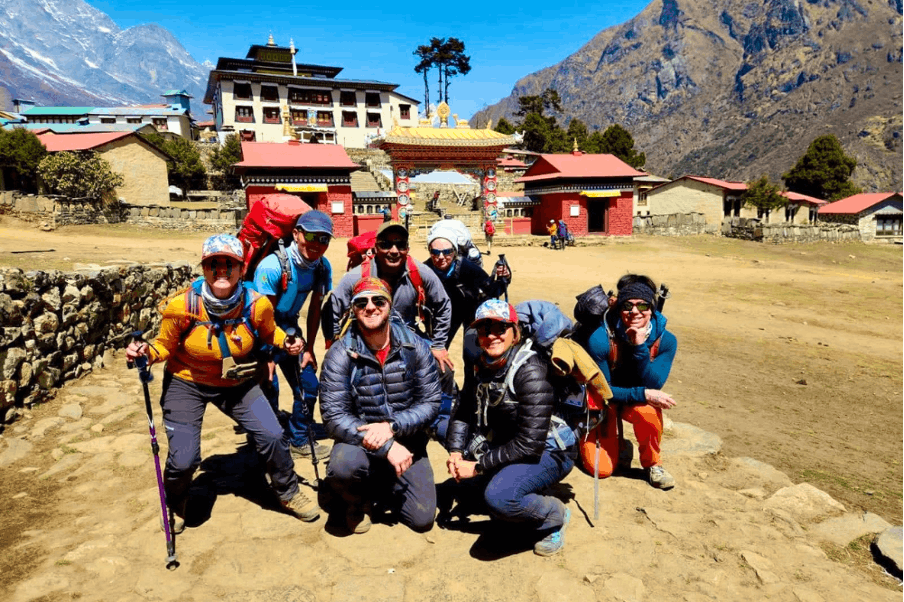
Mount Everest Base Camp Cost
Accommodation & food.
Tea Houses: $15 - $30/night
Food: $20 - $45/day
Water: $1.50 - $6/litre
Permits & Insurance
Permits: $50 - $100
Insurance: $100 - $300
Guides & Porters
Guide: $20 - $35/day
Porter: $12 -$20/day
Specialized Gear
Hiking Boots: $150 - $250
Insulated Jacket: $100 - $300
Sleeping Bag: $150 - $400
Additional Costs
Flights to and from Lukla: $100-$150
Additional Costs: Tips, personal expenses, etc.
How Much Does it Cost to Go to Everest Base Camp: A Detailed Breakdown
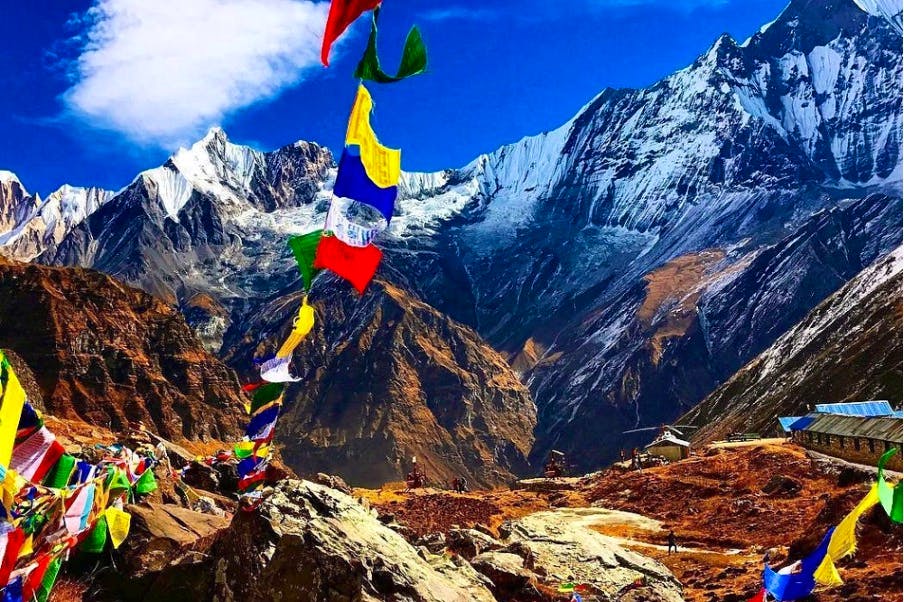
Accommodation and Food
Types of accommodation, food options, water and snacks, trekking permits and insurance, types of permits, importance of insurance, types of coverage.
Medical Evacuation: In the worst-case scenario, you might need to be airlifted from the trail. Make sure your insurance covers this.
General Travel Insurance: This covers trip cancellations, lost luggage, and other travel-related mishaps.
Trekking Insurance: This is specialised coverage for the risks associated with trekking at altitude. Also, check if your policy covers hospitalisation for illnesses and injury.
Cost and Altitude Limit
Recommended provider.
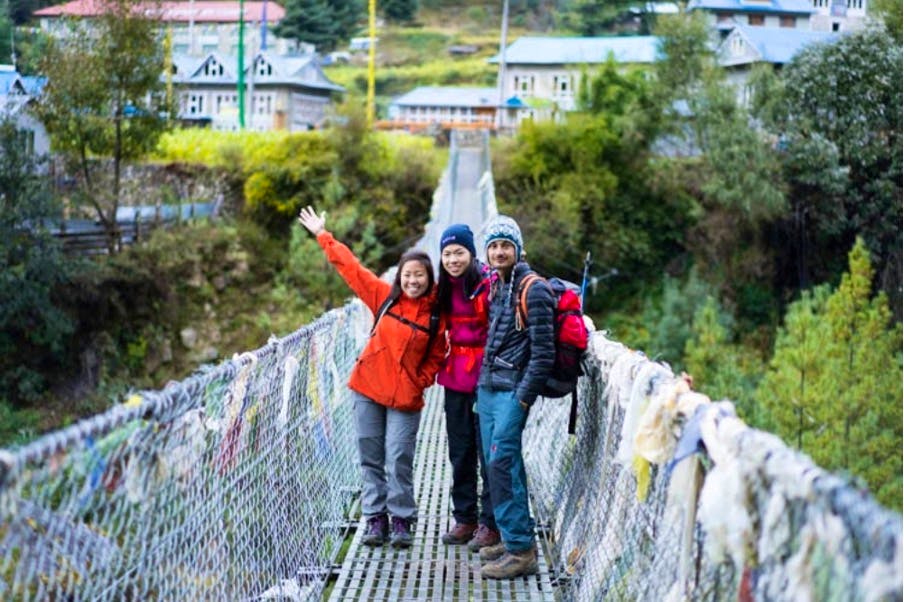
Duration and Itinerary
Standard duration, luxury options, guides and porters.
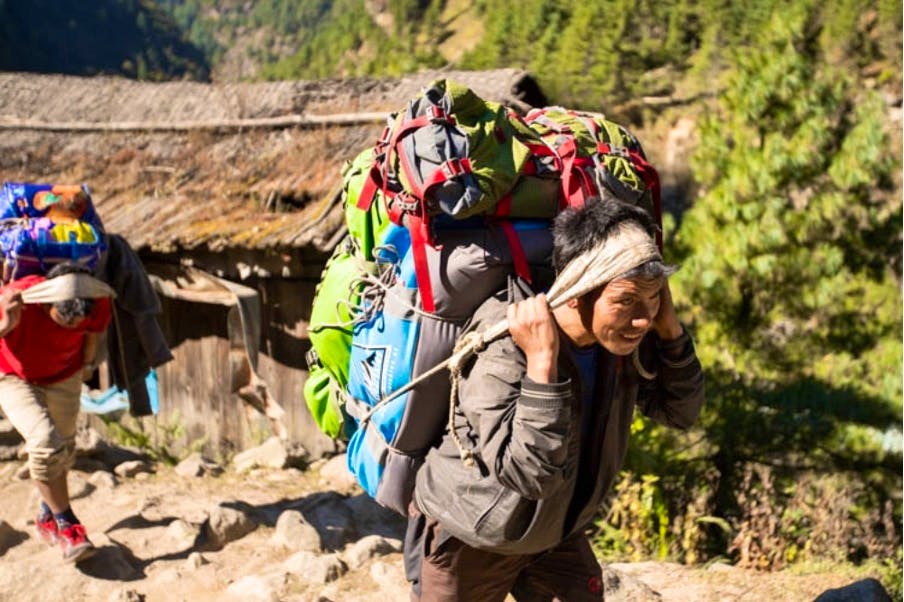
The Norm: Agency-Led Treks
Local agencies: the unknown factor, international operators: the safer bet, enter skyhook.
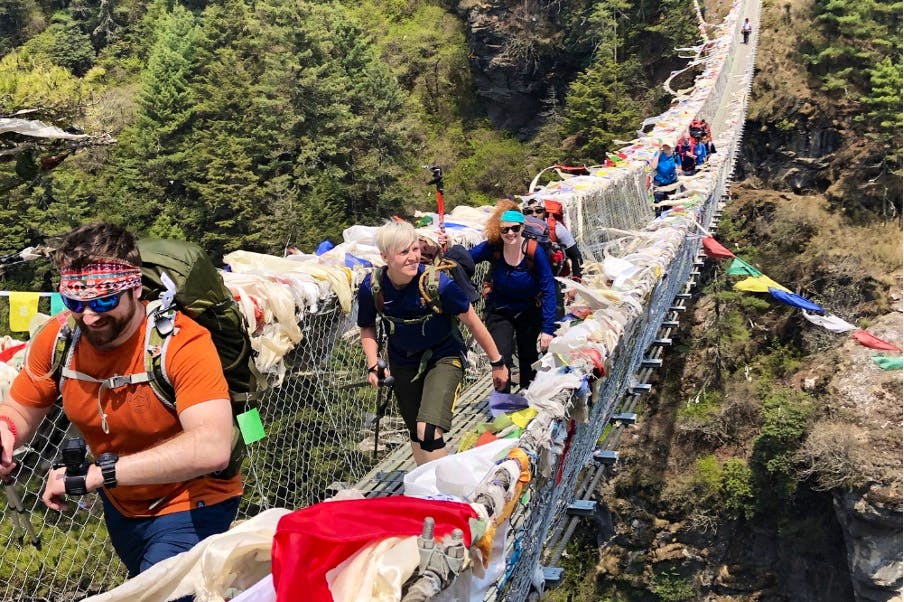
Specialised Hiking Gear
Footwear: the foundation of your trek.
High-Quality Hiking Boots: Expect to pay around $150-$250 for a pair that offers ankle support, waterproofing, and durability.
Clothing: Layering is Key
Base Layers: Moisture-wicking and thermal base layers are crucial. Budget around $40-$80 per piece.
Insulated Jacket: A down or synthetic insulated jacket can cost anywhere from $100-$300.
Waterproof Outer Layer: Expect to pay $100-$200 for a reliable waterproof and windproof jacket.
Gear: The Essentials and the Specialised
Trekking Poles: A pair of quality trekking poles will cost around $80-$150.
Backpack: A 40-50L hiking backpack ranges from $100-$250.
Sleeping Bag: Given the cold temperatures, a four-season sleeping bag is a must, costing around $150-$400.
Tech and Accessories
Headlamp: A reliable headlamp can cost between $20-$50.
Portable Charger: Given the lack of charging facilities, a good portable charger is essential, costing around $30-$60.
Specialised Gear
High-Altitude Sunglasses: To protect against intense UV rays, budget around $50-$100.

Provisions for Extra Acclimatisation Days
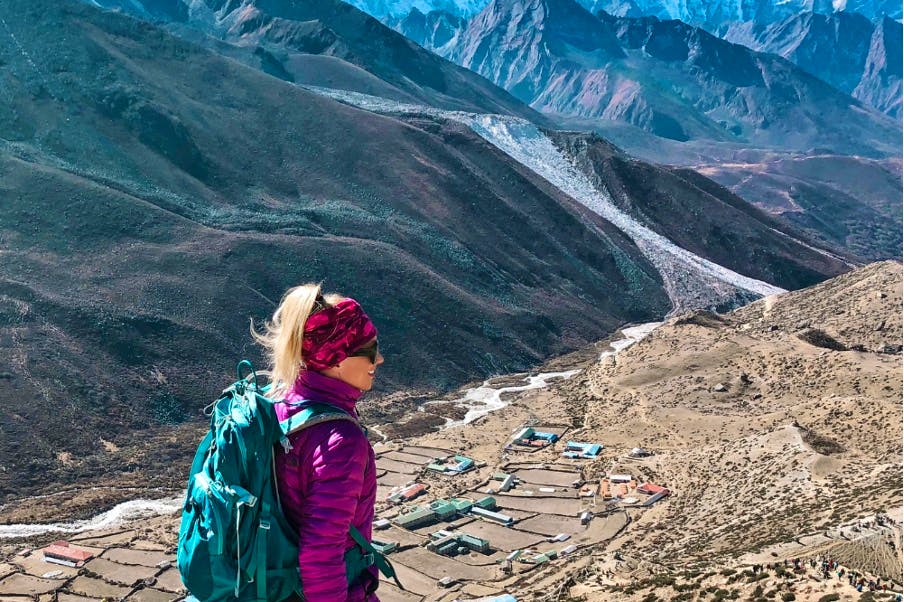
Best Time to Trek
Peak season: spring and autumn.
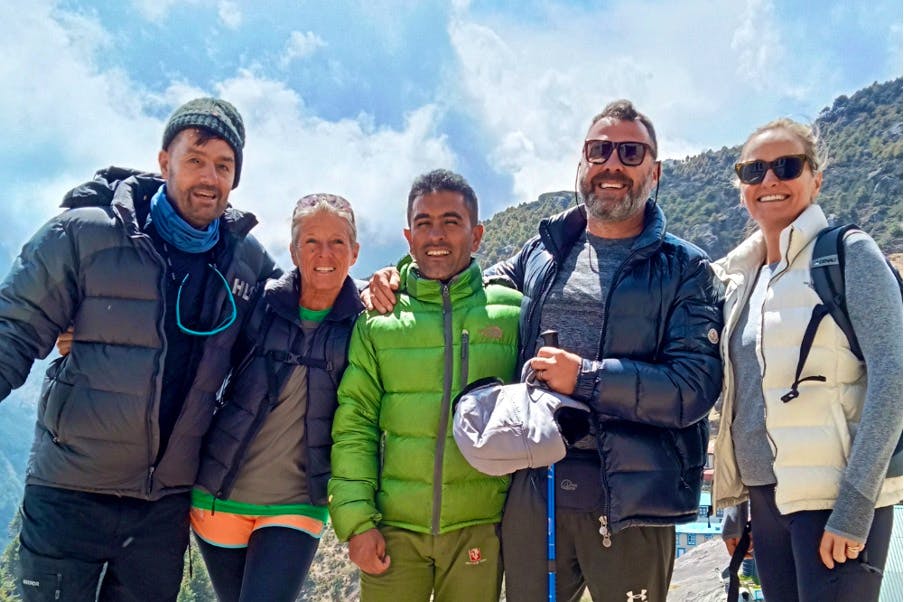
More EBC Articles
How difficult is the EBC trek
Tips for travelling in Nepal
Everest base camp history
How far is base camp from the top of Everest
Travel insurance for Everest base camp
How to train for Everest base camp
View of Mt Everest from EBC
Is it safe to hike to Everest base camp
Can you do Everest base camp on your own
Kilimanjaro or Everest base camp
Everest base camp or Annapurna circuit
How many people die on the Everest base camp trek
Is hiking to Everest base camp worth it
Can a beginner hike to Everest base camp
EBC hiking tips
Oxygen levels at EBC
Reasons to go trek to Everest base camp
Toilets en route to Everest Base Camp
Difference between EBC hike and Summit
Can a 10 year old hike to EBC
Best things to do in Kathmandu
Trek around Kathmandu
Find your next adventure
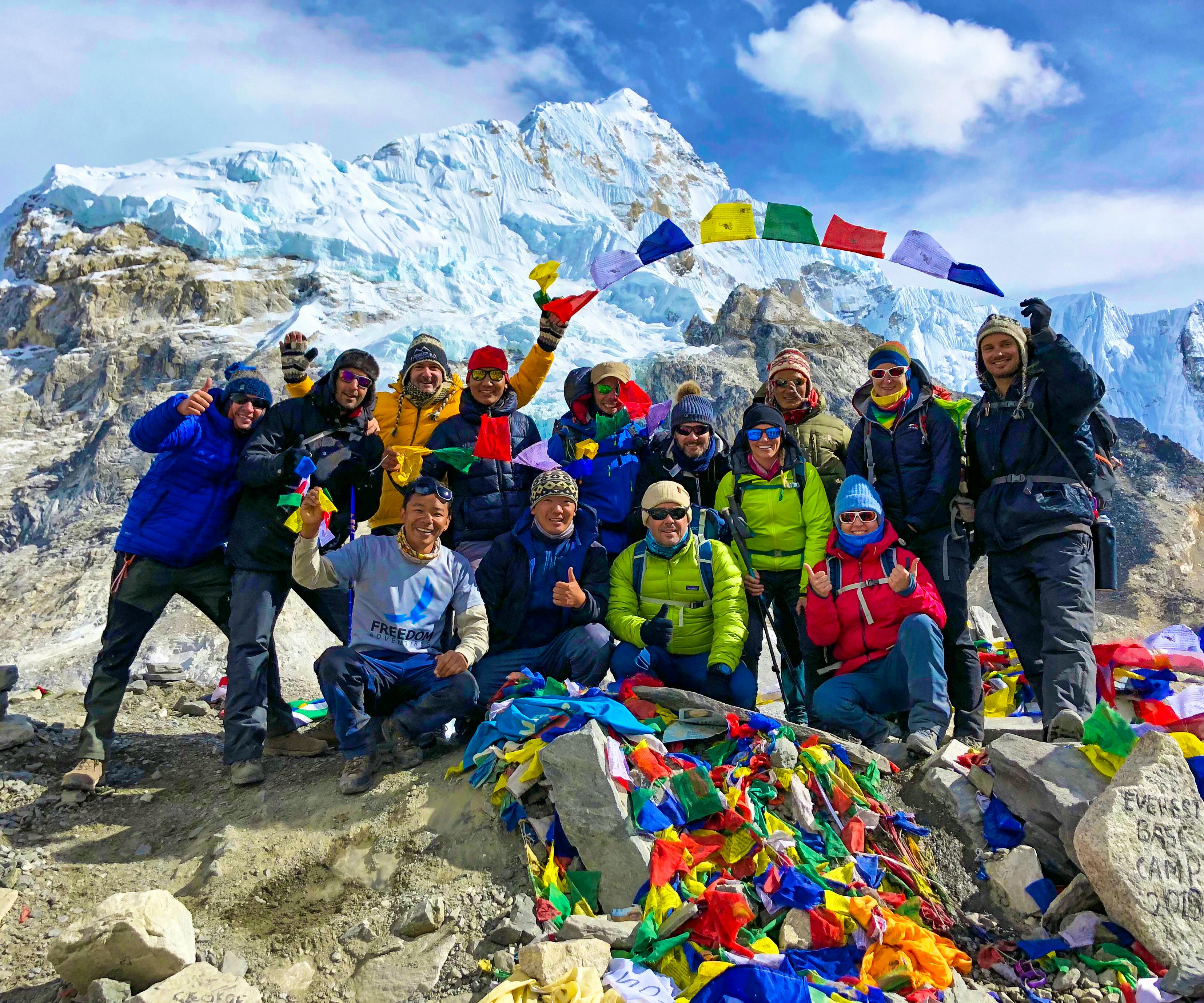
Everest Base Camp Hike (16 Day Trip)
$1,450 per person
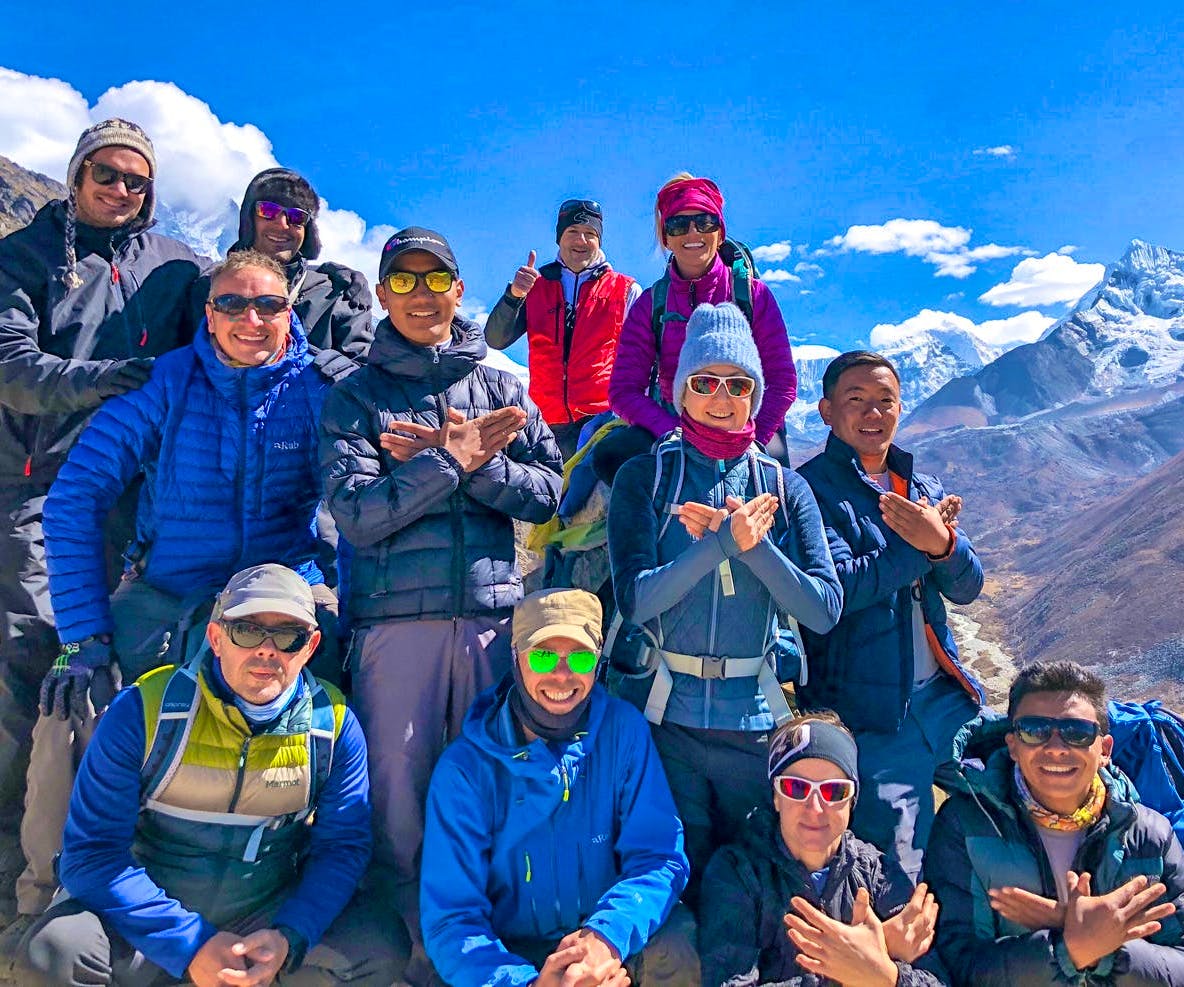
Everest Base Camp Trek (15 Days)
$1,597 per person

Everest Base Camp Trek (12 Day Hike)
$1,158 per person

Everest Base Camp and Gokyo Lakes
$1,838 per person
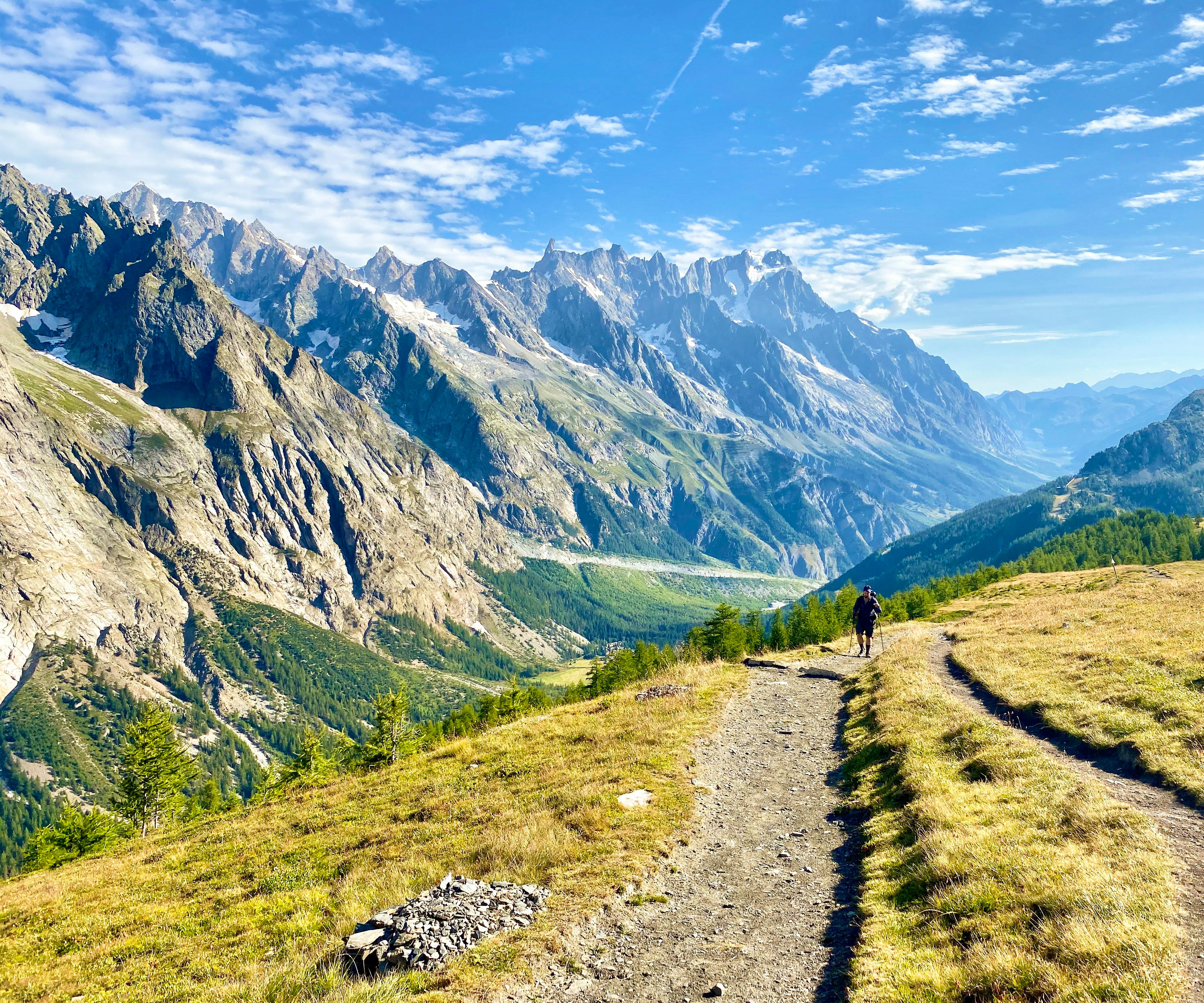
Tour du Mont Blanc (4-Days)
Switzerland
€775 per person
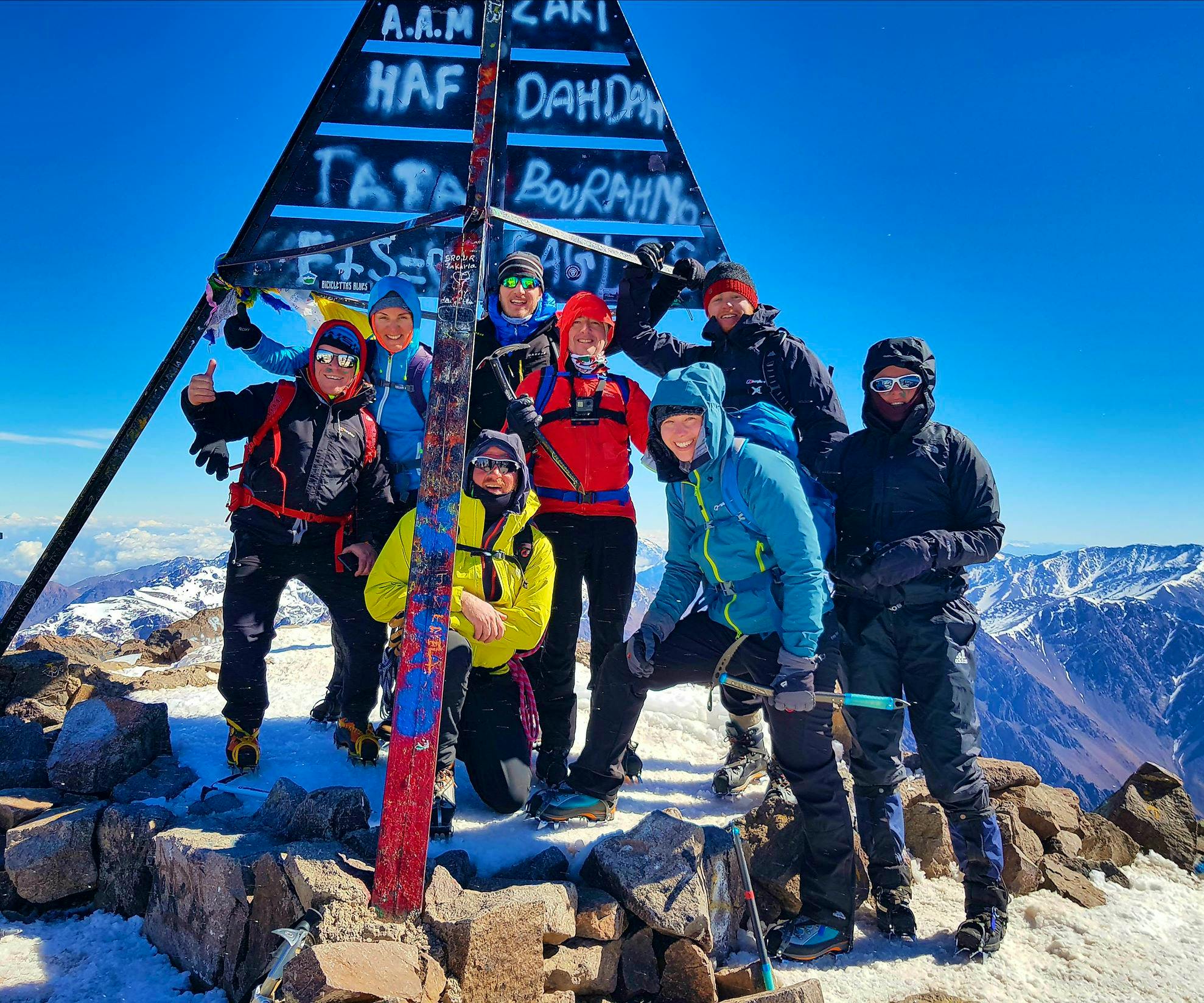
Hike Mount Toubkal (4,167m)
£319 per person
Best Time to Visit
Weather & Climate
Kathmandu Airport Guide
Top Destinations in Nepal
One Week in Nepal
Tipping Guide
Getting Around
Top Things to Do in Nepal
Complete Guide to Kathmandu
Top Things to Do in Kathmandu
Top Things to Do in Pokhara
Sacred Sites
Amazing Festivals
Top National Parks
Must-Try Food
Annapurna Circuit
Manaslu Circuit
Himalaya Trail
Facts About Mt. Everest
Trek to Everest Base Camp
Everything You Need to Know About Trekking to Everest Base Camp
:max_bytes(150000):strip_icc():format(webp)/greg-rodgers-adventure-ed92646b25f247049e53af6d36f6c15f.jpg)
Jason Maehl / Getty Images
Everest Camp II (2)
Trekking to Everest Base Camp in Nepal's Sagarmatha National Park is the adventure of a lifetime. Although actually climbing Mount Everest is out of reach for many of us, anyone with enough grit and good enough fitness can reach EBC and the Khumbu Icefall, the starting point for climbing Mount Everest. (You’ll need an $11,000 permit and some serious equipment to go any higher from there!)
The Himalayan scenery here is unrivaled on earth. Snowy sentinels will witness your struggle toward the top of the world , while stupas, prayer flags, and Sanskrit tablets will remind you of the spiritual significance of the area. Sadly, the numerous memorials to hikers who perished along the trail underscore the seriousness of your undertaking.
You’ll battle freezing cold, thin air, weather changes, and your own body as you ascend. Once at Everest Base Camp, you won’t even get to see the famous mountain itself unless you take a day to climb Kala Patthar (18,519 feet), an adjacent prominence that affords views of the “Holy Mother” when weather permits.
Read on for our complete guide to the Everest Base Camp trek, with information on what to pack, when to go, EBC tours, and more. Note that we’ll only cover getting to South Base Camp in Nepal, not North Base Camp in Tibet .
What to Expect
Trekking to Everest Base Camp involves hiking between lodges (or “teahouses”) found in villages along the trail. Some days may only consist of four hours or so of uphill trekking, depending on how much elevation is gained that day. Sometimes, you’ll have the option of pushing on to another village higher up—but no matter what, you will never gain more than 1,312 feet (500 meters) in a day.
Once above the tree line, the common rooms in your lodges will invariably be heated by yak dung-burning stoves. Weary hikers will hang around these stoves, warming themselves and socializing before retiring early to their unheated rooms. The shared toilets are sometimes located in snowy outhouses.
The village of Namche Bazaar (11,290 feet) is considered the last fully “civilized” stop on the trek to Everest Base Camp. Here, trekkers can enjoy treats from a German bakery while watching screened documentaries. You’ll find last-minute gear and souvenirs for sale along with the last ATM on the trail. You can even indulge at the “highest Irish pub in the world” on your way down after a successful trek!
When's the Best Time to Trek to Everest Base Camp?
The best time for trekking to Everest Base Camp is in either spring (March to May) or fall (September to November). If you want to see the camp in full form with climbers, support teams, and film crews, you’ll need to time your trip with spring climbing season, usually late April or early May. This is also the busiest time to be in Nepal .
For less traffic on the trails, consider making your trek to Everest Base Camp in September or October. Unfortunately, this means hiking in cooler weather with even less daylight than usual.
Avoid making the trek during monsoon season in summer. Humidity reduces beautiful views at lower elevations, and snowfall closes trails at higher elevation.
Adisorn Fineday Chutikunakorn / Getty Images
Should I Book a Tour or Go Independently?
There are three options for completing a trek to Everest Base Camp:
- Book a group tour and have all arrangements made for you.
- Make the trek to Everest Base Camp independently .
- Arrive in Nepal, then hire a guide and/or porter yourself.
No matter which option you choose, try to spend an additional day at Namche Bazaar. The extra time at 11,290 feet reduces some of the effects of elevation later; you’ll enjoy a better overall trekking experience and suffer less. The extra day isn’t “wasted”—many day hikes around Namche Bazaar provide beautiful views while giving your body time to adjust. Your chances of successfully reaching Base Camp vastly improve if you spend more time at Namche Bazaar.
Everest Base Camp Tours
Although the most expensive option by far, having everything organized before you arrive provides peace of mind. You’ll be taken care of all along the way, with access to better safety measures such as supplemental oxygen. Bigger companies use yaks to take your gear ahead; you’ll find it waiting for you in your teahouse room at the end of each hiking day.
You can book an Everest Base Camp tour online from home, or if time permits, do so after arriving in Kathmandu . Booking on the ground through a Nepalese agency saves money and better helps the local economy. You’ll find trekking agencies on every corner in Thamel, but unfortunately, not all are reliable. Choose a reputable agency that’s a member of the Trekking Agencies’ Association of Nepal . You can see in the member directory how long an agency has been in operation, and hopefully, make a better informed decision.
Independent Trekking
First, independently trekking to Everest Base Camp doesn’t necessarily mean solo trekking. Trekking alone in the Himalayas is dangerous no matter your experience level. A simple slip or unexpected weather change could keep you from reaching the next teahouse before temperatures plummet at night.
Independent trekkers can save a lot of money by foregoing organized tours and simply teaming up with other trekkers they meet along the way. (Everyone you meet in the lodges is going in one of two directions: up or down!) The well-marked trail to Everest Base Camp is busy during peak trekking seasons, giving you the best chance of meeting new friends who match your speed and fitness level.
Going independently does carry some risk, of course. You’ll be responsible for your own well-being and making important decisions. On the other hand, you’ll be able to set your own pace and make adjustments based on how well your body acclimatizes. A majority of hiker deaths on the trail each year occur when people in group excursions are suffering from Acute Mountain Sickness (AMS) but don’t speak up. They fear slowing everyone down, or don’t want to forfeit reaching Everest Base Camp.
If guiding yourself, pick up a good trail map in Kathmandu. Don’t rely solely on electronic devices for making survival decisions! You’ll also need to store your luggage at a trustworthy guesthouse or hotel in Kathmandu. Locking duffel bags and padlocks can be purchased in local shops; some owners will buy them back once you return from your trek.
Hiking Guides and Porters
Rest assured: Your pack is going to feel heavier at 15,000 feet than it does at home! Even as an independent trekker, hiring a local guide and/or porter are options. Hiring directly ensures money goes to the Sherpas instead of a Western tour agency that managed to rank well online. Expect to pay between $15 to $20 a day for a porter or $25 to $30 a day for a guide.
You’ll need to negotiate terms and contingencies before hitting the trail. Paying up to half of the porter’s fee up front is common, and you will also be expected to tip guides and porters after the trip. Finalize details and other expenses to avoid a potential disagreement. The agreed daily rate should include their meals, drinks, and accommodation so you aren’t asked for money later.
Guides will approach you on the street in Thamel, however, you should hire only a credible and licensed guide through either a trekking company or your accommodation. You may still be able to hire a porter later on the trail by speaking to the staff at your lodge.
How Much Does It Cost to Trek to Everest Base Camp?
The cost of trekking to Everest Base Camp depends entirely upon your needed level of comfort. One indelible rule holds on the trail: Prices rise as elevation rises. That 50-cent candy bar from Kathmandu is worth $7 at 17,000 feet!
Extremely basic accommodation in teahouses can be found for as low as $5 per night. You’ll be expected to have your meals where you stay. A hearty Nepalese meal of dal bhat can be enjoyed for $6 or less, but expect to pay much more for Western food. A can of Coke can cost up to $5; remember, it’s heavy and had to be carried up by a porter.
Other luxuries add to the cost of life on the trail. A (somewhat) warm shower can cost $5. Charging electronic devices and accessing the internet, if available, cost several dollars an hour, and the solar charging systems are often slow and provide only a weak charge. Depending on your food and drink indulgences, plan to spend $20 to $30 a day living on the trail. This excludes any fees you pay to porters and guides.
If not already covered, your greatest expense will be the short flight to and from Lukla. The 30-minute flight can cost around $180 each way.
Do You Need a Permit for Everest Base Camp?
You’ll need at least two permits for trekking to Everest Base Camp. Your tour organizer will probably provide these, but you’ll need to arrange them yourself if trekking independently.
- Sagarmatha National Park Permit: Get this at the Nepal Tourism Board office in Kathmandu (approximately $25).
- Khumbu Pasang Lhamu Rural Municipality Permit: You will get this permit from a checkpoint in Lukla; it isn’t available in Kathmandu (approximately $17).
- Gaurishankar Conservation Area Permit: You only need this permit from the Tourism Board if doing the longer trek to Everest Base Camp from Jiri instead of flying to Lukla (approximately $17).
The permit system changed in 2018. Disregard any information you read elsewhere about needing a TIMS card for the trek to Everest Base Camp.
Greg Rodgers
What to Pack
Kathmandu, particularly in Thamel, has more than enough outfitting shops for gearing up. Unfortunately, those same shops are stacked with counterfeit gear that probably won’t survive the hardships of the trek. Sifting through the piles of used gear in dark shops requires patience. Prices are inflated, so put your game face on and start haggling !
If you booked a guided tour, find out what your tour company plans to provide (e.g., hiking poles, down jackets, etc) before shopping. Consider bringing mission-critical items from home so that equipment failure doesn’t affect your experience. For instance, you’ll need quality sunglasses to prevent eye injury. Sunglasses for sale locally may have “UV Protection” stickers on them but don’t offer much actual protection.
- Good hiking boots. You should invest in high-quality, waterproof hiking boots and break them in properly before you leave home; painful blisters can ruin an otherwise-excellent trek.
- Lightweight sleeping bag. Rooms along the trek are unheated. Lodges provide weighty blankets for the freezing nights, but you'll appreciate having a layer between you and the unwashed bedding. Even a lightweight silk “sleep sheet” will do the trick.
- Alternate footwear. After removing your muddy hiking boots, a pair of lightweight shoes or sandals comes in handy for wearing around lodges and shared bathrooms.
- Water purification: As elevation increases, so does the cost of bottled water and need to reduce plastic waste. You’ll be drinking more than ever to counter dehydration in the dry air. Although there are many options, the two-bottle, chlorine dioxide system from Aquamira is a reliable solution.
- Trail snacks: Candy bars and nuts provide a much-needed boost to energy and morale while on the trail or in the lodge.
- USB power bank: Keeping batteries charged in the extreme cold is a challenge. If you plan to use a phone for photos or communication, you’ll want to bring along a rugged power bank.
- Diamox tablets: Diamox (acetazolamide) is medication for countering the dangerous effects of AMS. Guides should have some on hand, but independent trekkers will want to buy Diamox to carry. Beware of fake tablets for sale in Kathmandu. Purchase only from legitimate pharmacies—not from shops—and discuss how to use them.
If you won’t be taking your poles and other gear home after the trek, consider giving it directly to the Sherpas you meet in Lukla.
John Elk III / Getty Images
How to Get There
Fly into Kathmandu's Tribhuvan International Airport (KTM) and plan to spend a few days resting and preparing for the trek. Unless you’ll be starting the trek in Jiri—which requires a seven-hour bus ride and an additional five to seven days of trekking—you’ll need to book a flight to Lukla.
Taking the small prop plane from Kathmandu to Lukla (LUA) is one of the scariest and most scenic aviation experiences many travelers will have. Although not the highest airport in the world , weather and visibility changes have caused enough crashes at Tenzig-Hillary Airport in Lukla to earn it the title of “most dangerous airport in the world.”
The trek to Everest Base Camp begins in Lukla and finishes at the infamous Khumbu Icefall!
How Dangerous Is Everest Base Camp?
Although frostbite and rock slides are hazards along the trail, the biggest danger—by far—comes from the high elevation. Once symptoms of AMS begin (severe headache and nausea), you need to descend as soon as possible. Ideally, you’ll ascend slowly enough to minimize altitude sickness in the first place.
The CDC recommends never gaining more than 500 meters in one day and taking a rest day for every 1,000 meters gained. Whenever possible, you should descend to sleep at a lower elevation than the highest point reached during the day. Track and do the elevation math as though your life depends on it.
The high elevation and thinner air introduces additional risks. For one, your body will increase its production of red blood cells, causing excessive urination; be sure to drink plenty of water to avoid dehydration. Many trekkers will also experience the dry, hacking "Khumbu cough" from panting heavily in the thin air and breathing in the dust of the region. You can cover your face with a bandanna or balaclava for some protection. The cough usually goes away after time. Ultraviolet rays, too, are more damaging in the thinner air, so protect your skin, lips, and eyes by applying high SPF sunscreen and lip balm, wearing long sleeves, and donning sunglasses.
Finally, yak trains always get the right of way! Never share a bridge crossing with one, and always pass them on the “inside” of the trail. Startled yaks are unpredictable and sometimes knock trekkers off the trail.
Additional Tips
- Take your stocking up on snacks seriously. Pack candy bars, even if you wouldn’t ordinarily indulge at home. You’ll experience strong cravings at higher elevation. Hikers are willing to spend $7 or more for Snickers bars near Everest Base Camp!
- The weather in the Himalayas changes quickly and unpredictably. Flights to and from Lukla frequently become delayed by a day or two, maybe longer if a winter storm system sets in. Add some buffer days to your Kathmandu itinerary just in case this happens.
- Before retiring to bed, ask your teahouse staff to pour boiling water into your bottles and use them as bed warmers. Fair warning: They’ll probably be frozen next to you in the morning!
- Sleep with your phone and any batteries in the bed with you. Your body heat will protect battery life a little.
- Weight limitations imposed by airlines that fly to Lukla are strictly enforced. If an airline says 33 pounds (15 kilograms), that includes all baggage , stowed or carried. Don’t risk having to forfeit gear in Kathmandu Airport because you’re a pound or two over the allowance. You can stuff some items into your pockets, within reason.
How to Go Teahouse Trekking in Nepal
How to Choose and Prepare for a Hiking Trip
Solo Trekking in Nepal's Everest National Park
The Best 12 Hikes in Nepal
Independent Trekking in Nepal
The World's Highest Places and Attractions That You Can Visit
Five Amazing Hiking Routes Among the High Mountains of the Himalayas
How to Trek Nepal's Manaslu Circuit
The Complete Guide to Climbing Morocco's Mount Toubkal
The Different Types of Adventure Travel
A Guide to Tipping in Nepal
Nepal's Great Himalaya Trail: The Complete Guide
Where Is Mount Everest?
The Top 15 Destinations in Nepal
How to Trek Nepal's Annapurna Circuit

- Best Hikes In The World
- Appalachian Trail
- European Hikes
- Nepal Hikes
- Patagonia Hikes
- See All Hikes
- Mount Kenya
- Mount Kilimanjaro
- Mount Toubkal
- See All Mountains
- South Africa
- New Zealand
- Switzerland
- United Kingdom
- Packing Lists
Everest Base Camp Trek – Nepal’s Most Famous Trek
Asia , Nepal
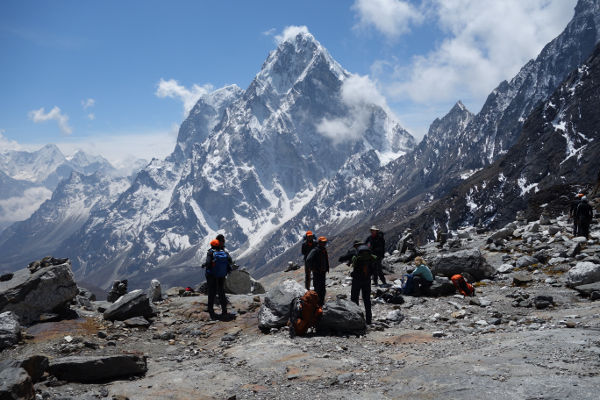
The Everest Base Camp Trek is one of the most popular and best treks in Nepal .
Home to four of the six highest mountains in the world – Mt. Everest (8,848 meters), Mt. Lhotse (8,516 meters), Mt. Makalu (8,470 meters) and Cho Oyu (8,201 meters) – the Everest (or Khumbu) region affords trekkers the opportunity to hike in one of the grandest and most awe-inspiring trekking areas in the world.
Trekkers get to retrace the footsteps taken by Sir Edmund Hillary and Tenzing Norgay on their historic Everest expedition in 1953.
On this page, you will find a comprehensive and impartial guide to the Everest Base Camp Trek.
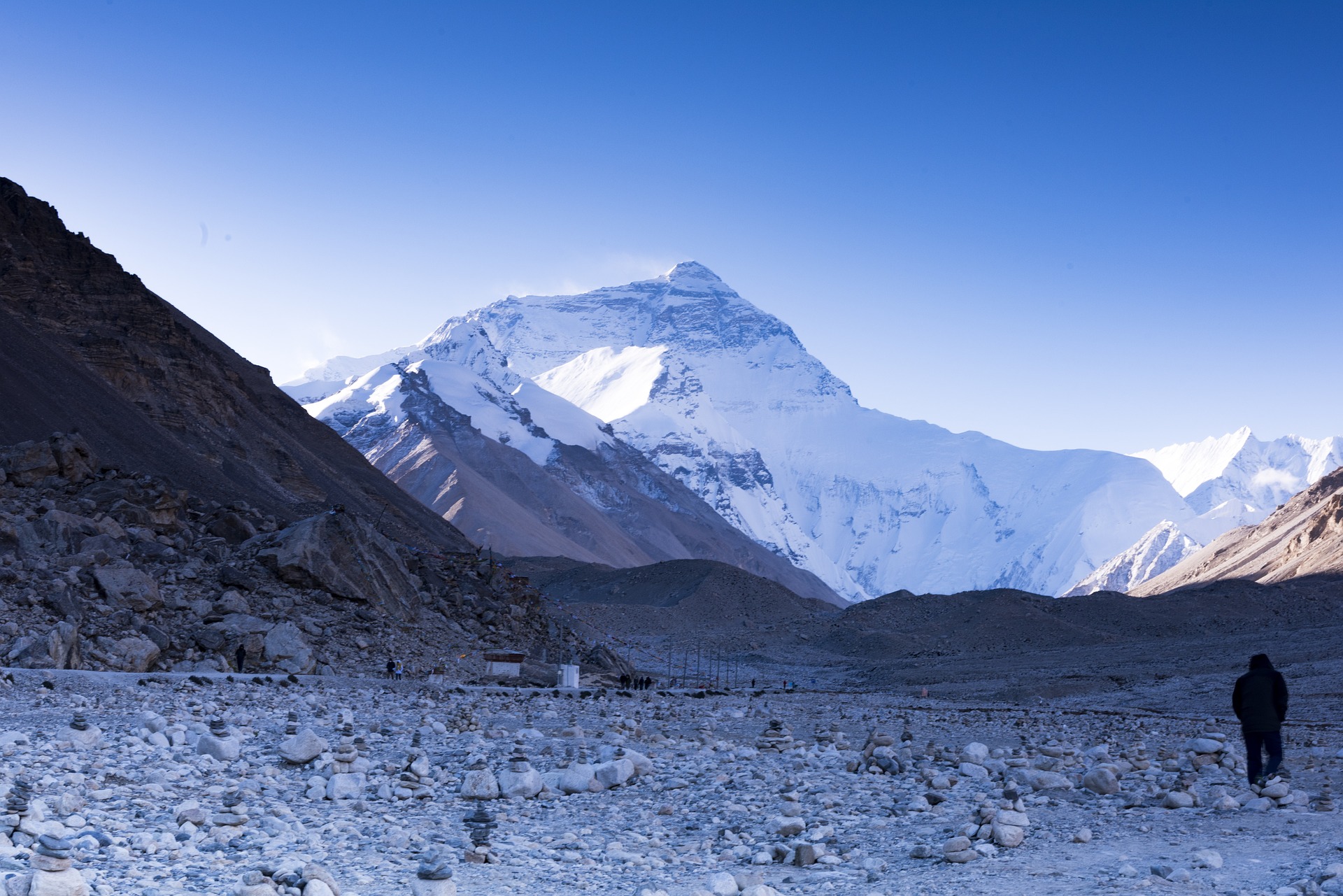
Everest Base Camp Trek
Ebc hike overview.
In this detailed Everest Base Camp trek article, you will find information on the typical route and its variations; a day-by-day itinerary breakdown of the trek; practical information on accommodation, meals, permits, equipment and insurance; as well as guidance on the best time to trek Everest Base Camp.
Key Highlights
Highlights on the trek include: unforgettable mountain views from Kala Patther , including Mt. Everest; the chance to see the famous Everest region Sherpas and Sherpa town – Namche Bazaar; sightseeing in the Sagarmatha National Park – a World Heritage Site; glimpses of the highest Buddhist monasteries in the world; and a sneak preview into the inner workings of the base camp to the world’s highest mountain.
Everest Regional Map
The Everest Base Camp trek is situated in the Everest, or Khumbu region of Nepal (see map below). It is the most popular trek in the region, if not the country.
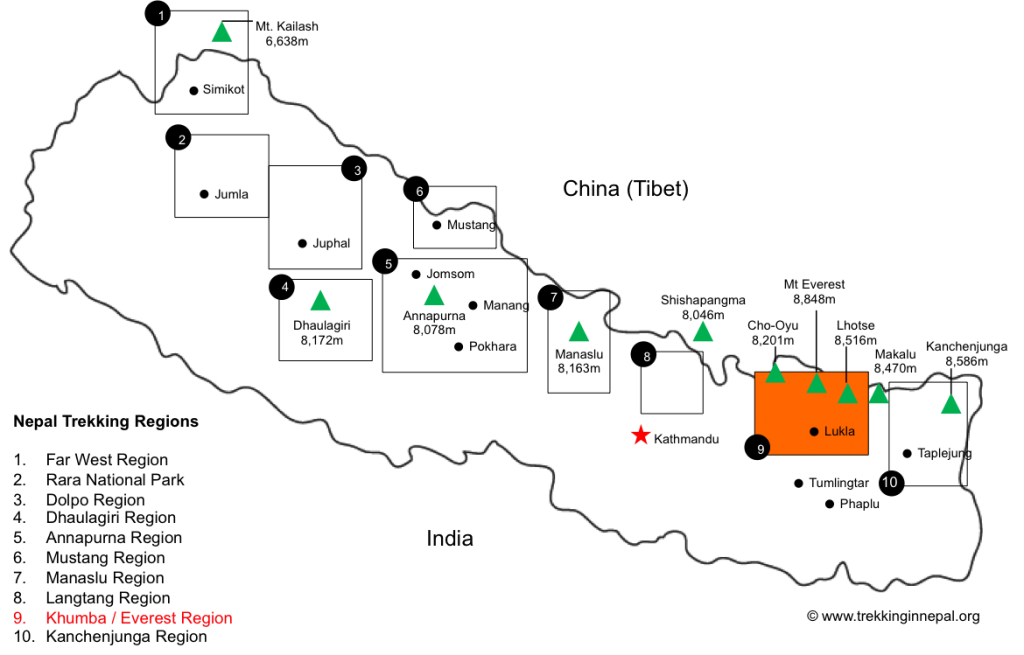
EBC Recommended Map
This map is one of the better representational schematics of the Everest Base Camp trail (we believe it is from GlobeTrekker but can’t be certain as there are many maps scattered across Google Images).
The map above shows the classic Everest Base Camp trek running up from Lukla to Namche Bazaar and then veering North-east up to Periche / Dingboche. From Dingboche / Periche the trail turns North-west to Lobuche before heading north gain to Gorak Shep. From here Everest Base Camp can be seen to the East and Kala Patthar in the North-west.
The map also shows the route to Island Peak in the East, via Dingboche and Chhukung, and the Gokyo Lakes in the West.
Please Note: The above recommended map is not to scale and should not be used as an accurate representation of the Everest Base Camp trek route. We provide links below to excellent maps of the Everest region.
EBC Trek Itinerary
Most trekkers fly from Kathmandu to Lukla Airport to begin their Everest Base Camp trek. The ‘classic’ or typical route follows straight up the Khumba Valley and through the Sagarmatha National Park to Everest Base Camp.
Variations via Gokyo Lakes or Chhukhung Valley are also popular (see the variations section below).
The typical Everest Base Camp trek duration is between 14-16 days (including transfers between Kathmandu and Lukla). The trek itself (excluding sightseeing in Kathmandu and transfers) usually lasts about 12 days with acclimatisation days at Namche Bazaar and Pheriche.
Here is a brief overview of a typical itinerary on an EBC trek, with approximate trekking times and altitudes.
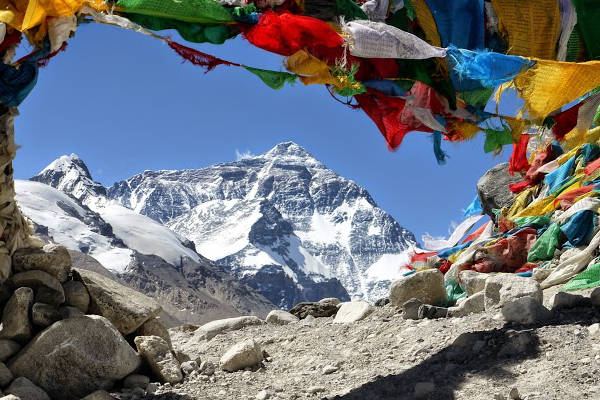
Day 1: Arrive Kathmandu
Arrive in Kathmandu. Rest and tour Kathmandu (often your tour operator will have pre-organised tours around Kathmandu).
See more in our guide on things to do in Kathmandu .
Day 2: Fly Kathmandu to Lukla. Trek to Phakding
Fly from Kathmandu to Lukla (expect a slightly scary landing at Lukla but rest assured the pilots are very experienced!). Weather can sometimes be a problem, so delays are common.
The flights afford great views of the Everest region, so have your camera ready. Try to sit on the right side of the plane to see Mt Everest. Upon arrival you will be transported to the trailhead and take a relatively easy trek from Lukla (2,800 meters) to Phakding (2,652 meters).

Namche Bazaar, Khumbu District
Day 3: Trek from Phakding to Namche Bazaar
Phakding (2,652 meters) to Namche Bazaar (3,440 meters) via Monjo (2,840 meters) and the beginning of Sagarmatha National Park. Weather permitting you might get your first glimpses of Mt Everest from the steep trail to Namche.
Day 4: Acclimatisation in Namche
This is usually a rest acclimatisation day in Namche (3,440 meters). If you are lucky enough to be in Namche on a Saturday, then make sure to visit the weekly market. Most operators will encourage you to take an acclimatisation trek to the Everest View Hotel (3,880 meters) where you can have lunch and capture views of Mt. Everest.
Day 5: Trek from Namche to Tengboche
Trek from Namche (3,440 meters) to Tengboche – also written Thyangboche (3,860 meters), home to the largest gompo (a Buddhist ecclesiastical fortification of learning). The trek is an undulating one which provides great views of beautiful mountains including Everest, Nuptse, Lhotse and Ama Dablam. Some treks go via Thame to visit the Thame Monastery, before continuing to Tengboche.
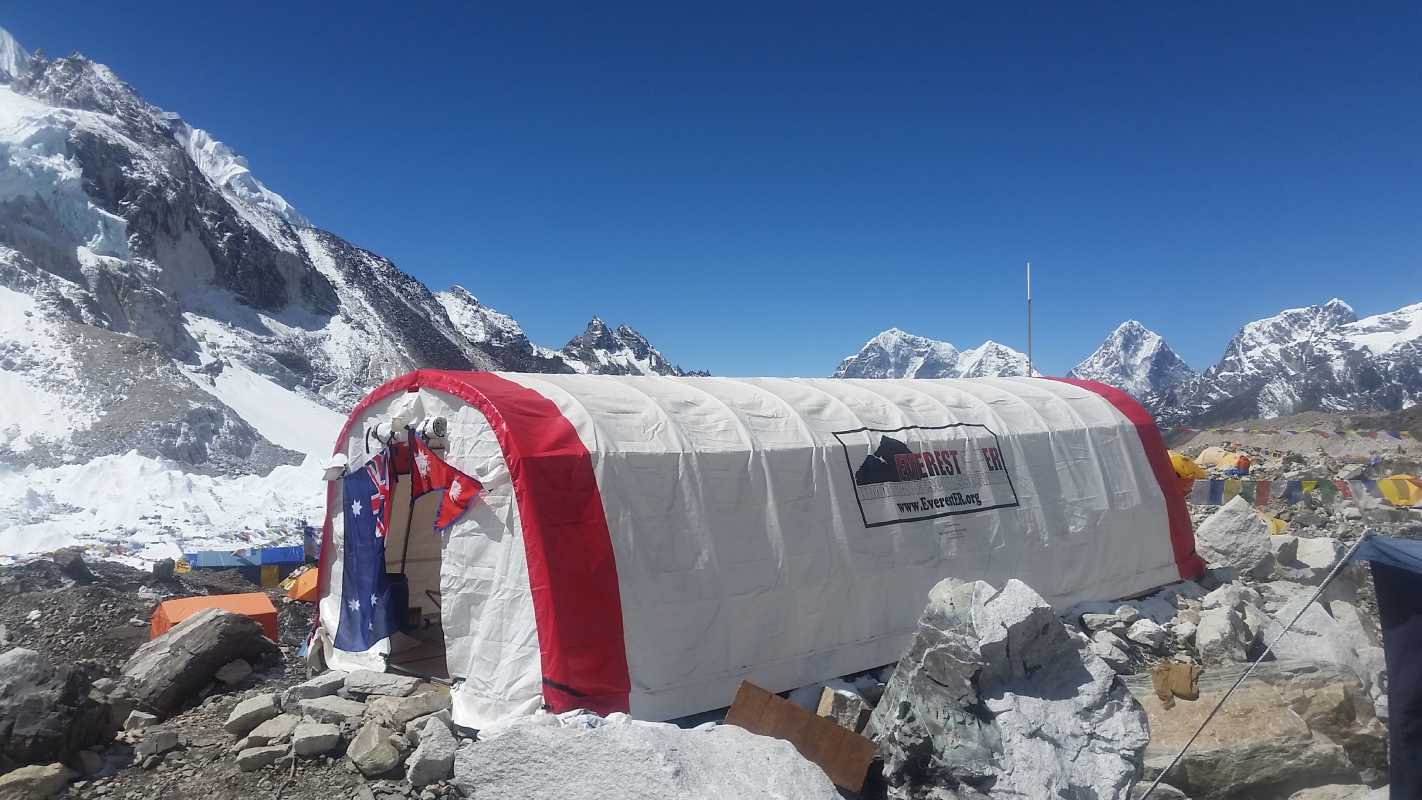
Day 6: Trek from Tengboche to Periche
Trek from Tengboche (3,860 meters) to Periche (4,280 meters) via the town of Pangboche. The Himalaya Rescue Association are based here, and it is well worth visiting them if your operator hasn’t already organised a tour.
Day 7: Acclimatisation day in Periche
Periche (4,280 meters) is usually used as the location for your second rest and acclimatisation day. Depending on your operator you will likely visit the Tshola Tsho Lake and then take a short trek towards Dingboche (4,360 meters) where you will get great views of the south face of Mt. Lhotse and Island Peak.
Day 8: Trek from Periche to Lobuche
A fairly long and steep trek from Periche (4,280 meters) to Lobuche (4,940 meters) via the Khumbu Glacier. You will see Sherpa Memorials built of stone cairns in remembrance to the many Sherpas and climbers that have died climbing Everest.
Day 9: Trek from Lobuche to Gorak Shep
Trek from Lobuche (4,940 meters) to Gorak Shep (5,170 meters) where you will have lunch and then onto Everest Base Camp (5,364 meters).
Most treks are not allowed to stay at Everest Base Camp without specific permission. The rules and regulations have changed around this issue over recent years, so it is worthwhile checking with your tour operator.
Visits to the icefall require mountaineering permits and are usually not part of a standard Everest Base Camp trek. After visiting Everest Base Camp you will return to Gorak Shep for the night.
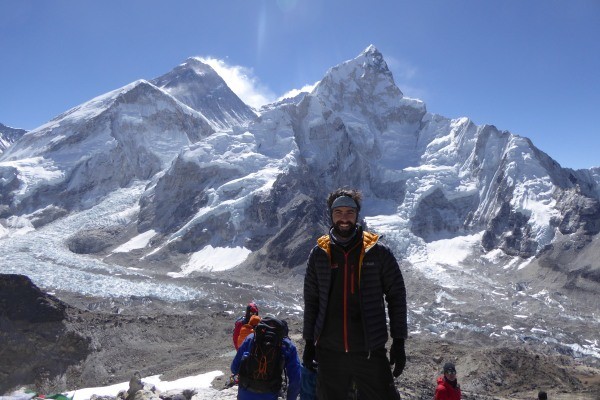
Kala Patthar
Day 10: Trek from Gorak Shep to Kala Patthar and EBC (Return to Dingboche)
A trek from Gorak Shep (5,170 meters) up the steep slopes to Kala Patthar (5,554 meters), a peak west of the Everest Base Camp which affords the best views of Mt. Everest, Nuptse Nup II and Changtse; as well as the northern flank and summit of Lhotse. You will leave Gorak Shep early to reach Kala Patther before the clouds roll in.
On a typical Everest Base Camp trek, Kala Patthar will be the highest altitude you will reach. It is also home to the worlds highest webcam – Mount Everest Webcam. From Kala Patthar, you then descend all the way back to Dingboche (4,360 meters).
Day 11: Trek from Dingboche to Namche
Trek from Dingboche (4,360 meters) to Namche (3,440 meters) via the rhododendron forests around Tengboche.
Day 12: Trek from Namche to Lukla
Trek from Namche (3,440 meters) all the way back to Lukla (2,800 meters) – a long and tiring walk to finish what is an incredible Himalaya trek.
Day 13: Fly from Lukla to Kathmandu
Fly from Lukla to Kathmandu.
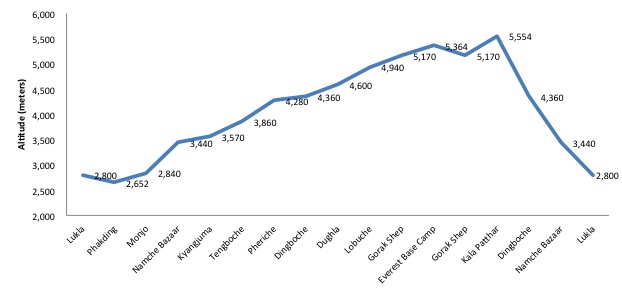
EBC Route Altitude Profile
Above is an altitude profile chart for a typical Everest Base Camp hike. The highest peak is Kala Patthar, at a staggering altitude of 5,554m.
Everest Route Variations
Below are typical route variations for the Everest BC hike.
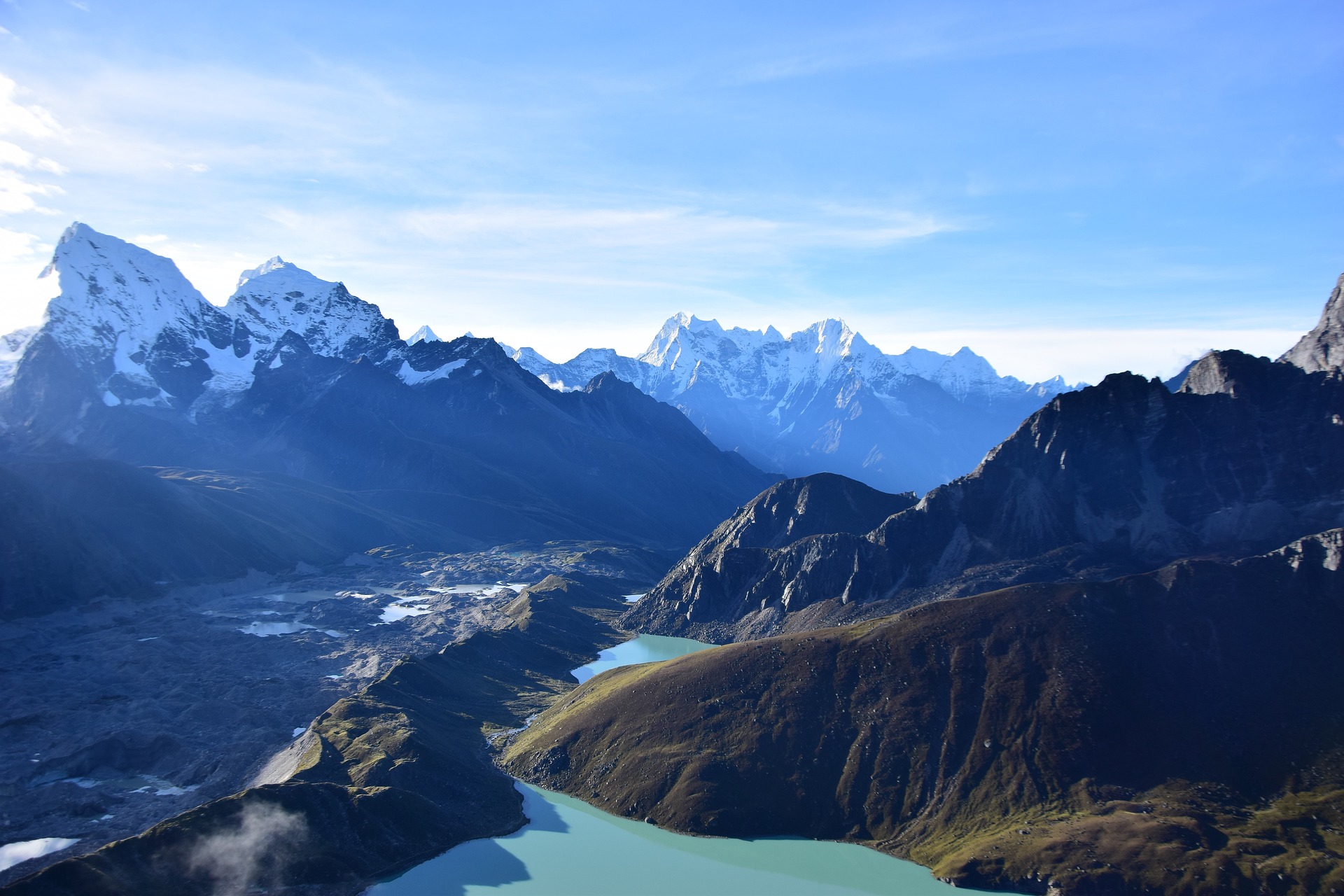
Gokyo-Ri glacier
Gokyo Lakes
The Gokyo Lakes or Gokyo Ri Trek is a fantastic variation on the Everest Base Trek. The route begins in Lukla and follows the traditional EBC trek itinerary for the first three days up to Namche Bazaar. Here it veers off to the North-west via the towns of Dole and Machemo, up to the stunningly beautiful Gokyo Lakes . The trail then ascends Gokyo Ri (5,483 meters) and traverses Cho La Pass (5,420 meters) before joining back up with the classic base camp trek at Lobuche.
The variation adds 2-3 days to an average Everest Base Camp trek but provides an excellent opportunity to avoid the crowds on the busy everest trail, as well as gives one the opportunity to trek up and down on different routes.
Chhukhung Valley
The Chhukhung Valley sits east of Dingboche and provides an alternative and longer passage to Lobuche than the traditional Everest Base Camp trail. Trekkers stay a night in Chhukhung (4,730 meters) before returning to Lobuche via Kongma La Pass (5,535 meters), an epic Himalayan pass .
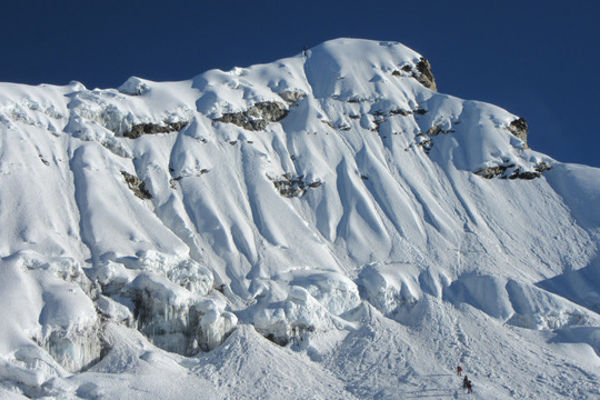
Island Peak headwall
Island Peak
Island Peak is one of Nepal’s 33 trekking peaks. Standing at 6,189 meters, Island Peak is a real challenge in terms of altitude, but only requires beginner level climbing skills (you will need to be comfortable with ice axes and crampons though). Most climbers use the traditional Everest Base Camp trek to acclimatise for Island Peak.
Returning from Everest Base Camp, you can either trek to Cchukhung via Dingboche from Lobuche or veer South-east from Lobuche traversing the Kongma La Pass to Cchukhung (4,730 meters). From here you can trek to Island Peak Base Camp (5,120 meters) in preparation for their trek / climb up to Island Peaks summit. The summit typically takes 2 days and the total trip, including Everest Base Camo, between 18-20 days.
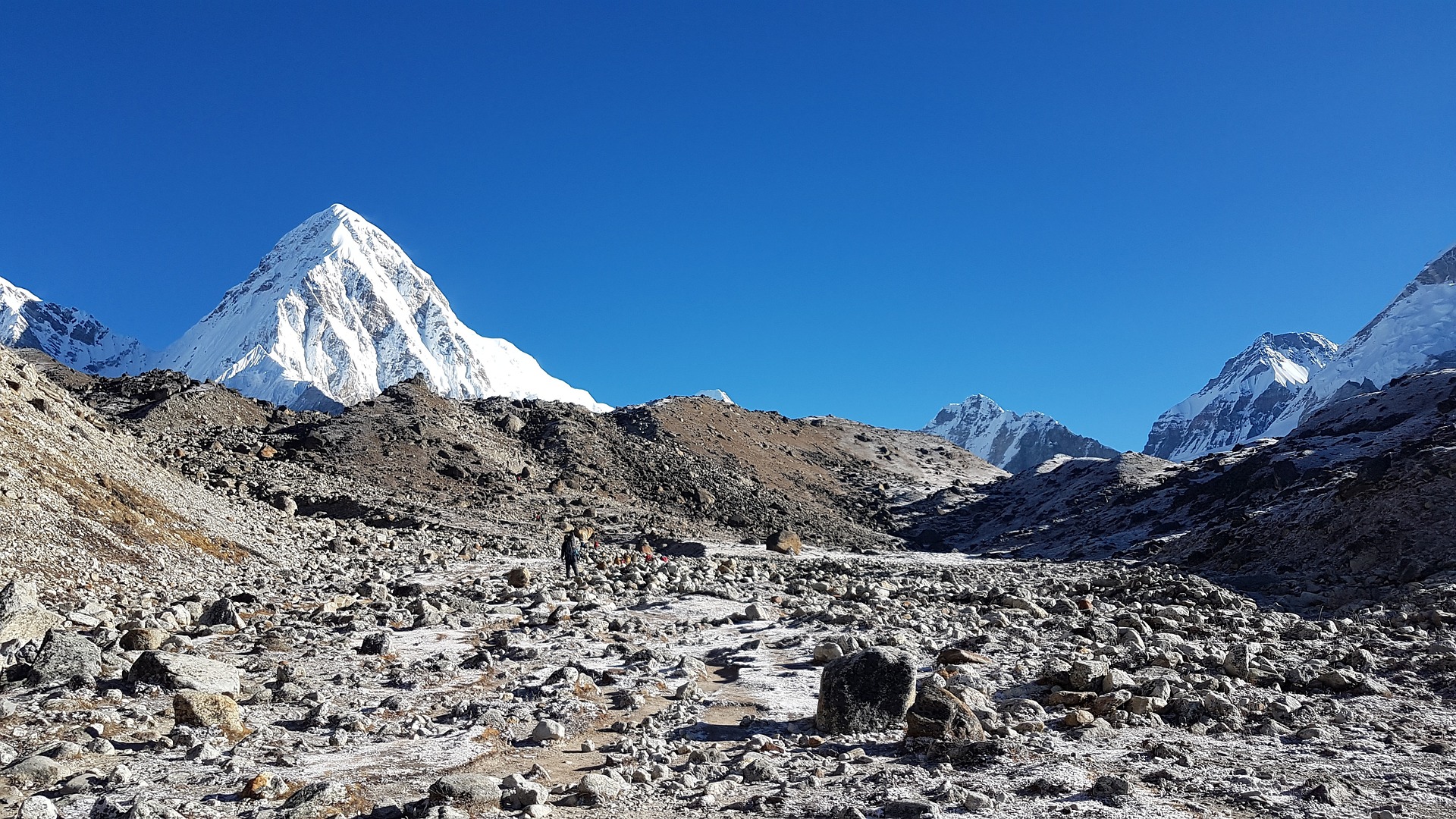
Everest Base Camp Trek FAQ
How much does the ebc trek cost.
Like many treks in Nepal, there are three ways you can plan your Everest Base Camp trek. See more in our guide on a detailed breakdown on the cost of an Everest Base Trek .
Below are four options for Everest Base Camp treks and their estimated costs.
Independent Trekking
Here you organise your trek. You will need to get yourself from Kathmandu to Lukla (a flight is the fastest and easiest; there are buses but these are rather unpleasant). You can employ the services of a porter or guide in Lukla or indeed in Namche, but it is important to note that as an independent trekker, it is illegal to use a guide or porter that is not licensed as a trekking agent through TAAN, or affiliated with a licensed trekking agent. You will need a Green TIMS card (costing NPR 2,000), money to buy food and water, a reliable and accurate map, and negotiations skills to book teahouse accommodation.
The estimated cost for an independent trek excluding flights is between $500-$800.
Local Tour Operator
There are many local tour operators in Kathmandu who organise guided Everest Base Camp treks. Generally local Nepal trekking companies are quite good. You will join a group of trekkers (up to 15 people) and have a team of porters, assistant guides and lead guides (who can speak English) of a similar size to the trekking group.
It is important to check that your local operator is a licensed trekking agent. We recommend shopping around and asking for recommendations from other trekkers. The cheap local operators tend to be the least reliable, often only providing tent accommodation or access to old and poorly run teahouses. Their ethical standards towards staff and the local environment may not be to the highest standard as well.
The estimated cost for an Everest Base Camp trek organised by a local tour operator is between $800-$2,000.
Western Run / Operated Tours
There are many Western run companies that offer Everest Base Camp treks. Most of these Western companies have their own ground teams or strong relationships with the best local tour operators who they outsource their on-the-ground operation to, whilst managing the overall tour experience.
The best Western companies own their on-the-ground operations. Expect a well-run tour with either a Western guide or a very well-trained local guide who understands the subtle service nuances expected of a Western trekker.
The estimated cost for an Everest Base Camp trek organised by a Western run tour operator is between $1,200-3,000.
Everest Climbing Expedition
A fourth option of joining an Everest climbing expedition is also possible. Major climbing operators like Adventure Consultants, Jagged Globe or Alpine Ascents usually offer Everest Base Camp trekking spaces on their Everest climbing expeditions. Securing a trekking space can be a little pricey but offers one an incredible insight into an Everest expedition as well as the chance to spend a night or two at Everest Base Camp.
If you think a base camp trek is expensive, wait till you hear how much it costs to Climb Mount Everest !

Are permits required for the EBC trek?
Yes, there are two permits you require for standard treks from Lukla to EBC. They are:
1. Trekkers Information Management System (TIMS Card)
TIMS cards are issued by the Tourism Agency Association of Nepal (TAAN). There are three different types:
- Organised TIMS Card (Blue in colour, USD 10). If you are trekking with an organised tour these will be arranged for you. You will need to provide your passport number and one passport photograph
- Individual TIMS Card (Green in colour, USD 20). If you are trekking independently (without support) you will need to get one of these TIMS cards from the Nepal Tourism Board in Kathmandu
- SAARC Country TIMS Card (Red in colour, USD 3). These cards are for nationals from the South Asian Association for Regional Cooperation, i.e. India, Bhutan, Pakistan, Sri Lanka, Maldives, Bangladesh and Afghanistan.
2. Sagarmatha National Park Entry Permit (USD 30 + 13% Govt. Tax)
The Sagarmatha National Park or Solukhumbu is the region through which the EBC trek runs. A National Park entry permit is required to enter Sagarmatha. Permits can be acquired at the first checkpoint along the route, north of Lukla called Monjo. The cost is US$30 + 13% tax for trekkers using a trek operator or agency, as well as for independent trekkers. Permits can also be acquired in Kathmandu, but we recommend getting it in Monjo as it is more straightforward.
For treks from Jiri to Everest Base Camp, there is another permit required called the Gaurishankar Conservation Area Project permit. It costs US$20 (no discount for independent trekkers or SAAEC nationals). The checkpoint is at at Shivalaya (just after Jiri). We recommend getting the permit in Kathmandu before departing as the cost is double if they have to issue the permit in Shivalaya.
As a rule of thumb, we recommend bringing at least 4 passport size photographs for all your permit requirements.
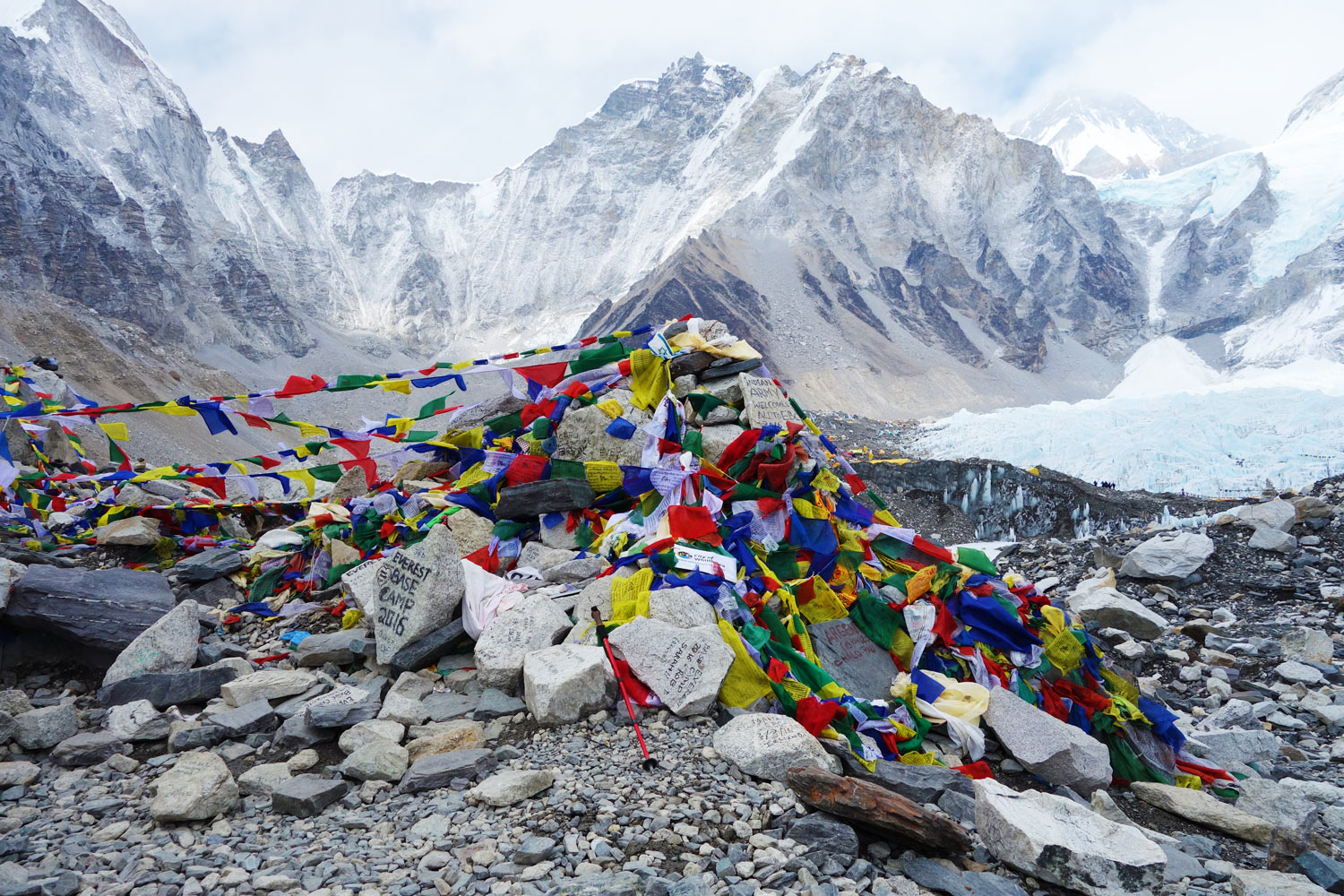
When is the best time to trek to Everest Base Camp?
The best time to trek Everest Base Camp is during the dry and warm months of September through November of March through late May / Early June.
The monsoon rains arrive in mid-late June and get into full swing for the months of July and August (as seen in the average rainfall map below). The route is really too wet for trekking and you would be better placed to explore treks in rain shadow areas like the Upper Manang, Mustang, Annapurna or Dolpo region.
December, January and early February are very cold. Treks run during these periods but be prepared for freezing temperatures and possible snow flurries. The upside is that the route is a lot quieter than in the peak seasons.
The chart shows average temperatures and rainfall in Nepal (data from 1960-1990 compliments of the Climate Change Knowledge Portal at the World Bank ).

Is altitude sickness a risk on the Everest Base Camp hike?
Yes, altitude sickness is a risk on the Everest Base Camp route. The trek takes one from a moderately high altitude, 2,800 meters in Lukla, to high altitude, over 5,300 meters at Everest Base Camp and over 5,500 meters at Kala Patthar. At these higher altitudes, the body needs to have acclimatised to the lower saturation of oxygen in the air in order to avoid the symptoms of altitude sickness (or what is sometimes referred to as Acute Mountain Sickness – AMS).
The good news is that a typical Everest Base Camp hike has a slow ascent profile which maximises the amount of time available to acclimatise. Nonetheless, every year 100s of people suffer altitude sickness symptoms and some need to cut their trek short due to more severe complications.
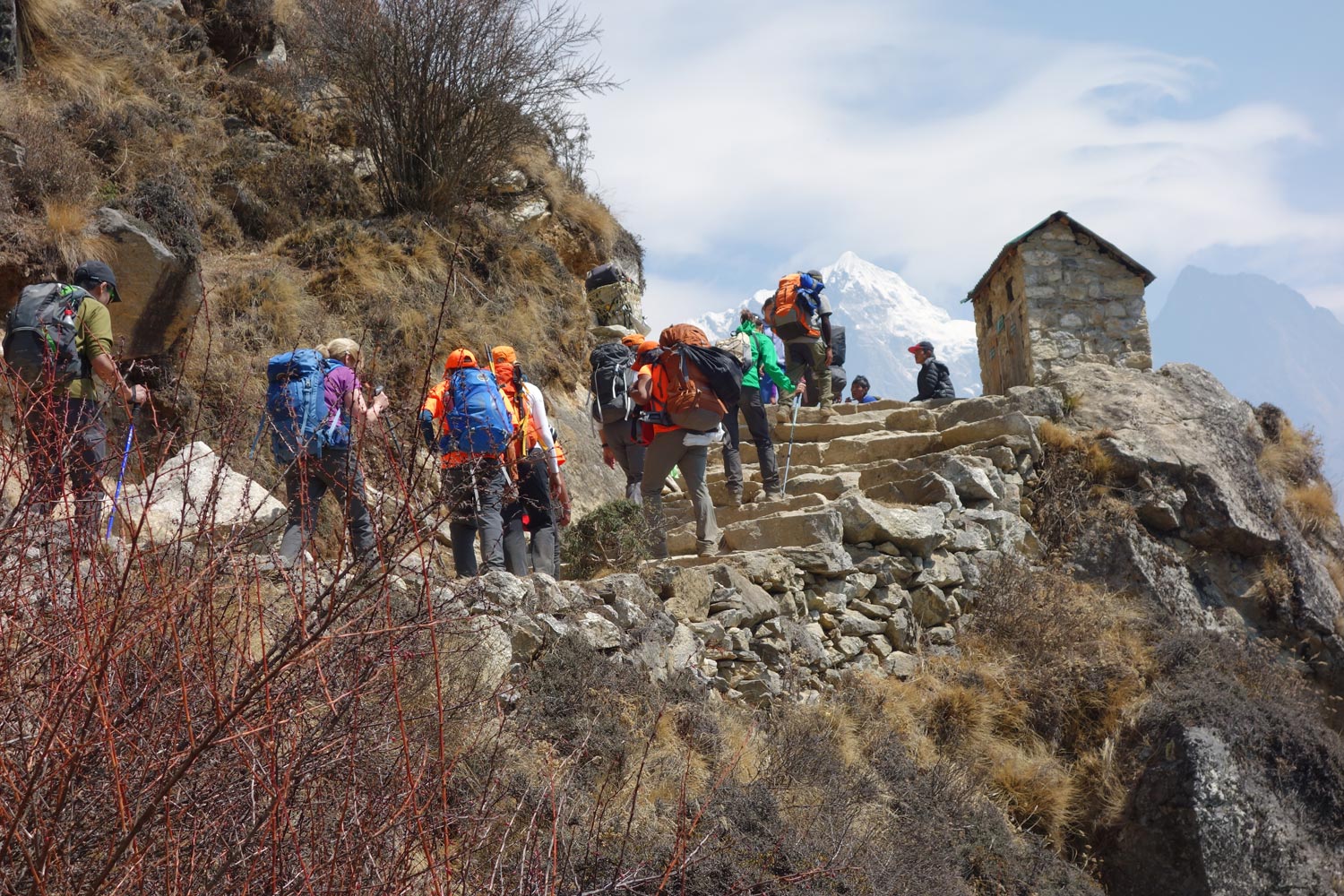
How difficult is the Everest Base Camp Trek?
The difficulty of the Everest Base Camp Trek is relatively low. It should be noted that the Everest Base Camp trek requires no climbing expertise and there are certainly no technical climbing sections. With determination and a basic fitness level, you should be able to trek the route. We have seen old and young, overweight and underweight complete the trek – all with a smile on their face!
With that being said, there are certainly some factors that should be considered prior to your trek, such as altitude, length and training that will enable you to better understand what you are getting yourself into before deciding.
What gear do I need for the EBC Trek?
One of the most frequent questions that we get asked is what gear should be packed for an Everest Base Camp trek.
To make your life a lot easier we have written a very detailed Everest Base Camp packing list article. The list is fairly exhaustive but includes all the absolutely necessary items of clothing and outdoor gear that you should bring with you.
You will have the opportunity to either buy or rent gear in Kathmandu, Lukla or even in Namche Bazaar, but in general we recommend you bring with you the main items (i.e. hiking daypack , hiking boots, warm down jacket, sleeping bag and sleeping mat , trekking poles , appropriate trekking clothes, headgear and headlamp and gloves etc.)
What travel insurance do I need for the EBC hike?
Trekking Everest Base Camp comes with obvious risks. We recommend you get travel and trekking insurance for all treks in Nepal .
On the Everest Base Camp route, you will reach a maximum altitude of 5,416 meters, so it is important you choose an insurance package that covers you up to that altitude.

Are there any recommended guidebooks for the Everest Base Camp Trek?
Absolutely. There are some great guidebooks and trekking maps to choose from when doing the Everest Base Camp Trek.
The classic EBC trail itself is well-worn, but there are many smaller yak trails that can confuse people.
We recommend taking a detailed trekking map. The region is sparse, and it is possible to get lost in the many valleys that lie on either side of the main trail. The most recent Lonely Planet Trekking in the Nepal Himalaya provides the most up to date information and maps of the region.
Sian Pritchard-Jones and Bob Gibbons’s book: A Trekking Guide to Everest is also rather good.
For a more general guide to Nepal, you may want to check out the Nepal Lonely Planet Travel Guide .
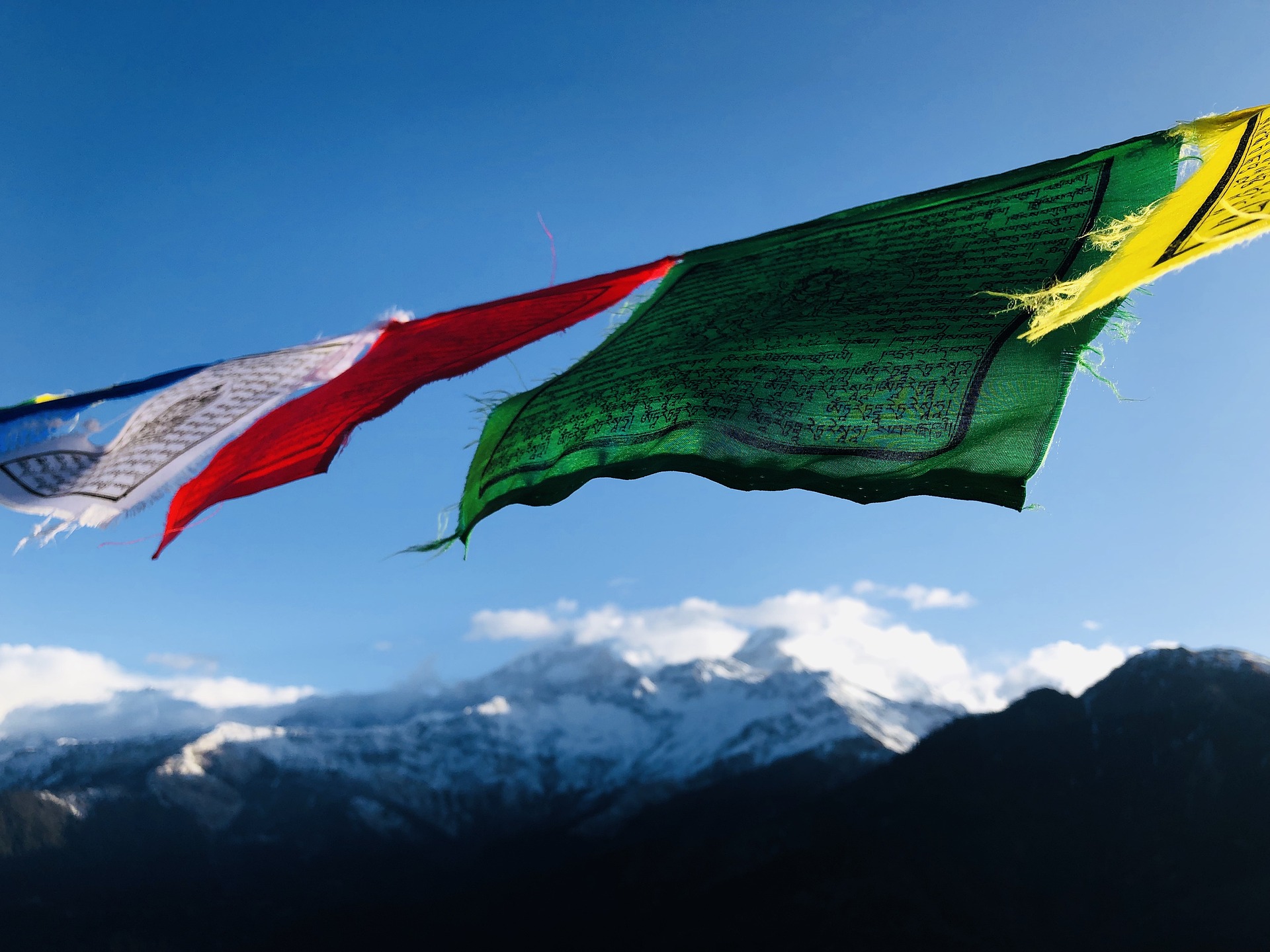
Are there any other hikes in Nepal you would recommend?
Yes, there are many other hikes in Nepal that I love.
Some of the most popular alternative Nepal trekking routes are the Annapurna Circuit Trek , the Langtang Valley Trek and the Manaslu Circuit Trek . If you're looking for some easy Nepal hikes , then check out the Poon hill hike or the Royal hike . For short Nepal hiking routes see the Helambu hike , which is near Kathmandu.
Continue browsing
See more information on Nepal . Or check out these other Everest/Nepal articles:
- Best Climbing Mount Everest Tips
- Food on the Everest hike
- Internet Access on EBC hike
- Everest Base Camp Trek Deaths and Statistics
- Best Places to Visit in Nepal
- What to Expect in Nepal Tea Houses
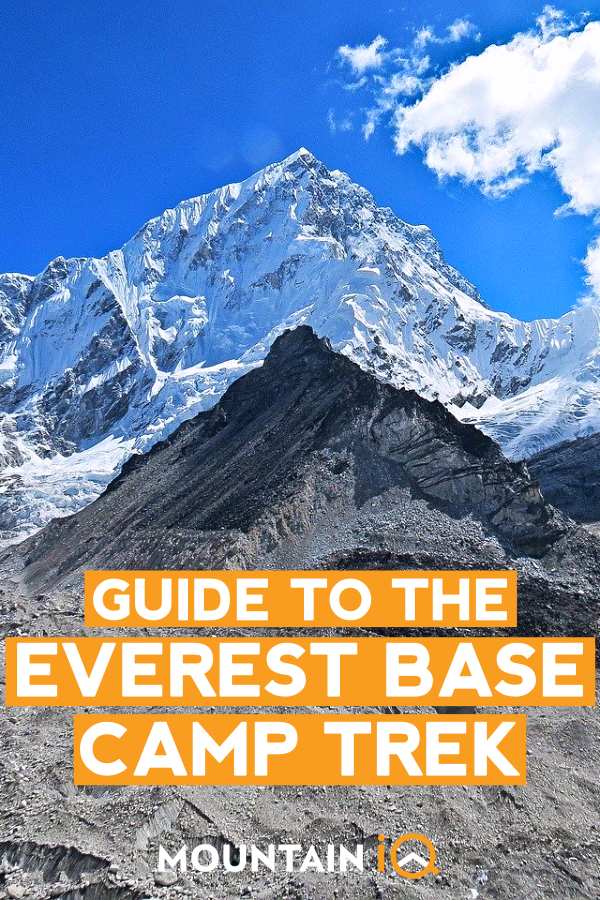
About the author
Mark Whitman
Mark has trekked extensively in Asia, Europe, South America and Africa. He founded Mountain IQ in 2014 with the sole aim to be the best online information portal to some of the most popular mountain destinations around the world. When not writing for Mountain IQ, Mark is out exploring the outdoors with his wife!
Leave a Reply
Your email address will not be published. Required fields are marked
Nice article. Full of true information and very supportive for new trekkers.
We work with local guides to offer great value adventures at unbeatable prices

EVEREST BASE CAMP TREK

EVEREST BASE CAMP

Pin Tweet Share WhatsApp
THE ESSENTIAL GUIDE
In this guide we cover everything you need to know about the Everest Base Camp Trek in Nepal. This includes suggested itineraries and practical information about accommodation, costs, what to pack, independent vs. guided treks, transport, and more. We also offer a route map with GPX download for use on the trek. And along with this written guide, we also share ‘silent hiking’ films that work well as a visual guide to the trail.
A chance for an adventurous and exciting journey, the Everest Base Camp Trek serves up spectacular scenery and gets you close to the world’s highest mountains, and as one of Nepal’s best known treks, it attracts people of all ages and experience levels. The trek ascends to high altitude (5000 m +) and is challenging, but it is achievable with a sensible itinerary that includes proper acclimatisation. Read on to discover more and start planning your own EBC trek.
Use the drop down menu below to jump to each section of this guide
TABLE OF CONTENTS
EVEREST BASE CAMP TREK OVERVIEW
EBC TREK FILMS
EVEREST BASE CAMP MAP & GPX DOWNLOAD
ELEVATION PROFILE & 3D ROUTE MAP
EVEREST BASE CAMP ITINERARIES
- THE CLASSIC EBC TREK
- EBC TREK VIA KHUMJUNG & PHORTSE
- EBC VIA KONGMA LA (5514 m)
- EBC AND GOKYO LAKES TREK
- BUFFER DAYS
EVEREST BASE CAMP TREK SUMMARY
- LULKA TO NAMCHE BAZAAR
- NAMCHE ACCLIMATISATION DAY
NAMCHE BAZAAR TO DINGBOCHE
- ALT. ROUTE VIA KHUMJUNG & PHORTSE
DINGBOCHE ACCLIMATISATION DAY
Dingboche to everest base camp.
- ALT. ROUTE VIA KONGMA LA
EVEREST BASE CAMP TO LUKLA
- ALT. ROUTE VIA CHO LA & GOKYO LAKES
BEST TREKKING SEASONS
HOW TO GET TO LUKLA
HOW TO GET TO LUKLA WITHOUT FLYING
EVEREST BASE CAMP TREK PERMITS & FEES
TREKKING INDEPENDENTLY
TREKKING WITH A GUIDE (& PORTER)
RECOMMENDED TREKKING AGENCY
ACCOMMODATION ON THE EBC TREK
FOOD ON THE EVEREST BASE CAMP TREK
SAFE DRINKING WATER
WIFI, PHONE SIGNAL & CHARGING
EVEREST BASE CAMP TREK COST & BUDGET
MONEY & ATMs ON THE EBC TREK
WHAT TO PACK FOR THE EBC TREK
ALTITUDE AWARENESS & AMS
TRAVEL INSURANCE
GETTING TO NEPAL
NEPAL TOURIST VISAS
Nepal visa on arrival process.
WHERE TO STAY IN KATHMANDU
BUDGET KATHMANDU ACCOMMODATION
Mid-range kathmandu accommodation, high-end kathmandu accommodation.
MAPS, GUIDEBOOKS & APPS
*Some of the links in this post are affiliate links – if you purchase a product or service via these links, we may earn a small commission at no extra cost to you . This helps offset the cost of running this blog and keeps us travelling so that we can continue to produce great content for you. As an Amazon Associate, we earn from qualifying purchases. We greatly appreciate your support!*
- DISTANCE | 120 -143 km depending on route taken (incl. acclimatisation/day hikes)
- DURATION | 12 – 15 days depending on route (incl. flying to/from Lukla)
- START/END | Lukla
- PERMITS REQUIRED | Khumbu Trek Card 2000 NPR; Sagarmatha National Park Fee 3000 NPR (SAARC nationals 1500 NPR / Nepali nationals 100 NPR)
- TREKKING SEASON | Best Seasons: April to Mid-May , October to Mid-November ; Shoulder Seasons: March, Late May, September, Mid-November to December ; Avoid: June to August, January to February
- TREK DIFFICULTY | Moderate (challenging if including Kongma La or Gokyo Lakes)
- ELEVATION GAIN/LOSS | +/- approx 7600 metres (Classic EBC Trek incl. acclimatisation/day hikes)
- MAX ALTITUDE | 5611 m (Kala Patthar)
- GUIDE MANDATORY? | Khumbu Pasanglhamu Rural Municipality has stated that it is NOT mandatory to trek with a guide in the Khumbu region
- ACCOMMODATION | Teahouses/Guesthouses in villages along the trail
- TREK COST | $35 – $144 USD per person, per day (budget independent trekker to fully inclusive package)
- RECOMMENDED TREKKING AGENCY | Himalayan Masters , Quote HOGG5 for 5% discount
DISTANCE 120 -143 km depending on route taken (incl. acclimatisation/day hikes)
DURATION 12 – 15 days depending on route taken (incl. flying to/from Lukla)
START/END Lukla
PERMITS REQUIRED Khumbu Trek Card 2000 NPR Sagarmatha National Park Fee 3000 NPR (SAARC nationals 1500 NPR, Nepali nationals 100 NPR)
TREKKING SEASON Best Season April to Mid-May October to Mid-November Shoulder Seasons March, Late May, September Mid-November to December Months To Avoid June, July, August January and February
TREK DIFFICULTY Moderate (challenging if including Kongma La or Gokyo Lakes)
ELEVATION GAIN/LOSS +/- approx 7600 metres (Classic EBC Trek incl. acclimatisation/day hikes)
MAX ALTITUDE 5611 m (Kala Patthar)
GUIDE MANDATORY? Khumbu Pasanglhamu Rural Municipality has stated that it is NOT mandatory to trek with a guide in the Khumbu region
ACCOMMODATION Teahouses/Guesthouses in villages along the trail
TREK COST $35 – $145 USD per person, per day (budget independent trekker to fully inclusive package)
OUR RECOMMENDED TREKKING AGENCY Himalayan Masters , Quote HOGG5 for 5% discount
EVEREST BASE CAMP TREKKING FILMS
Get a sense of the Everest Base Camp trekking route in our ‘silent hiking’ style ambient films.
EVEREST BASE CAMP TREK MAP & GPX DOWNLOAD
MAP & GPX DOWNLOAD
We have created a detailed Everest Base Camp trekking map to accompany this guide. It shows the Classic Everest Base Camp trekking route along with the alternative routes outlined in this guide, going via Khumjung and Phorste, Kongma La, and Cho La and Gokyo Lakes. The main side/acclimatisation hike options are included too, and the overland route between Salleri and Lukla is also marked.
Detailed stats and an elevation profile are included for each route section. Guesthouse settlements and tea shops are also marked, as well as key sights and practical info such as checkpoints, hospitals, and transport hubs. Guesthouses as per our own trek itinerary are marked, including info about prices and services, phone numbers (where possible), and a copy of the menu. Photos are included with almost every pin.
You can use the digital map online, or download it for offline use with a mapping app such as Organic Maps, Maps.me or Gaia GPS. This is very helpful for navigation assistance on the trail. It allows you to quickly pinpoint key places and services along the way and calculate distances and elevation differences between destinations.
Note that while we’ve tried to be as accurate as possible when recording and mapping the route, changes on the ground are inevitable (especially on routes crossing glaciers) and this map should not be solely relied upon for navigation.
EVEREST BASE CAMP TREK ELEVATION PROFILE
ELEVATION PROFILE
The image below shows the elevation profile of the Classic Everest Base Camp trek, starting and ending in Lukla. The route shown here includes the various acclimatisation and side hikes as outlined in the suggested itinerary below. Elevation is displayed in metres and distance in kilometres.

3D ROUTE MAP
Watch our 3D relief map video to visualise the landscape and get a sense of the Everest Base Camp trek.
EVEREST BASE CAMP TREK ITINERARY
ITINERARY OPTIONS
There is more than one trekking route to Everest Base Camp . In this section we outline the Classic EBC trek itinerary, but also include three alternative itineraries which enable you to vary your route on the way to and from Base Camp and see much more of the Khumbu region.
We have created an overview table for each of the Everest Base Camp trek itinerary options. These include trekking distances and approximate trekking times for each day (excluding lunch stops, breaks, etc), as well as stats on elevation gain/loss and sleeping altitude. For each itinerary the assumption is that you will fly into Lukla on the morning of Day 1 and start trekking. You will need to add 3 – 5 days if you plan to travel overland from Kathmandu to Lukla or vice versa.
It is also possible to combine the following itineraries to create your own alternative EBC trek. For example, you could trek via Khumjung, Phortse and Kongma La on the way to EBC, or you could include both Kongma La and Gokyo Lakes. A few minor possible alternatives along the way are noted below each itinerary, such as alternate overnight stops.
If viewing the itinerary tables on a mobile device or tablet, scroll to the right to see the full table or flip your screen to landscape mode
CLASSIC EVEREST BASE CAMP TREK ITINERARY
A classic Everest Base Camp trek itinerary is 11 nights/12 days, following the exact same route on the way to and from EBC. If you have limited time, this is the shortest itinerary you can follow while sticking to safe altitude ascent rates.
DAY 1 ALT. INFO*
*Alternatively, continue to Monjo (2830 m) where fewer people stay overnight (a further 5.1 km, approx 2 hours trekking time) . Doing this means the trail will be less busy for both your Phakding to Monjo section, and the Monjo to Namche section the following morning.
DAY 4 ALT. INFO**
**Alternatively, continue to Pangboche (3950 m) where fewer people stay overnight (a further 4.2 km, approx 1.5 hours trekking time). Pangboche is a lovely village with fantastic views of Ama Dablam, and there are many guesthouses. Tengboche, on the other hand, only has two guesthouses and it can be difficult to get a room here in peak season. Continuing to Pangboche also means the trail will be less busy for both your Tengboche to Pangboche section, and the Pangboche to Dingboche section the following morning.
DAYS 8 & 9 ALT. INFO***
***On days 8 and 9 the classic itinerary that most people follow is to visit EBC after lunch at Gorak Shep, then hike up Kala Patthar in the dark for sunrise the next morning (when it is bitterly cold). If you swap these two around as per the above suggested itinerary, you are guaranteed to have a less busy experience at both EBC and on the trail up Kala Patthar. As the skies are usually clearer in the morning you are also likely to have better views at EBC, however it is possible that the views from Kala Patthar will be obscured by afternoon clouds. If you’re lucky and have clear afternoon skies, then you will be treated to a fiery sunset glow on Everest and the surrounding mountains. If you hike up Kala Patthar in the morning, your mountain views will be brief as the sun rises directly behind Everest and you’ll soon be looking directly into the sun.
ALTERNATIVE EVEREST BASE CAMP TREK ITINERARY VIA KHUMJUNG AND PHORTSE
Our first alternative Everest Base Camp trek itinerary is 12 nights/13 days. This itinerary follows a different route between Namche Bazaar and Pangboche on the way to EBC, by trekking via Khumjung and Phortse. The overall difficulty of this route remains moderate, and the additional day allows you to explore more of the region and gives more time for acclimatisation. It’s also a great option for avoiding crowds during the peak trekking seasons, as far fewer people trek this alternative route.
DAYS 9 & 10 ALT. INFO**
**On days 8 and 9 the classic itinerary that most people follow is to visit EBC after lunch at Gorak Shep, then hike up Kala Patthar in the dark for sunrise the next morning (when it is bitterly cold). If you swap these two around as per the above suggested itinerary, you are guaranteed to have a less busy experience at both EBC and on the trail up Kala Patthar. As the skies are usually clearer in the morning you are also likely to have better views at EBC, however it is possible that the views from Kala Patthar will be obscured by afternoon clouds. If you’re lucky and have clear afternoon skies, then you will be treated to a fiery sunset glow on Everest and the surrounding mountains. If you hike up Kala Patthar in the morning, your mountain views will be brief as the sun rises directly behind Everest and you’ll soon be looking directly into the sun.
EVEREST BASE CAMP VIA KONGMA LA TREK ITINERARY
Our second alternative Everest Base Camp trek itinerary is 13 nights/14 days. This changes the route taken between Dingboche and Lobuche on the way to EBC by crossing a high pass called Kongma La (5514 m). This section is more challenging than the rest of the route, but it offers incredible scenery and the chance to explore much quieter sections of trail than you’ll experience on the classic EBC route.
DAY 8 ALT. INFO**
***There are two viewpoints on the Chukhung Ri acclimatisation hike, the lower one (5380 m) which most people visit and the higher one (5516 m) which involves a tough and steep climb towards the end.
DAYS 10 & 11 ALT. INFO****
****On days 8 and 9 the classic itinerary that most people follow is to visit EBC after lunch at Gorak Shep, then hike up Kala Patthar in the dark for sunrise the next morning (when it is bitterly cold). If you swap these two around as per the above suggested itinerary, you are guaranteed to have a less busy experience at both EBC and on the trail up Kala Patthar. As the skies are usually clearer in the morning you are also likely to have better views at EBC, however it is possible that the views from Kala Patthar will be obscured by afternoon clouds. If you’re lucky and have clear afternoon skies, then you will be treated to a fiery sunset glow on Everest and the surrounding mountains. If you hike up Kala Patthar in the morning, your mountain views will be brief as the sun rises directly behind Everest and you’ll soon be looking directly into the sun.
EVEREST BASE CAMP AND GOKYO LAKES TREK ITINERARY
Our third alternative Everest Base Camp trek itinerary is 14 nights/15 days. This varies the route taken between Lobuche and Namche Bazaar on the way back from EBC, by crossing a high pass called Cho La (5368 m) and descending via the spectacular Gokyo Lakes. Again, this route is more challenging than the classic or first alternative EBC itineraries we suggest, due to the extra distance and overall elevation gain. However, it is a highly rewarding trek which includes some of the most spectacular locations in the Khumbu region. The sections of trail that you must repeat on the way to and from EBC are kept to an absolute minimum on this itinerary.
IMPORTANCE OF BUFFER DAYS
Building in buffer days to your Everest Base Camp itinerary is highly recommended, especially if you plan on flying to/from Lukla. Flights are regularly cancelled due to poor weather conditions, sometimes for a number of days. If everything runs smoothly, it takes half a day or less to get to/from Lukla at the start/end of your trek. However, if flights are not operating, it can take up to 3 days to travel overland from Kathmandu to Lukla, using a mixture of buses and jeeps, and by trekking too. Therefore, it’s wise to have at least 3 or 4 days between the end of your planned trek itinerary and any international flight. This would allow you time to get from Lukla to Kathmandu overland if necessary.
Of course, a delay could also happen at the start of your trek while trying to get to Lukla, and this might leave you struggling to catch up with your original itinerary. Having a couple of buffer days built in will mean you don’t have to drastically alter your itinerary, avoiding the need to walk extra long distances to save a day or skipping places because you don’t have time.
Buffer days also allow you to alter your itinerary on the go more easily. For example, if you get sick and need to spend an extra night somewhere, or the weather is bad and you want to wait it out before continuing your trek, then you have the extra days on hand.
It’s worth knowing that should everything go to plan and you don’t need to use any buffer days during your trek, it’s straightforward for a trekking agency to change the date of your flight, bringing it forward a few days for example. However, this is not so easy if you have booked your flight online, independently.
OUR RECOMMENDED TREKKING AGENCY
We partnered with Himalayan Masters for our Langtang Valley, Gosainkunda, EBC and Everest Three Passes treks, and found them to be professional and committed to a high level of service
To enquire about booking your own trek, get in touch via email at [email protected] and mention the code HOGG5 to get a 5% discount off the cost of your trip
ROUTE SUMMARY
LUKLA TO NAMCHE BAZAAR
The first two days of the Everest Base Camp trek are repeated in reverse on the final day of the trek. With only one route connecting Lukla and Namche Bazaar, unfortunately there’s no avoiding this.
This section of the trek passes through numerous villages and teahouse settlements, the last of which is Jorsale, shortly beyond the entrance to Sagarmatha National Park. There are five suspension bridges to cross, including the 125 metre high Hillary Bridge, and numerous smaller fixed metal bridges. The Khumbu Trek Card Registration desk (where you get your Khumbu Trek Card and pay your Sagarmatha NP entrance fee) is shortly beyond Lukla, and there are further checkpoints at Toc Toc, Monjo, and just before Namche Bazaar.
The route follows a mixture of wide stone paths, riverside paths, and forest trail, with plenty of up and down along the way. There is one notable ascent, a 700 metre climb immediately after crossing the Hillary Suspension Bridge, on the last stretch before Namche. This section is a pleasant couple of days and a good introduction to the trek, with greenery and the chance to see colourful rhododendrons and blossoms in spring, plenty of scenic river views, and a definite buzz thanks to all the people coming and going and the numerous villages dotting the trail.
With only one route up and down to Namche, traffic jams are common along this section, with trekkers, porters, and pack mules, yaks and their handlers all sharing the same trail. Bottlenecks are particularly common at suspension bridges and on the steep climb up to Namche. Be sure to wait on the side of the trail without a drop-off when letting pack animals pass, and don’t start crossing a bridge if you can see them coming in the opposite direction – let them cross first. Finally, stick to the left side when walking by any mani stones, mani walls and prayer wheels, as it’s both common practice and culturally appropriate.
For more detail about this section of the route, see Days 1 and 2 of our Everest Three Passes Route Guide .

The Hillary Suspension Bridge as seen from the valley floor, with the old bridge still in place below

NAMCHE BAZAAR ACCLIMATISATION DAY
It’s important to acclimatise properly throughout your Everest Base Camp trek. This allows your body time to get used to the ever-increasing altitude as you ascend to 5000 metres and above. Building in rest days, staying well hydrated, and going on acclimatisation hikes (where you climb higher during the day but sleep lower at night) are all good ways of helping your body acclimatise.
Unless you are already acclimatised (for example you have been at altitudes of 4000 metres and higher within the previous week), spending a second night at Namche Bazaar is highly recommended and this is standard on virtually all Everest Base Camp trek itineraries. You should do this even if it seems like you feel physically fine.
The most common destination for an acclimatisation hike from Namche Bazaar is the Hotel Everest View (3880 m) , where you can get lunch or a drink and enjoy fantastic views from the terrace. It takes around 3 hours to hike up to the hotel and back down again. A must-visit on the way is Sagarmatha Next , a learning / experience / visitor centre and gallery championing waste management solutions for the Khumbu region.

Morning view over Namche Bazaar from the northeast

Morning view of Namche Bazaar from the northeast
For a longer hike and the chance to see more of the local area, doing a loop via Khumjung is a great option. Khumjung is the largest Sherpa village in the region, with an impressive monastery and a school founded by Edmund Hillary in 1960. The original classroom is now the Sir Edmund Hillary Visitor Centre , another great place to visit and learn about the Khumbu region. The loop hike (including Hotel Everest View) is around 7.5 km, and you should allow up to 5 hours for the hike. It’s also possible to include a visit to Khunde village, home to another monastery. This would extend the loop route to around 9.1 km and you should allow up to 6 hours.
If you plan to overnight at Khumjung on day 4 of your trek, following the ‘Alternative Everest Base Camp Itinerary’ outlined above, you might want to opt for a shorter Namche acclimatisation hike. Hiking 100 metres up to the helipad on the western side of the village is a good choice. There is an excellent view over Namche from here, where you can see it curving around the sloping hillside in amphitheatre-like fashion.
Various Namche acclimatisation hiking routes are marked on our EBC Trek map .
CLASSIC ROUTE VIA TENGBOCHE
This two-day section of the Everest Base Camp trek offers fantastic mountain scenery and a beautiful trekking trail, passing through forest and open hillside. There is one notable big climb between Phunki Thanga and Tengboche but otherwise the trail is mostly straightforward, with just a few short steep sections, and plenty of flat, undulating, or gentle climbs. There are a handful of small villages along the route, two suspension bridges, a checkpoint at Phunki Thanga, and an impressive monastery at Tengboche which is well worth visiting (daily 7am – 8am, 9am – 11am, and 1pm – 5:30pm, monks chanting at 3pm). After Pangboche you are more or less above the treeline, surrounded by imposing mountains and expansive views.
For more detail about this section of the route, see Days 4 and 5 of our Everest Three Passes Route Guide .

Trekkers pass through Shomare on the way to Dingboche, with the twin peaks of Ama Dablam rising behind

Trekkers pass through the village of Shomare on the way to Dingboche, with the twin peaks of Ama Dablam rising behind
ALTERNATIVE ROUTE VIA KHUMJUNG AND PHORTSE
This three-day route section follows an alternative trail between Namche and Pangboche before joining the classic Everest Base Camp trail for the final stretch to Dingboche. Opting for this itinerary allows you to vary your route on the way to and from EBC and take advantage of much quieter trails. Plus, the extra day allows for a slower ascent pace, which is a good option for anyone who knows they are slow to acclimatise or prefers to follow a more cautious itinerary.
This route climbs initially to Khumjung, the largest Sherpa village in the region, then stays above the ‘Classic EBC’ route to Pangboche, offering fantastic views throughout. There is a small guesthouse settlement at Mong La (3970 m) which is the highest point on the way to Phortse, a scenic village with a number of guesthouses, local homes, and the Khumbu Climbing Centre .
There is plenty of up and down on this section of the trek, with some notable climbs to Khumjung, Mong La, and both before and after Phortse. However, this route is not considerably more challenging than the ‘Classic EBC’ route, especially as it is split over three days instead of two.
Spending two nights at Dingboche, a sizeable village situated at 4300 m, is advisable in order to ensure you ascend to very high altitude at a safe rate. Going on an acclimatisation hike is also an important part of acclimatising to such altitudes, and Nangkartshang Peak (5039 m) is a great option. This hill rises to the north of Dingboche and there are fantastic views throughout the climb, especially of Ama Dablam. There is an obvious path all the way to the rocky top, which is festooned with prayer flags and spacious enough for plenty of people. The 766 metre climb should take around 2.5 – 3 hours, with the descent about half that. It’s advisable to start early (around 7:30am) for the best chance of clear views and calm conditions.

After a 760 metre climb, people rest and enjoy the views at the prayer flags on Nangkartshang

For a longer and less busy acclimatisation hike, a great option is the side hike up the valley to the east of Dingboche to Chukhung Village and Chukhung Ri, a viewpoint situated at 5380 m. The views from Chukhung Ri are fantastic, looking back down the valley and across to an impressive ice wall, and you’ll be surrounded by numerous majestic snowy peaks including Lhotse, Nuptse, Island Peak and Ama Dablam. Allow up to 8 hours for this return hike.

Plenty of outstanding views to appreciate while hiking up to Chukhung Ri

Plenty of outstanding views to stop and appreciate while hiking up to Chukhung Ri
Whichever acclimatisation hike you decide to do, ensure you have plenty of water, snacks, and warm layers with you.
For more detail about these hikes, see Day 6 (Nangkartshang) and Day 8 (Chukhung Ri) of our Three Passes Route Guide.
CLASSIC ROUTE
If you’re following the Classic EBC route you’ll trek from Dingboche to Base Camp over 2 – 2.5 days, spending a night at Lobuche and then at Gorak Shep. From Gorak Shep you’ll do a return hike to EBC. Most people also include a side hike to Kala Patthar, the highest point of the trek at 5611 m, where you can get a view of Mt Everest (which isn’t actually visible from Base Camp.)
The route heads up the valley to the northwest of Dingboche, climbs to Thok La pass, then heads northeast, running parallel to the Khumbu Glacier all the way to Base Camp. It’s a gradual ascent for most of the way, but at these altitudes (4300 m – 5300 m) even a gentle climb can take your breath away. The climb to Thok La on the way to Lobuche, the short but steep climb on the way to Gorak Shep, and the undulating rocky glacier section immediately before Gorak Shep are among the most challenging sections.
The views are wonderful throughout and the final sight of Everest Base Camp, encircled by soaring peaks, is a memorable one. This is especially true if you’re trekking during the peak climbing season, when a sea of tents sprawls across the glacier at the foot of the Khumbu Icefall – seen from the trail, these tiny yellow dots emphasise the enormity of the surroundings even more.

First sight of Everest Base Camp from the trail

Posing for the obligatory photo on the ‘EBC Rock’
Seen from the Kala Patthar trail about 30 minutes before sunset , the clouds part to reveal the summit of Mount Everest (8849 m)
Lobuche is a small settlement of guesthouses on the edge of the Khumbu Glacier, a very busy spot where everyone going to and from EBC stops for food and/or spends the night. Gorak Shep is even smaller, busier, and more basic with just four guesthouses and no good water supply.
For more detail about this section of the route, see Days 10 and 11 of our Everest Three Passes Route Guide .
ALTERNATIVE ROUTE VIA KONGMA LA
This alternative route to Everest Base Camp is a three day trek between Dingboche and Lobuche, via Chukhung, Chukhung Ri and Kongma La. At Lobuche you rejoin the classic route for the final section to Gorak Shep, Kala Patthar and EBC. This is part of the Everest Three Passes trek and is a challenging but very rewarding addition to the EBC trek. With far fewer people trekking this route compared to the Classic EBC route, you can expect the trail to be much quieter.
The route follows a gently ascending trail up the scenic valley to the northeast of Dingboche before reaching the small guesthouse settlement of Chukhung. It’s advisable to spend two nights here, using the extra day for an acclimatisation hike to the spectacular viewpoint of Chukhung Ri (5380 m) before crossing Kongma La the following day. The scenery around the village is very dramatic, as are the views seen throughout the hike to Chukhung Ri, with Ama Dablam rising to the south, Island Peak to the east, and Lhotse and Nuptse to the north, along with countless other peaks and the dramatic ice wall of the Chukhung Glacier.
The trek to Kongma La (5514 m) involves a long ascent but other than a couple of short steep sections, it’s mostly a steady climb, and the landscape is striking. From the pass you have incredible 360 degree views and you can see all the way down to Lobuche, a small cluster of buildings on the far side of the rocky Khumbu Glacier. The descent is somewhat steep and slippery at first due to loose dirt, shale, and small rocks, but becomes less steep as you work your way down to the eastern side of the glacier. The final section, crossing the glacier itself, involves plenty of up and down as you work your way across jumbled rocks and around small glacial lakes; on the other side, a final downhill stretch leads to Lobuche.
For more detail about this section of the route, see Days 7 – 9 of our Everest Three Passes Route Guide .

On the final approach to Kongma La

The Classic Everest Base Camp trekking route follows the same trail on the return to Namche Bazaar, covering the distance in three days with overnights at Pheriche, Namche, and Lukla. As you drop in altitude more oxygen flows through your blood and the physical strain on your body reduces. This combined with the fact that you no longer need to think about acclimatisation enables you to cover a much greater daily distance than on previous days. The return section of the trek is not all downhill however, and three 17 – 19 km days in a row can be very tiring!
ALTERNATIVE ROUTE VIA CHO LA AND GOKYO LAKES
An alternative route connects Lobuche and Namche Bazaar via Cho La and Gokyo Lakes. This turns your trek into a loop hike commonly known as the Everest Base Camp and Gokyo Lakes trek. Following this route over six days, you’ll cross Cho La (5368 m), a high pass to the west of Lobuche, descend from the pass and traverse the rocky Ngozumpa Glacier to reach Gokyo and a string of brilliant blue lakes, then follow the Gokyo Valley back to Namche where you’ll join the trail to Lukla. The route takes in some of the best scenery in the Khumbu region and is a fantastic alternative to the Classic EBC trek, although definitely more challenging with the addition of the high pass.
This route diverges from the classic trail a little south of Lobuche, working its way around a hillside to the northwest to reach the small guesthouse settlement of Dzonglha. The ascent to Cho La on the next morning is initially gradual, after which there are a couple of steep sections and the crossing of an icy glacier (microspikes recommended) just before the pass. The descent starts off steeply (aided by a fixed metal rope) before becoming more gradual as it works its way down the valley to the guesthouses at Dragnag (Thangnak). On the following morning* you have to cross the Ngozumpa Glacier, the largest glacier in Nepal, with a rocky, undulating trail passing small glacial lakes to reach Gokyo on the other side. The descent onto and climb off the glacier is quite steep.
*If you are looking to save a day it is possible to continue to Gokyo after crossing Cho La, without spending the night at Dragnag (Thangnak). It will very much depend on your energy levels and the weather conditions on the day.

Trekkers crossing the icy glacier towards Cho La (5368 m), the rocky dip ahead

Gokyo, a medium-sized teahouse village, sits on the western side of the glacier, on the shores of Dudh Pokhari, or Gokyo 3rd Lake. The setting is beautiful. You can visit the 4th Lake on a side hike to the north, and climb the steep trail to Gokyo Ri early the next morning for some of the most impressive views in the region. The return to Namche Bazaar is via the Gokyo valley, following the Dudh Koshi river. A good option is to break your journey at the small village of Dole, then continue beyond Namche to overnight at Monjo before the final stretch back to Lukla.

Early morning at Gokyo

Beyond Dole the trail descends towards Phortse Tenga, then climbs to Mong La, on the same route as outlined in the ‘Alternative Route via Khumjung and Phortse’ section. From Mong La it’s possible to descend all the way to Sanasa and take the same trail back to Namche that you followed on the way to Tengboche, or stay higher and follow a trail to the large Sherpa village of Khumjung before descending to Namche. The route between Namche and Lukla is the same as at the start of the trek.
For more detail about the Everest Base Camp to Gokyo section of the route, see Days 11 – 15 of our Everest Three Passes Route Guide .
SEE MORE FROM NEPAL

Everest Base Camp Trek: The Essential Guide

Everest Three Passes Trekking Route Guide

Everest Three Passes Trek: The Essential Guide

Gosainkunda Helambu Trekking Route Guide

Gosainkunda Trek: The Essential Guide

Langtang Valley Trekking Route Guide

Langtang Valley Trek: The Essential Guide

What To Pack For Trekking In Nepal

Upper Mustang Trek: The Essential Guide

Upper Mustang Trek Itinerary: A Day By Day Account

Annapurna Circuit Trek: The Essential Guide

Annapurna Circuit Trek Itinerary: A Day By Day Account

Manaslu Circuit Trek: The Essential Guide

Manaslu Circuit Trek Itinerary: A Day By Day Account
Everest base camp trekking season.
TREKKING SEASON
Like many treks in Nepal , the peak seasons for trekking the Everest Base Camp route are April to mid-May and October to mid-November . These months typically offer the best chance of both clear skies and warmer temperatures, although weather patterns are becoming increasingly unpredictable in Nepal and across the world, so you should still be prepared for snow and colder temperatures during these periods.
The spring trekking season coincides with the Everest climbing season , so the Khumbu region is very busy with helicopters and yaks transporting supplies to Everest Base Camp. If trekking at this time, you will have the chance to see base camp fully set up with all the tents, and there is a great buzz about the place. Outside of the climbing season, there are no tents or any other infrastructure at EBC.

Trekkers crossing the moraine-covered glacier between Lobuche and Gorak Shep on a clear skies spring morning

Trekkers crossing the moraine-covered glacier before Gorak Shep on a clear spring morning
In autumn, expect less wind and higher temperatures than in spring, while in late March and April, blooming rhododendrons and other spring flowers are a beautiful sight at some lower elevations.
The shoulder seasons are March, May, September and mid-November to December. During these times it can be much quieter on the trail. There is typically cold weather in March and December. In March there is a high chance of lingering or fresh snow. December typically has sunny weather and clear skies throughout the day. In late May and early September there is a higher chance of early or lingering monsoon rains and cloudy skies.
The summer months of June, July, and August coincide with the monsoon season . Trekking during this period means lots of walking in rain, muddy trails, leeches, and poor visibility with clouds obscuring the surrounding mountains. Many guesthouses close during this period, and it is not a good time to trek. Flights to and from Lukla are likely to be cancelled regularly and for days at a time.
The winter months of January and February are considered too cold by most to trek and many guesthouses are closed.
PLAN A TREK IN THE LANGTANG VALLEY

PLAN YOUR LANGTANG VALLEY TREK WITH OUR COMPLETE GUIDE

DETAILED TRAIL NOTES AND OTHER INFO FOR THE LANGTANG TREK
Lukla is the gateway for all treks in the Khumbu region, including Everest Base Camp, Everest Three Passes , and Gokyo Lakes. Nestled in the mountains at 2855 m, the closest dirt-road access is approximately 1 day’s walk away, with a tarmac road 3+ days’ walk away. The majority of people arrive in Lukla by air, landing at the small runway or helicopter pad at Tenzing-Hillary Airport (LUA). If you prefer not to fly, it’s possible to get to Lukla overland in 3+ days, by taking a bus/jeep then trekking on foot.
FLYING TO LUKLA
Flights to Lukla operate year-round from either Kathmandu or Ramechhap/Manthali (approx 4 hours’ drive from Kathmandu), although cancellations and delays are common as flights can only run in favourable weather conditions. The flight time is 30 minutes from Kathmandu, and 15 minutes from Ramechhap/Manthali. The Lukla runway is just 527 metres long and is sloped at an 11.7% gradient, making taking off and landing challenging for pilots and a little daunting for passengers.
Flights are operated by Tara (Yeti) Air , Summit Air , and Sita Air , with each company using small 15 seater twin propeller planes . Flights usually only operate in the morning, when the skies are clearer and there is less wind. There is a weight limit of 10 kg checked baggage + 5 kg hand baggage . The cabin is not pressurised and it’s very noisy. There are no assigned seats. For the best mountain views, try to sit on the left while flying to Lukla and the right on the return flight.
During peak trekking and climbing seasons , Lukla flights operate to and from Ramechhap/Manthali in order to ease congestion at Kathmandu Airport. The dates change annually, but this is roughly April 1st – May 20th and September 20th – November 20th . See below for how to get from Kathmandu to Ramechhap/Manthali.

The runway at the Tenzing-Hillary Airport in Lukla, sloped at an 11.7% gradient and just 527 metres long

The runway at Tenzing-Hillary Airport in Lukla, on an 11.7% gradient and just 527 metres long
Flight tickets cost $180 one way from Kathmandu and $152 one way from Ramechhap/Manthali . You can book online directly with the airline, or via an agency in Kathmandu. If you are booking an inclusive trekking package, for example with our recommended local trekking agency Himalayan Masters , your flight will be organised for you. Booking the earliest possible flight time is best as clouds tend to move in and the wind picks up through the morning, with later flights more likely to be cancelled. Note that agencies sometimes have access to earlier flights than are available to book online.
It is free of charge to change your flight date (in advance by calling the airline or in person at the airport) and it’s a good idea to reconfirm the day before you fly to avoid being bumped onto a later flight. Again, if you have booked through a trekking agency, they can take care of any flight changes and reconfirmations for you. This makes the whole process much more straightforward than if you have booked independently (especially if you’re trying to make changes while trekking with limited phone service or internet connection).
Be aware that it can be a bit chaotic at the airport and being bumped onto a different flight time and/or standing around confused about what’s happening is pretty normal. The situation is certainly easier to manage if you are with a guide, who will be used to the process, speaks the local language, and will take care of everything for you.
FLYING TO PHAPLU/SALLERI
Sometimes when flights can’t depart for Lukla, there is an option to fly to Phaplu (2 km north of Salleri) instead. From Phaplu it’s possible to trek to Lukla in about 3 days, or you can take a jeep as far as Thamdada (subject to road conditions) and trek the remaining distance to Lukla in 1 day.
See stages 2 and 3 in the ‘how to get to Lukla without flying’ section below for more details.
HOW TO GET FROM KATHMANDU TO RAMECHHAP AIRPORT (MANTHALI)
You can get from Kathmandu to Ramechhap Airport (RHP) (also known as Manthali) by public bus, shuttle bus, or private car. The journey takes around 4 hours.
Public buses depart between approx 0600 – 1100 from Ratna Park (also known as Old Bus Park) near Thamel, costing approx 600 NPR ($4.50 USD). The journey takes around 4 – 5 hours. You will need to spend one night at a guesthouse in Manthali before flying to Lukla the following morning. There are guesthouses within walking distance of Ramechhap Airport. You can just show up and buy a bus ticket on the day. Buses arrive at the Manthali Bus Park .
Shuttle buses depart from the Thamel area of Kathmandu at 0130 and 0200, allowing you to fly to Lukla the same morning. They also depart at 1100, if you prefer to travel during the day and spend one night in Manthali before flying to Lukla. The journey takes about 4 hours. You must make a reservation in advance. You can do this via a local agency, ask staff at your accommodation to help, or book online via Viator or Get Your Guide . Tickets cost up to $30 USD.
A private car costs approx 14000 NPR ($100 USD), which can be shared by up to 4 passengers. The road condition does not require a jeep/4×4 vehicle. The journey takes about 4 hours, with door-to-door service. You can book a private car via a local agency or ask staff at your accommodation to help organise it.
For the return journey from Ramechhap/Manthali to Kathmandu you must pre-arrange your shuttle transfer or private car transfer. If travelling back to Kathmandu by public bus, you should be able to get one from the Manthali Bus Park after arriving on the flight from Lukla.
HELICOPTER TO LUKLA
It is also possible to fly from Kathmandu to Lukla by helicopter. Helicopters can often fly in weather conditions that would ground twin propellor planes, they are generally considered safer, and they operate out of Kathmandu Airport year-round (unlike planes which only depart from Ramechhap/Manthali during peak season). Flying by helicopter is considerably more expensive though, costing around $500 USD one way per person (assuming there are enough people to fill five seats). You can book via a local travel or trekking agency, or book online in advance via Viator .

Morning mountain views on the helicopter ride to Lukla

Morning mountain views on the helicopter ride
It’s possible to get to Lukla without flying by using a combination of bus and/or jeep and trekking. This takes 3 – 5 days. Eventually there will be a road built all the way to Lukla, but for now the closest you can possibly get by jeep on a dirt road is Thamdada (1 day walk to Lukla), and by bus or jeep on a sealed road is Salleri/Phaplu (3 – 4 days’ walk to Lukla). Buses and jeeps stop for food and toilet breaks along the way. As the road between Salleri/Phaplu and Thamdada is unsealed, its condition can vary greatly depending on how much rain there has been. Sometimes it’s not possible to drive all the way to Thamdada, and you may only be able to reach Bupsa, Kharikhola, or Adderi.
Although it may be possible to get all the way from Kathmandu to Thamdada in one day, we do not recommend this as it means travelling on a dirt road with challenging hairpin bends and steep sections in the dark. Instead, it’s advisable to spend one night in Salleri where there are lots of guesthouses and travel to Thamdada the following day. At Thamdada, there is a guesthouse (Kare Hotel) at the jeep stop and two more approximately 25 minutes’ walk from the jeep stop. Additionally, there are many more guesthouses at Paiyu, which is around 2 hours’ walk away. It’s also possible to stop shortly before Thamdada to stay at a guesthouse in Kare (approx 1 hours’ walk to Thamdada).
The trekking route from Salleri to Lukla goes via Ringmu, Nunthala, Kharikhola, Bupsa, Kari La (Thamdada), Paiyu and Surke. Common overnight stops are at Nunthala, Bupsa, and Surke, after which you join the classic Lukla (or Cheplung) to Namche Bazaar route. There is a lot of elevation gain and loss on the Salleri to Lukla trekking route, so expect plenty of tiring up and down. The driving route from Salleri to Thamdada goes via Adderi and joins the trekking route shortly before Kharikhola.
KATHMANDU TO LUKLA OVERLAND STAGES
Step 1 // drive kathmandu to salleri/phaplu.
9 – 12 hours travel time (mostly sealed road); Phaplu is about 2 km north of Salleri
B us is approx 1700 NPR ($13 USD); departs from Chabahil Chowk (approx 0430) or from Koteshwor Chowk (approx 0500); no advance booking required
Shared Jeep is approx 2600 NPR ($20 USD) per person; d eparts from Chabahil Chowk and Koteshwor Chowk ( approx 0500); b est to reserve seat in advance (ask local travel agency or accommodation staff)
Private Jeep is approx $280 (can be shared between up to 7 people); d oor-to-door service, depart any time in morning; b ook via a local travel/trekking agency
STEP 2 // DRIVE SALLERI/PHAPLU TO THAMDADA (or Bupsa, Kharikhola, Adderi or elsewhere depending on road condition)
6 – 7 hours travel time (unsealed road)
Shared Jeep is approx 2600 NPR ($20 USD) per person; d eparts approx 0600; b est to reserve seat in advance; (ask your accommodation owner to book when you arrive in Salleri)
Private Jeep is approx $235 (can be shared between up to 7 people); d oor-to-door service, depart any time in the morning; b ook in advance in Kathmandu via a local travel/trekking agency
STEP 3 // TREK THAMDADA TO LUKLA OR CHEPLUNG
You can bypass Lukla itself and join the trail to Namche at Cheplung instead (you can get your Khumbu Trek Card from the checkpoint at Toc Toc as you will not pass the checkpoint at Lukla). There is a lot of up and down on this section. It is possible to cover the distance over two days if you prefer, staying at a guesthouse along the way (for example at Chheubas or Surke). The route and villages/guesthouses along the way are marked on our map .
To Lukla: 13.3 km | approx 7 hours trekking time | +1870 m / – 1744 m
To Cheplung: 13.9 km | approx 7 hours trekking time | +1785 m / – 1825 m
EVEREST BASE CAMP TREK PERMIT AND FEES
PERMIT AND FEES
You need two permits for the Everest Base Camp trek. Both are issued locally in the Khumbu region so you don’t need to organise permits in advance in Kathmandu. You will need your passport and the fee in cash in Nepalese rupees.
Keep your permits in a safe place as you will need to show them at various checkpoints during the trek.
KHUMBU TREK CARD
Issued at checkpoint (Lukla or Toc Toc)
C an register in advance online (not mandatory)
SAGARMATHA NATIONAL PARK FEE
(1500 NPR SAARC nationals/ 100 NPR Nepali nationals)
Pay at checkpoint in Lukla or NP entrance beyond Monjo
TREKKING EVEREST BASE CAMP INDEPENDENTLY
The Nepal Tourism Board announced on March 9th 2023 that as of April 1st 2023, all international trekkers in Nepal are required to hire a licenced trekking guide and obtain the TIMS card through an authorised trekking agency registered with the government of Nepal.
However, the Khumbu Pasanglhamu Rural Municipality has confirmed that it is NOT mandatory to trek with a guide in the Khumbu region. This means that you do not need to have a guide for the Everest Base Camp trek , or indeed for any other trek in the region such as the Gokyo Lakes or Three Passes treks. We have included copies of the official press release from April 2nd 2023 and an info card from September 2023 stating that a guide is not mandatory in the Khumbu region. You can check the Khumbu Pasanglhamu Rural Municipality Facebook page for any further updates.

PROS AND CONS OF INDEPENDENT TREKKING IN NEPAL
While having a guide in the Khumbu region is not mandatory, this does not mean that trekking to EBC independently is the right decision for you, especially if you are an inexperienced high altitude trekker. If you are thinking about doing the Everest Base camp trek without a guide, here are a few thoughts on the pros and cons of independent trekking in Nepal.
This is the cheapest way to trek to Everest Base Camp. You won’t have to pay for anything extra beyond your daily food and accommodation costs, permit fee, and transport to/from the trailhead.
You have complete freedom and flexibility. You can choose how long to trek for each day, what route to take and where to stay. If you like somewhere, you can choose to stay an extra day without having to consult anyone else or consider their needs.
It is easier to enjoy a bit of ‘alone time’ on the trail. If you are trekking with a guide or group it can be harder or more awkward to branch out and enjoy walking alone with your thoughts.
You’ll likely have more interaction with locals. If you are trekking with a guide it is common practice for them to deal with everything at your guesthouse and act as a go-between. It’s normal for your guide to take your order, bring out your food, and settle up the bill on your behalf, which means you may have little interaction with the owner or staff yourself. But, you’ll be doing all that by yourself if you trek independently.
With freedom and flexibility comes more responsibility and the need to do more research, preparation and daily planning. You will need to spend time organising things both on and off the trail. You will need to sort out all the logistics like your permit, transport, and accommodation by yourself, and be confident in your route planning and navigation.
You are more vulnerable in an emergency situation or if you get sick. This is especially true if you are trekking solo. You should prepare as best you can with a comprehensive medical kit, emergency contact numbers at the ready, and ideally an emergency communication device like the Garmin inReach .
In peak trekking season you may find it harder to get a room. Many guesthouses prefer bigger groups with organised companies and will give preference to them over independent solo trekkers or those in small groups. Guides with existing local contacts often call ahead to book rooms, something which isn’t as easy for independent trekkers with no personal contacts. Tengboche, Lobuche, and Gorak Shep all have limited accommodation options and it’s not uncommon for guesthouses here to be full during the peak seasons.
You miss out on all the insights a knowledgeable, English speaking guide can offer. Your understanding of the region, and Nepal in general, is likely to be much broader after spending two weeks in the company of a Nepali guide rather than going it alone.
This is the cheapest way to trek the Everest Base Camp. You won’t have to pay for anything extra beyond your daily food and accommodation costs, permit fee, and transport to/from the trailhead.
You have complete freedom and flexibility. You can choose how long to trek for each day, what route to take and where to stay. If you like somewhere, you can choose to stay an extra day without having to consult anyone else or consider their needs.
It is easier to enjoy a bit of ‘alone time’ on the trail. If you are trekking with a guide or group it can be harder or more awkward to branch out and enjoy walking alone with your thoughts.
In peak trekking season you may find it harder to get a room. Many guesthouses prefer bigger groups with organised companies and will give preference to them over independent solo trekkers or those in small groups. Guides with existing local contacts often call ahead to book rooms, something which isn’t as easy for independent trekkers with no personal contacts. Tengboche, Lobuche, and Gorak Shep all have limited accommodation options and it’s not uncommon for guesthouses here to be full during the peak seasons.
TREKKING EVEREST BASE CAMP WITH A GUIDE (AND PORTER)
TREKKING WITH A GUIDE (AND PORTER)
Although not mandatory, many people choose to do the Everest Base Camp trek with a guide, and often with a porter too. If you are an inexperienced high altitude trekker we would absolutely recommend hiring a guide for this trek, but even if you are experienced, trekking with a guide is a great option. Not only can a guide be invaluable when it comes to your safety, a guide can also enrich your experience on the trail, giving you the opportunity to learn more about the history, culture, and geography of the land. Hiring a porter to carry your bag will put less strain on your body, making your trek much easier and perhaps allowing you to better enjoy the surroundings. Hiring a guide and/or porter also provides jobs and supports the trekking tourism economy.
One guide can accompany a maximum of five trekkers. A porter shouldn’t be asked to carry more than 25 kg, ideally no more than 20 kg. If you pack appropriately, one porter can carry two trekkers’ bags. Ensure that your guide and porter have appropriate clothing and equipment for the trail, including warm clothing for high altitudes (a down jacket, hat, gloves), boots, sunglasses, and waterproofs.
WHAT TO EXPECT WHEN TREKKING WITH A GUIDE
If you are doing the Everest Base Camp trek with a guide you may meet them in either Kathmandu or Lukla. If you meet in Kathmandu, you will travel to the trailhead together and return to Kathmandu together at the end. Professional guides in Nepal are both licenced and insured, and will speak English (sometimes other languages too).
During your trek a guide will walk with you on the trail, suggest the best spots to stop for lunch, and take you to their recommended overnight accommodation. At busy times, they may call ahead and pre-book a room for you. They will act as your go-between at each guesthouse, arranging your room, taking your food orders, and settling the bill. It’s normal for a guide to run through the following day’s itinerary each evening, giving you an overview of the trail, trekking time, and any other relevant information.

A guide can help with many practical things, provide insight into local culture, and be a good companion on the trail

Your guide will always be around at your guesthouse, but they won’t stick by you constantly. You will have plenty of freedom to hang out in your room or the dining room, read your book, chat with other guests, play cards, etc. Guides sleep and eat in the same guesthouse as you, always in a separate room. A guide’s meals and accommodation are usually provided free of charge by guesthouses in exchange for their trekking clients’ custom. If a guesthouse is busy, your guide may share a room with other guides or be obliged to sleep in the dining room.
WHAT TO EXPECT WHEN TREKKING WITH A PORTER
If you’re doing the Everest Base Camp trek with a porter, you will usually meet them locally at the start of your trek. It is not common for porters to travel with you from Kathmandu due to the expense of getting to/from the Khumbu region. Trekking agencies usually have a pool of porters that they work with regularly and can arrange a porter as part of any trekking package. As porters usually do not speak English, your guide will communicate and organise the day-to-day logistics with your porter during the trek.
Porters often go at their own pace so you won’t always trek with them. It’s common to pack your bag and have it ready for them before breakfast, and for your bag to already be in your room when you arrive at your guesthouse for the evening.

A porter putting in the hard work on the Everest Base Camp Trek

CONDITIONS FOR PORTERS IN THE KHUMBU REGION
Conditions for trekking porters across Nepal are far from ideal, however they are particularly poor in the Khumbu region. Unlike in other trekking regions, guesthouse owners in the Khumbu do not permit porters to sleep or eat in their guesthouses alongside trekkers and guides (with the exception of a rare few based on our own experience). Instead, porters sleep and eat at designated Nepali hotels or porter shelters in each village or teahouse settlement in the Khumbu region. Also, unlike in other regions, porters in the Khumbu must pay for their meals, with a large proportion of their daily wage being spent on food.
The conditions in which porters sleep, often in one dormitory-style room with up to 100 or more porters, are much more basic than those experienced by trekkers and guides in guesthouses. Sometimes porter accommodation is full, and porters must walk to a different village to find available accommodation, returning to meet their trekking clients in the morning. This is especially common at Lobuche and Gorak Shep, where limited accommodation means that porters often have to walk for hours, back to Thukla or Pheriche to spend the night before returning early the next morning.
You can read more in the informative paper ‘ Uphill Struggle: Impediments and Facilitators to Porter Health in the Khumbu Region ’ by Nate Barott (2018).

Porters stop for a break at Lawi Schyasa, between Namche Bazaar and Tengboche on the Everest Base Camp trail

HOW TO ORGANISE AN EVEREST BASE CAMP TREKKING GUIDE (AND PORTER)
The easiest way to arrange a trekking guide is via a trekking agency . You can book an inclusive Everest Base Camp trekking package which covers your transport, entrance fees, guide (and porter), accommodation costs, and three meals a day. Alternatively, you can pay for a guide (and porter) only, and then pay-as-you-go for your accommodation, food, transport, and entrance fees (although this involves more day-to-day hassle than opting for an inclusive package).
Choosing a trekking agency is often the trickiest part as there are thousands of registered agencies in Nepal and the quality of service can vary greatly between them. Many trekkers will choose a guide or agency based on a trusted recommendation from a friend or fellow trekker, and this is a good approach. An alternative option is to visit a number of trekking agencies in person when you arrive in Thamel (Kathmandu) to get a feel for a company that you like, or to contact agencies online in advance.
Having trekked with three different agencies and three different guides on three visits to Nepal, our best experience has been with Himalayan Masters . We partnered with them for our Langtang , Gosainkunda Helambu , and Everest Base Camp and Three Passes treks, and found them to be very professional, committed to a high level of service, and competitively priced.
We really appreciate the fact that Sandip, the agency owner, is super flexible when it comes to itinerary amendments that don’t just follow the norm. He’s also a problem solver and what we’d call a real ‘go-getter’, a trait that’s highly valuable to his clients, whether he’s retrieving a swallowed bank card from a Thamel ATM in record time, or fixing logistical issues when things go wrong last minute at 2am (both real life examples experienced by us or fellow Himalayan Masters clients we met on the trail!).
We’d also highly recommend our Himalayan Masters guide, Govinda Rai, who we spent over a month trekking with in Nepal. He is very professional, taking care of everything you would expect from a guide, but also tailoring his suggestions and advice specifically to his clients, resulting in a more enjoyable trekking experience overall. We quickly came to trust his choices for lunch stops and accommodation as we felt they were always among the best options available. His knowledge of the trail was excellent, and his advice on trekking times for each day (based on our own pace) was spot-on, making it easier for us to plan our itinerary and make on-the-go changes as we saw fit. And on a personal level, we found Govinda to be easy-going, friendly, and an all-round great person to spend time with.

Govinda, o ur Himalayan Masters guide

Govinda, our Himalayan Masters guide
We also met a number of other Himalayan Masters guides while out on the trail, including Dipak who we chatted with lots, as our Langtang Valley trek itinerary coincided for three nights at the same guesthouses. From our interactions with Dipak, and positive feedback shared over dining room chats with his two trekking clients, we’re confident that Himalayan Masters are working with great guides across the board.
In addition to our guide, Govinda, we’d also highly recommend our porter, Prakas Tamang, organised last minute for us by Himalayan Masters. He knows the trail inside out, portering on the Everest Base Camp route, along with various others in the Khumbu region, multiple times a season. We felt he went above and beyond his role as a trekking porter, especially when breaking trail for us in snowy conditions while crossing Ngozumpa Glacier and Renjo La.
To discuss planning your Everest Base Camp trek you can get in touch with Himalayan Masters at [email protected] and you’ll get a 5% discount off your trip cost by using our code HOGG5 .
HOW ABOUT TACKLING THE MANASLU CIRCUIT?

DAY BY DAY ACCOUNT
ACCOMMODATION ON THE EVEREST BASE CAMP TREK
Accommodation.
Accommodation on the Everest Base Camp trek is in the form of guesthouses, also known as teahouses or lodges. These can be found regularly along the trail in local villages (such as Namche Bazaar and Dingboche) or in guesthouse-only settlements (such as Lobuche and Gorak Shep). In general, the standard of accommodation is decent on the EBC trek, but it becomes more basic at higher altitude, with accommodation at Gorak Shep (5160 m) the most basic (and the toilets the most unpleasant) of the whole trek.

The accommodation at Gorak Shep (5160 m) is the most basic on the Everest Base Camp Trek, but the mountain views are spectacular

Guesthouses provide both accommodation and meals, and you are expected to eat dinner and breakfast at the guesthouse you sleep at. Lunch is usually at a different guesthouse along the trail, unless you arrive early at your destination for the day.
Rooms are basic, but comfortable. They usually have two single beds, although some places will have rooms sleeping three, or just one. Beds always have a sheet-covered mattress, a pillow with a pillowcase, and a blanket. We have seen plenty of bedding hanging out to dry which would suggest sheets, pillowcases, and blankets do get washed, however there is no guarantee that they will be freshly laundered for each guest. Personally, we always trek with our own sleeping bag and silk liner, using the blanket over our sleeping bag for extra warmth at higher altitudes.
There is always a light in the room, powered by mains electricity or solar. Often there is a small table, some hooks on the wall, and a bin, and there is almost always a window with curtains. Some guesthouses will have charging sockets in the room, but this is not always the case. There is no heating in guesthouse rooms, only ever in the main dining room.
DINING ROOM
Every guesthouse has a dining room where you can eat your meals, drink tea, and hang out. There are usually tables and benches around the perimeter of the room, with plenty of plastic chairs for huddling around the central stove. Expect to see a display cabinet of snacks and sundries for sale (eg. chocolate bars, biscuits, Pringles, toilet paper, soft drinks), and often a Buddhist prayer altar, too. The dining room is the only room with a stove. This is usually lit in the late afternoon or early evening as the sun goes down and it starts to get cold, making it nice and cosy.

The dining room of Mountain Paradise Lodge in Dragnag/Thangnak on the Everest Base Camp and Gokyo Lakes Trek

The dining room of Mountain Paradise Lodge in Dragnag/Thangnak, a small teahouse settlement on the Everest Base Camp and Gokyo Lakes Trek
TOILETS AND SHOWERS
There are usually rooms with attached bathrooms (ensuite) available as far as Dingboche. After Dingboche, rooms with shared (common) bathrooms are generally all that is available. If you have an attached bathroom this will usually have a toilet, sink (not always), and shower. Shared bathroom facilities normally consist of separate toilets and shower rooms, with a sink outside, although sometimes there is no dedicated sink and you’ll need to wash your hands/brush your teeth at an outdoor tap.
Toilets may be sit-down or squat style. Toilet paper is never provided , so you’ll need to pack your own and buy more as you go. Do not flush toilet paper down the toilet, always put it in the bin next to the toilet (this may be an old tin can, a cardboard box, a plastic container, or such like.) Sit-down toilets will likely have an automatic flush, although at higher altitudes in cold weather, the pipes can freeze and you may need to flush the toilet using a bucket of water. Squat toilets never have an automatic flush; you always need to flush using the scoop and bucket of water provided.
A gas shower is usually available although sometimes the water is solar heated. If neither are available, guesthouses can provide a bucket of hot water which you can use to wash. You can expect to pay up to 800 NPR for any kind of hot water shower at guesthouses between Namche Bazaar and Lobuche. There are no shower facilities at Gorak Shep.
COME JOIN US ON INSTAGRAM

FOOD AND DRINK
Every guesthouse serves meals and you are expected to eat dinner and breakfast at the guesthouse you are sleeping at, otherwise the cost of the room will be much higher. There are also a few bakeries, coffee shops, and tea shops along the route where you can pop in for treats.
Every guesthouse has a menu, and the options for breakfast, lunch, and dinner are similar at each. Prices increase the higher you go as food and fuel needs to be transported further via porters or pack animals, resulting in additional costs. Meat is on the menu at most guesthouses (usually buffalo, yak, or chicken), but it’s advisable to stick to vegetarian food; meat is not usually fresh or kept refrigerated and the chance of getting an upset stomach is much greater if you eat it.
EVEREST BASE CAMP TREK MENU
Click into the slider to see a typical example of a menu on the Everest Base Camp trek. This menu is from Dingboche, where prices are more expensive than at lower altitudes but fairly representative of prices above 4000 m.
We have included photos of the menu from every guesthouse that we stayed at on the Everest Base Camp trek in our accompanying map .

Breakfast dishes include porridge, muesli, eggs, Tibetan bread (a kind of fried dough), chapati (flat, unleavened bread), and pancakes . Honey, jam, peanut butter, apples, chocolate sauce, and yak cheese are common accompaniments on offer.
Breakfast options are generally priced between 300 – 1200 NPR (approx $2 – $9 USD), depending on location and item.
LUNCH AND DINNER
Dal Bhat is a ubiquitous Nepali meal , eaten twice a day by many locals. It consists of plain rice, a lentil soup, veggie curry, papad (poppadom), and some sort of pickle. Depending on the veggies available, you may also get saag (spinach) or something similar. Everything is served on a big plate, and you can get free refills of each item (apart from the papad!).

There are always free refills of rice, dal and curry with Dal Bhat , giving rise to the familiar catchphrase ‘Dal Bhat power 24 hour’

With Dal Bhat , t here are always free refills of at least the rice, dal and curry, giving rise to the familiar catchphrase, ‘Dal Bhat power 24 hour’
Other options include various soups (some fresh, some from a packet), basic pasta dishes (usually fried), fried rice, fried noodles, boiled or fried potatoes, and momos (steamed or fried dumplings). Ingredients more or less revolve around eggs, cheese, potatoes, carrots, cabbage, onion, garlic, and tinned tuna.
Lunch and dinner options are generally priced between 350 – 1200 NPR (approx $2.5 – $9 USD), depending on location and item.
Various hot drinks include black/green/milk/masala/mint/ginger lemon honey tea, instant coffee, and hot chocolate . You can order a single cup or a small/medium/large thermos (called ‘pots’). Cups or pots of hot water are also available.
Soft drinks like Coke, Fanta, and Sprite are available to buy at each guesthouse shop, along with bottled water (although we recommend purifying tap water to drink instead of buying bottled water). You can also buy beer (bottles/cans) and small bottles of Khukuri rum , however it’s best to avoid alcohol at higher altitudes as this dehydrates you and makes acclimatisation more difficult.
Hot drinks are on average about 80 – 350 NPR per cup ($0.60 – $2.60 USD), or up to 800 – 3000 NPR per large pot ($6 – $22 USD). Soft drinks are about 300 – 600 NPR ($2.30 – $4.50 USD), bottled water is about 100 – 500 NPR ($0.75 – $3.80 USD), and beer is about 800 – 1200 NPR ($6 – $9 USD).
SNACKS AND DESSERTS
You can buy chocolate bars, biscuits, and Pringles at most guesthouse shops. Other snacks like popcorn, papad, prawn crackers, yak cheese, or french fries are often available on the menu, and you can usually get desserts like apple, Snickers, or Mars spring rolls/fritters/pies/momos.

A typical example of what’s on sale in guesthouses

A fairly typical example of what’s on sale
Prices for Snickers/Mars start from 300 NPR ($2.30 USD), packets of biscuits start from 100 NPR ($.75 USD), and Pringles start from 600 NPR ($4.5 USD). Desserts range from 350 – 900 NPR ($2.70 – $6.80 USD).
BAKERIES AND COFFEE SHOPS
You’ll find bakeries and coffee shops (some with even proper coffee machines!) in various villages along the Everest Base Camp trekking route. These include Namche Bazaar, Tengboche and Dingboche. Common bakery treats include brownies, cinnamon buns, and apple pie. A few bakeries in Dingboche also show mountain-related films every afternoon.
Coffee costs around 300 – 400 NPR ($2.20 – $3 USD); bakery treats are usually around 400 – 600 NPR ($3 – $4.5 USD).
FANCY THE BIGGEST TREKKING CHALLENGE IN THE KHUMBU REGION?

PLAN YOUR TREK WITH OUR GUIDE

TRAIL NOTES AND OTHER INFO
SAFE DRINKING WATER ON THE EVEREST BASE CAMP TREK
Bottled water is available to buy along the trail, however a much better option (environmentally and economically!) is to treat tap water and drink this instead. Come prepared with a refillable water bottle and/or water bladder , and a method of treating the water to make it safe for drinking.
The cheapest option is to use water purification tablets . You drop these into the water, wait about 30 minutes, then your water is safe to drink (although it can have a strange taste due to the active chemical in the tablets, ie. iodine or chlorine). You can buy these easily in supermarkets and outdoor shops in Kathmandu.
Our preferred method of water sterilisation is to use a Steripen Ultra in conjunction with a filter . The filter screws onto the top of our Nalgene water bottle and ensures any weird floaty bits or particulates are filtered out. Then we stick the Steripen into 1 litre of water for 90 seconds and the UV light sterilises the water, making it safe to drink immediately and with no change to the taste. The Steripen Ultra model is rechargeable via USB, so we can charge it using our solar panel, power bank, or an electrical socket. We always carry water purification tablets as an emergency backup, although we’ve never had to use them during 6+ years of using the Steripen.
Other common sterilisation methods include a Lifestraw , Grayl , Water-To Go , or a squeeze filter system .
As pipes can freeze overnight at higher altitudes, be sure to fill water for the following day before going to bed . There is usually a tap where you can fill your water bottle, but if not your guesthouse owner/staff can fill it for you from their water storage container.
The only place on the Everest Base Camp trek where it is not possible/advisable to drink the local water is at Gorak Shep . There is no good water supply here. The local guesthouses have to fill water from a questionable spring and store it in containers for use in the kitchen. Given the scarcity of water and the effort involved to carry it to the guesthouse, staff will not fill your bottle for you. The only option is to buy bottled water (500 NPR) or do as we did and carry enough water with you from Lobuche. Given the poor water supply and likely less than ideal hygiene standards at high altitude Gorak Shep (5160 m), it is not uncommon for people to get sick here. We would advise caution with what you order, perhaps avoiding hot drinks (which may not have been properly boiled).

WIFI, PHONE SIGNAL, AND CHARGING ON THE EVEREST BASE CAMP TREK
WIFI, PHONE SIGNAL, AND CHARGING
Nepal Telecom SIM cards work best on the Everest Base Camp trek. With NTC you’ll have a phone signal and usually a data connection for most of the trek between Lukla and Pangboche . You’re unlikely to get much of a signal beyond here.
WiFi is available at most guesthouses and bakeries along the trail. Between Lukla and Pangboche the usual WiFi cost for unlimited use at a guesthouse is around 300 NPR ($2.30 USD), although sometimes it’s free. Beyond Pangboche you can connect to the internet via Airlink . To do so you buy a card with an individual access code and this costs 600 – 700 NPR for 24 hours. Poor weather conditions can affect WiFi connectivity so there are no guarantees it will be working 24/7.
Most guesthouses run off solar power, and free in-room charging isn’t usually available. Instead you pay per device , charging in the dining room. Prices increase the higher you go, with one phone battery full charge costing between 200 – 800 NPR ($1.50 – $6 USD), and a power bank full charge costing between 1000 – 2000 NPR ($7.60 – $15 USD). Some guesthouses do offer free in-room charging (and a hot shower) if you are paying for a more expensive room with an attached bathroom. Depending on how many devices/batteries you need to charge, paying for the more expensive room can sometimes work out better value overall. Some coffee shops (notably in Dingboche) offer free phone charging with the purchase of food or drink.

One of the cafes in Dingboche offering free phone/battery charging for customers

It’s definitely a good idea to pack a power bank (or two, depending on your usage), enabling you to charge your phone and batteries on-the-go. A portable solar panel allows you to charge your devices for free in sunny conditions, and may be worth buying if you’ll continue to use it on future trips.
EVEREST BASE CAMP TREK COST AND BUDGET
COSTS AND BUDGET
The cost of your Everest Base Camp trek will very much depend on how you choose to trek (independently or with a guide), how many people you share the costs with, how much you eat and drink, and how often you want to have a hot shower, connect to the internet, or charge your devices.
EVEREST BASE CAMP TREK BUDGET SUMMARY
An inclusive Everest Base Camp trekking package with a local agency such as Himalayan Masters (quote HOGG5 for a 5% discount! ) usually works out at around $125 per day . This normally covers your accommodation during the trek in a mixture of rooms with attached and shared bathrooms, three meals and three hot drinks per trekking day, a guide and porter, internal flights, all airport transfers, all permits, and a couple of nights accommodation in Kathmandu. You will need to pay for any extras during your trek such as hot showers, charging devices, WiFi, and snacks – budget about $20 per day to cover all of this. You should also budget for a tip for your guide and porter.
An independent trekker with a mid-range budget (travelling without a guide or porter) could expect to pay around $50 – $55 per day on the EBC trek. This would cover flights to and from Lukla, your permits, accommodation in a mixture of rooms with attached and shared bathrooms, three meals and three hot drinks plus one treat a day (such as a Coke, Snickers, or real coffee), connecting to WiFi, charging a power bank, and having a hot shower every other day, and charging a phone or camera battery every day.
The minimum that we estimate a budget independent trekker could spend on the Everest Base Camp trek is about $35 per day . This would mean trekking without a guide or porter, opting to travel overland by public transport (minimum 16 days required Kathmandu to Kathmandu), sharing a twin room and using shared bathroom facilities every night, eating three simple meals a day with no snacks or treats, and not paying for any WiFi, hot showers, or device charging.
DETAILED EVEREST BASE CAMP TREK BUDGET
Below is a complete breakdown of the average costs for an Everest Base Camp trek. This should allow you to plan your budget according to your own style of trekking. We have calculated these costs based on the actual prices charged at each guesthouse we stayed at, averaged out over an 11 night/12 day itinerary as outlined in our Classic Everest Base Camp Itinerary table above .
TRANSPORT COSTS
Flight: Kathmandu < > Lukla; $180 (one way)
Flight: Ramechhap < > Lukla; $152 (one way)
Helicopter: Kathmandu < > Lukla; $500 (one way)
Kathmandu to Ramechhap
Local Bus: Kathmandu < > Ramechhap; 600 NPR ($4.50) (one way)
Shuttle Bus: Kathmandu < > Ramechhap; $30 (one way)
Private Car: Kathmandu < > Ramechhap; 14000 NPR ($100) (one way) (cost can be shared among 4 people)
Kathmandu to Salleri
Local Bus: Kathmandu < > Salleri; 1700 NPR ($13) (one way)
Shared Jeep: Kathmandu < > Salleri; 2600 NPR ($20) (one way)
Private Jeep: Kathmandu < > Salleri; $250 (one way) (cost can be shared among 7 people)
Salleri to Thamdada
Shared Jeep: Salleri < > Thamdada; 2600 NPR ($20) (one way)
Private Jeep: Salleri < > Thamdada; $235 (one way) (cost can be shared among 7 people)
PERMITS/ENTRANCE FEES
2000 NPR ($15) Khumbu Trek Card
3000 NPR ($23) Sagarmatha National Park Fee (1500 NPR SAARC nationals / 100 NPR Nepali nationals)
Twin Room with attached bathroom: 1000 – 1500 NPR ($7.50 – $11) per night (cost can be shared between 2 people)
Twin Room with shared bathroom: 500 – 1000 NPR ($3.80 – $7.50) per night (cost can be shared between 2 people)
11 nights twin room with shared bathroom average cost 750 NPR ($5.70) per night (cost can be shared between 2 people)
11 nights twin room with attached bathroom where possible average cost 1200 NPR ($9) per night (cost can be shared between 2 people)
3 x meals with hot drinks, average 3150 NPR ($24 USD) per person, per day
Costs based on 1 x chapati with omelette (breakfast) + 2 x dal bhat (lunch and dinner) + 3 x masala tea per day
It will cost extra if you want to have soft drinks, snacks, desserts, etc.
For a detailed look at food prices, check out the menus for each guesthouse we stayed at in our Everest Base Camp map
Average 500 NPR ($3.80) per day (if using wifi every day)
PHONE/CAMERA BATTERY CHARGING COSTS
Average 400 NPR ($3) per day (if charging one phone or camera battery every day)
POWER BANK CHARGING COSTS
Average 550 NPR ($4) per day (if charging one power bank every day)
HOT SHOWER COSTS
Average 550 NPR ($4) per day (if taking a hot shower every day)
TREKKING GUIDE
$20 – $30 USD per day (cost can be shared with up to 5 people)
$18 – $25 USD per day (max weight carried 25 kg, cost can be shared between 2-3 people)
GUIDE AND PORTER TIPS
Guides and porters rely on tips to supplement their daily wage and it is expected that you tip at the end of your trek
Recommended minimum amount is:
500 NPR ($4 USD) per person, per day for guides
400 NPR ($3 USD) per person, per day for porters
For larger groups, tip 10% of total tour cost to be split between all trekking staff
Average 500 NPR ($3.80) per day (if using wifi every day)
PHONE/CAMERA BATTERY CHARGING
Power bank charging, money and atms on the everest base camp trek.
MONEY AND ATMs
You will pay for everything in cash on your Everest Base Camp trek. It is best to bring all the cash you need from Kathmandu , in Nepalese rupees . There are ATMs in Lukla and Namche Bazaar, but we advise you to think of these as emergency ATMs only and not to rely upon them. It’s a good idea to have a mixture of large and small bills, as guesthouses, shops, and bakeries don’t always have change.
ATMs in Nepal have maximum withdrawal limits (usually 35,000 NPR) and your bank card is also likely to have a max daily withdrawal limit . Be sure to plan ahead and start withdrawing cash a few days in advance. If this is not possible, for example you plan to depart for Lukla soon after arriving in Nepal, you will need to have enough foreign currency (USD is best) to exchange for Nepalese rupees.
If you are trekking independently you will need to carry quite a lot of cash. You will need less cash if you choose an inclusive trekking package as your guide will pay for accommodation and food during the trek, but you will still need enough to cover daily expenses such as hot showers, snacks, and device charging. You should also ensure you have enough cash to tip your guide and porter at the end of the trek, as one or both may not be returning with you to Kathmandu.
PLAN YOUR JOURNEY ON THIS CLASSIC NEPAL TREK

WHAT TO PACK FOR THE EVEREST BASE CAMP TREK
WHAT TO PACK
Everything you need for your Everest Base Camp trek is covered in our dedicated packing guide, What To Pack For Trekking in Nepal , so be sure to check this out for a complete rundown. You can also download our Nepal Packing List , a useful online or printable checklist for your trek.
In a nutshell, you will need layers suitable for trekking in warm and cold conditions and dry clothes for the evening, gear which you will use on the trail and at your guesthouse, any relevant electronics , hygiene and first aid items, and a few essentials such as cash , emergency contact details , your travel insurance documents, and your passport . We would highly recommend carrying microspikes (crampons) for crossing the icy glacier at Cho La, and in case you encounter any other snow or ice during the trek.
If you arrive in Nepal without the appropriate gear for trekking, you can buy and/or rent everything you need in Kathmandu (either fake or genuine items). Some trekking agencies provide gear free of charge to clients. Himalayan Masters , for example, provide sleeping bags, down jackets, trekking poles, water bottles, purification tablets, caps, T-Shirts, and a duffel bag if you’re trekking with a porter.
There are also lots of trekking shops in both Lukla and Namche Bazaar , with others dotted along the trail in various smaller villages. You can buy genuine gear from the likes of Icebreaker, Osprey, and Black Diamond at Sherpa Adventure Gear stores in Namche. There is also a branch of The North Face in Namche. Most other shops sell counterfeit/cheap gear.
You can leave any excess luggage at your hotel in Kathmandu and pick it up when you return from your trek.

WHAT TO PACK FOR YOUR TREK

Download our handy Nepal packing list to print or fill in digitally using a PDF reader
ALTITUDE AWARENESS AND AMS
Acute Mountain Sickness (AMS) , also commonly referred to as Altitude Sickness, can affect people at heights of around 2500 m and above . It can affect anyone regardless of age, physical fitness, or other factors. The higher you go the less oxygen there is, and it takes time for your body to adjust. Symptoms of AMS, such as headaches, nausea, vomiting, dizziness, fatigue or loss of appetite, can occur when your body is not properly acclimatised to being at a particular altitude.
The highest sleeping altitude on the Everest Base Camp trek is at Gorak Shep (5160 m). The highest point you are likely to trek to is Kala Patthar (5611 m) . These altitudes are considered ‘ very high altitude ’ in trekking terms.
AMS can develop into the life-threatening conditions of HACE or HAPE, therefore symptoms of AMS should never be ignored. Read up on the causes, symptoms, and treatments for AMS prior to your trek – it could save your life or that of a fellow trekker! We have found the altitude.org website helpful, along with the PDF booklet about Travel at High Altitude (available in a number of languages) produced by Medex . A number of other medical websites, such as the NHS , are also good resources.
In a nutshell, the best way to avoid developing AMS (or the life-threatening conditions of HACE or HAPE) is to follow medically advised best-practices . This includes ascending slowly, sleeping no more than 300 – 500 metres higher than the previous night, taking a rest day for every 1000 metres ascended above 2500 m, staying well hydrated by drinking lots of water, and going on acclimatisation hikes where you can climb high but return to sleep at a lower altitude.

Ascending at the correct rate and doing acclimatisation hikes like this one (Nangkartshang) will help your body adjust to high altitude properly

Ascending slowly and doing acclimatisation day hikes like this one (Nangkartshang) will help your body adjust to high altitude properly
If you develop AMS symptoms, do not ascend any higher. Rest, drink water, eat something, take paracetamol and ibuprofen to help with the pain, and assess whether your condition is worsening or improving. If it is worsening, you should descend to a lower altitude immediately. If it is improving or staying the same, rest at the same altitude for a night and allow your body more time to acclimatise before ascending.
Acetazolamide (Diamox) is a tablet that can be taken as a preventative to AMS, or as a treatment to help reduce the symptoms. It helps to speed up the acclimatisation process by causing you to breathe deeper and faster, resulting in higher oxygen concentrations in the body. It usually comes in tablets of 250 mg and the dosage is 125 mg twice a day. You can speak to a medical professional prior to your trip about taking Acetazolamide (Diamox). It is available to purchase over the counter at pharmacies in Kathmandu and trekking guides will often carry it in their first aid kit. Common side effects of taking Acetazolamide (Diamox) are tingling fingers, lips, and/or feet.
Note that many guides and locals will advise you to eat garlic soup as a remedy to AMS, but there is no medical evidence to support this notion.
TRAVEL INSURANCE FOR TREKKING IN NEPAL
You will have the chance to trek up to 5611 m on the Everest Base Camp trek. Trekking to this altitude is NOT automatically covered by most travel insurance providers , but you should be able to pay extra for an add-on ‘activity pack’ or such like which will cover you for trekking at such heights. When choosing your travel insurance policy, it’s also wise to ensure you have Search and Rescue cover and Medical Evacuation cover included.
Always check the inclusions and exclusions of your policy carefully. Some travel insurance providers have specific exclusions or conditions when it comes to trekking in Nepal. For example, the excess for helicopter evacuation may be considerably higher for Nepal than elsewhere. This is due in part to a scam in recent years whereby trekkers who become ill are pressured or encouraged to fly out of the mountains by helicopter for medical attention, with unscrupulous guides, helicopter companies, doctors, and even some trekkers themselves, profiting from the scam.
You should also make a note of the correct procedure for medical emergencies and the insurance company emergency contact number. Add this information to your phone, and keep a written copy with you while trekking.
Whether you are currently in your home country or are already travelling, two travel insurance policy providers that can cover you for trekking in Nepal are World Nomads (for residents of 140+ countries) and True Traveller (for UK and EEA residents only). We have purchased travel insurance policies from both of these companies on numerous occasions and have found their policies to be comprehensive, and their online claims and extension processes straightforward.
If you still need to organise your travel insurance, we’d suggest getting a quote from each to see which suits you best.
Click the links below to get a quote
Click the links to get a quote.
It’s possible to travel overland from India to Nepal, crossing the border at Sunauli. The route and details are described in this post on Seat 61 .
The easiest way to get to Nepal is by flying and this is how the vast majority of people arrive. A number of different airlines operate flights to Nepal’s only international airport, Tribhuvan International Airport, on the outskirts of Kathmandu. There are very few long distance direct flights to Nepal, so you can expect to transfer somewhere in Asia or the Middle East, depending on your direction of travel.
It’s best to book your flights at the earliest possible opportunity . During busy times, such as the peak trekking seasons in spring and autumn, flights are often fully booked.
CHECK FLIGHT OPTIONS HERE
Arriving at kathmandu airport.
There is a money exchange booth next to the visa payment counter , prior to passing through immigration. There is an ATM next to the visa payment counter too, however it is unreliable. More ATMs are available after passing through immigration, but it’s best to have some cash with you just in case.
You can arrange a SIM from NCell or Nepal Telecom at arrivals , and SIM cards are also available from many small shops in Thamel.
AIRPORT TAXI
A taxi from the airport to Thamel costs approximately 800 – 1000 NPR ($6 – $7.50 USD) and takes between 15 – 30 minutes depending on traffic and the time of day. There are prepaid taxi counters at arrivals, or you can negotiate a fare with a taxi driver outside (there are no metered taxis). You need to pay cash .
PLAN YOUR TREK TO UPPER MUSTANG

Tourist visas are available on arrival at Tribhuvan International Airport and at all land border crossings that are open to foreign travellers .
While tourist visas on arrival are available for many foreign passport holders, citizens of some countries are required to get a visa prior to arrival, while those from SAARC countries can get their visa free of charge.
See the Nepal Immigration website for more details.
NEPAL VISA ON ARRIVAL
There are three Nepal tourist visas available and three things you must have to get one on arrival:
- 15 Days – 30 USD
- 30 Days – 50 USD
- 90 Days – 125 USD
WHAT YOU NEED
- A passport valid for at least six months
- At least one blank page in your passport
- The visa fee in cash (US Dollars is best)
The Nepal tourist visa on arrival process is as follows:
- Go to the machines to the right as you enter the arrivals hall. You’ll need your passport details and hotel address . After filling in the required details on the screen, take a photo of the confirmation page on your phone (the printer doesn’t work).
- Next, you need to pay for your visa at the desk on the left as you enter the arrivals hall. You can show the confirmation on your phone. They want a cash payment for the visa. A sign indicates that a number of currencies are acceptable, including EUR, GBP, CAD, USD, AUD, JPY, KRW, AED, SGD, THB, MYR, CHF, DKK, QAD, SAR, CNY, HKD, KWD, and BHD. Note that they will NOT accept Bank of Scotland GBP notes, only Bank of England notes. You cannot pay in NPR. The sign says they accept card payments, but they will refuse and advise you that you must pay cash. If you insist hard enough, then they’ll send you to the desk on the far left to pay at a card machine with a $1 surcharge. The machine can be temperamental and the payment may fail to go through a few times. Also, it’s treated as a cash advance from your credit card, not a transaction, so you’ll probably be charged a cash withdrawal fee by your credit card company. After paying for your visa you’ll get a receipt .
- Take the receipt of visa payment, your passport , and boarding pass for your flight into Kathmandu to the immigration desk and get stamped through.
RECOMMENDED KATHMANDU ACCOMMODATION
Thamel is the main tourist hub in Kathmandu , with plenty of restaurants, bars, shops, and services aimed at trekkers. Here are some recommendations for accommodation before and after your Everest Base Camp trek, with something to suit all budgets.
Flock Hostel | Dorm and Private rooms, modern design, close to Thamel, rooftop bar and terrace, restaurant
Zostel Kathmandu | Dorm and Private rooms, terrace, bar, restaurant, close to Thamel
Flying Yak | Dorm and Private rooms, modern design, central Thamel, bar, terrace
Yakety Yak | Dorm and Private rooms, sleek modern design, rooftop terrace, bar, restaurant, central Thamel
Bag Packer’s Lodge | Budget private rooms with shared or private bathroom, rooftop terrace, restaurant, central Thamel location
9ine Thamel | Sleek minimalist design, central Thamel, excellent restaurant
Nomad Hotel | Tasteful modern design, short walk from Thamel, restaurant and terrace
Oasis Kathmandu Hotel | Good location in Thamel, restaurant, generically ‘nice’ decor
Kathmandu Aagantuk Hotel | Good location in Thamel, restaurant, generically ‘nice’ decor, some rooms with balconies
Hotel Roadhouse | Stylish Modern design with heritage feel, central Thamel, popular restaurant on ground floor
Dalai-La | Central Thamel, courtyard restaurant, artistic Nepali design
Hotel Thamel House | Classic heritage style with lots of brick and wood, leafy courtyard restaurant, central Thamel
Kathmandu Marriott Hotel | Sleek and minimal design, walking distance to Thamel, Nimsdai store on-site
Aloft Kathmandu | Modern design, Thamel location
Baber Mahal Vilas – The Heritage Hotel | Heritage boutique hotel invoking a range of historic styles
The Dwarika’s Hotel | 5* luxury heritage style hotel, half-way between airport and Thamel
SEE MORE KATHMANDU ACCOMMODATION HERE
Everest base camp trek maps, guidebooks and apps.
MAPS, GUIDEBOOKS AND APPS
You can easily pick up trekking maps of the Khumbu region in Thamel, Kathmandu, with many shops selling them. Check that your map covers the full Everest Base Camp route, plus the section to the south as far as Salleri if you’re planning to travel overland to Lukla (or plans change at the last minute and you need to trek instead of fly!).
Good guidebooks for the Everest Base Camp trek specifically, and the Khumbu region and Nepal in general, include A Trekking Guide to Everest: Everest Base Camp, Gokyo Lakes, Thame Valley, Three High Passes, Classic Everest, Arun Valley by Sian Pritchard-Jones and Bob Gibbons (available in paperback or kindle), Cicerone’s Trekking Everest: Base Camp, Kala Patar and Other Trekking Routes in Nepal and Tibet , Lonely Planet’s Nepal Guide , the Lonely Planet Trekking in the Nepal Himalaya guide, and The Rough Guide to Nepal .
We would also suggest having a mapping app on your phone that can be used offline . Our favourite is Organic Maps ( iOS / Android ) (very similar to Maps.me, but with less ads) which is easy to use and has a straightforward interface. You can download maps for the area beforehand and use it offline with the GPS on your phone. Our Everest Base Camp Trekking E-Map includes a KML file with the various routes and all relevant places pinned, which can be imported to Organic Maps or Maps.Me for easy navigation and planning.
We also use the Gaia GPS app ( iOS / Android ) when we want more detailed topographical info, ensuring that we’ve downloaded the relevant map region online in advance. Again, our Everest Base Camp Trekking E-Map includes a GPX file download of the routes and key places, which can be imported directly into your app.
THANKS FOR READING!
If you’ve found this guide helpful, please consider leaving us a small tip. Your support is greatly appreciated and helps cover the costs of running this blog.
Kim and Del Hogg
If you’ve found this guide helpful, please consider leaving us a small tip.
Your support is greatly appreciated and helps cover the costs of running this blog.
That’s it for our guide to the Everest Base Camp trek. We hope you found it useful. If you’ve any thoughts or experiences to share, or any questions about this trek, drop them in the comments below.
ORGANISE YOUR TRIP
Still not sorted your travel insurance it’s not too late get a quote now, liked this guide pin it for later, 3 leave a reply.
Wow, there is nobody ever who even talks about the Sherpa Porters in the region. Exactly, the porters have difficulty in getting the right accommodation and good food. I really love the way it has been explained in this guide. They should be paid more and they should have as good facilities as the guides. They are superhumans.
Thanks Naresh, we were happy to highlight this issue. Ultimately, porters do a valuable job and we believe that both they and trekking guides should be well treated and provided for.
This guide is truly the most comprehensive and accurate I have come across in over 30 years! Still I would like to make a few comments: – about guides and trek packages: some guides want to have total control and not just act as helpers and fixers. Getting a trek package which does not include food and lodgings helps in this regard, as you as the paying client are responsible to pick the lodge to the stay at and also can eat anything from the menu, or nothing in some cases, without the guide having anything to say about it. … Read more »

WORK WITH US
We use cookies to ensure we give you the best possible user experience on Going the Whole Hogg. By continuing to browse this site, we assume you're happy with this.
Cookie and Privacy Settings
We may request cookies to be set on your device. We use cookies to let us know when you visit our websites, how you interact with us, to enrich your user experience, and to customize your relationship with our website.
Click on the different category headings to find out more. You can also change some of your preferences. Note that blocking some types of cookies may impact your experience on our websites and the services we are able to offer.
These cookies are strictly necessary to provide you with services available through our website and to use some of its features.
Because these cookies are strictly necessary to deliver the website, refusing them will have impact how our site functions. You always can block or delete cookies by changing your browser settings and force blocking all cookies on this website. But this will always prompt you to accept/refuse cookies when revisiting our site.
We fully respect if you want to refuse cookies but to avoid asking you again and again kindly allow us to store a cookie for that. You are free to opt out any time or opt in for other cookies to get a better experience. If you refuse cookies we will remove all set cookies in our domain.
We provide you with a list of stored cookies on your computer in our domain so you can check what we stored. Due to security reasons we are not able to show or modify cookies from other domains. You can check these in your browser security settings.
We also use different external services like Google Webfonts, Google Maps, and external Video providers. Since these providers may collect personal data like your IP address we allow you to block them here. Please be aware that this might heavily reduce the functionality and appearance of our site. Changes will take effect once you reload the page.
Google Webfont Settings:
Google Map Settings:
Google reCaptcha Settings:
Vimeo and Youtube video embeds:
You can read about our cookies and privacy settings in detail on our Privacy Policy Page.
How to trek to Everest Base Camp

Jun 20, 2023 • 10 min read
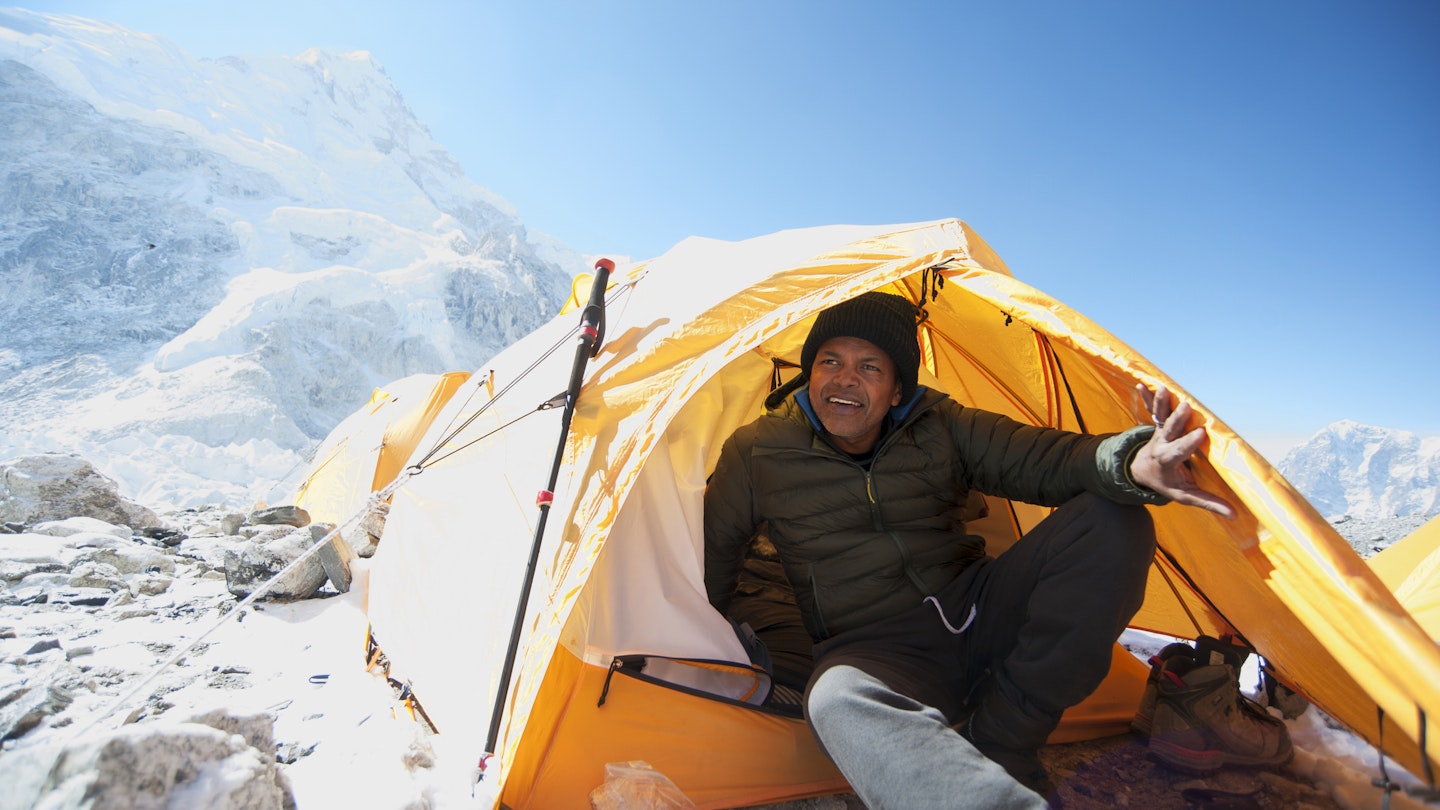
From permits to teahouses, here's everything you need to know about trekking to Everest Base Camp © Mint Images / Getty Images
Top of many people's travel bucket lists, the trek to Everest Base Camp is often the first thing people think about when they start dreaming of a trip to Nepal .
The walk takes trekkers past Sherpa villages and Tibetan-style monasteries, right up into the heart of the high Himalaya, into a breathtaking world (literally) of iconic glaciers, lakes and the tallest peaks on earth. It's probably the world's most famous trek.
But what is it actually like to trek to Base Camp? Is it something within your capabilities or budget? What should you bring? And, most importantly, can you get a proper coffee en route?
I just returned from trekking to Everest Base Camp for Lonely Planet's Nepal guide . Here’s what I think you need to know.
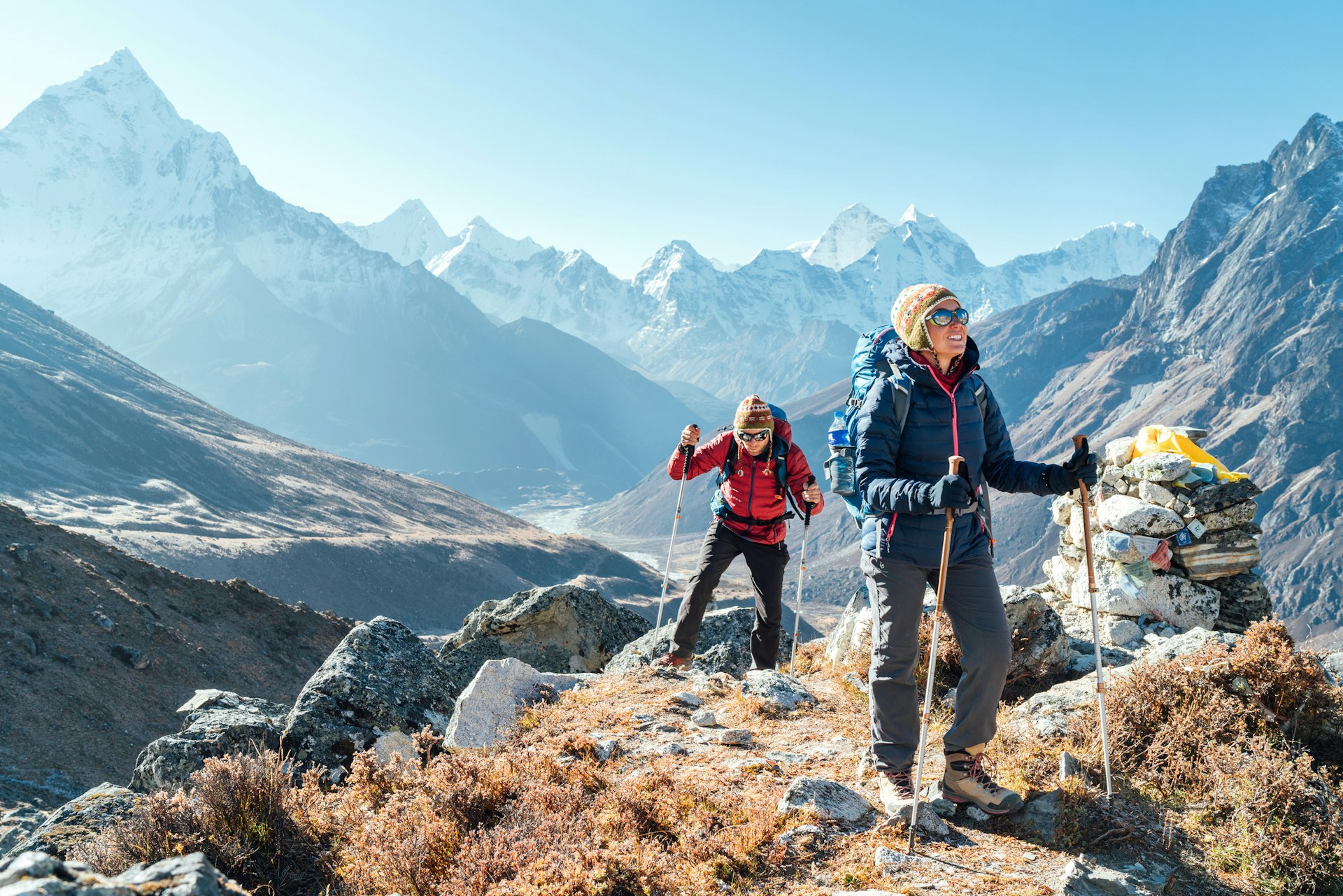
What's so great about the Everest Base Camp (EBC) trek anyway?
Firstly, the mountain scenery surrounding the world's highest peak is truly spectacular. The sublime views of Ama Dablam, Pumori, Nuptse and Thamserku peaks are unbeatable and constantly change as you progress along the walk. The Sherpa villages and monasteries are fascinating places to visit and the lodges (called teahouses) are the best in the world.
The knowledge that you are walking in the expedition footsteps of Hillary, Tenzing, Messner and others is a thrill. Anyone who has read Into Thin Air will be moved by the memorial stupas of Rob Hall, Scott Fischer and others who have lost their lives on the mountain. And then there's the fact that you will have reached the base of the world's highest peak; whether you call it Chomolongma (Tibetan), Sagarmatha (Nepali) or Everest, it’s a rush all the same.
And what’s not so great about the Everest Base Camp trek?
Well, if you force us to play devil's advocate… EBC is one of the busiest trails in Nepal. In the high season months of October and November you'll be walking with thousands of other trekkers, competing with them to get a bed, a lunch order or an airplane seat. There will be lines at checkpoints and even at moments on the trail itself. In bad weather you might be stranded at Lukla airport with hundreds of other trekkers, all trying to get on the first flight out. It's not quite the Zen-like wilderness experience you may have been imagining.
Bear in mind also that even after a solid week of walking, your view of Everest will be partial at best (for infinitely more dramatic Everest views visit the northern Everest Base Camp in Tibet ). If you trek outside of May's expedition weather window you won’t actually find much to see at Base Camp beyond a boulder hastily spray-painted with "Everest Base Camp".
If this has put you off, don’t worry; there are dozens of other fantastic treks in Nepal .
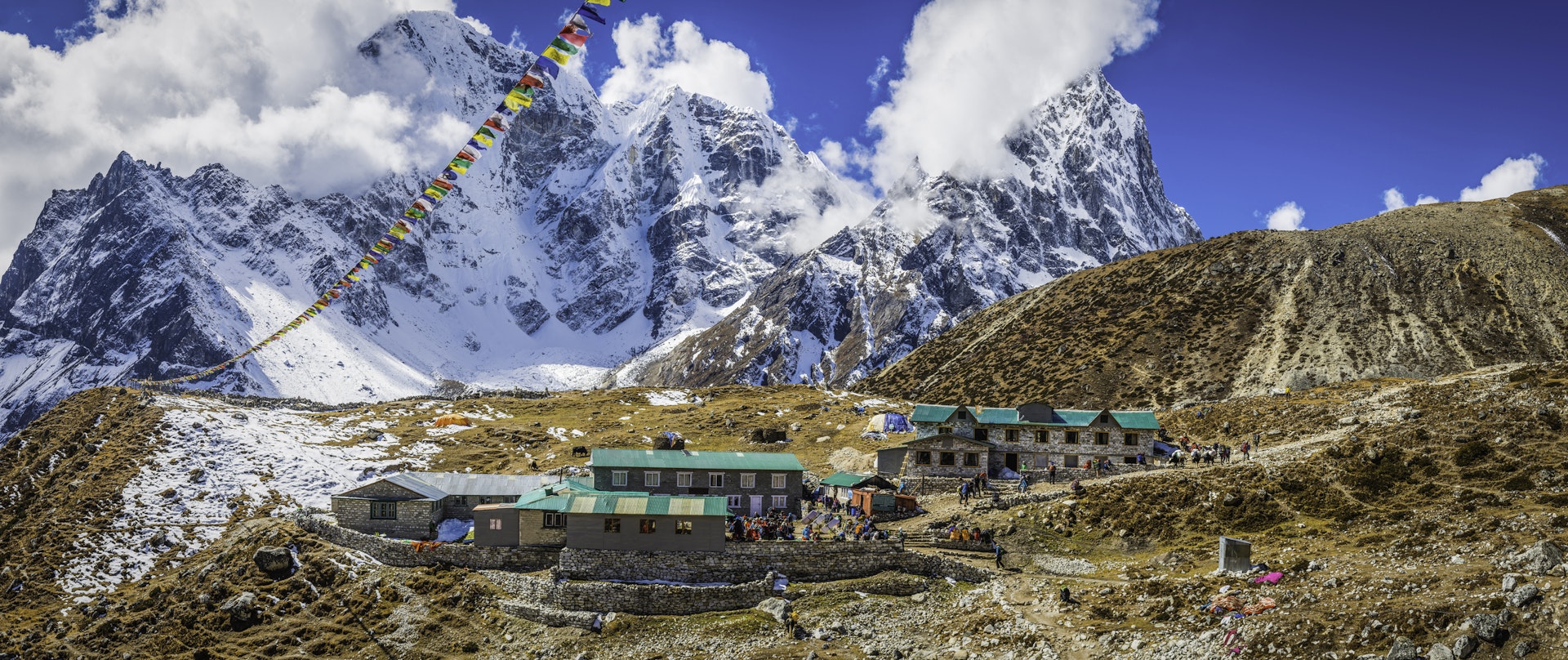
How long does it take to trek to Everest Base Camp?
The walk from the airport at Lukla to Everest Base Camp and back takes a minimum of 15 days. Several of the days are surprisingly short, but this is because you have to figure in time to acclimatize to the high altitudes.
If you can, it's definitely worth adding on a couple of extra days to this basic itinerary. Some of the most dramatic (and least visited) views are from detours off the main trail. I always add two days to visit Thame, two days to visit Chhukung and, if possible, three or four days to visit the lakes of the Gokyo Valley – probably the most beautiful scenery in the Everest region.
Be sure to also budget an extra day or two as a transport buffer. Weather-related flight delays in and out of Lukla are not uncommon (I had to wait six days for a flight to Lukla on my recent trip) so you need some buffer time if heading back for an international flight home.
How challenging is the trek to EBC?
In terms of physical effort, the EBC trek itself is not especially tough. There are only a couple of steep climbs, lasting about an hour each, and most days involve less than four hours of walking.
The thing that makes the EBC trek tough is the altitude. Base Camp is at 5600m (18,373ft) and you will need to spend one or two nights above 5000m (16,404ft). Above 4000m (13,123ft) you are going to feel increasingly lethargic and out of breath as the amount of oxygen in the air decreases. Combine this with the cold, the discomfort of being at altitude and the compounded tiredness from walking for two weeks straight, and you can see why the whole trek experience is definitely a physical challenge.
While you don't need to be an athlete to walk to EBC it is still a good idea to start a fitness regime in the weeks leading up to your trek. You'll enjoy the walk so much more if you are in decent shape.
When is the best time to trek to Everest Base Camp?
October and November bring the best weather and the clearest skies but these are also the most popular months. The second most popular season is April to early May, when spring blooms and expedition traffic bring extra interest to the trail. To avoid the crowds but still enjoy clear views, pack an extra thermal layer and come in December or March.
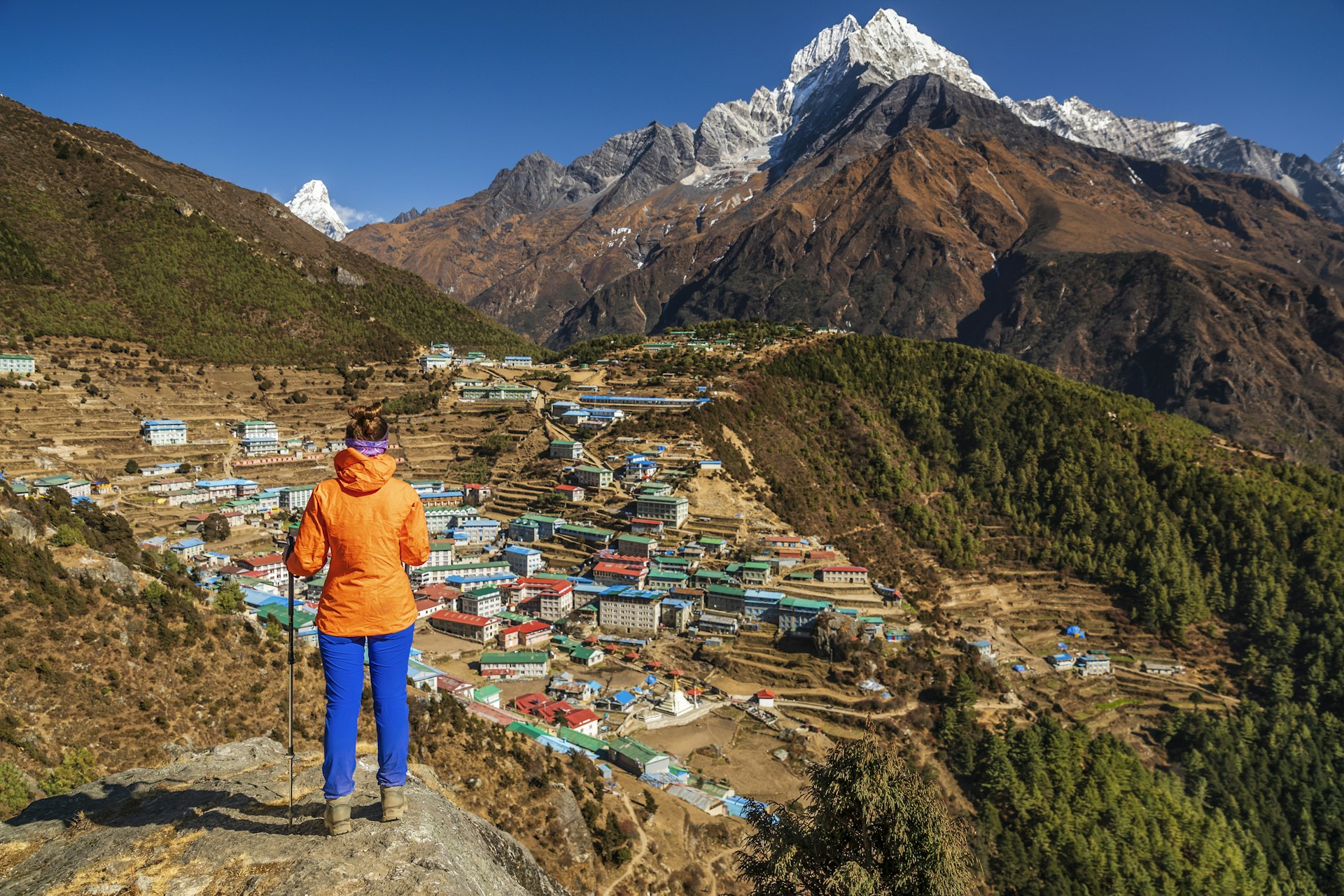
What can I do to avoid altitude sickness?
The majority of people who fail to reach Base Camp do so because they failed to acclimatize properly to the altitude. It's essential not to gain altitude too quickly by following the recommended overnight stops and limiting your daily altitude gain to a maximum of 400m (1312ft) when above 3000m (9843ft).
Be sure to add in acclimatization days at both Namche Bazaar and Dingboche, during which it's a good idea to hike to higher altitudes during the day, returning to sleep lower at night.
What are the teahouses like?
At lower altitudes the Everest lodges are the most comfortable in Nepal. Private rooms are the norm, many of which have private bathrooms. Showers are available at most places, though the hot water supply can be patchy. All have cozy dining rooms with tables arranged around a central dung-fueled stove. There are even a few luxury lodges along the trail.
In budget lodges, or when you get above Dingboche, things get simpler, with rooms offering little more than a collection of plywood walls, a solar light and a foam mattress. Toilets are a mixture of seats and squatters; sometimes outdoors, always freezing. A blanket is normally supplied but be sure to bring a four-season sleeping bag rated to well below 0°C (32°F).
What's the food like?
Menus in teahouses range from pasta and pizza to spring rolls, fried potatoes and soups, though the most popular meal is a daal bhaat , a set Nepali meal of rice, lentil soup and fried vegetables, normally served with a papad and pickle, and with a refill included. It's the most filling and environmentally sustainable meal you can order.
In villages such as Namche Bazaar and Dingboche you will also find bakery-cafes serving espresso and slices of delicious apple pie, plus shops selling everything from Snickers bars to bottles of beer. This is one trek where you might actually gain weight!
Can I get wi-fi or phone coverage?
Most lodges offer wi-fi, either free of charge or for a few dollars per day (at higher elevations). Above Namche Bazaar you will likely have to buy a scratch card, giving you unlimited data for twelve hours (AirCell) or a specific amount of data over a month (Everestlink). Depending on your network provider you'll likely get data and a phone signal at lower elevations, and possibly even at Everest Base Camp, but not at other high altitudes. So yes, in theory, you can Skype all your friends from Base Camp!
What should I bring?
Warm clothes are a must, and you should pack thermal underwear, a down jacket and fleece hat. Comfortable hiking boots and good, padded socks are also essential. Sun block, a sun hat with a brim and good sunglasses are important against the strong high-altitude light.
Morale-boosting snacks like chocolate and salami are always helpful, as is a book and smartphone with mapping software like Maps.me. Bring water purification of some sort. If you forget something, don’t worry, you can buy almost anything you might want in Namche Bazaar these days (from ice axes to cans of Pringles), though at prices higher than in Kathmandu .
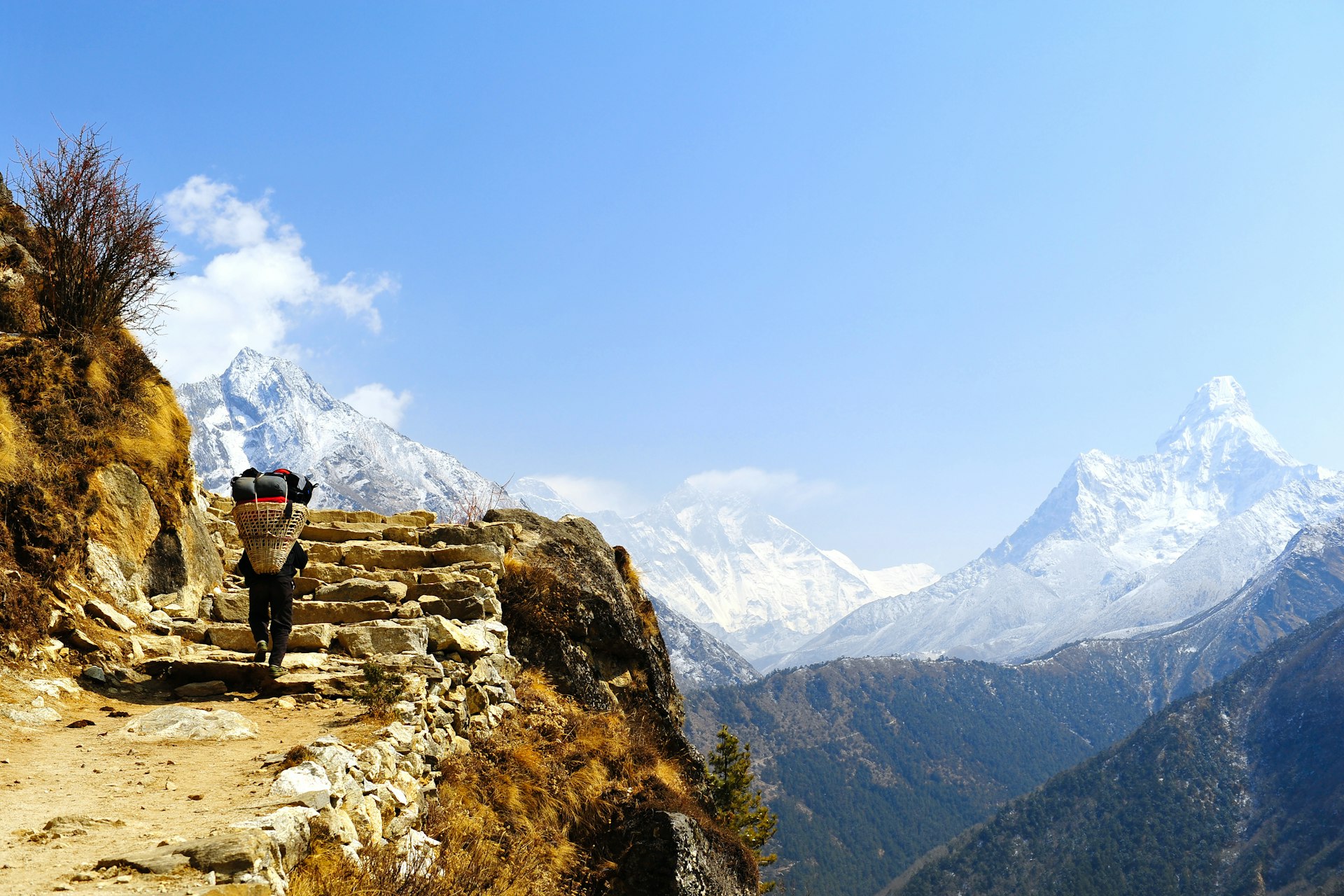
Do I need a porter and guide?
In terms of finding your way you don't need a guide if you are an experienced walker, as the route is clearly marked and well-trod. A guide can be useful for smoothing your way at teahouses, making sure you get your food on time and helping you pay your bill. It's important not to trek alone, so solo trekkers should find a companion or take a guide or porter.
A porter will carry a bag of around 15kg, freeing you up to pack a few extra chocolate bars and enjoy the walk with little more than a day pack. Not having the strain of carrying a full pack is worth its weight in gold for anyone over the age of 50. Trust me.
How much does the Everest Base Camp trek cost?
For a room in a lodge and three meals a day, figure on US$20–25 per person per day, a bit more if you want a room with a private bathroom and the occasional slice of apple pie. Add on another US$5 every time you want a shower. Figure on an additional US$20 per day for a porter, and US$25–30 for a guide, and budget 10–15% of that fee for an end-of-trip tip.
You'll pay a bit more to have a Kathmandu-based trekking company arrange your entire trek, and a lot more for the convenience and backup of an international trekking tour.
Do I need any permits?
You will need to buy an Everest region permit (US$20) at Lukla, as well as a Sagarmatha National Park entry ticket (US$30) at Monjo. Currently that's all you need.
How can I trek more sustainably?
With 60,000 trekkers and guides headed to the Everest region, it’s important to minimize your impact on the region. Firstly, don't buy bottled water on the trek, as the bottles are nonrecyclable and are a huge problem throughout the region. Bring a system of water purification, like a Lifestraw or Sawyer filter, a Steripen or chemical purification.
Secondly, carry all your trash out (especially batteries), and sign up for the Carry Me Back program, whereby you carry a 1kg bag of trash from Namche Bazaar to Lukla, for it to be recycled in Kathmandu.
Finally, be polite to the Sherpas and porters you meet en route, as well as your fellow trekkers. Walk clockwise around stupas and be respectful at monasteries and shrines.
How do I get to Lukla to start the trek?
Flights run multiple times daily between Kathmandu and Lukla, taking around 30 minutes. During high season however you may have to drive five hours from Kathmandu to Ramechhap airport to catch your Lukla flight there.
It's also possible to fly or drive to Phaplu and walk two days to Lukla from there, or walk from Shivalaya to Lukla in seven days as an excellent pre-trek warm-up.
This article was first published Jan 14, 2013 and updated Jun 20, 2023.
Explore related stories
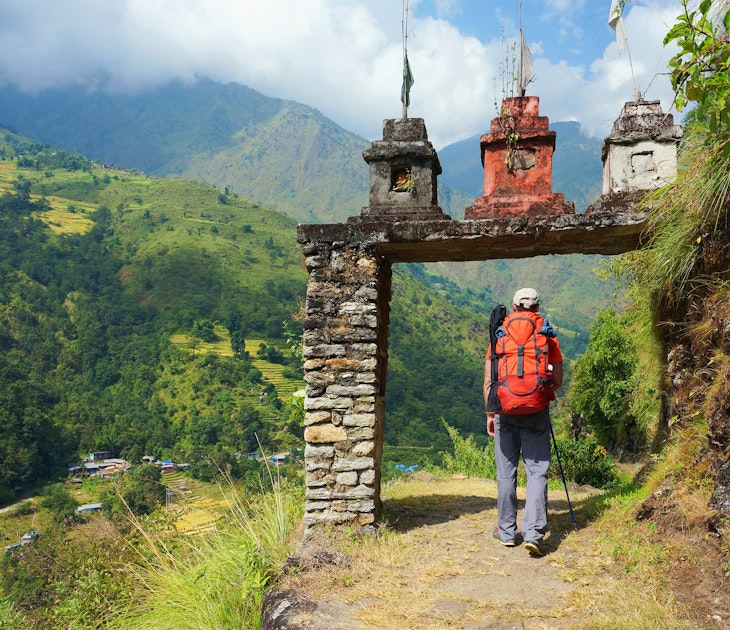
Mar 14, 2023 • 4 min read
To reduce accidents and promote jobs, Nepalese authorities recently announced a ban on solo trekking in national parks and conservation areas.

Jul 13, 2022 • 8 min read

Jan 31, 2022 • 6 min read

Sep 14, 2021 • 11 min read

Jan 28, 2021 • 5 min read
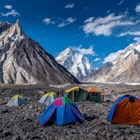
Jan 12, 2021 • 7 min read
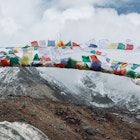
Dec 10, 2020 • 6 min read
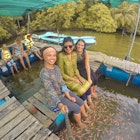
Jan 7, 2020 • 6 min read
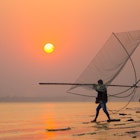
Oct 10, 2019 • 9 min read
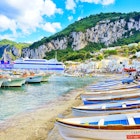
Jun 27, 2019 • 5 min read

Everest Base Camp Trek: The Ultimate Guide
Jackson Groves
Posted on Last updated: August 10, 2023
Categories NEPAL , HIKING
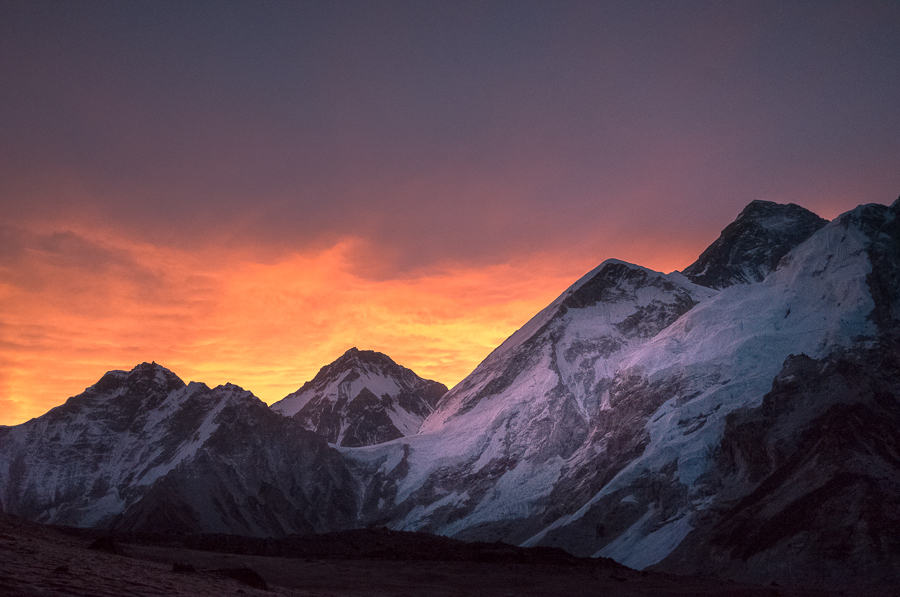
Mt. Everest is the highest mountain in the world and trekking to the base camp is no easy feat either. It’s a journey through some of the most spectacular mountain views but also through a number of beautiful villages along the way. The Everest Base Camp Trek takes anywhere from 9 to 15 days depending on your route and itinerary but also how well you acclimatize.
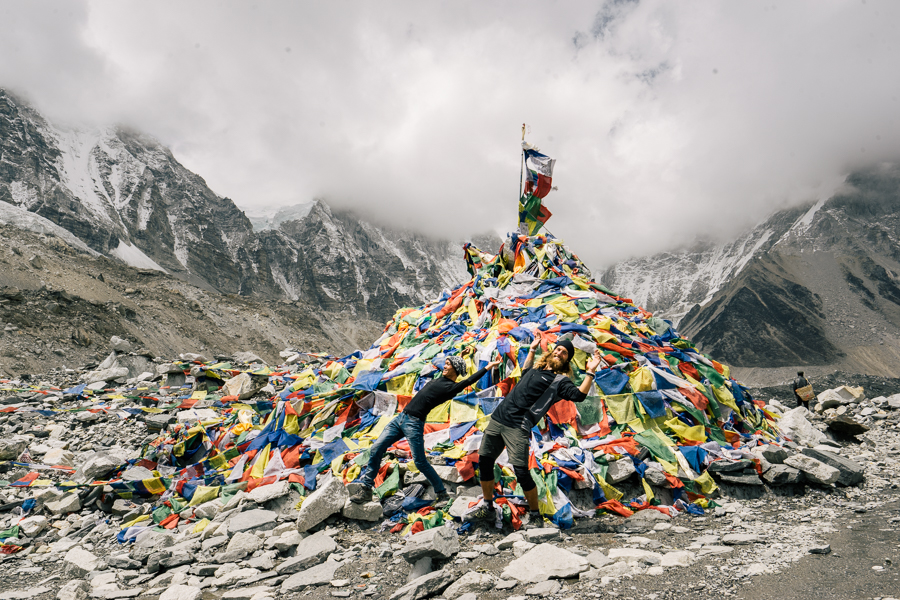
In this article, I will cover everything you need to know about the logistics of the Everest Base Camp (EBC) trek but I will also share with you my experience on each day of the trek. A short journal entry with a vlog from my experiences from each day will give you an idea of what to expect and you can see how the journey went for me. After sharing my experience, I will then include all of the information you need to know in this complete guide about trekking to Everest Base Camp.
BEST TREKKING COMPANY IN NEPAL
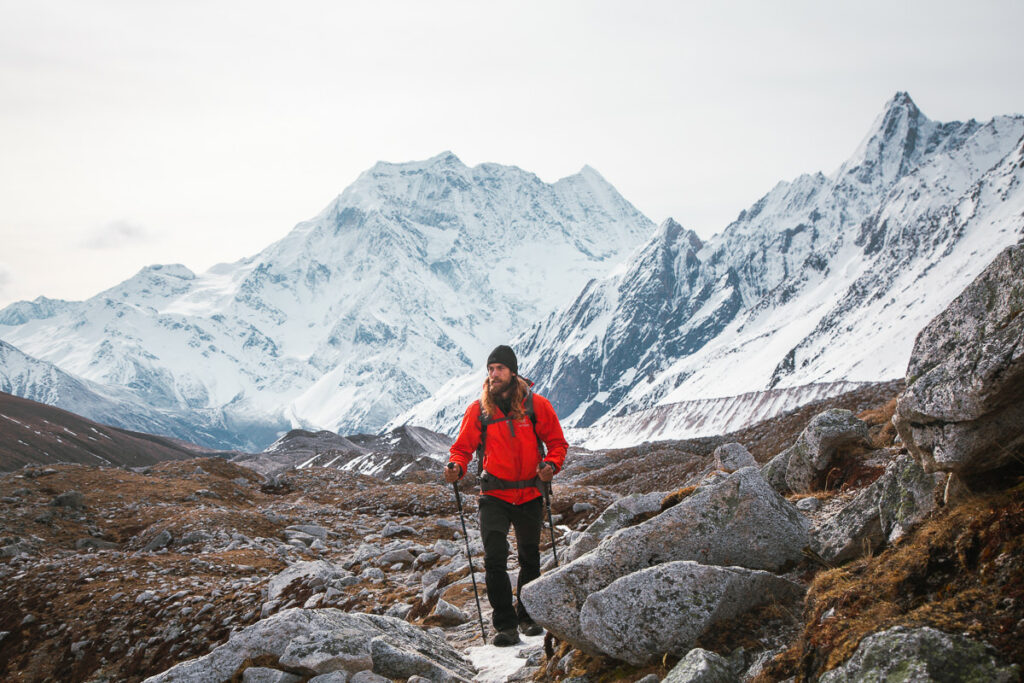
Interested in trekking in Nepal or doing the Everest Base Camp Trek? I recommend booking your trek with Himalayan Masters , which is the company I use for all of my treks in Nepal. Use my code JACKSON5 when you book to receive a 5% DISCOUNT .
Table of Contents
EVEREST BASE CAMP TREK DETAILS
- Distance : 120 km round-trip from Lukla to Base Camp and back to Lukla (You will fly to Lukla from Kathmandu)
- Days required : 12 -14 days
- Total Incline : (Undulation) – 6015 m
- Total Decline :(Undulation) – 5821 m
- The highest point on the trek : 5640 m/18 500 ft, this is actually at Kala Patthar, which you will hike to in the morning after reaching Everest Base Camp. This is where you get the best views of Mount Everest.
- Difficulty : It’s hard for an average hiker but the altitude is definitely more difficult to manage than the distance with several rest days and acclimatization days.
- Permits : Your tour operator will take care of these but in case you do the trek independently it’s good to know that you will pay a Local Government fee and Sagarmatha National Park permit, which totaled together cost about $40-$50
- Cost per day : This will depend on your tour price and whether you do the trek with a group, a porter, a guide, or independently. Somewhere between USD $40 (without flights) $60 per person per day with all meals, transport, and guides included.
- Guide : It isn’t required but highly recommended. You can do the Everest Base Camp Trek in a few different ways such as by yourself with no guide, with an experienced guide or in a group with a guide.
- Accommodation : Guest Houses, also known as Tea Houses along the way where you will sleep in a comfortable bed and have access to showers (extra charge) and restaurant facilities. Very comfortable accommodation and great after a long day of hiking.
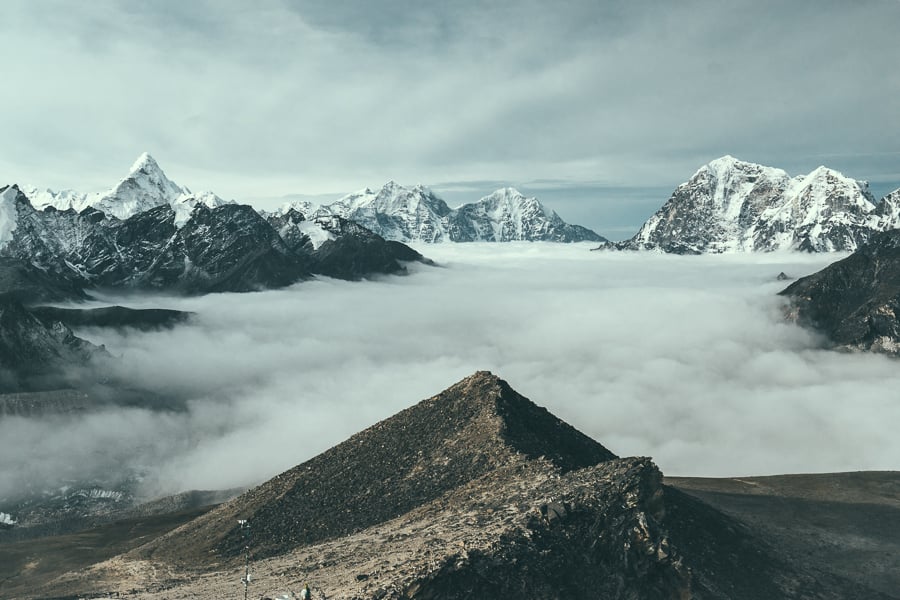
TRY THE 3 BEST TREKS IN NEPAL

Manaslu Circuit : My personal favorite 2-week trek through Tibetan villages and stunning scenery. Less crowded and more authentic.
Annapurna Circuit : The most beautiful & scenic 2-week trek in Nepal although can be crowded at times.
Everest Base Camp Trek : The most iconic 2-week route reaching the famous (EBC) Everest Base Camp at 5,300m.
BOOKING A GUIDE FOR THE EVEREST BASE CAMP TREK
The Everest Base Camp Trek doesn’t require a guide but it’s great to have a guide managing the logistics such as directions, tea-houses, distances, medical issues, and the overall organization. I’d say 90% of trekkers go with a guide. I highly recommend booking with Himalayan Masters which is one of the top trekking companies when it comes to the Everest Base Camp Trek. I’ve trekked many different routes in Nepal with them and I’m a big fan of their attention to detail.
The trek costs around $1500 USD with Himalayan Masters as of 2022 and includes all transfers, accommodation, meals, drinks, permits, and even the hotel stay before and after the trek at a high-quality hotel. I honestly had a great time on this trek and I can wholeheartedly recommend Himalayan Masters.
You can use my discount code ‘ JACKSON5 ‘ for 5% off the total price of your trek with Himalayan Masters which is a pretty handy saving.
Email: [email protected]
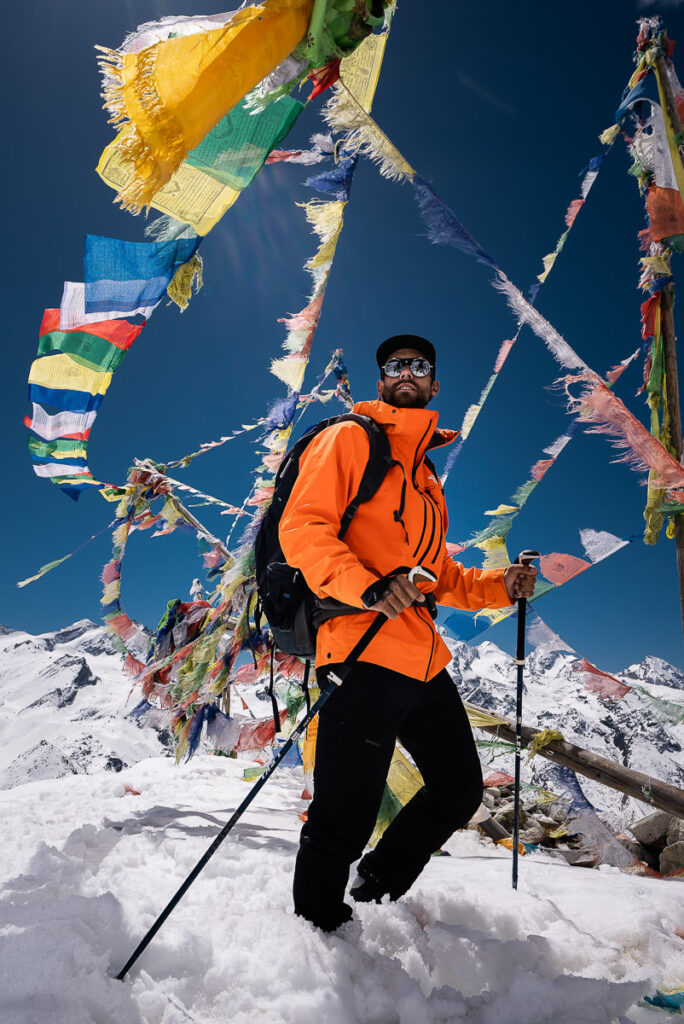
TOP 3 PLACES TO STAY IN KATHMANDU

- Ultimate Luxury: The Dwarika’s Hotel – Luxury, Spa-service, Pool
- Best Value : Aloft Kathmandu Thamel – Swimming Pool, Gym & Great Restuarant
- Budget Choice: Hotel Jampa is easily the top cheap hotel in Kathmandu
MY EXPERIENCE ON THE EVEREST BASE CAMP TREK
I’d like to share with you my experience and photos from my two weeks of trekking to Everest Base Camp. I hope you enjoy recounting the journey as much as I did.

Day One, Two & Three: Kathmandu to Lukla to Phak Ding to Namche
Day one began with an incredible flight from Kathmandu to Lukla. Unfortunately for me, I had come down with food poisoning the night before the trek so it was a rough start for me but I decided to battle on. The flight gives you incredible views of the Himalayas before you touch down at Lukla Airport, one of the most famous and scariest airports in the world. The landing strip is on a downwards slope and gives passengers a heart-in-mouth moment on take-off and landing.
After landing, we had a quick coffee and look around Lukla before making the short and relatively flat trek through the villages and forest to reach Phak Ding. Day one is a short trek but you have made your way up pretty high even just by landing at Lukla Airport so it is not a bad idea to take the first day easy, given that your biggest battle on this trek will be the altitude, not the distance or speed.
Day Two for me was actually a day of recovery in Phak Ding where I spent the entire day sick in the guesthouse. There is usually one day scheduled on your itinerary for sickness or rest day so I had used mine early!
Day three was a tough day as I was still recovering but we made the climb up to Namche, which is a winding climb through the forest and out above the tree line. Namche Bazaar is located at an altitude of 3450m inside the Sagarmatha national park, a UNESCO world heritage site and it is actually known as the last frontier for trekkers and climbers before the trek to Everest Base Camp starts to get serious.
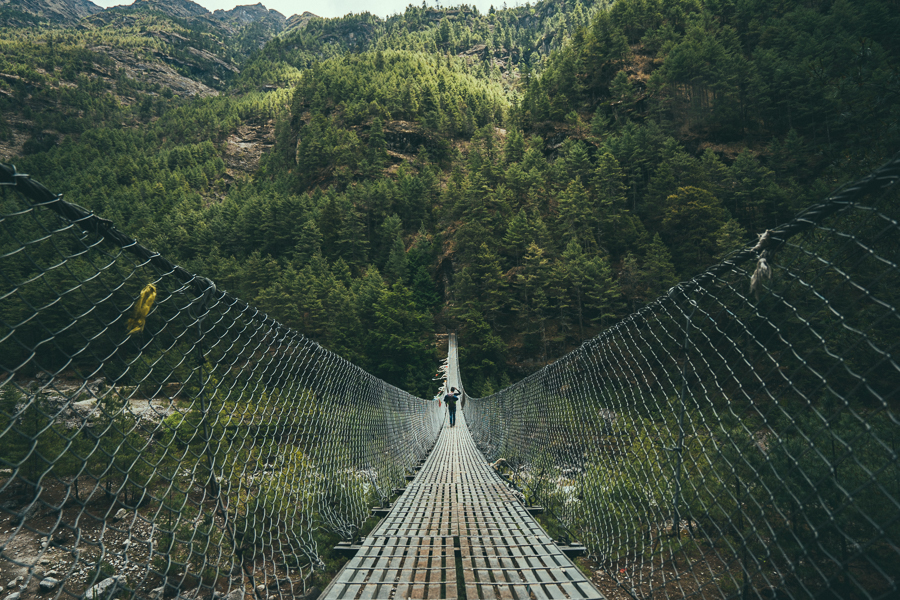
Day Four & Five: Namche to Tengboche to Dingboche
Day four is a big day of climbing. Namche Bazaar is 3,440 meters and Tengboche is 3,860 meters but the constant undulation on the trail means you will climb almost 900 meters of incline throughout the day.
The day begins by following the valley wall as you get some great views of the Everest mountain range out in front. The path then heads down into the valley floor as you lose a lot of elevation. However, you will then cross over the river and gain all the elevation back as you approach Tengboche where you will stay for the night.
Expect to have views of the mighty mountain Ama Dablam as well as Lhotse, Nupste, and even the peak of Mount Everest. Interestingly this will be one of the best views you have of Mount Everest until you reach Kala Patthar in a few days’ time.
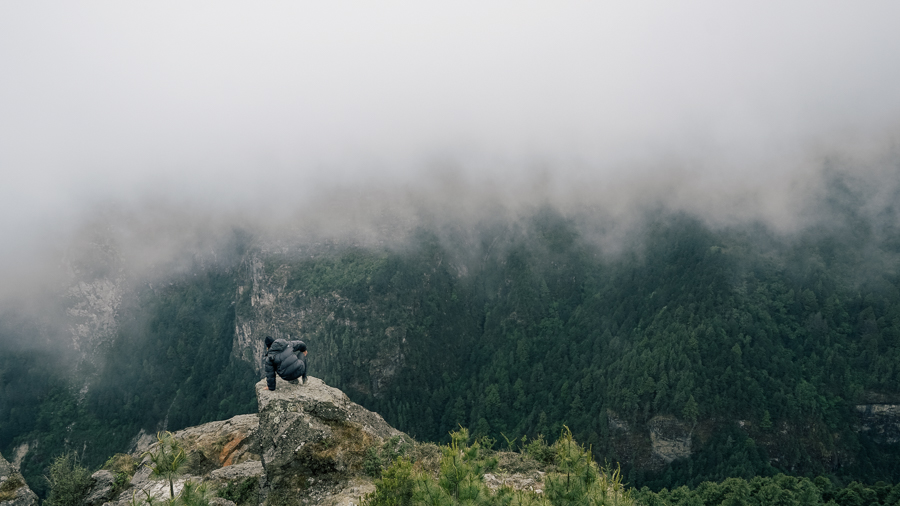
On day five of the Everest Base Camp trek, you say goodbye to the village of Tengboche and head towards Dingboche. It is a stunninng day as you voyage through the valley as the glacier river flows down below while snow-capped peaks loom in the distance. Along the trek, you will stop for tea in the village of Pangboche with lots of views of Ama Dablam mountain .
The elevation gain on day five is 700 meters and the entire journey will take about 5-6 hours at a moderate pace. Dingboche is 4,400 meters above sea level so it’s common to start to have a couple of symptoms of altitude sickness at this stage of the trek.
When you leave Tengboche, you begin a descent into the beautiful forest and can enjoy the shade as you pass through the village of Deboche. After you pass through Deboche, the trail gains some elevation and you will cross a suspension bridge, which guides you to the left side of the valley. Ama Dablam is still in view as you navigate the steep sections of the incline.
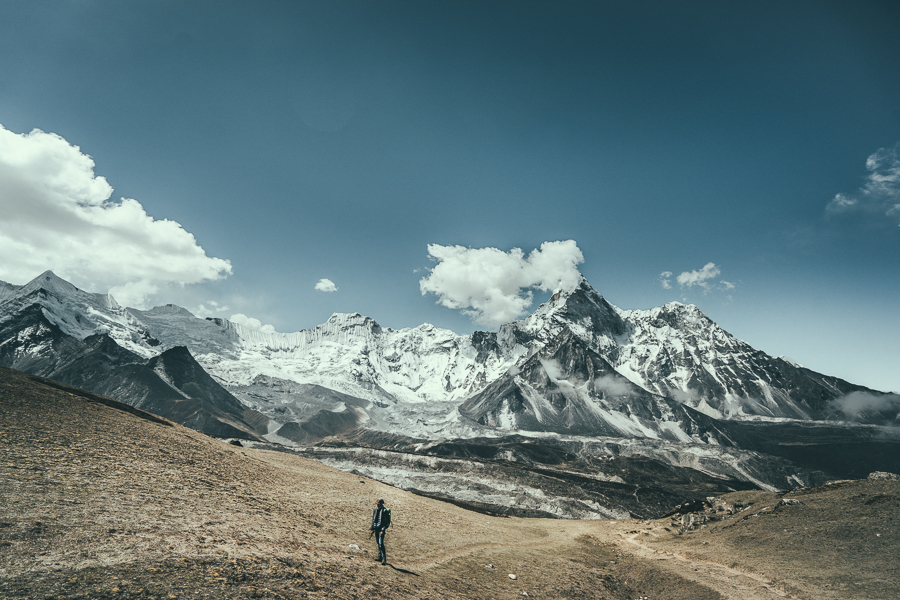
Day Six & Seven: Chuukhung Ri Acclimitization and Dingboche to Lobuche
Day six was an acclimatization day up to Chukhung Ri viewpoint, which was actually one of my favorite days. Because we would stay a second night in Dingboche, we left our bags in the tea house and did the climb up and down Chukhung Ri to help our bodies adjust to the altitude. The idea is to hike high and sleep low, which helps the body adapt.
Chukhung Ri is actually at 5500 meters, which is more than 1000 meters above Dingboche. This is a steep climb and you don’t need to go all the way to the summit. However, with spectacular views, isolation from other hikers, and a good chance to help your body adapt to the altitude, it’s a great day excursion with incredible scenery.
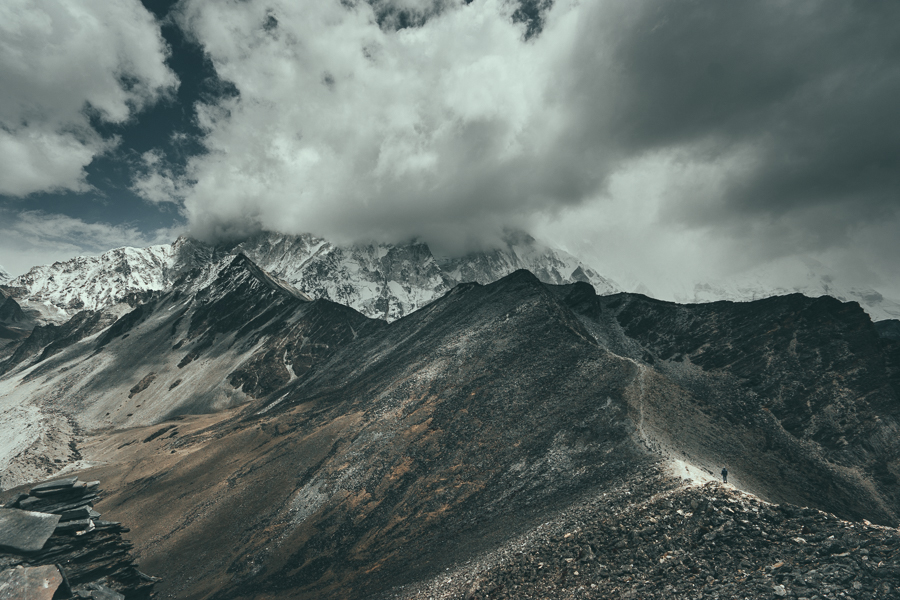
On day seven of the Everest Base Camp trek, we hiked from Dingboche to Lobuche, which is actually the second-highest village on the entire trail. Today is also the first time we will see the Khumba Glacier, which is one of the highlights of the trip.
The total elevation change for day seven is 500 meters in altitude but you will climb 600m in total for the day taking into account a few downhill sections on the trail. It’s a shorter day taking just four hours to reach Lobuche from Dingboche.
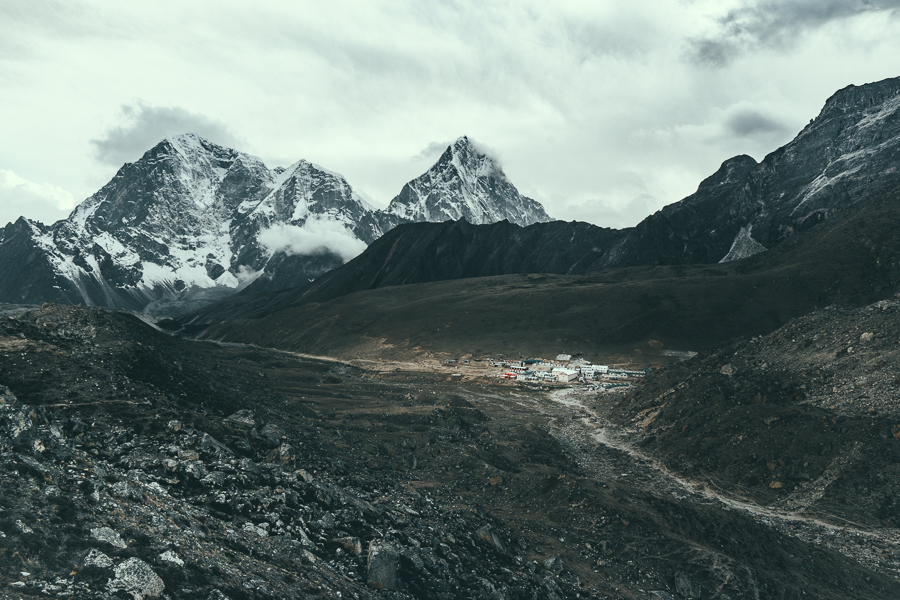
Day Eight: Lobuche to Gorak Shep to Everest Base Camp
On day eight of the Everest Base Camp trek, it is finally time to reach Everest Base Camp. From Lobuche your first trek to Gorak Shep, which is the highest village you sleep at throughout the trek.
Gorak Shep is a small village, and it’s the closest to Everest Base Camp is also the closest village to Everest Base Camp. Basically, you will trek to Gorak Shep, have an early lunch, and drop off your bag before doing the round-trip trek to explore Everest Base Camp. Then you will return to Gorak Shep where you will stay the night before heading to the nearby Kala Patthar in the morning.
The journey from Lobuche to Gorak Shep is along a rocky path, which slowly gains elevation as you walk next to the Khumbu Glacier. From Gorak Shep to Base camp, you will reach an altitude of 5,364m, which won’t be the highest on the trek as you will go higher the next morning at Kala Patthar.
When you leave Gorak Shep you walk next to the Khumbu Glacier with the Everest Mountain Range looming behind. The glacier is covered in dust and rocks due to the sediments, which have been falling from the surrounding peaks over the last years.
The trail continues alongside the glacier until you reach Everest Base Camp. It’s interesting because you actually can’t see Mount Everest from the base camp, which surprised me but the surrounding peaks are still very impressive and dramatic. Depending on if you come during the climbing season or off-season will alter how the base camp looks. I visited in the low season so there were no tents set up and it was pretty barren.
The trail continues past some Sherpa prayer flags as the rocky terrain leads you towards the famous Everest Base Camp rock, which is covered in hundreds of prayer flags. We’ve made it!
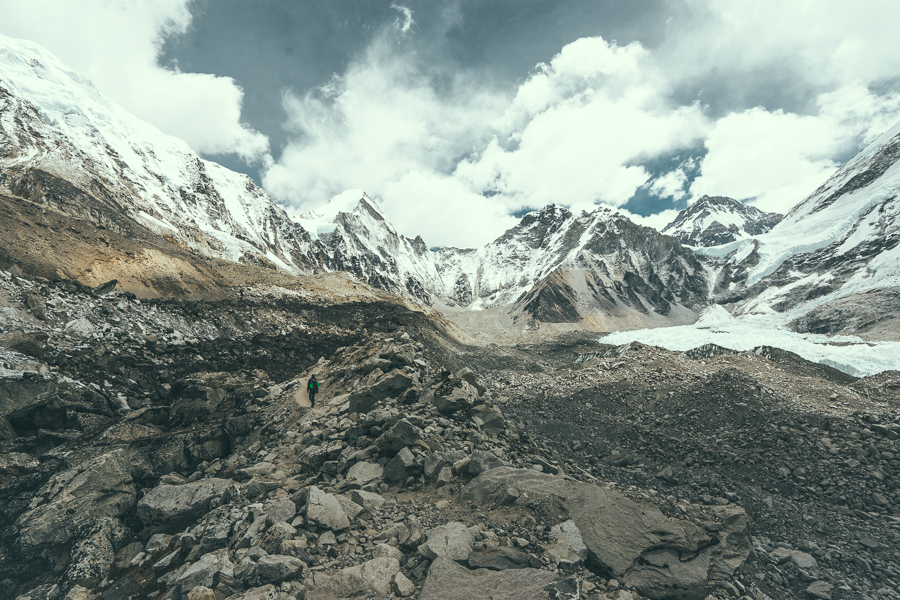
Day Nine: Kala Patthar
The highlight of the Everest Base Camp trek was the climb up to Kalapathar (also spelled out as Kala Patthar). It’s a 5,540-meter peak, which looms over the small village of Gorak Shep where you have just spent the night. It’s worth the freezing wake-up call in the morning as it is one of the best spots in Sagarmatha National Park to take in the views of Mount Everest.
It’s only a 3-kilometer round-trip trek from Gorak Shep with 300 meters of incline but at such high altitude, it can be quite difficult. I suggest starting 1.5-2 hours before sunrise so you are at the summit when the morning glow begins. After enjoying the sunrise with epic views of the cloud-filled valley and Mount Everest, we began the trek back down to Lukla.
It would take us another two days to reach Lukla, which is less than normal but going down is much easier.

Day Ten & Eleven: Heading back down
Heading back down is now at the pace of your choosing. We were keen to get back to Kathmandu so we took just two days to head back down the mountain. With altitude sickness no longer an issue, you can really make some good time.
If you are ahead of schedule you can keep going to the next village as there are no pre-made bookings. Heading down is a great feeling as you have accomplished reaching the base camp and you can now just breathe in the mountain air and enjoy the descent.
EVEREST BASE CAMP TREK: THE ULTIMATE GUIDE
In this section of the blog post, I will share with you the logistics and everything you need to know about trekking to Everest Base Camp.
HOW TO TREK TO EVEREST BASE CAMP
You have a few different options depending on your experience and requirements:
- Book a package through an agency to join a tour group
- Do the trek independently (not with an agency) but still hire a guide and/or porter
- Do the Everest Base Camp Trek entirely independently
If you are alone and don’t want to do the trek independently then it is a great idea to join a group. There are lots of free time and chill moments at the teahouses to play cards and chat with your group.
Doing it entirely independently means you are in charge of all the logistics and it can be quite stressful if you aren’t experienced at managing all flights, maps, costs, negotiations, food, language barriers, first-aid and more.
BOOKING AN EVEREST BASE CAMP TREK IN ADVANCE
These are the most popular routes and are organized by the top tour companies who have a global reputation.
The Everest Base Camp Trek doesn’t require a guide but it’s great to have a guide managing the logistics such as directions, tea-houses, distances, medical issues, and the overall organization. I’d say 90% of trekkers go with a guide.
I highly recommend booking with Himalayan Masters which is one of the top trekking companies when it comes to the Everest Base Camp Trek. I’ve trekked many different routes in Nepal with them and I’m a big fan of their attention to detail.
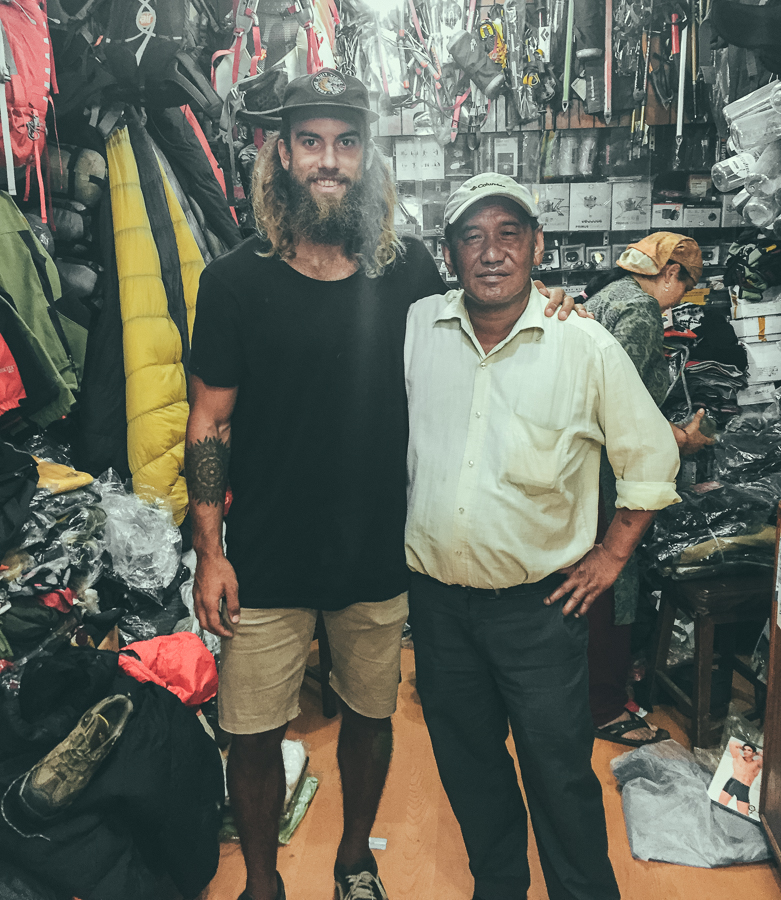
CHOOSING THE RIGHT TOUR AND A GUIDE
Trekking to Everest Base Camp can be done without a guide although I suggest hiring one. Here are 3 reasons why:
- Directions : The route isn’t incredibly hard to follow but there are many twists and turns I would have missed had I not had a guide. The route is available on many maps and map applications but it isn’t a clear trail throughout and some previous experience following a trail in a foreign country would be necessary.
- A guide is relatively cheap to hire : Included in your trekking package will be a qualified guide. However, in your package is also meals, accommodation, flights, etc. The guide him or herself will only cost $10-15 per day.
- When things go wrong : My guide helped me through food poisoning, altitude sickness and was as much a nurse as a guide. I rarely get sick at normal heights but altitude sickness is uncontrollable. I am pretty fit and it still smashed me hard. You can go it alone and be fine but it’s comforting to have a guide there when you come into trouble, especially with altitude sickness. My guide had seen it all before so his calm made me feel better about feeling sick for four days straight.
If you think you will get a guide like the majority of people on the Everest Base Camp, you have a lot of options and things to consider. Pictured below is my guide, Lapsang, who was a legend and someone who became a good friend. When I left Nepal he waited at the bus stop for two hours with me and gave me a Nepali scarf as a gift.
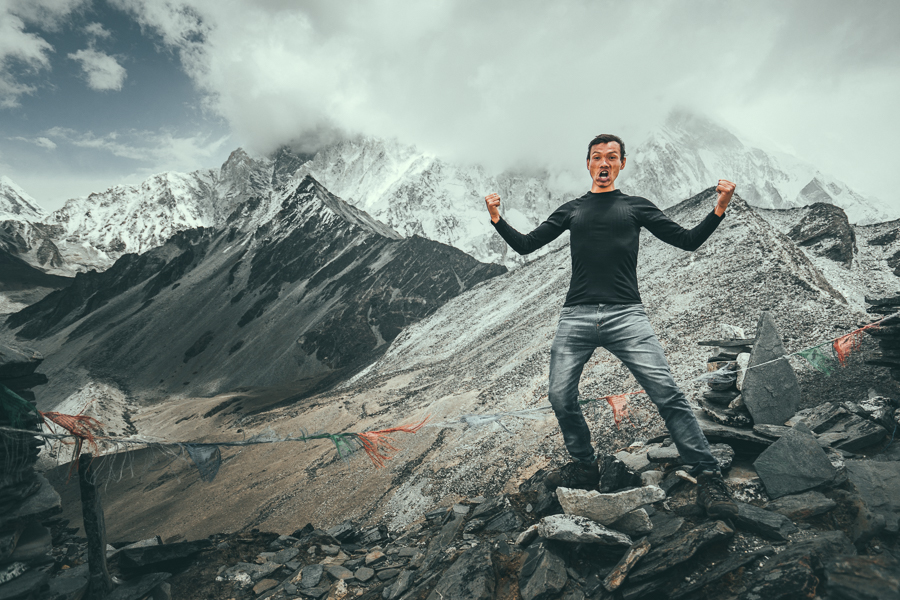
I suggest going with a small group of friends. We saw a few big groups and it looked like a Contiki tour compared to the experience I had with just myself and my guide. Only get a porter if you really need it. You should be able to carry your bag for 4-5 hours of trekking each day.
My guide, Lapsang Tamang, had done the trek multiple times as a porter and now many times a guide. He said he has lost count but somewhere over 20 times, he has been hiking the Everest Base Camp Trek. The best thing to do is to contact my guide and arrange to meet him first in Kathmandu so you can chat and decide if you want to go ahead. You will be together for 12 days after all!
You can directly contact my guide Lapsang by emailing him here: [email protected]
Lapsang is an awesome guy and I had too many chai tea hangouts with him before and after the trip. Lapsang and I became friends during the trip and afterward, we went bungee jumping, cooked Dal Bhat at his apartment, and visited Swayambunath Temple.
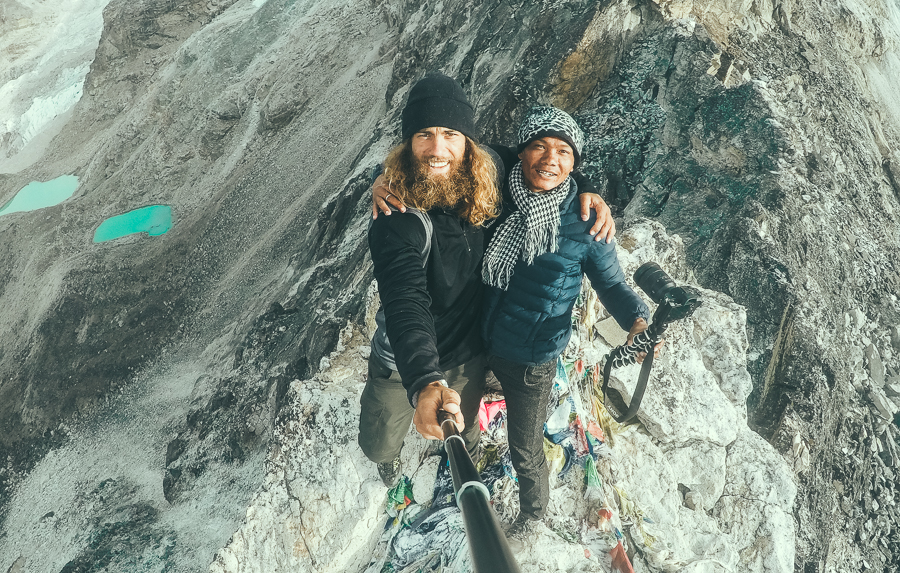
EVEREST BASE CAMP PACKING LIST
I had no winter clothes or even trekking shoes before getting to Kathmandu and bought it all for under $200 brand new (Likely fake North Face). But just as a guide you can get all the gear new for under $200. Bargaining/second hand etc. may help you get it a bit cheaper but this was one time I didn’t want to be so tight with money then freeze my ass off later on top of a mountain.
Keep in mind you won’t be doing any washing. Clothes that dry quickly and are lightweight are key. I showered once… Here is a list of what I took:
- 2 pairs of pants that rip off into shorts ($15 each in Kathmandu) (Super Safari style but actually handy in this situation.)
- 2 long sleeve quick-dry material shirts ($10 each in Kathmandu)
- 5 Pairs of Thermal North Face socks ($2-3 per pair in Kathmandu)
- 1 Fleece pants and sweater. ($25 for top and bottom in Kathmandu)
- 1 Thermal Lycra long sleeve and pants ($20 in Kathmandu)
- 5-6 pairs of quick-dry underwear
- 1 huge waterproof down jacket (Rented for $1 a day in Kathmandu)
- Beanie ($1 in Kathmandu)
- Neck Buff ($2 in Kathmandu)
- Gloves ($5 in Kathmandu)
- Water Purification pills and 1L bottle
- Camera gear and electronics (Not necessary but up to you. Obviously I carried a lot)
All of this should fit into a backpack no bigger than 50L and be less than 15kg. I used my 60L backpacking bag because I didn’t want to buy a new bag for a two-week trek. It worked out fine and weighed about 13kg including all of my lenses, chargers, and power banks.
What are my favorite pieces of trekking gear?
There are six pieces of gear that I simply never forget when I go trekking. These are five items that I using right now and this list gets updated every year! Here are my trekking essentials.
- Arcteryx BETA AR Rain Jacket : This is my go-to rain jacket. It’s super light, folds down into a tiny ball, and protects brilliantly in a storm. This one never leaves my backpack.
- Salomon X Ultra 3 Mid GTX Hiking Boots : For the best ankle support, waterproofing, and durable exterior I’m a fan of tough but light hiking boots like these Salomons for my adventures.
- Black Diamond Head Torch : I can’t tell you how many times, I’ve arrived back from a hike unexpectedly late. I always keep this lightweight but strong headtorch in my bag for the unexpected.
- Darn Tough Socks : These are the most comfortable hiking socks I’ve ever worn and last for years. They also have a lifetime warranty and you just send them in with a hole and they replace it no questions asked.
- Osprey Atmos AG 65L Backpack : I’ve never had a more comfortable 65L pack than this one. I got it in the Navy Blue and have trekked with it through many a mountain.
- Bl ack Diamond Trekking Poles : They might feel weird at first, but on a long trek with incline and decline you’ll begin to love these.
- Grayl GeoPress Water Filter Bottle : I’ve used this for three years. It filters your water with one press and you can drink directly from it. Never buy a plastic water bottle again!
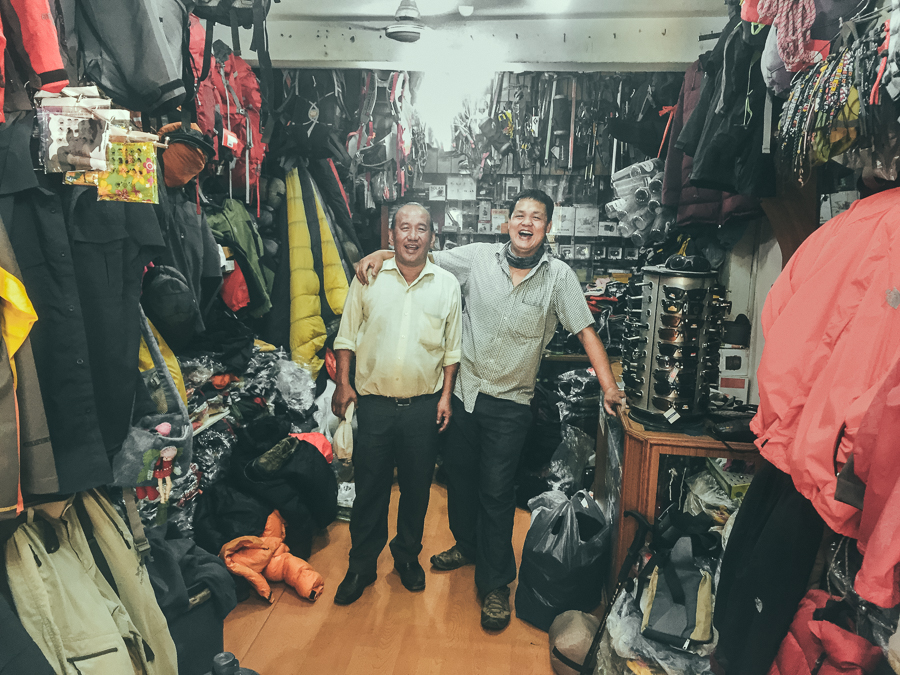
EVEREST BASE CAMP TREK COST
I paid $900 USD for my package all the way back in 2016 but you can expect to pay anywhere from $1400 to $2500 these days.
What’s included in the package for trekking to Everest Base Camp:
- Taxi from Thamel to Kathmandu Airport
- Flights from Kathmandu Airport to Lukla Airport
- Flights from Lukla Airport to Kathmandu Airport (Regular price $320 round trip)
- Breakfast, lunch, and dinner from the guesthouses you are staying at. I could pick anything on the menu, which had western options or Nepali options. You can eat pancakes, pizza, and burgers or you can go for the 24-hr Nepali Power Dal Bhat. I could also choose any hot drink with each meal.
- Your guide throughout the trip.
What’s not included:
- Water. You can buy bottled water like me if you are playing it safe. It is $1 per bottle at a lower elevation and $3 per bottle at the highest elevation. Or lots of people use purification tablets and they seemed to be fine.
- Electricity
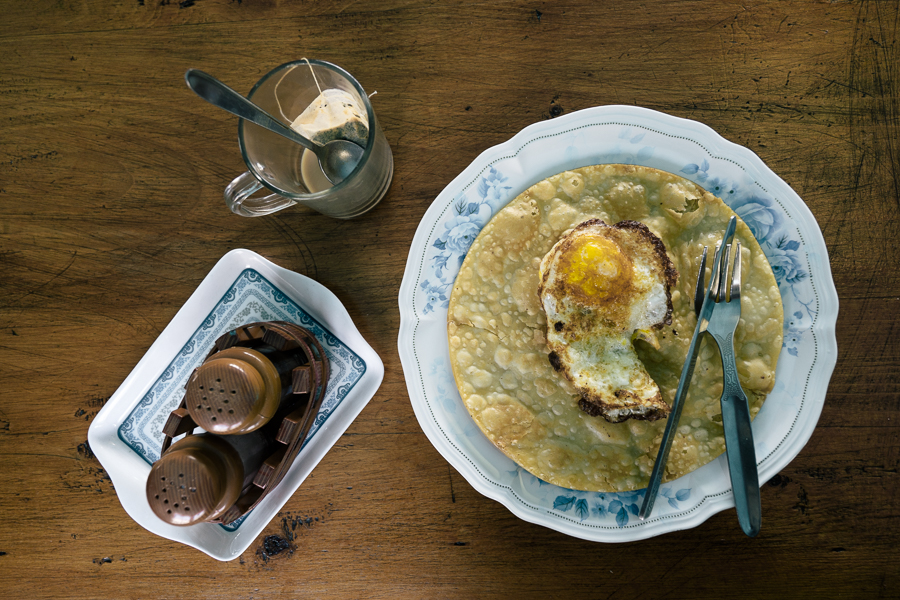
EVEREST BASE CAMP TREK: WIFI/ELECTRICITY AVAILABILITY.
Wifi: Costs anywhere from $3 to $10 to use wifi at the guesthouses. Buy a Ncell Sim before you go. Ncell works at 50% of the guesthouses. Electricity: You will have to pay anywhere from $2 at low elevation to $8 at high elevation to charge your power banks, cameras, and phones. The key is to get a fat power bank. Pay to charge that then charge everything from your power bank. My power bank lets me charge my phone and four camera batteries before it would be done.
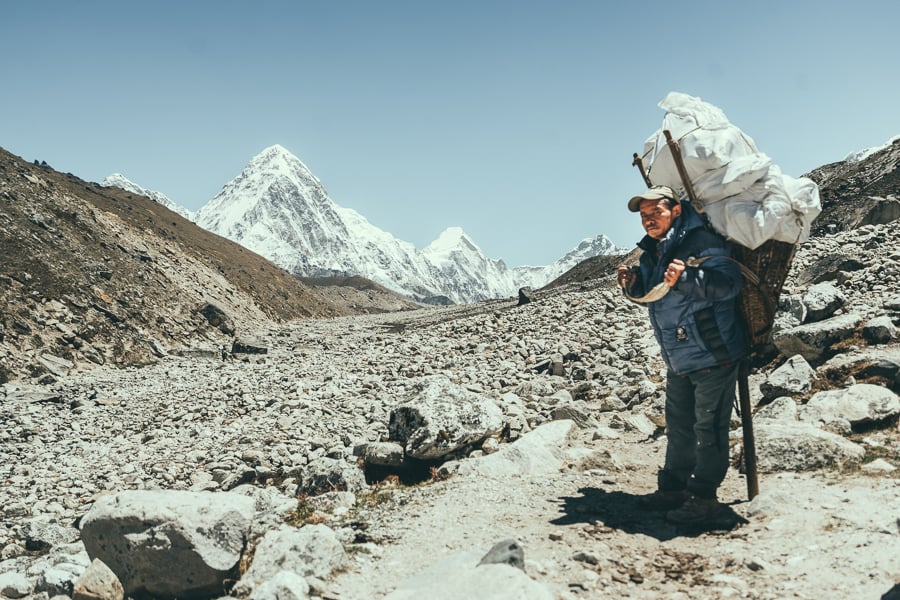
EVEREST BASE CAMP TREK: BEST TIME OF YEAR
This is an interesting question. Do you want snow, reliable weather or to get away from crazy crowds?
February to May – Peak season, clear bright days, very busy trails, lots of people attempting Everest ascent June to August – Monsoon season, no crowds and empty guesthouses September to October – Most stable and clear weather, trails are quite busy November to January – Coldest period, can reach -25, some routes closed
I trekked in the first week of June and was lucky to escape the rain. I didn’t get wet once. Normally it rained in the afternoon or at night if at all but we trekked in the morning and usually only heard the rain as we slept. The trails were open and some days we didn’t even see anyone.
My guide showed me a photo of Namche on a busy morning and I couldn’t believe it. The path looked like the start of a marathon. After seeing that I was so glad to have gone in the off-season.

EVEREST BASE CAMP TREK TEMPERATURE
During June when I trekked it was sunny in the days and I actually wore shorts every day. However as I mentioned above about when the best time to be trekking to Everest Base Camp is, it can get very cold at high elevations during November to January (-20 to-30)
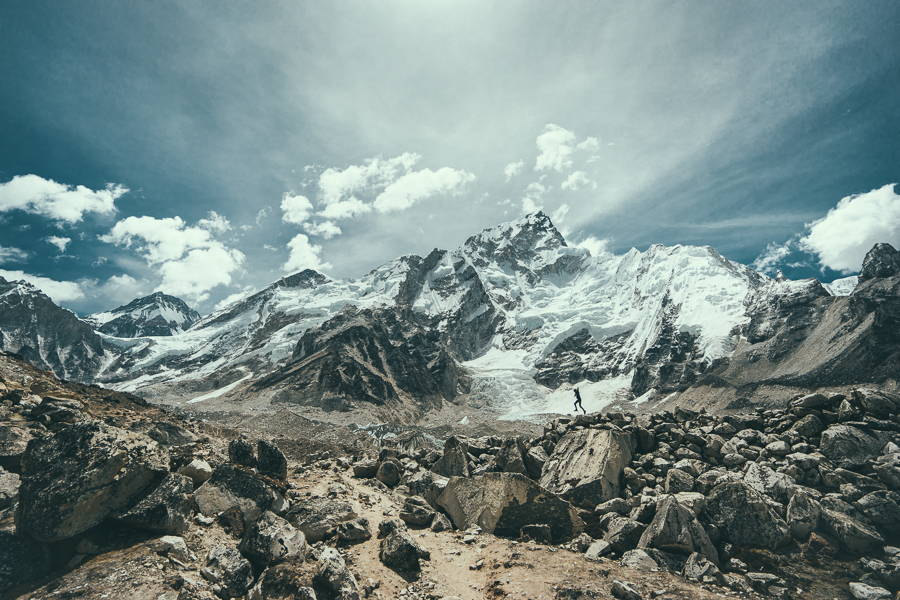
EVEREST BASE CAMP TREK DIFFICULTY
Trekking to Everest Base Camp takes some serious effort. But do you need to be in great shape to complete the journey? The simple answer is NO.
You can go at a slow pace, your own pace, and still make it to Everest Base Camp. In fact, going slow will help you to acclimatize better. I am all about speed but this is not a race. Some days we only trekked for just over three hours but we gained 500m in altitude so we rested for a day and then went again in the morning.
Having said all of that you should be able to walk 10-15 km in a day. Be able to walk up intense inclines for at least an hour. Be able to carry a bag while doing all of this unless you plan to hire a porter.
It’s hard to measure if you are ready. It isn’t like a marathon or anything else you have ever done most probably. I didn’t train at all and was fine. I’m in pretty good shape and played sport my whole life. There were people on the trail who were overweight and going incredibly slow but they were right there with us at base camp to celebrate the achievement.
EVEREST BASE CAMP ALTITUDE
The base camp is 17,600 ft or 5,380m. However, you will probably also trek to Kala Patthar, which looks over the base camp. Kala Patthara is 5,644m high.
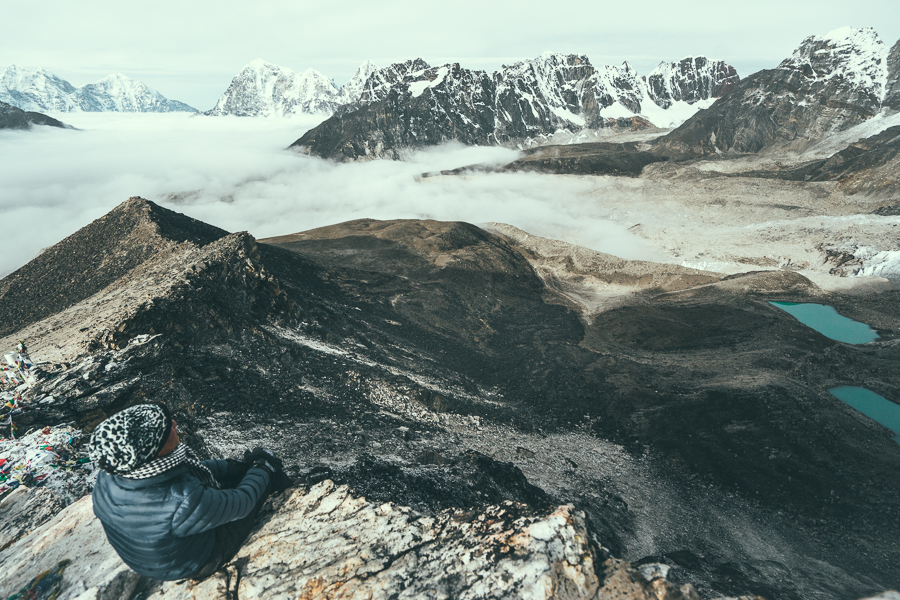
EVEREST BASE CAMP TREK DISTANCE
The distance from Lukla the first town to Everest Base Camp is 38.58 miles or 62 kilometers. Most people take 8-9 days trekking to Everest Base Camp and 3-4 days trekking back to Lukla. It took 8 days to trek to Base camp and two days to trek out.
EVEREST BASE CAMP ITINERARY
Your itinerary will vary depending on your speed and your guide. However, most people follow a somewhat similar trail and timeline. This was my timeline. Note that I spent one extra day in Phak Ding due to sickness. Most people spend that extra day in Namche.
- Day 1. Kathmandu flight to Lukla Lukla to Phak Ding (3-4 hrs)
- Day 2. Phak Ding rest day (sickness)
- Day 3. Phak Ding to Namche (5 hrs)
- Day 4. Namche to Tenboche (4 hrs)
- Day 5. Tenboche to Dinboche (3 hrs)
- Day 6. Dinboche to Chukhung Ri (2.5 hrs) Chukhung Ri back to Dinboche (1.5 hrs) (Acclimatization day)
- Day 7. Dinboche to Lobuche (3 hrs)
- Day 8. Lobuche to Gorak Shep (2 hrs) Gorak Shep to Everest Base Camp (1.5 hrs) Everest Base Camp to Gorak Shep (1.5 hrs)
- Day 9. Gorak Shep to Kala Patthara (2 hrs) Kala Patthara to Gorak Shep (1 hr) Gorak Shep to Tenboche (7hrs)
- Day 10. Tenboche to Lukla (8 hrs)
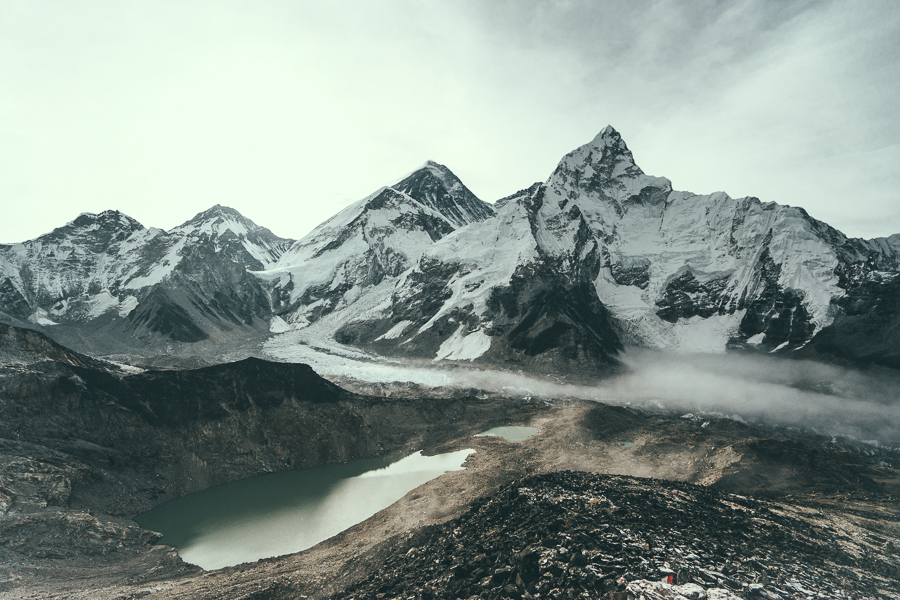
I hope you enjoyed my guide to the Everest Base Camp Trek and you have a great adventure.
HAVE YOU READ MY OTHER NEPAL BLOGS?
I’ve been lucky enough to have many awesome adventures in Nepal, which you can check out below where I’ve listed some of my favorite blog poss from Nepal.
- The Most Iconic route: Everest Base Camp Trek
- The Most Scenic Route: Annapurna Circuit Trek
- My Favorite Trek in Nepal: Manaslu Circuit Trek
- An Easy Nepal Trek: Langtang Valley Trek
- A great beginner peak: Island Peak Climb (6,165m)
- My Favorite Climb in Nepal: Climbing Ama Dablam (6,812m)
- My first 8000er: Climbing Manaslu (8,163m)
- My toughest climb in Nepal: Climbing Makalu (8,463m)
- Where to stay: 16 Best Places to Stay in Kathmandu

Tuesday 31st of October 2023
Sunday 17th of September 2023
So much informative articles which helps people to trek Everest Base Camp Trek
Inge Winkler
Saturday 3rd of June 2023
Hello, thank you for posting all the great infos, this will be very helpful for us. Could you please update me if the requirement of a Professional Guide is in place now or is there a way around it. Thank you so much in advance. Happy Trails, Inge
Sunday 18th of June 2023
I believe you need a guide now to trek anything above 3000m
Monday 21st of November 2022
Thanks for sharing such an adventurous trip experience with us. I read your blog. It feels like I was personally enjoying this trip.
Friday 12th of August 2022
Hi Jackson,
This was a helpful and informative guide. Kudos!
I had a small suggestion: You could have a small sections box right in the beginning and link each sub-section directly to the relevant content below, for ease of navigation!
Find Your Tour

Main Navigation
Everest trekking.
- Everest Base Camp Trek With Heli Return
- Short Everest Base Camp Trek
- Everest Base Camp Trek
- Everest Cho-la Pass Trek
- Everest Three High Pass Trek
- Luxury Everest Base Camp Trek
- Gokyo Ri Trek
- Everest View Trek
Helicopter Tours
- Everest Short Trek with Helicopter Return
- Everest Base Camp Helicopter Tour
Peak Climbing
- Island Peak Climbing
- Mera Peak Climbing
- Lobuche Peak Climbing

Any Question? Email Us
Request to call (Puru)

Complete Guide to Everest Base Camp Trekking

Introduction:
The Everest Base Camp trek is a dream for adventure enthusiasts and nature lovers alike. This well-known trek offers an opportunity to see Mount Everest, the tallest mountain in the world, up close and personal while nestled in the gorgeous Himalayas. The Everest Base Camp journey is a once-in-a-lifetime experience thanks to its incredible beauty, Sherpa culture, and difficult yet rewarding terrain. This comprehensive guide from Hike to Everest will provide you with all the information you need to prepare for and start off on this amazing trek.
Table of Contents
Everest base camp trek overview:, here is an overview of the everest base camp trek:, trekking equipment:.
To have a safe and enjoyable trek, it's essential to pack the right equipment. Here's a list of trekking essentials for the
Everest Base Camp trek:
Trekking Boots: Sturdy and comfortable trekking boots with good ankle support. Clothing: Moisture-wicking base layers, insulated jackets, trekking pants, and waterproof outer layers. Backpack: A comfortable and spacious backpack to carry your essentials. Sleeping Bag: A warm and suitable sleeping bag for the trek. Trekking Poles: Helpful for stability and reducing strain on your knees. Headlamp: Essential for early morning or late-night treks. First Aid Kit: Including basic medications, bandages, and blister care.
Is a Guide Mandatory to Trek to Everest Base Camp?
While it is not mandatory to have a guide for the Everest Base Camp trek , it is highly recommended, especially for first-time trekkers. A knowledgeable guide will not only ensure your safety but also provide valuable insights into the local culture, geography, and history. They can assist with navigating challenging terrains and help you make the most of your trekking experience.
Where is Everest Base Camp?
Everest Base Camp is situated in the Khumbu region of Nepal, in the lap of the Himalayas. The base camp serves as the starting point for climbers attempting to summit Mount Everest, the world's highest peak.
How to Hike to Mount Everest Base Camp?
The journey to Everest Base Camp begins with a scenic flight from Kathmandu to Lukla, a small mountain town. Trekkers departing from Lukla follow the route that passes through charming Sherpa settlements, luscious rhododendron forests, and suspension bridges above rushing rivers. Trekkers acclimatize to the higher altitude as the track gradually ascends. Before arriving at Everest Base Camp, the trip passes through Namche Bazaar, Tengboche Monastery, Dingboche, and Gorak Shep.
How Much Money Do I Need for Everest Base Camp Trek?
The cost of the Everest Base Camp trek can vary based on various factors, such as the trekking package, the duration of the trek, and the level of comfort desired. On average, the trek can cost around USD 1000 to USD 2000 per person. This cost usually covers permits, guide and porter fees, accommodations, meals, and domestic flights.
Available Accommodation on the Everest Base Camp Trek:
During the Everest Base Camp trek, trekkers will find tea houses and lodges at regular intervals along the trail. These accommodations offer basic facilities, including a bed, blankets, and meals. Even though the facilities are basic, they give tired hikers a comfortable place to rest up.
Available Foods on the Everest Base Camp Trek:
Tea houses and lodges on the Everest Base Camp trek offer a variety of meals, ranging from traditional Nepali dishes to international cuisine. Dal Bhat, a staple Nepali meal, is a popular choice among trekkers for its hearty and energy-providing qualities. Additionally, you can find a selection of pasta, noodles, soups, and snacks to fuel your trekking journey.
Everest Base Camp Trek Permits:
To trek to everest base camp, you will need the following permits:.
Sagarmatha National Park Permit: This permit allows entry into the Sagarmatha National Park, home to the Everest region. Khumbu Pasang Lhamu Rural Municipality Permit: This permit is required to access the Khumbu region. TIMS (Trekkers' Information Management System) Card: The TIMS card records trekkers' information and ensures their safety during the trek.
Conclusion:
The Everest Base Camp trek is an adventure that attracts trekkers from around the globe. The trek to the base of the tallest mountain in the world is both a test of stamina and a celebration of nature's beauty. Trekkers are able to go on a life-changing trip among the Himalayan magnificence with proper planning and the correct leadership. Your dream of hiking to Everest Base Camp can now come true with the help of Hike to Everest. We are dedicated to making sure that your trip to Everest Base Camp is safe, unforgettable, and magnificent, from offering knowledgeable guides to creating personalized itineraries.
Recent From Blog

30th Nov, 2022

28th Dec, 2022

30th Dec, 2022

18th Jan, 2023

30th Jan, 2023

26th Feb, 2023

27th Feb, 2023

3rd Apr, 2023

4th Apr, 2023

7th Feb, 2024

8th Feb, 2024

9th Feb, 2024

4th Apr, 2024

ASSOCIATED WITH
Find & follow us on.
© 2011 - 2024 All rights reserved. Hike To Everest
Notice. This site uses cookies to optimize your user experience. By using this site, you are consenting to our use of these cookies. Check out our Privacy Policy and our Cookies Policy.
- +9779851276377
- 977 01 5348594
- [email protected]
- Follow us on:
- Unternehmen
Everest Base Camp Trek
Everest base camp, kala patthar and view of pumori, namche bazaar, du kannst auch, was man vor dem trip wissen sollte.
- „Sicherheit, Zufriedenheit und Erfolg“
- 100% personalisierte Reisen
- Finanzieller Schutz und keine versteckten Kosten
- Gesetzlich eingetragenes Trekkingunternehmen in Nepal
- Umwelt und Gesellschaft Responsive
- Willkommen bei Nepal Mountain Trekkers
- Wir sind versichert. Bist du es auch?
Reiseeinführung
Zweifelsohne zählt der Everest Base Camp Trek zu den beliebtesten Trekking-Abenteuern in der Everest-Region . Während des Treks zum Everest Base Camp (EBC) erwartet uns ein atemberaubender Blick auf den höchsten Gipfel des Himalaya, Mt. Everest sowie Lhotse, Makalu und Cho Oyu. Neben diesem einmaligen Panorama haben wir während der Wanderung auch Gelegenheit die Kultur und die Traditionen der lokalen Sherpa kennen zu lernen. Während wir buddhistische Klöster und Chörten besuchen und Fauna und Flora des Himalaya beobachten bewegen wir uns immer auf den Spuren des großen Sir Edmund Hillary und Tenzing Norgay Sherpa aus dem Jahr 1953. Klicken Sie hier , um die Videodokumentation dieser Wanderung anzusehen.
Everest Base Camp Trek: Kurzbeschreibung
Nach Ihrer Ankunft am Flughafen Kathmandu machen wir uns auf zur Besichtigungen des Weltkulturerbes in Kathmandu (optional). Danach treffen wir die notwendigen Vorbereitungen für den Trek um dann den einzigartigen Flug nach Lukla anzutreten. Von hier brechen wir auf nach Phakding. Entlang des Flusses Dudh Koshi folgen wir zunächst dem Weg, der über verschiedene Hängebrücken und durch dichte Wälder führt, um das Sherpa-Dorf Namche Bazar zu erreichen. Um das Risiko einer akuten Höhenkrankheit zu minimieren ist professionelles Vorgehen wichtig. Daher akklimatisieren wir uns in Namche Bazar, einem wichtigen Hotspot für Trekker und Abenteuerliebhaber. Dann geht es weiter in Richtung Tengboche, Dingboche und Lobuche. In Tengboche besuchen wir ein altes Kloster in dem wir Traditionen und Rituale dieses aus Tibet kommenden Volksstammes kennenlernen. Von Lobuche aus geht es durch Gorakshep am Khumbu-Gletscher weiter bis wir schließlich das Basislager des höchsten Berges der Welt erreichen. Auf unserem Rückweg haben wir vom Aussichtspunkt Kalapathar aus einen traumhaften Panoramablick auf Everest, Ama Dablam, Lhotse, Nuptse und andere benachbarte Gipfel. Danach folgen wir der gleichen Route zurück Lukla um den Heimflug nach Kathmandu anzutreten.
Everest Base Camp Trek: Anmerkungen
Der Everest Base Camp Trek kann von jedem gemacht werden, der über ein gewisses Maß an körperlicher Fitness verfügt. Darüber hinaus ist eine Leidenschaft für das Erwandern und Erkunden neuer Orte in dieser besonderen Region des Himalaya nötig. Die besten Jahreszeiten für EBC-Trekkings sind der Herbst von September bis November und der Frühling von März bis Mai. Machen Sie diese Wanderung mit uns teil und nehmen Sie einmalige Erinnerungen an die Everest-Region mit die Sie Ihr weiteres Leben begleiten werden. Füllen Sie einfach das Anfrage-Formular aus und teilen Sie uns Ihr Interesse mit. Oder kontaktieren Sie uns direkt indem Sie uns eine E-Mail senden um weitere Informationen zu diesem Trek zu erhalten.
Trekkinggelände Wie so oft in Nepal treffen wir auf dem Everest Base Camp Trek verschiedenste Vegetations- und Geländeformen an. Der erste Abschnitt der Wanderung führt durch üppige Hügel und grüne Täler. In den höheren Lagen gibt es jedoch steile Passagen und felsiges Gelände wenn man sich dem Base Camp oder exponierten Orten wie Kala Patthar und der Gokyo-Region nähert. Auch wenn die Route so gewählt ist dass sie nach der nötigen Akklimatisation kein Problem mehr darstellt, muss man sich jedoch immer gewahr sein, dass Trekking in dieser Höhe eine besondere Herausforderung darstellt. Leichte Kopfschmerzen und Atemnot können immer noch auftreten wenn Sie unterwegs sind. Vermutlich haben Sie keine konkreten Vorstellungen von den Strecken die zurückgelegt werden müssen aber Ihr Führer kennt die Entfernungen sehr wohl und wird das berücksichtigen und alles entsprechend regeln. Wenn Sie weitere Informationen benötigen, setzen Sie sich einfach mit uns in Verbindung.
Wetter (… und Schlechtwetterperioden) Die Regenzeit / Monsunzeit beginnt ab Mitte Juni und dauert bis September, allerdings kann es Anfang Oktober auch noch regnen. Im allgemeinen sind Frühlings- und Herbstsaison klar und trocken. Die Temperatur in den Höhenlagen wird durch lokale Einflüsse sowie die Höhe selbst bestimmt. In höheren Lagen kann sich das Wetter kurzfristig und schnell ändern. Von Oktober bis Mitte Dezember ist die beliebteste Jahreszeit für den Everest Base Camp Trek. Flüge von und nach der Bergstadt Lukla sind wegen der geografischen Lage des Ortes relativ ungewiss. In der Regel finden die meisten Flüge wegen der Witterung sehr früh am Morgen statt, doch aufgrund schlechter Wetterbedingungen (Nebel in Lukla) können sie verspäten oder ganz abgesagt werden. Trekkern wird daher empfohlen einige Tage für solche Verzögerungen während des Trekkings aufgrund der schlechten Wetterperioden einzuplanen.
Kosten Die Einzelheiten der inbegriffenen / nicht inbegriffenen Kosten sind in den jeweiligen Abschnitten aufgeführt. Kosten für Essen, Unterkunft und andere Aktivitäten die nicht in den Zeitraum des Treks (vorher oder nachher) fallen müssen Sie jeweils selbst tragen. Falls sich ein Flug verspätet und Trekker aufgrund einer solchen Verspätung entweder in Trekkinggebieten wie Lukla oder in einer Stadt wie Kathmandu festsitzen, sind die Kosten ebenfalls selbst zu tragen, da diese Zeit die vereinbarte Trekkingdauer überschreitet.
Anpassung der Reiseroute Wir werden uns während des Everest Base Camp Trekkings an die festgelegte Reiseroute halten. Trekker sollten jedoch die Flexibilität haben, die Route ihren Fähigkeiten entsprechend anzupassen. Wenn sie körperlich fit sind und das Trekking schneller absolvieren können, werden wir die Reiseroute entsprechend arrangieren. Die einzig wichtige Überlegung ist, dass die Anpassung der Reiseroute keine Schwierigkeiten und keine Gefahr für die Gesundheit der Wanderer darstellen sollte. Alles in allem bieten wir Flexibilität und Anpassung der Reiseroute für die Trekker.
Unterstützende Mitarbeiter während der Wanderung Während des Treks werden Sie sowohl von den erfahrenen Guides unserer Trekking-Agentur als auch von lokalen Hilfskräften unterstützt und begleitet. Auf unsere ausgesuchte und bestens ausgebildete Guides können Sie sich in jeder Situation verlassen. Sie sind vertraut mit allen Problemen und Schwierigkeiten die in solch ausgesetzter Landschaft auftreten können, sie sind in Erster-Hilfe ausgebildet und vertraut mit den Schritten zur Akklimatisierung, sie legen Wert auf gute Kommunikation, Freundlichkeit und sie haben Sinn für Humor. Die lokalen Kräfte (Führer, Träger) sprechen möglicherweise nicht fließend Englisch, sind jedoch freundlich, fleißig und zugänglich.Um eine reibungslose Tour zu gewährleisten, sorgen wir dafür dass das Zusammenspiel der Begleitmannschaft reibungslos klappt. Alle Kosten für die Mitarbeiter, ihre Versicherung, Verpflegung usw werden von uns übernommen.
Ausrüstung Jeder Trekker ist für seine Ausrüstung, die er für die Tour zum Everest-Basislager und in die umliegende Khumbu-Region benötigt, selbst verantwortlich. Die Einzelheiten zu Kleidung, Ausrüstung und anderer Ausrüstung werden nach Absprache mit den Wanderern festgelegt. Die Gewichtsbeschränkung für das mitzunehmende Gepäck beträgt 15 kg. Da Ihr Gepäck von Trägern getragen werden soll, können Sie die Wertsachen und alles Wichtige in einen Tagesrucksack verstauen. Mit Schal, warmer Mütze, Sonnenbrille mit UV-Schutz schützen Sie den Kopf, während Sie für Ihren Oberkörper unter anderem Thermowäsche, Pullover, Daunenweste und Gore-Tex-Jacken benötigen. Handschuhe nicht vergessen. Unterwäsche aus Baumwolle, Wandershorts und -hosen, Fleece- oder Wollhosen sowie Softshell-Hosen sind für Ihren Unterkörper nötig. Wichtig sind Socken sowie gute Wanderschuhe und dazu Gamaschen. Ferner gehören natürlich der Schlafsack, eine Tasche für die Wertsachen, erforderliche Medikamente Toilettenartikel und andere für Sie wichtige Gegenstände ebenfalls in den Rucksack.
Beste Jahreszeit für Trekking Oktober-November bis hinein in den Dezember ist die beste Zeit für Trekking in der Everest-Region. Zu dieser Zeit ist das Wetter meist schön, der Himmel klar und damit hat man den besten Blick auf die Berge und die herrliche Landschaft entlang der Strecke. Allerdings kann es gerade im Dezember und natürlich im Januar / Februar sehr kalt werden. Februar bis April ist die Trockenzeit in Nepal und damit die zweitbeste Zeit für Trekking. Am wenigsten beliebt bei Trekkern ist die Monsunzeit in Nepal von Juni bis September mit häufigem Regen, während Botaniker und andere Enthusiasten auf dem Weg zum Everest-Basislager nach üppiger oder seltener Vegetation Ausschau halten. Während die Monate Mai und Juni kann es sehr heiß werden und das Wandern mühselig machen.
Gesundheit und verwandte Themen Höhenkrankheit ist das größte gesundheitliche Problem während der Wanderung zum Everest Base Camp. Genügend Ruhezeiten zur Akklimatisation und Flüssigkeitszufuhr sind der Schlüssel um dieses medizinische Problem zu vermeiden. Ohne angemessenes Vorgehen zur Vorbeugung und Befolgung der Richtlinien zur Höhenkrankheit kann sich die Situation verschlimmern und das Leben der Betroffenen gefährden.Teilen Sie dem Guide sofort alle auftretenden Schwierigkeiten (Kopfschmerzen, Atemnot, Übelkeit, Schwindel u.ä.), denn Maßnahmen müssen sofort ergriffen werden. Falls Sie Medikamente zur Vorbeugung mitnehmen wollen, so empfehlen wir, dass Sie sich vom Hausarzt beraten lassen. Tragen Sie die persönliche Erste-Hilfe-Box, die Ihnen während der Wanderung zur Verfügung steht immer bei sich. Obwohl die Trekkingführer auch eine Erste-Hilfe Ausrüstung mit sich führen, ist Ihr Set eine zusätzliche Unterstützung für die Guides. Leitungswasser in den Trekkinggebieten ist ohne zusätzliche Behandlung nicht als Trinkwasser geeignet. Benutzen Sie Wasserreinigungstabletten oder kaufen Sie während der Wanderung Wasser in Flaschen. Gesunde und unbedenklich zum Verzehr geeignete Lebensmittel sind in Teehäusern erhältlich. Sie können jedoch auch Snacks mitnehmen wenn Sie möchten. Während des gesamten Trekkings können Sie uns nach den Kosten für Lebensmittel und Mahlzeiten fragen.
- Tag 1 Ankunft in Kathmandu (1,300m /4,264 ft):
- Tag 2 Kathmandu: Sightseeing und Trekking Vorbereitung:
- Tag 3 Kathmandu - Lukla - Phakding (2,652m/8,700ft): 40 Minuten Flug, 3 - 4 Stunden Trekking (nur Trekkingzeiten):
- Tag 4 Phakding - Namche Bazaar (3,440m/11,280 ft): 5 - 6 Stunden:
- Tag 5 Namche Basar: Ruhetag:
- Tag 6 Namche Bazzar nach Tengboche (3,870m/12,694ft): 5 - 6 Stunden:
- Tag 7 Tengboche nach Dingboche (4,360 m/14,300ft): 5 - 6 Stunden:
- Tag 8 Dingboche (4,360 m/14,300ft): Ruhetag:
- Tag 9 Dingboche-Lobuche (4,940 m/16,207 ft): 6 - 7 Uhr:
- Tag 10 Lobuche - Gorak Shep (5,170 m/16,961ft) - Everest Base Camp (5,364m/17,594ft) - Gorak Shep: 8 - 9 Std .:
- Tag 11 Gorak Shep - Kala Patthar (5,545m/18,192ft) - Pheriche (4,280 m/14,070 ft): 8 - 9 Stunden:
- Tag 12 Pheriche nach Khumjung (3,780m / 12,401 ft ) 6 - 7 Stunden:
- Tag 13 Khumjung nach Phakding (2,652m/8,700ft): 4 - 5 Stunden:
- Tag 14 Phakding nach Lukla (2,860 m/9,383 ft): 3-4 Stunden:
- Tag 15 Lukla - Kathmandu:
- Tag 16 Abreisetag:
Wegbeschreibung im Detail
Tag 1: Ankunft in Kathmandu (1,300m /4,264 ft)::
Herzlich willkommen im von der Natur gesegneten und kulturell reichen Himalaya-Land Nepal. Bei Ihrer Ankunft in Kathmandu werden Sie von einem Mitarbeiter der Nepal Mountain Trekkers an den Ankunftsterminals des internationalen Flughafens Tribhuwan abgeholt und zu Ihrem jeweiligen Hotel (Hotel Green Horizon) gebracht. Nach dem Einchecken im Hotel können Sie sich in der Freizeit in einem gemütlichen Zimmer entspannen oder bis zum Ende des Tages durch das touristische Zentrum Thamels schlendern.
Tag 2: Kathmandu: Sightseeing und Trekking Vorbereitung::
Sie beginnen Ihren ersten Morgen in Nepal mit dem Frühstück in Ihrem Hotel und besuchen das Büro der Nepal Mountain Trekkers in Thamel. Nachdem sie unser Team kennengelernt haben, das Reiseleiter, Trekkingleiter und denChef umfasst, machen wir uns auf den Weg zu den notwendigen Trekkingvorbereitungen. Kathmandu Durbar Square, Swayambhunath Stupa, Pashupatinath Temple und Boudhanath Stupa sind UNESCO-Welterbestätten, die wir bis zum Sonnenuntergang erkunden. Übernachtung im Hotel in Kathmandu.
Tag 3: Kathmandu - Lukla - Phakding (2,652m/8,700ft): 40 Minuten Flug, 3 - 4 Stunden Trekking (nur Trekkingzeiten)::
Nach dem Frühstück werden Sie zum Flughafen gebracht, um einen kurzen Inlandsflug von Kathmandu nach Lukla, dem Tor zum Everest, zu nehmen. In nur 45 Flugminuten haben sie den wunderbaren Ausblick auf schneebedeckte Berge. Bald landen sie zwischen den Hügeln des Flugplatzes Tenjing-Hillary. Nach der Ankunft in Lukla werden wir mit unserer Trekking-Crew bekannt gemacht und beginnen unsere Trekking-Aktivität in Richtung Phakding. Es wird ein aufregender erster Trekkingtag in der Everest-Region. Übernachtung in Phakding.
Tag 4: Phakding - Namche Bazaar (3,440m/11,280 ft): 5 - 6 Stunden::
Wir nehmen unser Frühstück und beginnen unsere Reise mit wenigen Anstiegen und Abstiegen über die Hängebrücke, die den Fluss Dudhkoshi überquert. Schrittweise geht es weiter in den Sagarmatha-Nationalpark nach Monjoo und weiter in Richtung Jorasale, bis Sie das beliebte Sherpa-Dorf Namche Bazar erreichen. Heute machen wir einen kurzen Stopp in Chautara und schon beginnt der fabelhafte Blick auf schneebedeckte Gipfel. Wir übernachten im Namche Bazar.
Tag 5: Namche Basar: Ruhetag::
Heute haben wir unseren ersten Akklimatisationstag. Es ist sehr wichtig, eine angemessene Akklimatisierung zu haben, um mögliche Risiken einer akuten Berg- oder Höhenkrankheit zu vermeiden. Und während der Akklimatisationstage wird empfohlen, sich körperlich zu betätigen, anstatt sich nur auszuruhen. Wir werden daher eine kurze Wanderung in der Nähe von Thame machen oder einfach einen Blick auf den Namche-Basar werfen. Hier haben sie auch die exklusive Gelegenheit, gleichgesinnte Reisende und Everest-Gipfelstürmer kennenzulernen und den Lebensstil der Sherpa-Einwohner näher kennenzulernen. Wir übernachten in Namche Bazar.
Tag 6: Namche Bazzar nach Tengboche (3,870m/12,694ft): 5 - 6 Stunden::
Wir beginnen unseren Tag nach dem Frühstück und setzen unsere Reise nach Tengboche mit einer atemberaubenden Aussicht auf das Everest-Himalaya-Gebirge fort. Wir begeben uns nach und nach auf wunderschöne Everest-Trekkingwege, entdecken alpine Flora und Fauna, essen zu Mittag in Phuki Thega und erreichen schließlich am Ende des Tages Tengboche. Die Hauptattraktionen hier wären der Besuch des alten buddhistischen Klosters Tengboche mit reichhaltigen kulturellen / traditionellen Einblicken und die nahe Aussicht auf Everest, Amadablam und andere benachbarte Gipfel. Übernachtung in Tengboche.
Tag 7: Tengboche nach Dingboche (4,360 m/14,300ft): 5 - 6 Stunden::
Es ist ein weiterer aufregender Tag unseres Everest Base Camp Treks in Richtung Dingboche, der durch wunderschöne Wälder, über zahlreiche Hängebrücken über den Imja River führt, Chortens besucht und dabei die seltene Flora und Fauna des Himalaya erkundet. Je höher wir steigen und Höhenunterschiede überwinden, desto klarer wird der Blick. Wir übernachten in Dingboche.
Tag 8: Dingboche (4,360 m/14,300ft): Ruhetag::
Wir werden heute den Akklimatisationstag einrichten, da es in EBC sehr wichtig ist, Ihren Körper an sich ändernde Höhenbedingungen anzupassen. Bevor wir uns auf den Weg zu Gletschermoränen und anspruchsvolleren Wegen in großer Höhe machen, machen wir uns bereit für die Herausforderungen, indem wir Wanderungen zu nahe gelegenen Hügeln und Klöstern unternehmen, die großartige Einblicke in die lokalen Kulturen und Traditionen gewähren. Selbst wenn es als Ruhetag bezeichnet wird, wird es ein ziemlich aktiver Tag sein, stattdessen auf nahe gelegene Hügel zu wandern. Und am Ende des Tages kehren wir nach Dingboche zurück, um dort zu übernachten.
Tag 9: Dingboche-Lobuche (4,940 m/16,207 ft): 6 - 7 Uhr::
Heute beginnen wir unseren Tag früh am Morgen, nachdem wir uns nach dem Frühstück durch das kleine, abgelegene Dörfchen Dughla gedrängelt haben. Nach dem Mittagessen auf den Wanderwegen steigen wir langsam in Richtung Lobuche durch karges Land, das von kleinen Büschen ohne viel Vegetation umgeben ist. Auf diese Weise kommen wir in Lobuche an, wo wir übernachten werden.
Tag 10: Lobuche - Gorak Shep (5,170 m/16,961ft) - Everest Base Camp (5,364m/17,594ft) - Gorak Shep: 8 - 9 Std .::
Wir lassen Lobuche hinter uns und begeben uns während unseres Everest-Basislager-Trecks in Gorakshep auf unsere letzte Übernachtungsstation zu. Bei einer Höhe von 5100 Metern über dem Meeresspiegel besteht möglicherweise die Gefahr einer Höhenkrankheit. Mit unseren richtigen Akklimatisierungsstopps und einer professionell zusammengestellten Reiseroute mit erfahrenen Reiseleitern ist das Risiko, an Höhenkrankheiten zu erkranken, jedoch erheblich geringer. Es wird auch der wichtigste Tag unserer Reise sein, da wir das Basislager des Everest, des höchsten Himalaya der Welt, betreten werden. Nachdem wir die besten Momente im Basislager eingefangen haben, kehren wir zur Übernachtung in Richtung Gorakshep zurück.
Tag 11: Gorak Shep - Kala Patthar (5,545m/18,192ft) - Pheriche (4,280 m/14,070 ft): 8 - 9 Stunden::
Bevor wir heute frühmorgens vor Sonnenaufgang frühstücken, begeben wir uns auf die Kalapathher-Wanderung, um den atemberaubenden Sonnenaufgang über dem höchsten Himalaya, Everest, Amadablam, Lhotse, Nuptse und anderen umliegenden Gipfeln zu erleben. Nachdem wir in die natürliche Schönheit des Himalaya-Panoramas eingetaucht sind, kehren wir nach Gorakshep zurück und steigen zur Übernachtung in Richtung Pheriche ab.
Tag 12: Pheriche nach Khumjung (3,780m / 12,401 ft ) 6 - 7 Stunden::
Es wird ein langer Tag des Trekkings bergab durch eine ganze Reihe von Anstiegen und Abfahrten sein. Überqueren Sie die Holzbrücken, Yaks und Jokpos, die Lasten tragen. Entlang des Weges sehen wir auch, wie die Einheimischen die Kartoffeln in der Sonne trocknen. Auf diese Weise erreichen wir ein großes Khumjung-Dorf, in dem wir die erstaunlichen Kulturen, Traditionen und Lebensweisen der Sherpa-Bewohner erkunden können. Und am Ende des Tages übernachten wir im örtlichen Teehaus in Khumjung.
Tag 13: Khumjung nach Phakding (2,652m/8,700ft): 4 - 5 Stunden::
Heute sind es etwa vier bis fünf Stunden Trekking vom Dorf Khumjung nach Phakding. Zunächst steigen wir in Richtung Namche Bazar ab und wandern weiter entlang des Flussufers des Dudh Koshi. Gehen weiter durch die wunderschönen Rhododendronwälder, überqueren Sie den Kontrollpunkt für Genehmigungen am Eingang des Sagarmatha-Nationalparks und kommen schließlich in Phakding an. Übernachtung im örtlichen Gästehaus in Phakding.
Tag 14: Phakding nach Lukla (2,860 m/9,383 ft): 3-4 Stunden::
Während des Trekkings von Phakding nach Lukla werden wir am letzten Tag etwa 3 bis 4 Stunden laufen. Nach der Ankunft in Lukla feiern wir unsere letzte Nacht am Fuße des Himalaya. Machen Sie sich bereit für den Inlandsflug nach Kathmandu.
Tag 15: Lukla - Kathmandu::
Nachdem wiraufgestanden sind, frühstücken wir und bereiten uns auf den Flug von Lukla in die Hauptstadt Kathmandu vor. Nach der Ankunft in Kathmandu schlendern Sie durch die Straßen des reichhaltigen Kathmandu-Tals. Genießen Sie nach dem Trekking ein kostenloses Spa von Nepal Mountain Trekkers und am Ende des Tages das Abschiedsessen im kulturellen Restaurant.
Tag 16: Abreisetag::
Heute ist der letzte Tag unseres Everest Base Camp Trek, und wir werden uns an all die schönen Abenteuer rund um den Everest Himalaya erinnern und Sie am Tribhuvan International Airport für internationale Abflüge absetzen. Wir hoffen, sie bald wieder zu sehen.
Im Preis enthalten
- Abhol- und Bringservice vom/zum Flughafen
- 3 Hotelübernachtungen mit Frühstück in Kathmandu ( Hotel Green Horizon )
- Hygiene: Die von uns angebotenen Unterkünfte sind ordentlich und sauber mit herzlicher Gastfreundschaft und qualitativ hochwertigen Dienstleistungen.
- Einzelunterkunft: Sie müssen Ihre Unterkunft nicht mit anderen teilen damit Ihre Privatsphäre gewahrt bleibt.
- Sie erhalten einwandfreie hygienische Kost, um Sie wieder mit Energie zu versorgen.
- Verschwenden Sie keine Lebensmittel, die Versorgung im ländlichen Gebiet ist sehr schwierig
- Sie dürfen Ihre Mahlzeiten nicht mit anderen Personen aus einer anderen Gruppe teilen.
- Transportkosten: Inlandflug in (Kathmandu – Lukla – Kathmandu) und alle erforderlichen Landtransporte.
- Lokale Mitarbeiter: Unsere Guides sind Einheimische aus der Region um zu gewährleisten dass Sie während der Wanderung bessere Informationen erhalten können als mit allen anderen Guides.
- Erfahrung: Unsere Trekking-Guides verfügen mit einer Erfahrung von mehr als einem Jahrzehnt über ausgezeichnete Kenntnisse im Briefing während des Trekkings und sie sind Experten im Umgang mit allen Arten von kritischen Situationen, die während der Tour auftreten können.
- Versicherung: Alle unsere Trekking-Mitarbeiter sind über unsere Agentur versichert
- Lokale Mitarbeiter: Unsere Träger kommen auch aus der Region, in der wir wandern und damit haben die Einheimischen eine Verdienstmöglichkeit und Sie können von ihrem Wissen profitieren.
- Trekking-Erlaubnis: Gebühren für die TIMS-Karte und den Sagarmatha-Nationalpark
- Erste-Hilfe-Box
- Ausrüstungsgegenstände wie Schlafsäcke und Daunenjacken können gemietet werden
- 13% MwSt. Und 10% Servicegebühr
- Abschiedsessen
Nicht enthalten
- Visagebühr für die Einreise nach Nepal ( Visa-Informationen )
- Internationale Flugtickets und zusätzliche Gepäckgebühren
- Essen in Kathmandu
- Zusätzliche Übernachtungs- und Verpflegungskosten in Kathmandu aufgrund einer Änderung der geplanten Reiseroute
- Reiseversicherung / Rettungskosten
- Alle persönlichen Ausgaben
- Alkoholische /nicht alkoholische Getränke
- Trinkgelder für Führer und Träger
Nicht enthaltenTrip Gallery
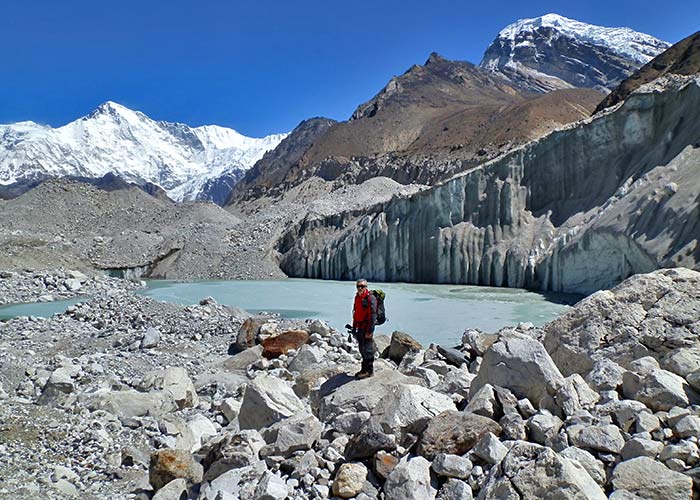
Ausrüstungsliste
- Sonnenhut oder Schal
- Leichte Sturmhaube oder warme Fleecemütze
- Sonnenbrille
- Sonnencreme (40+) und Lippenbalsam
- Baumwoll-T-Shirts und Thermounterwäsche
- Fleecejacke
- Daunenjacke
Unterkörper
- leichte Baumwollhose (lang)
- Thermounterwäsche
- dünne Innensocken (3 Paar)
- dicke, warme Trekkingsocken
- bequeme Wanderschuhe
- Duschsandalen
- Handschuhe (Baumwolle und wasserdicht)
- Desinfektionsmittel
- Schlafsack bis -10 ° C +
- Trekkingrucksack / Tasche
- große Plastiktüten (um den Inhalt des Rucksacks trocken zu halten)
- Trekkingstöcke (optional, empfohlen)
- Wasserflasche oder Camelbag
- Toilettenartikel / Toilettenpapier
Ähnliche Trips
Das Könnte lhnen auch gefallen
- View Details
- Enquire Now
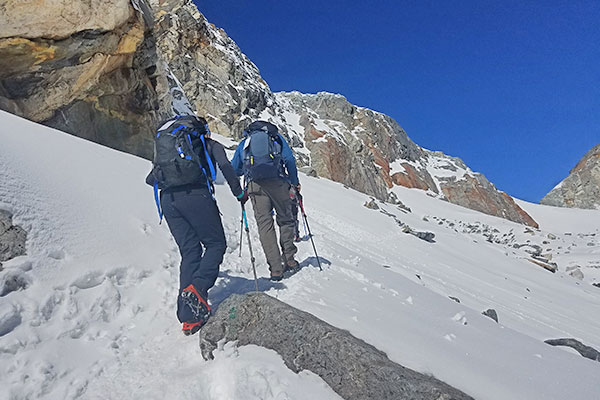
Everest Drei Pässe Trek
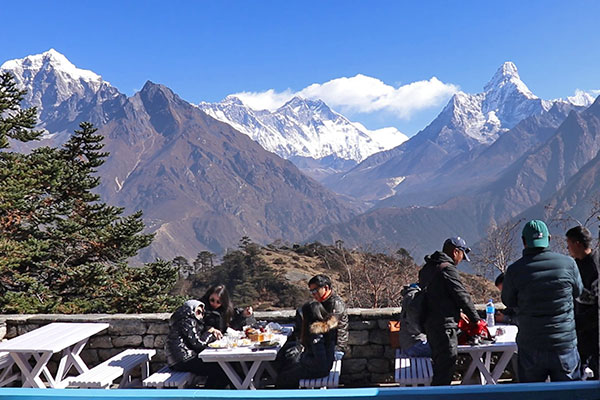
Everest View Trek
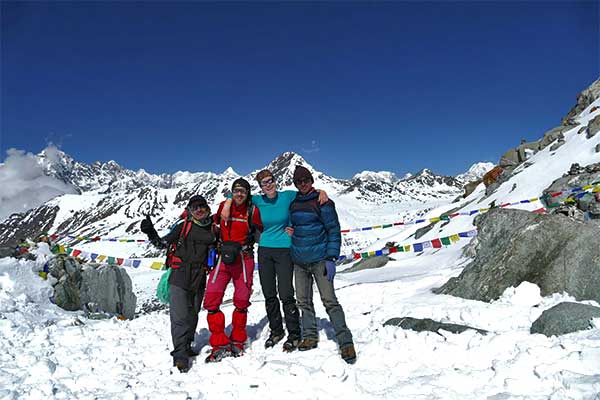
Everest Base Camp - Chola Pass Trek
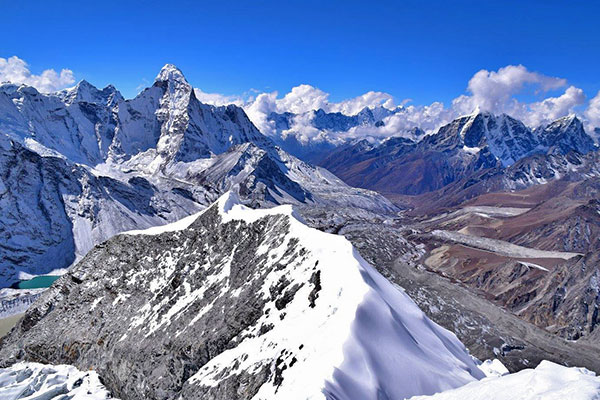
Everest Base Camp und Island Peak
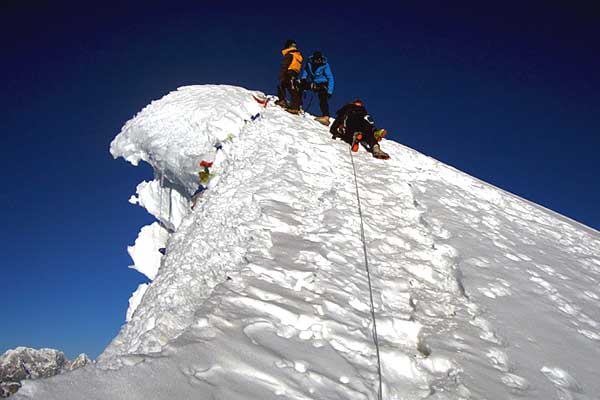
Everest Base Camp mit Lobuche East Peak Besteigung
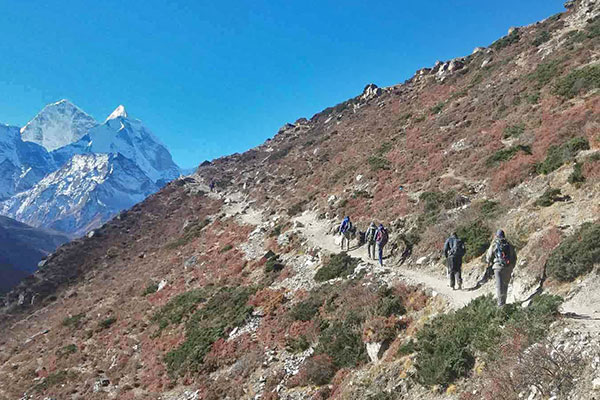
Jiri-Everest Base Camp Trek
- anstrengend
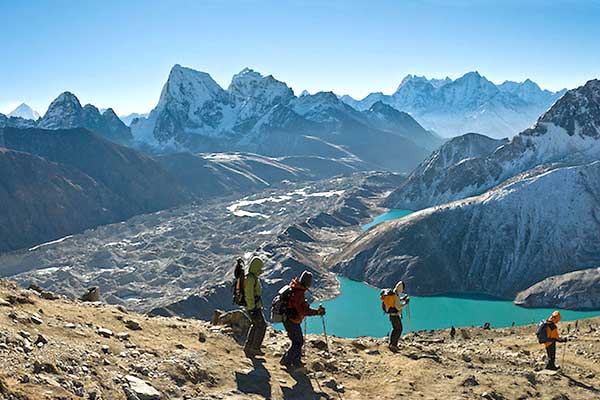
Gokyo Seen und Gokyo Ri Trek
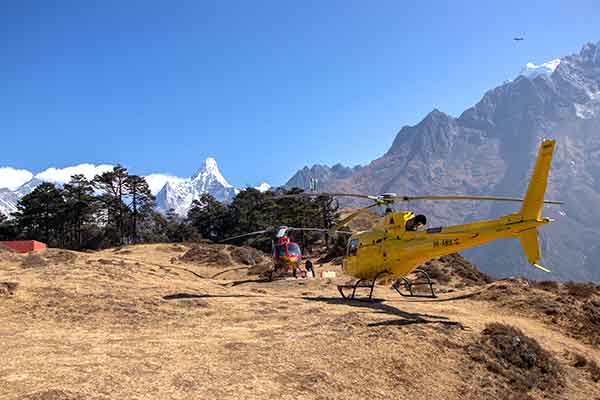
Everest Helicopter Tour
Kundenbewertungen.
What our customers say about us
Amazing 21 days in Nepal
Namaste, My wife and I went recently to Nepal for 22 days. We completed the EBC, visited the Chitwan Park, Pokhara and of course the capital Kathmandu. When one is planning a long, grueling, high altitude trekking trip such as EBC, they have many questions like: all gears, lodges, guide, porter or both, permits, altitude sickness and more… But when we just arrived to Horizon Hotel and we have had the pleasure to meet Mr Ramesh owner of the Nepal Mountain Trekkers agency, all the questions and doubts get its response. Indeed, Mr. Ramesh shows extreme flexibility and speed arrangement for your EBC trekking from getting permits for hiking and porter/guide at the same arrival day to Kathmandu. Moreover, on the same night of my return to Kathmandu from the EBC, Mr. Ramesh arrange for us the next tour trip to Chitwan Park and Pokhara with paragliding and also the bungee jump near the Tibetan border. All this in just within an hour of his making calls, he managed to arrange A-Z tour with all the arrangements needed. I would like really to thank Mr. Ramesh Dhakal from Nepal Mountain Trekkers organized the tour for us. I would highly recommend Mr. Ramesh for his very efficient and professional service. Owner Ramesh is a warmhearted person that listens to your wishes and provides alternatives you probably would not have come up with. In addition, the porter/guide for EBC Mr. Lapa was really professional, respectful and friendly providing even cultural overview of Himalayan Habitant. I was able to capture the spirit of Nepal, creating the most memorable experience that I will never forget. Dhanyabad
Wonderful experience with majestic view of Mt. Everest
My wife and I with another couple (all in our mid 60s) went on a “Everest Base Camp tour” with helicopter from Air Dynasty. It was truly a once in a lifetime experience seeing the majestic Mt Everest. The helicopter took us to Everest View Hotel for a breakfast stop before going back to the base. Mr Ramesh Dhakal from Nepal Mountain Trekkers organized the tour for us. I would highly recommend Ramesh for his very efficient and professional service.
Anky Handoko
Trek to everest base camp and around the annapurna mountains.
Our spectacular 7 weeks of trekking was planned, managed and led by Shiva Lal Bhatta who is an exceptional leader and guide. Shiva has boundless energy and a wealth of local knowledge that will ensure that you miss nothing on a trek, stay safe and have a truly wonderful and enjoyable experience. Shiva arranged all food and accommodation for our trek and we wanted for nothing. He made us very aware of altitude sickness and made sure we avoided that. We walked over glaciers, across avalanche areas, across rivers, through historic sites and numerous beautiful villages and temples. It was truly the trip of a lifetime and I can highly recommend Shiva as your guide in Nepal and I cannot believe that he could be bettered. The people we met through Shiva and the spectacular scenery experiences he afforded us will never be forgotten. I must also thank Ramesh for his part in helping us enjoy such an exceptional experience.
A spectacular and unforgettable adventure to Everest Base Camp”
On returning home from my trip to Everest base camp, people ask me “how was it?”. I always pause and think: “where do I start? The beautiful forests, the wonderful sounds of yak bells, and the things I learnt from my guide Min Nepali. There was so much awesomeness; it’s very difficult to convey what happened in the two and bit weeks I had with Nepal Mountain Trekkers. A good start is Nepal Mountain Trekkers organization and friendliness. From the very first contact I made with Ramesh Dhakal there was a good tailoring of the trek to our needs. All matters were well explained and no stone left unturned in Nepal Mountain Trekkers organisation. The adjustment of the holiday to our needs was constant throughout, with our guide Min Nepali was able to change our programmer throughout the trek to adapt to all our wishes. Min acted in a caring and friendly manner throughout the trip. The accommodation was excellent the whole way up the mountain, the food and drinks options were good (and very filling – I now have a new found love for Dal Baht and yak meat!) and there was plenty of opportunity to meet others travelers and have interesting convivial conversation. Our guide, Min became both a friend as well as our guide 🙂 He was extremely knowledgeable about the environment, enlightening us on our trek on mountain eights, Tibetan culture, and plants. Truly a Renaissance man of the Manaslu Himalayas areas I heartily recommend anyone considering a trip the Himalayas find these Nepal Mountain Trekkers team to get the most memorable experiences out of your time!
Mount Everest View Trak – The perfect trak to the table of the world –
I describe our trip to the Mount Everest View point with one word: AMAZING Everything was perfect. During our trek we had the whole time a comfortable feeling. We arrived in Kathmandu and our guide picked us up at the airport and joined us to our hotel. The hotel was beautiful. It is a small paradise inside Kathmandu. We had the feeling like home. (Hotel Horizon Kathmandu) Our trip starts on the next day with a fly to Lukla. The first adventure during our trip. After the arrival in Lukla we start our trek with the target Mount Everest view hotel. The landscape during the whole time was amazing. We need three days to arrive the hotel. During this time we slept in Tea Houses and the organization was blameless. After the arriving we had the perfect view to the Mount Everest. The feeling was amazing during this moment. We had the perfect Landscape with all the great peaks. On the next day we started the trek back to Lukla and flight back to Kathmandu on the next morning. Resume: During the trip we had a comfortable feeling. Everything was perfect. Are you watching for a one week trip with the perfect landscape and the final view to the Mount Everest? Take this trek. But the trek was more than an amazing landscape and the Mount Everest. You can feel the peaceful atmosphere in the mountains of Nepal and you have a lot of contact to the native people. These people are really amazing. Thank you to the Team of Nepal Mountain Trekkers. Thank you to Ramesh and to Bisang .It was beautiful.
The best two trips of my life, thanks to Nepal Mountain Trekkers
My first trip to Nepal was in 2010, I contacted with Mr Ramesh Dhakal in Thamel and had a great impression; I asked about the activities I wanted to do (Everest Base Camp trek, Annapurna trek, cultural visits to the cities in Kathmandu Valley, sports…). Ramesh explained to me very kindly about all these activities, very deeply, with all the recomendations about the gear, the food, the guide, and made feel very safe, so I felt convinced about doing the activities with the company and no soloing. He told me a very important thing to me: “Here in Nepal we are happy if you are happy, because if you are happy you´ll come back. We are not interested in cheating people in any means”. We discussed the prices and never felt cheated. After that I met my guide Min Nepali, who was with me almost the entire tiem I spent in Nepal, and we became best friends. Ramesh and Min are really wonderful people, taught me a lot and more about Nepal, the nature, the people, the cities, and moreover with their attitude I learned the beatiful people that are Nepali peoples. Also Mr Devaraj Dhakal, the manager of the hotel the company runs, and all the staff made my journey an experience to remember. From temples to jungle to mountain passes (Everest Base Camp, Annapurna Region, Chitwan, Helambu route, Kathmandu, Bakthapur, Patan, bungee jumping, elefant riding…).
And after that…
From that trip I fell in love with Nepal, so in March 2015 I came back to Nepal with my wife, and of course we contacted Ramesh again. We did the Everest Base Camp route with Min Nepali again, this time more than a guide, he was a brother to us. Never felt treated so well. This time my wife also fell in love with Nepal.
From my experience, if you go to Nepal don´t doubt to contact Nepal Mountain Trekkers. Ramesh Dhakal and his staff will make the very best to make your trip a wonderful experience.
My 5th experiance in Nepal
After seeing some excellent reviews on Trip Advisor, we booked our 18 days Sagarmatha Trekking package with Nepal Mountain Trekkers. The team of company came to T.I.A for us received us on the evening and took us on the hotel horizen thamel and from the 2nd day we start our packing for adventure trekking with my 9 friends for 18 days, From the begging i had noticed this tour goona be one of the most adventure tour since, at the end too i felt my heart was not wrong.
Thanks Nepal Mountain Trekkers team, our guide and porters. A tour company for respect. Hope to see you again on 2017/18.
Everest basecamp trekking
We met Mr. Ramesh Dhakal during our Everest basecamp Trek. He was very helpful and very kind. He gave us a lot of helpful advices. We stayed his hotel which name is hotel horizon. Although the hotel is in the centre of Thamel, it is very quiet and very nice and clean. We highly recommend Nepal Mountain Trekkers and hotel Horizon. Our guide Ngima Tamang was very helpful and very kind. We highly recommend him.
Mehmet Akif K
Apart from trekking enjoyment and fun there was wonderful experience with ramesh ( owner ).
Apart from Trekking enjoyment and fun there was wonderful experience with Ramesh ( Owner ) , he took care of us very well and understand client’s needs very well. Looking for more trek with him.
rajuverma23
Partner von.
Schicken Sie eine Nachricht
Vor- und Zuname*
Ihre Nachricht*
- Tips & Tricks
- Tales from the Trails

The Ultimate Insider’s Guide to Trekking Everest Base Camp
CAMPING TIPS & TRICKS , Hiking / Camping / Tour Companies , TRAVEL

At 8,848 meters, 29,029 feet above sea level, Mt. Everest is the tallest mountain in the world, towering over the surrounding peaks in the Himalayas mountain range on the border between Nepal and Tibet.

Even if you’re not a diehard mountaineer, you can still explore this beautiful region of Nepal with a trek to Everest base camp (EBC).
Not only will you get lifelong bragging rights for completing the trek to base camp, but it’s also a beautiful trek in its own right. Amazing vista can be seen passing through the Sagarmatha National Park and the awe-inspiring Himalayas .
Although the trek takes about two weeks, it’s surprisingly accessible and has been completed by many first-time trekkers.
Everest Base Camp: A Brief Overview
Since the first successful summit in 1953 by Sir Edmund Hillary and Sherpa Tenzing Norgay, the imposing peak has attracted decades of adrenaline-seekers wishing to add their name to the list of successful summiteers. A good portion of these climbers never returned .
Despite the intimidating statistics, the sister trek through the picturesque Khumbu Valley to the base camp used by professional mountaineers is an attainable goal for many people.

Located at an altitude of 5,361 meters, 17,590 feet above sea level, you don’t need fancy equipment or mountaineering skills to reach EBC. Certainly, it takes just a positive attitude and a reasonable level of fitness.
There’s a sense of camaraderie and a tangible buzz in the air as the adrenaline of the would-be Everest summiteers infects everybody around them.
The scenery at these altitudes is breathtaking and varied, ranging from rhododendrons and pine fields to rivers; suspension bridges strung with prayer flags; glaciers, lakes, valleys, high mountain passes, and finally, the spectacular Himalayan mountain peaks!
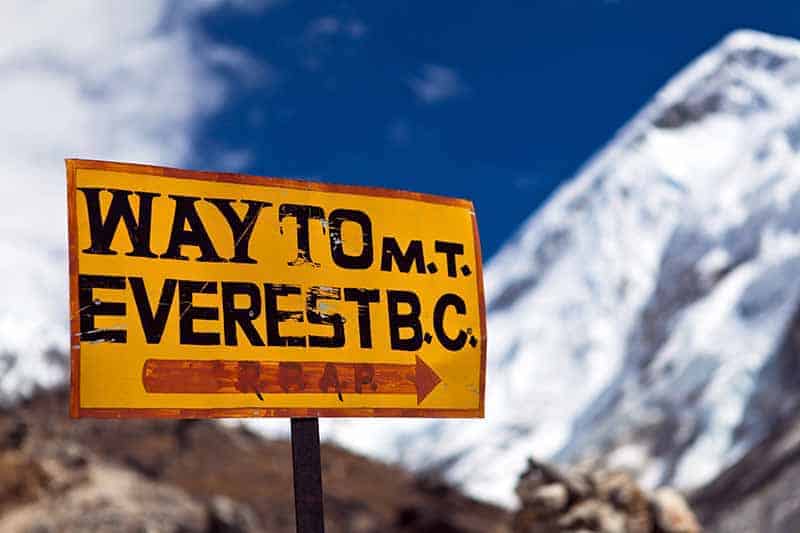
The Sagarmatha National Park is home to rare animal species such as snow leopards and red pandas – though it’s very unlikely you’ll encounter them. You’ll frequently have to step aside (to the uphill side!) as you encounter yaks on the trail.
Whether you choose to follow the traditional EBC route or one of the alternative trails, it’s guaranteed to be an experience you’ll never forget.
In contrast to most multi-day treks where you’d be camping in a tent, trekkers to base camp stay in cozy tea houses. You can find several available in a range of budgets, which function as both hotels and restaurants.
The trek is dotted with Buddhist monasteries and tiny villages almost all the way up. The relaxed pace of the trek allows plenty of time for you to explore the villages and get to know the local Sherpa culture.
Mt. Everest is increasingly covered in garbage left behind by the hordes of people who have set out to conquer its lofty heights. When you go, please respect the environment and do your best to minimize waste.
The most popular time of year to do the Everest base camp trek is between February and May – the pre-monsoon season.
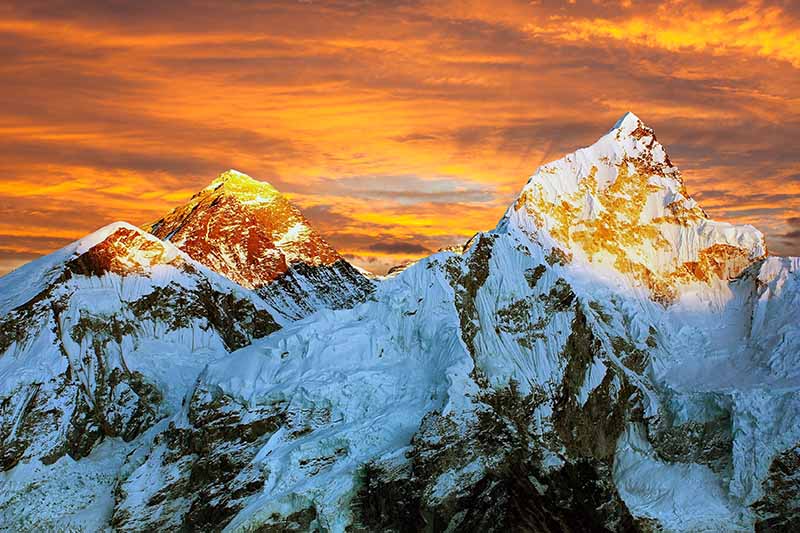
During these spring months, the weather is typically warm and dry and the mountains will be ablaze with colorful rhododendrons.
This is also peak season and while you’re unlikely to have the trails to yourself, you’ll enjoy a buzzing atmosphere at the tea houses on the way. This is also when most Everest climbers make their summit attempts.
The summer months bring the monsoon rains, resulting in slippery trails and a heightened risk of landslides. If that doesn’t deter you, the leeches and foggy weather might! It’s not recommended to attempt the trek in the summer.
It can also be difficult to fly into Lukla during the monsoon. Indeed, this is a good time to pick the Jiri trek over the classic EBC trek.

If you want fewer crowds, try going in September or October, the post-monsoon months, when you have the highest chance of clear skies, although temperatures are slightly colder.
You can even do the trek in the winter but be prepared for sub-zero temperatures most days and lots of snow.
Whenever you go, make sure you pack for unpredictable weather in case a snowstorm takes you by surprise.
Trekkers interested in the local culture might want to plan their trip dates around traditional holidays with celebrations in Kathmandu, such as Holi (February/March) or Indra Jatra (September).
Another thing to consider when planning your trip is flight prices, which can vary considerably. Check flights before booking as this might have a huge impact on when you want to go.
Lastly, be aware that it might be harder to find tour operators who provide treks in off-season months. Also, some of the paths might be closed.
Conversely, if you want a stab at actually sleeping in Everest Base Camp, then late spring is your best option. It will be rare to find tour operators who might be able to wrangle this.
Everest Base Camp Packing list
If this is your first multi-day trek, don’t forget to budget for all the equipment you’ll have to take with you.
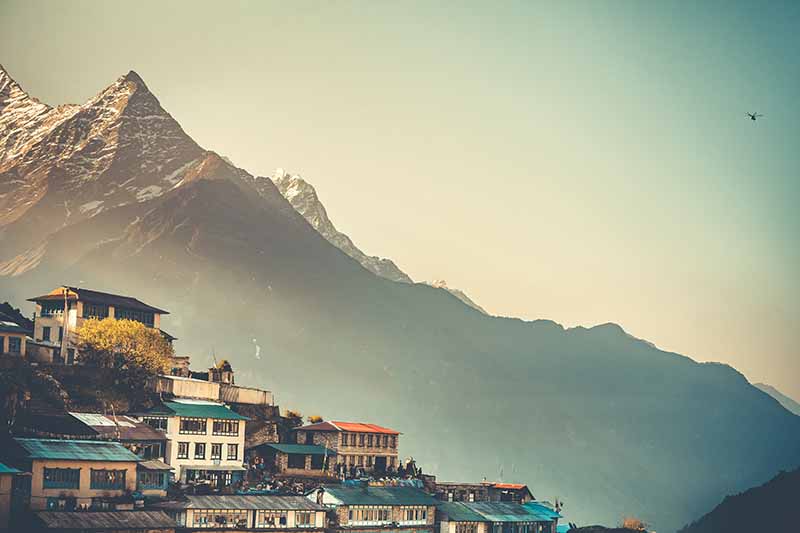
You can choose between renting or buying your gear. Hikers who plan on doing more multi-day treks might want to invest in their own equipment.
If you’re doing a two-week trek, it makes more sense to rent your sleeping bag and down jacket. For trekkers who plan on trekking for a whole month, it makes more financial sense to buy.
The neighborhood of Thamel in Kathmandu offers plenty of options for buying and renting. However, the products on offer may be of questionable quality.
Further on, Namche Bazaar is a last-resort option if you find you’ve forgotten to pack any essentials. If you keep your receipts, then talk it over with the shop when buying. Some shops will buy your gear back from you, at the end of your trek, for a reduced price.
Almost everything available for sale along the trek has been carried up the mountain, either by yaks or people. This means things get more expensive the higher you go.
Pack strategically. This means bringing the items you can’t live without while avoiding overloading your backpack. Whether you hire a porter or decide to go solo, somebody will be lugging your things up the mountain. Indeed, think twice before including unnecessary items like an extra book or five spare shirts!
Aim to pack around 10kg if you’re carrying everything yourself, and 20-25kg if you’re getting help from a porter. Don’t forget that your water adds extra weight. Try packing your bag with full water bottles, to get a more accurate idea of how much you can bring.
This list is aimed at trekkers who will be sleeping in tea houses every night. Be aware that if you don’t book early enough, the tea houses may be sold out in high season.
If you think you might end up having to camp, Then you’ll need more supplies not covered on this list, such as a winter insulated tent , sleeping pad , etc.
What to Wear
The clothes you pack will depend on which season you’re visiting in. Make sure you have enough clothing to keep warm, especially in the evenings.

Layers are crucial, as temperatures and weather conditions will change drastically between day and night and as you ascend and descend in altitude.
Tea houses often only heat the common areas, and then only in the evenings, so bring warm clothes for lounging around at night.
The higher you get, the less likely you are to have power in your tea house, or only for a few hours as they’re run off solar power.
Base layers: Your base layer should be comfortable and moisture-wicking. Stay away from cotton; go for merino wool or synthetics .
Pack a long-sleeved shirt (avoid short sleeves as you’re more likely to get sunburnt) and long underwear, if only for the cold evenings.
Fleece mid-layer: You’ll probably be putting this on and taking it off with every mountain pass. Indeed, try to find one that will fit easily into your day pack.
Outer layer: Get a down jacket with a good warmth-to-weight ratio, as you’ll be carrying it much of the time.
Waterproof windbreaker and pants.
Hiking pants: Well-insulated trekking pants , or trekking pants that can turn into shorts.
Waterproof hiking boots. We can’t stress enough how important it is to break your hiking boots in properly before your trek.
Don’t forget to bring a pair of comfortable sneakers or sandals for the evenings and for bathroom runs.
Socks: Woollen hiking socks are worth the investment – bring a few pairs that can handle very cold temperatures for the higher altitudes, and look for flat seams and padded spots to reduce blisters.
Sock liners and Vaseline are two other good ways to prevent blisters . You should also bring a pair of warm socks for base camp.
Gaiters: These will be especially useful during the rainier months.
Gloves : Pack a thin pair of “inner” gloves and a very warm pair of outer gloves. There will be at least one or two days where your fingers will freeze otherwise – for example, the day you summit Kala Patthar.
Scarf/balaclava/buff: The trail to EBC gets infamously dusty, provoking the “ Khumbu cough ” that plagues many hikers. A buff or something similar will keep you warm as well as provide you with a layer to breathe through to minimize the amount of dust in your lungs.
Beanie and sun hat , preferably with neck cover, to protect against the sun .
Underwear and sports bras: You’ll probably be reusing these, so get good-quality, non-cotton ones.
Accessories
Drinking water: Most tour operators provide purified water. Avoid bottled water, as this is expensive on top of being an environmental disaster.

We recommend bringing two big reusable water bottles (or a water bladder for drinking on the go). Tablets take a while to work and it’s nice to have one water bottle ready to drink while the other one is getting purified.
You can also fill a bottle with hot water and sleep with it in your sleeping bag if you’re cold during the night. If you’re purifying your own water, bring water purification tablets , LifeStraw , or a Steri-pen. But remember, these need charging, and charging on the trail costs money.
You may wish to add flavor enhancers to your water. Unfortunately, at Gorak Shep the water is very mineralized so you’ll need to buy bottled water.
Showering: Whether or not you shower is up to you. Expect to pay around $5 for a hot shower. Some people rely on wet or backpacking body wipes , especially since wet hair is no fun in negative temperatures!
Sunglasses: The combination of snow and altitude is brutal on your eyes, so invest in good polarized sunglasses with wraparound arms.
Sleeping bag : The teahouses will provide blankets and pillows but you’ll want your own sleeping bag and pillowcase.
Find a mummy sleeping bag rated to -20° C – or colder, depending on the season. Consider bringing a silk liner , especially if you’re renting your sleeping bag.
Toiletries: Sunscreen , SPF chapstick (this is better than lip balm as there’s no need to smear it on with your grubby fingers), quick-drying towel, tissue, baby wipes, period supplies, compressed toilet paper tablets or biodegradable toilet paper (remove cardboard and keep in ziptop bag), hand sanitizer, toothbrush and toothpaste, etc.
Always bring toilet paper with you. Most bathrooms are squat toilets and are located only in villages.
Tip : wet wipes are more expensive than toilet paper on the trail, so if you have to choose, stock up on wet wipes and buy toilet paper when you run out.
Shewee: Ladies, you’ll be glad not to have to pull your pants down in the freezing high-altitude weather. If you need to pee, then I recommend using a portable pee device, like PeeBuddy Reusable Female Urination Device . You stand and use the portable pee funnel, so you don’t need to squat.
If you get your period on the trail and you’re not comfortable with using the DivaCup, another good option is to keep used pads/tampons in a ziptop bag and dispose of them in the next garbage can.
Personal first-aid kit: Bring diarrhea meds, altitude meds, antibiotics, ibuprofen, paracetamol, aspirin, bandaids, blister plasters, tape/trekker’s wool, Vaseline, cough drops (to beat the Khumbu cough), cold medicine, rehydration salts.
Tour operators should provide the rest. Don’t forget to get your travel vaccines before you go.
TSA approved padlock for your luggage.
Backpack: What you pack your gear in will depend on whether you’re using porters. Most porters prefer you to pack your things in a soft-sided duffel bag. Check with the tour operator in case they provide these for you.
If you have a porter, then you’ll only need a daypack for yourself. If you’re not hiring a porter, then bring a collapsible daypack anyway in addition to your backpack. This is so you can leave your big backpack in the tea house during the one-day acclimatization hikes.

Try to get a backpack with straps for hiking poles and zippers to open it from the sides. Not to mention, you won’t have to dig everything out of your bag whenever you want to access something.
Dry bag or plastic cover for your backpack and daypack to prevent water ingress.
Hiking poles : These are a must! All the treks listed here will take you uphill, downhill, uphill and downhill again. Hiking poles will save your knees, and they’ll come in handy on slippery trails during the wet season.
Headlamp or flashlight : You’ll be glad to have this in the evenings after the power goes out, and during early-morning or late-night hikes. Remember to bring extra batteries.
Trekking map: If you’re going independently, a good trekking guidebook is essential – Lonely Planet is highly recommended.
Ziptop bags: These always come in handy for protecting electronics, etc.
Camera or GoPro with memory card and extra batteries.
Money: There are ATMs at select points such as Lukla and Namche Bazaar. But these have low daily withdrawal limits and high commission fees. What’s more, they have been known to take money out of your account without actually dispensing it to you.
Since currency exchange rates on the trail are sky-high, it’s best to bring a stash of local rupees with you. You’ll need rupees to pay for meals, showers, tips, etc.
Wi-Fi: A good option for staying connected is to buy a local sim card. It will give you data to about 4000m altitudes, and sometimes in EBC itself.
You can also check Everest Link for Wi-Fi data packages. The connection is supposedly available in most teahouses along the way, but it can be slow and unreliable so don’t depend on it too much.
Top Tip : Beware of phone updates. These will eat through your Wi-Fi and data limits before you realize what just happened!

Entertainment: EBC treks usually only schedule a few hours of hiking a day, to allow you time to acclimatize. Bring books, a Kindle , cards or other games for the many hours of downtime. Certainly, bring a journal so you can remember this once-in-a-lifetime experience!
Solar charger: Many teahouses offer power points where you can charge your devices for a nominal fee. Also, don’t forget to bring an adapter. It’s a good idea to bring your own solar-powered charger and extra batteries to minimize costs.
Tip : Keep batteries, base layers , and anything else you don’t want freezing in your sleeping bag with you overnight. Keep your phone in flight mode to save power.
Important documents: Bring printouts of your travel insurance information. And make sure one of your travel buddies knows what to do and whom to contact in case of an emergency.
Bring your passport, visas, money, etc. – I always keep these documents in a zip-top bag.
Trekking solo? Bring a safety whistle , compass , pocket knife , & duct tape, especially on the less-crowded trails
High-calorie snacks: These will make a huge difference to your experience. Snacks are exceedingly expensive on the trail, and they provide welcome calories on tough trekking days.
You’ll have to decide how many you want to bring and which ones you want to buy along the trail.
Cloth bags : Many trekkers use these to separate dirty laundry and organize different outfits.
Earplugs: You’ll be glad for these when the tea houses are alive with the sound of Khumbu coughs.
A Note on Trekking Insurance
Be very careful when purchasing travel insurance, because regular policies usually stop covering you once you ascend higher than 3,000m/9,840ft.

At these altitudes, you have a higher chance of getting Acute Mountain Sickness. Also, there’s a pretty good chance you’ll have to be airlifted out to a hospital for injuries . To clarify, injuries like a pulled muscle or twisted ankle at sea level can be more serious at higher altitudes.
Because of these higher costs and risks , insurance companies will charge you a premium for high-altitude trekking insurance.
Luckily, there’s no shortage of insurance companies that offer travel insurance specifically tailored to Everest Base Camp trekkers.
When purchasing a policy, make sure you’re covered for trekking up to altitudes of 6,000m/19,685ft. In addition, ensure it has search and rescue costs, preferably by helicopter.
Don’t forget to check if you’re covered for different travel-related illnesses (and make sure you get your vaccinations before going!).
It’s also nice to have compensation for delayed or canceled flights and repatriation in case of death (hopefully you won’t be needing this one).
Check the clause about lost, stolen or damaged luggage to see if it will cover most of the cost of your hiking gear.

If you’re traveling in winter or shoulder season, then check for trip cancelation insurance. This is to ensure you’re covered if your trek is canceled due to weather.
You’ll likely have other considerations depending on your personal situation. Don’t just take our advice for it – remember to do your research, ask questions and read the fine print of your travel insurance policy before you purchase.
I always keep my travel insurance information handy while on the trek. Additionally, I pass it along to someone else in my group. This is so they know whom to contact in case of an emergency.
Some travel insurance providers require you to confirm with them before ordering a helicopter. Check out this option on getting trekking travel insurance for more information.
How to Avoid Altitude Sickness
Most tour operators organize a relaxed trekking schedule and follow the mantra “climb high, sleep low”. In essence, this is to avoid the risk of altitude sickness.
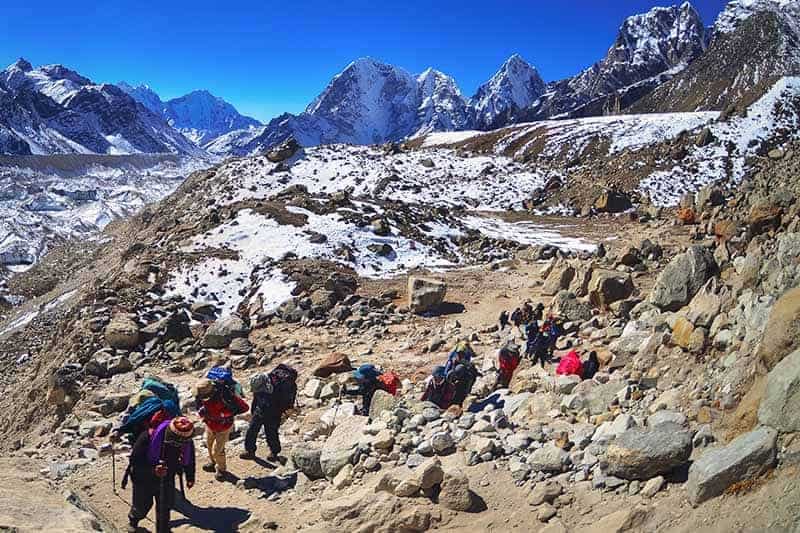
Take it slow – once you finish hiking for the day you’ll have a lot of dead hours in the teahouse. For this reason there’s really no point in racing there.
It’s important to respect the acclimatization days. The acclimatization hikes are designed to help you adjust to tomorrow’s altitude.
Try to drink 3-4 liters of water a day, as dehydration will make the altitude sickness way worse. It also goes without saying that you shouldn’t drink caffeine or alcohol or smoke during your trek.
If you can, then cut out these vices about a week before you start hiking. So that you won’t suffer from withdrawal headaches.
Many people swear by Diamox as a preventative drug against AMS. It’s your choice whether to take this or not. I personally found the tingling fingers and toes to be very off-putting, but it probably helped me acclimatize.
Altitude sickness is unpredictable and doesn’t discriminate based on fitness or age. Listen to your body and descend immediately if you think you have signs of Acute Mountain Sickness.
Check out our article on altitude sickness for a more detailed overview.
Choosing a Tour Operator
Every year there are rumors that the Nepali government will make it compulsory to go with a guide.. But so far, it’s still possible to undertake the trek to EBC on your own.

Unless you’re going in high season, you’ll can drop in at tea houses and get a bed without a reservation.
Independent trekkers can choose whether to hike all by themselves. While others choose between ring a porter, a guide, or a guide and a porter. A guide will speak some English and can help with booking accommodation. However, a porter probably won’t speak English and will only carry your bag.
You can also hire one person who acts as a guide and a porter. Another upside to hiring a guide is that you’ll be providing someone with a job. And in turn, you’ll get to immerse yourself in the Nepali culture.
Alternately, you can opt to join a guided trek with a tour operator. While this is pricier, it’s a good choice for people who have never done such a long, high-altitude trek before.
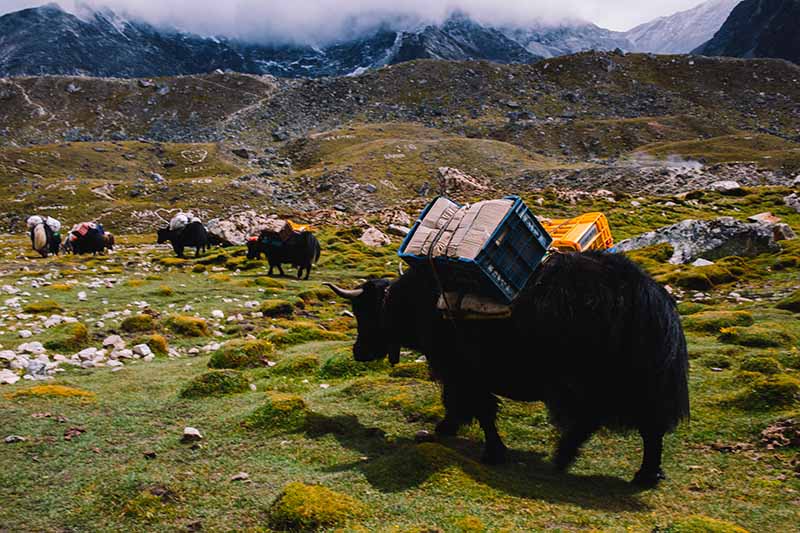
Tour operators typically arrange flights, airport transfers, accommodation, visas and permits, porters and guides. Western tour operators will usually charge more, but provide a more trustworthy service. You can expect to pay about twice as much for a Western tour operator.
Check to see if your tour operator is registered with the Trekking Agencies Association of Nepal (TAAN). TAAN regulates trekking agencies in Nepal to ensure fair treatment of employees, respect for local communities and preservation of the environment.
The Kilimanjaro Porters Assistance Project mission is to improve the working conditions of porters. They advocate for fair treatment and wages, lend free mountaineering clothing, and encourage them to work for only ethical companies. Through providing education and training opportunities, guides and porters have received classes on porters rights, Leave No Trace and are certified in First Aid.
Please make every effort to ensure the porters and guides are dressed properly, stay within the weight limit including their own luggage. Also, ensure they have adequate sleeping arrangements and insurance and are paid a fair wage.
It’s better to go with companies that employ their porters and guides full-time instead of freelance because there’s a better chance the company is providing them with benefits, sick days and health insurance.
Tipping is always a tricky subject and suggested rates will depend on whom you ask. Aim for around 15 percent of salary (if you’re traveling in a group, this number refers to the total pooled tip) per porter and/or guide, and adjust accordingly.
The classic Everest Base Camp trek winds through the Khumbu valley; once reaching Everest Base Camp, you’ll retrace your steps back down to Lukla for the return flight to Kathmandu.

If you’re interested in escaping the crowds or doing circular routes that don’t involve retracing your steps, there’s a variety of alternate routes to choose from.
You can also opt to tack small detours onto your classic EBC trek. This is especially doable if you’re traveling independently or in a small group.
You shouldn’t have any trouble booking your trek, even on the classic EBC trek.
Classic Everest Base Camp trek
The classic Everest Base Camp trek takes about 14 days, including time in Kathmandu before and after.
From Kathmandu, you’ll fly into Lukla Airport (2,860m/9,383ft) with its famously short runway – try to sit on the left side of the plane so you can catch your first views of Mt. Everest.
It’s a good idea to leave yourself a few buffer days, as Lukla flights are often delayed due to weather. Flights should be included in your tour price; otherwise they’re about USD 300, plus USD 100 for your guide’s ticket.
From the airport, you’ll trek to Phakding for the night.
The next day you’ll set out from Phakding and follow the Dudh Koshi River, crossing suspension bridges and pine forests until you reach the Namche Bazaar (3,440m/11,286ft), in the Sagarmatha National Park UNESCO World Heritage Site .
Namche Bazaar is the region’s principal trading point, so use this opportunity to stock up on supplies you might have forgotten. If you’re there on Saturday, then don’t miss the market. From here you can also catch a peak of Everest.
You’ll take a day to acclimatize in Namche Bazaar – you can make the most of the Wi-Fi, stock up on any supplies you forgot, check out the Sherpa museum or just tool around the village.
The day after you’ll follow the former Tibet-Nepal trading route via Thame to Tengboche. These villages are known for legendary views, where you can visit one of the region’s biggest monasteries .
Next you’ll hike through Phangboche to Pheriche while admiring the views of Ama Dablam. You might be interested to know that Pheriche is where the Himalayan Rescue Association makes its base – but hopefully you won’t need to use this information!
Most people stay in Pheriche for a day to acclimatize and visit local attractions like the Imja Lake or Dingboche village, which boasts views of Lhotse and Island Peak.
Now that you’re rested, you’ll be ready to tackle the trek to Lobuche, which features a 600m/1,969ft elevation gain. You’ll skirt the perilous Khumbu Glacier and witness the many memorials to sherpas and climbers who perished in their attempt to climb Everest.
From Lobuche you’ll set out towards Gorak Shep, which is the world’s highest permanently inhabited village.
Finally, it’s time to push on through the moraine towards Everest Base Camp! Since actual summiteers of Everest have priority, don’t expect to spend too long there or even be allowed inside the base camp itself.
But don’t worry, the adrenaline-filled atmosphere extends all the way down to the trekker stop point! From here you’ll go back down to Gorak Shep for the night.
You can’t actually see the peak of Mt. Everest from Everest Base Camp, so the next day you’ll make a steep ascent up to the summit of Kala Patthar (5545m/ 18,192ft) to catch amazing views of Everest, Nuptse (7,861m/25,791ft) and Lhotse (8,516m/27,940ft).
Most groups try to do this at sunset on the same day as they reach EBC, or at sunrise the next morning, when Mt. Everest sometimes turns pink in the early-morning light.
Forging on ahead, you’ll descend to Dingboche or Pheriche, and from there past Tengboche and back to Namche Bazaar the next day. Keep an eye out for the massive fields of wild rhododendrons if you’re visiting in the spring!
Your last day of trekking will take you back to Lukla, where you’ll spend the night before catching the flight to Kathmandu.
- Pros : Comparatively gentle altitude profile, can be done independently
- Cons : Have to retrace steps on the way down, can be crowded
- Length : ~130km (12-14 days)
- Highest point : Kala Patthar (5545m/ 18,192ft)
Gokyo Lakes Trek
The Gokyo Lakes Trek is popular for its beautiful glacial lakes , nestled in the quiet Gokyo valley.
Like the classic Everest Base Camp trek, the Gokyo Lakes trek starts at Lukla, breaking off towards the northwest at the Namche Bazaar.
This trek is considered slightly more challenging than the classic EBC trek, with steeper ascents and more time spent at high altitudes.
It takes 2-3 days longer, detouring around some of the most crowded sections of the classic base camp trek but still finishing at Everest Base Camp.
You’ll see glacial lakes and summit Gokyo Ri (5,357m/17,575ft) where you’ll earn views of Everest, Lhotse and Cho Oyu (8,201m/26,906ft).
Fly into Kathmandu, spend a few days acclimatizing and then take another flight to Lukla. The next day, you’ll trek down through the Dudh Koshi Valley to Phakding past several Buddhist sites.
Hiking through pine forests and along the Dudh Koshi River, you’ll cross several suspension bridges including the Hillary Suspension Bridge. After entering the Sagarmatha National Park, you’ll continue hiking until the Namche Bazaar.
You’ll then separate from the classic EBC trek and head northwest towards Dole along the Dudh Koshi valley. You’ll get some of the first views of Everest, Lhotse and Ama Dablam today.
The next day brings a steep climb towards Machhermo, which is populated with yaks in the summer.
Allow yourself a day to acclimatize and enjoy views of Ngozumpa Glacier (the biggest glacier in the Himalayas). Once you’ve enjoyed the glacier, trek to the Gokyo lakes and you’ll eventually reach Gokyo village. If you are tired by now, you’re in luck because this is where you’ll bed down for the night.
This is another popular time to take an acclimatization rest day and explore the surrounding lakes, or summit Gokyo Ri, which stands almost 5,500m/18,045ft above sea level.
Stop to take in the stunning views of Everest, Lhotse and Cho Oyu, then continue back down to the Ngozumpa glacier and on into Dragnag.
The next day is a tough one. You’ll traverse Cho La, one of the “Three Passes” (5,420m/17,782ft), cross a glacier and then spend the night in Zonglha.
Joining up with the classic EBC trek, you’ll stop for a moment of reflection at the memorials to sherpas and climbers who perished in their attempts to climb Everest, and then continue on to Lobuche for the night.
From Lobuche, you’ll skirt the Khumbu glacier, hiking up past Gorak Shep and finally you’ll reach Everest Base Camp! Enjoy it while it lasts, because the priority at EBC is the Everest summiteers, especially in the spring months.
You’ll hike back down to Gorak Shep alongside views of the Khumbu icefall . Part of the highest glacier on Earth, the icefall’s deadly crevasses, unstable seracs and unpredictable avalanches have taken dozens of lives.
The next day you’ll hike up Kala Patthar, with more views of Everest and the neighboring mountain peaks, and then down to Dingboche along the classic EBC route.
It’s time to return to Namche Bazaar. The day after you’ll hike back to Lukla through the Dudh Koshi valley, and then fly into Kathmandu.
Because the trek is longer, expect to pay more than you would for the classic EBC trek. Trekkers are advised not to attempt this trek independently, due to the increased difficulty and the fact that there are fewer people on the routes.
Like the classic EBC trek, the best time to go is during spring or fall. Because the trek isn’t as popular, you shouldn’t have to worry about crowds for most of the way, so feel free to go during peak season.
- Pros : Fewer crowds, more challenging, more sights, get to summit a peak, see the world’s highest freshwater lake system, prettier landscapes than classic trek, circular route so no need to retrace steps
- Cons : More expensive than classic EBC trek
- Length : ~220km/136 miles (16-17 days, including a few days in Kathmandu before and after)
- Highest point : Kala Patthar (5545m/18,192ft)
Jiri to Everest Base Camp
This old-school route mirrors the route taken by the first Everest summiteers in the 1950’s, starting with an 8-hour bus ride from Kathmandu to Jiri instead of flying into Lukla.
From Jiri, you’ll pass through the towns of Sete, Junbesi and Numtala in the Solu Khumbu region.
After reaching Lukla, you’ll join up with the classic EBC trek, passing through Phakding, Namche Bazaar, Tengboche, Pheriche and Gorak Shep.
In total, the Jiri route takes about 5-6 days longer than the classic route.
Jiri route trekkers will have the chance to spend a lot more time with the locals. You’ll also spend more time at low altitudes – the route starts at just 1,800m/5,905ft above sea level – meaning landscapes will forests and streams with actual running water.
Much of the trek is off the beaten path, with fewer crowds than the EBC classic trek.
Tool around Kathmandu for a day and then take an 8-hour (190km/118 mile) bus ride, following the Sun Koshi River to Jiri and then Shivalaya.
The next day, you’ll cross a suspension bridge over the river and then explore several tea houses. Go through the Deorali Pass, taking a moment to check out the prayer flags and decorated walls, and then head down to Bhandar for the night.
From Bhandar, you’ll walk through fields and forests before embarking on a steep descent t
owards the village of Kenja. Uphill again, you’ll traverse the Lamjura Pass and arrive at the town of Sete.
The next day, you’ll return to the Lamjura Pass and pass through magnificent fields of pine trees, magnolia and rhododendrons. Without a doubt, you’ll appreciate the stunning mountain views. Next,hike down the other side and you’ll arrive at the town of Junbesi.
Back into the forest, you’ll see Mt. Everest for the first time. You’ll then cross the Ringmo Khola suspension bridge and arrive at the village of Ringmo with its gorgeous Tibetan architecture. Another forest and you’ll be at Nunthala.
In the morning, you’ll head out towards the Dudh Koshi River, crossing another impressive suspension bridge on your way to Bupsa.
The next few days will take you to higher altitudes as you pass through forests with monkeys and several small villages.
Arriving in Lukla, you’ll join up with the classic EBC trek. After reaching Everest Base Camp, you’ll summit Kala Patthar for the obligatory views of Mt. Everest at dawn and then return through Gorak Shep, Namche Bazaar and finally Lukla, for your flight back to Kathmandu.
Like the classic Everest trek, the Jiri route is best undertaken in spring or fall. Caution: some parts of the Jiri trek may be closed in the winter, so we don’t recommend going during this season.
The Jiri route is only slightly more difficult than the classic Everest Base Camp route, due to its longer duration.
The average day of hiking comprises 5-6 hours, covering about 15km/9 miles. On the bright side, due to the more gradual ascent compared with the classic trek, you’re less likely to get altitude sickness.
- Pros : More authentic, less touristy, chance to see Solo Khumbu landscapes (terraced farmland, forests, Dudh Koshi river, sherpas), gradual acclimatization
- Cons : 8-hour bus ride (but scenic!)
- Length : ~250km/155 miles (22 days, of which 18 days of trekking)
- Highest point : Kala Patthar (5,545m/ 18,192ft)
Three Passes Trek
As you might infer from the name, the Three Passes trek takes you across three high mountain passes (all higher than 5,000m/16,400ft). Thus, making it more difficult than the classic EBC trek.
After reaching Namche Bazaar, the Three Passes trek splits off from the classic trek. This takes you towards Thame and the Nangpa Valley. The trek takes around 19 days in total, of which 14-15 will be spent trekking. Getting a guide is highly recommended.
After flying into Lukla from Kathmandu, you’ll work your way down to Phakding.
The next day will take you across several suspension bridges on the way to Namche Bazaar. You’ll be there for a day of acclimatizing. After which you’ll split off from the classic EBC route and head to Thame.
Crossing the Bhote Koshi river, you’ll reach Lumde and catch your first good views of the mountain peaks. The next day, you’ll tackle the first pass.
The Renjo La (5,360m/17,585ft) lies near the Dudh Koshi valley and will reward you with views of Everest. Then you’ll pass the Gokyo lakes and the village of Gokyo, where you’ll summit Gokyo Ri and catch sight of Cho Oyu.
After spending some time acclimatizing in Gokyo, you’ll walk across the Ngozumpa Glacier. This is Nepal’s largest glacier, and you’ll then spend the night in Dragnag.
The next day is notorious. You’ll traverse the next pass, Cho La (5,420m/17,782 ft), which has a glacier and prayer flags at the top. On the other side of the pass lies Zonglha.
Joining back up with the base camp trek, you’ll visit Lobuche and Gorak Shep and take in views of the Khumbu Glacier, Everest, Lhotse and Nuptse.
You’ll explore Everest Base Camp and summit Kala Patthar before retracing your steps back through Gorak Shep and Lobuche.
The trek keeps on going, past the Kongma La pass (5,535m/18,159ft), down into the Chukkung valley and up to the summit of Chukking Ri (5,550m/18,209ft) with more mountain views.
You’ll trek through Dingboche, with its views over the Khumbu Valley. Eventually, you hike down through the rhododendron fields and the village of Khumjung, ending back at the Namche Bazaar.
From here you’ll cross the Dudh Koshi, following the classic EBC route back down to Lukla.
This trek can also be done backwards; it’s up to you whether you want to head clockwise or counter-clockwise after the Namche Bazaar.
Many people recommend doing the trek counter-clockwise to avoid crossing the difficult Renjo La Pass right off the bat.
You’re best off doing this trek with a tour operator, as it’s quite off the beaten path.
- Pros : See a little bit of everything, uncrowded trails, challenging elevation profile
- Cons : Riskier terrain than classic EBC trail, long stretches with no facilities
- Length : ~21 days (150km/90 miles)
- Highest point : Chukking Ri (5,550m/18,209ft)
Island Peak (Imja Tse)
Experienced trekkers who wish to try their hand at mountaineering might be interested in summiting Island Peak (6,189 m/20,305 ft).

To master the glaciers and icy headwall during the ascent of these peaks, you’ll need to use crampons, an ice ax and potentially a ladder and ropes to cross the crevasses, depending on the weather.
Tour operators claim you can learn these skills on the fly, but it’s better to have some prior mountaineering experience before you tackle these routes, which are significantly more challenging.
That being said, Island Peak is a relatively “easy” climb as far as climbs go, so it’s a good option if you’re looking to expand your repertoire.
Since a detailed itinerary of Island Peak is outside the scope of this article, be aware that the general packing list doesn’t include the specialized mountaineering equipment you need for this trek.
Likewise, ascending Island Peak takes you above 6,000m and will probably not be covered by standard travel insurance providers, so check with your local mountaineering association for options.
Practical Information
What will I eat? How much will the trip cost? These are the questions most frequently asked.
As a general rule, the tea house lodgings themselves are very, very cheap with the condition that you eat dinner and breakfast in the same lodge.
This is where your costs will really add up – food is very expensive – so check with your tour operator when booking to see if meals are included.
Food on the trek is repetitive but nourishing. The meals are carb-heavy – think pasta dishes, dahl baht or “sherpa stew” with veggies and noodles.
What other trek offers the convenience of stopping in at a tea house or bakery for a hot lunch or freshly baked pastry? Just be prepared for stretches where you won’t see a tea house for several hours.
Hot drinks are readily available, and a popular treat is a deep-fried Mars bar. Don’t leave without trying one!
Most people recommend going vegetarian during the trek. Sagarmatha National Park has a no-kill policy so all meat has to be carried up by porters or yaks and is never very fresh, so there’s a real risk of getting sick.
Much of the garbage that’s disposed of in the villages ends up getting burned on-site, which really makes you consider the impact of your waste.
Before wantonly throwing plastic into the garbage cans, try to reduce what you use and pack out as much as you can.
The budget for your trip will vary widely depending on whether you’re trekking independently or going with a tour operator.
If you are booking with a tour operator, the flight price and permit prices should be included – usually you’ll have to pay for your guide’s flight as well.
Tour prices run from about USD 1000 to 3000 depending whether you go local or get a Western tour operator.
Budget around USD 400 for the flight from Kathmandu to Lukla Airport, including your guide’s ticket. If you go independently, consider getting help from a local agency for buying your flight tickets.
Flights have a way of being overbooked and you’re more likely to get on the plane if a local agent is vouching for you. On this note, factor in a few buffer days for your flight from Lukla back to Kathmandu, in case of weather or overbooking delays.
Nationals of all countries except India will need a visa to enter Nepal, which costs USD 25 for 15 days, USD 40 for 30 days and USD 100 for 90 days.
You’re best off getting the 30-day visa even if your trek is only scheduled to take two weeks, as weather and other factors might extend the trip unexpectedly. For the most part, you can get your visa when you land in Nepal.
It used to be mandatory to purchase a Trekkers Information Management System (TIMS) card, but the laws on this are constantly changing and there is a new local tax being charged, so check before you go unless your tour operator is arranging paperwork for you.
You will need a Sagarmatha National Park entry permit, which you can get ahead of time or at Monjo, when entering the park.
The price of the permits will normally be included in the trip price if going with a tour operator. Bring several passport photos for the permits.
All Set: Are You Ready?
The name “Everest” may sound intimidating, but this is actually one of the more approachable multi-day treks out there.

If you have a reasonable fitness level and are comfortable walking uphill for several hours a day carrying a heavy backpack, then you should be able to complete the trek. The key is to go slowly to avoid altitude sickness.
You don’t need special mountaineering know-how or an incredible level of fitness. The hike to EBC is a relaxed one, as hikes go.
The pace is slow, to allow you the time to acclimatize, so you’ll have plenty of free hours to peruse the village cafés, tuck into a slice of apple pie and snuggle up with a good book or make friends over a game of cards back at the teahouse.
That being said, of course it’s a good idea to prepare for the trek by hitting the gym in the months prior to your departure, and plenty of practice hikes starting two months before you go.
Don’t forget to practice hiking with a heavy backpack on! Check out this article for more tips on preparing for an uphill hike .
In total, the trek is around 130km/81 miles round trip, with an elevation gain of 2,685m/8,809ft between Lukla (2,860 m) and Kala Patthar (5,545 m).
It’s usually done in just under two weeks, including rest days for acclimatization. The outward leg will take longer and you can expect to trek 5-6 hours per trekking day, covering an average of 15km/9 miles.
The hike from EBC back to Lukla will go much faster since you’ll already be acclimatized.
Plenty of people with no prior trekking experience manage to complete the EBC trek and you can too! Like any non-technical trek at altitude , the key is a proper pace, a decent level of fitness and most of all, a good attitude!
Have you been trekking in Nepal? Let us know about it in the comments section below!
Disclaimer : This post is for information only and is not intended to replace the advice of an experienced guide. Always do your research and check with local weather stations, etc. before attempting to undertake treks in the wild. Distances are approximate and routes may vary depending on your tour operator.
Photos via Depositphotos.
- Insider’s Guide to Hiking Machu Picchu
- Inspirational Mountains: Exciting Summits for Ordinary Hikers
- Climbing Kilimanjaro: Everything you Need to Know
- Four Pass Loop (This Hiking Trail Should Be at the Top of Your List)

Top Picks for the Best Multi Room Tents for Your Next Camping Adventure

Stay Charged on the Trail: Best Portable Battery Packs for Hiking

The Absolute Best Lumbar Pack for Hiking

Camping Cots vs Air Mattresses – What’s Better?

Best Sleeping Bag Liners and Why You Need One
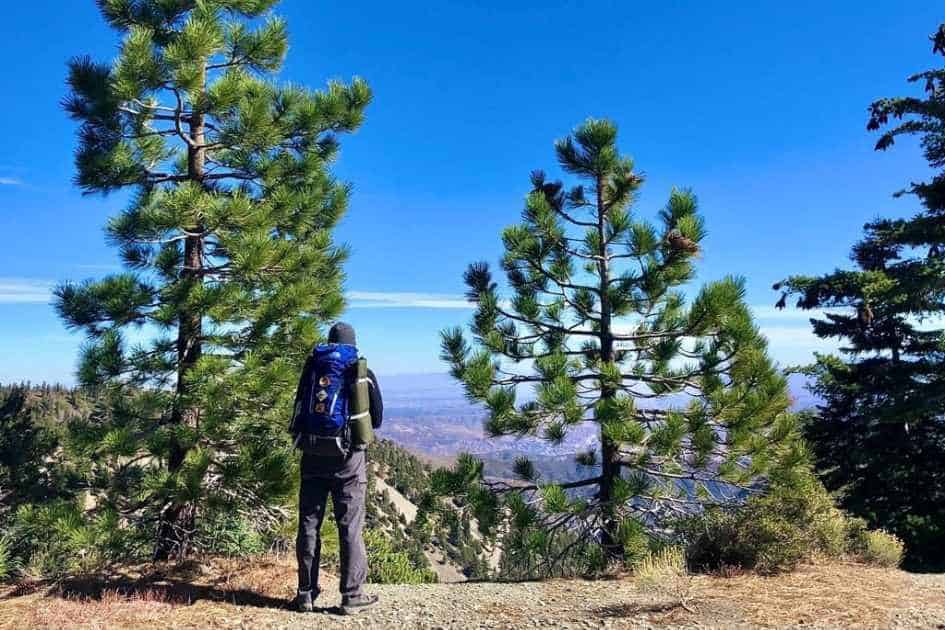
Backpacking vs Camping: Navigating the Differences

Essential Winter Camping Gear: A Comprehensive Guide

Review: RTIC 45 Hard Cooler: Top-Tier Quality for a Low Price

Best Personal Locator Beacons – How to Save Your Life When Hiking

Family Camping Made Easy: Top 10 Camping Hacks With Kids

15 Best Mountaineers Ice Axes (to Get You to the Top)

Ultralight Sleeping Bag Buyer’s Guide: What to Check Before You Buy

Pillows for Camping- Review [Maximize Your Adventure & Sleep]😴
Last update on 2024-05-26 / Affiliate links / Images from Amazon Product Advertising API

All Destinations , Asia , Nepal
Everest base camp trek cost: everything you need to know.

When I returned from my Everest Base Camp trek, I was asked one main question – “what’s the cost of hiking to Everest Base Camp”?
Luckily, I’d taken detailed notes on the trek so I could write this very post!
I hiked to Everest Base Camp with a guide, but I’ve calculated the costs for independent hiking to Everest Base Camp as well.
Here’s my full analysis!
Everest Base Camp costs: the tour
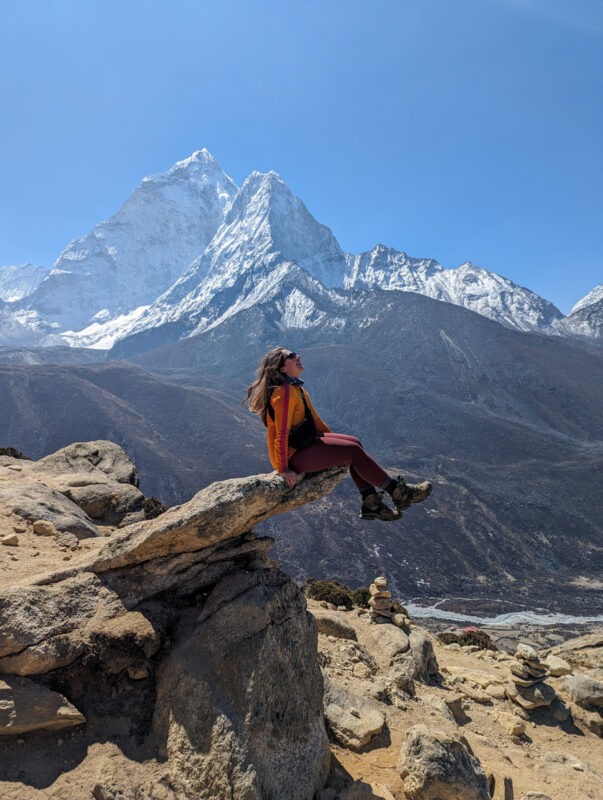
For our Everest Base Camp tour with Nepal Hiking Adventure , I paid £910, or $1,150.
Nepal Hiking Adventures tours generally cost $1,350 but ours was cheaper as we were a large tour with 11 people.
This is cheaper than a third-party provider, like GAdventures or PlotPackers ; largely because when you book third party, that company will need to keep some of the profit too.
Prices with third-party providers range from £1,200 to £1,500.
What tours include

Our tour included the following:
- airport pick up and drop off (they even dropped us back at the airport for free a week later, as we spent some time in Kathmandu after the trek)
- two nights’ accommodation in Kathmandu (night before and night after the hike)
- transfers to Ramechhap Airport
- flights to Lukla Airport
- two guides for all 11 days
- one porter per two people
- all park fees
- all accommodation on the trek
- all meals on the trek
- a duffel bag to use on the trek that we could take home with us
- a commemorative t-shirt and certificate !
What tours DON’T include
Our tour didn’t include the following:
- drinks (including tea, bottled water and alcohol)
- food bought outside the tea houses
- extras like WiFi, hot water bottles, hot showers and toilet roll
Most tours are quite similar to us regarding what they include.
Some include extras like a down jacket, sleeping bag hire or medical kit.
Other expenses

I managed to spend £180 more on the trail on the following things:
- snacks (buy them in Kathmandu, they’re so much cheaper!)
- toilet paper
- having my hot water bottle filled up
- hot showers
- bottled water (although I usually used my water-to-go bottle)
- one cocktail and one gin and tonic at Namche Bazar’s Irish Pub (on the way back down)
- pizza at the Irish Pub
Of course, you could reduce these greatly by being a little more prepared than me and buying your snacks and loo roll in advance . These items are much more expensive the higher up the mountain you go.
Also, while my hot water bottle was lovely , it was an unnecessary expense (everyone else managed without one).
I only had three hot showers , which I would say are quite necessary, although my partner managed on one (free) cold shower and one hot shower.
You will want to pay a bit extra for tea , as it’s warming and helps toward your water intake!
Obviously, WiFi, alcohol and extra pizza aren’t essential, but they are very nice to have.
Tips are something you can’t scrimp on . It’s really important that the porters and guides are recognised for their work, so please do make sure you leave enough cash to tip them! We tipped $100 each , half went to the porters and half to the guides.
How much would it cost independently?
If that all seems a bit expensive to you, of course, you can look at doing an EBC trek independently!
However, I will say that it is much more complicated and less safe. I’m happy that I did the hike with a guide.
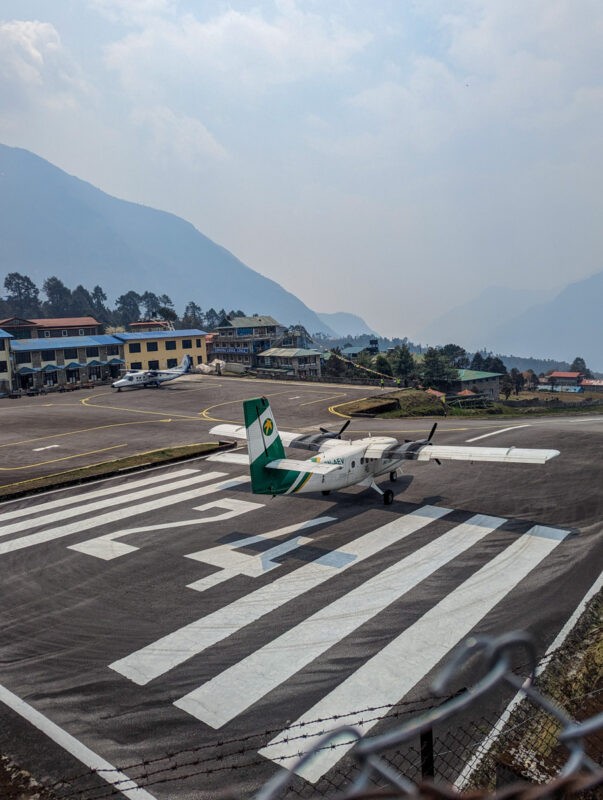
I’ve done a fair amount of research, and I’m still a bit stumped on the best way to book the flight from Ramechhap to Lukla without a guide !
However, a few sources suggests that it should cost $217 (£171.42) each way. So, a total of $434 (£342.90) per person.
You can book these flights online on Get Your Guide in advance ( click here to see ) but they are £50 more expensive each way.
The other alternatives seem to be to try online (on the Sita Air website , it seems that you send a form and they contact you, although there wasn’t an option to fly from Ramechhap here) or buy in Kathmandu.
I don’t doubt that there are plenty of vendors selling flight tickets in Kathmandu , but it’s likely that if you leave it until just before your trek the early flights will be booked up , and afternoon flights are at the mercy of the weather changing.
Getting to Ramechhap and accommodation

You’ll also need to pay for a bus from Kathmandu to Ramechhap (flights depart from here now due to air traffic at Kathmandu Airport).
I can’t find too much information online about this, but long-distance tourist buses in Nepal are usually around $20.
Finally, I’d advise spending a night in Ramechhap before the trek , as it’s a 5-7 hour bus ride from Kathmandu. This means you’ll get a good night’s sleep (and I don’t think tourist buses leave in the middle of the night anyway).
Budget around $25/ £20 per room for this.
Accommodation
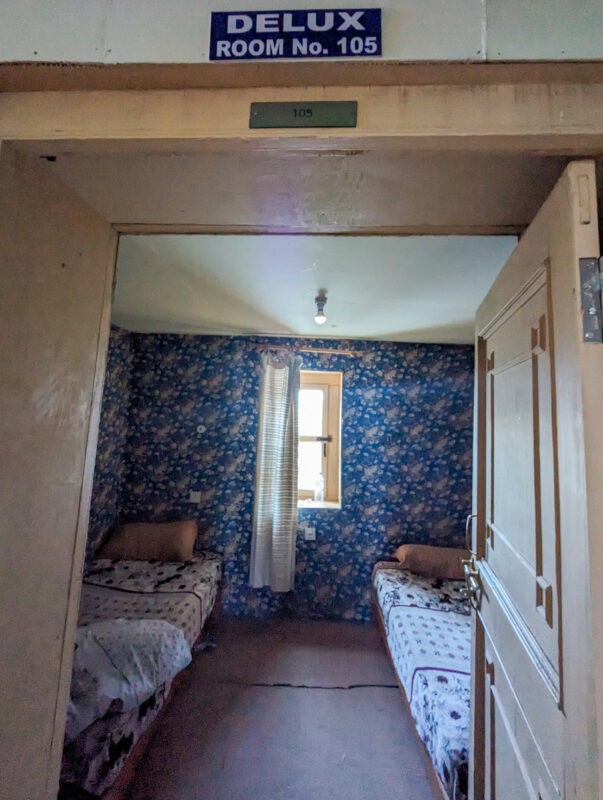
Accommodation varies wildly throughout the hike!
In Lukla, I saw that the room rate at The Nest was 500 NPR (£3)
This can increase to over 1,000 (£6) in tea houses at higher altitudes.
So let’s say it’s an average for 750 NPR (£4.50) per night. For 11 nights, that would be a total of £49.50 per room – if there’s two of you, you can divide this in half.
Obviously, this is very cheap!
BUT there’s a catch – you have to eat there, or they charge an extra rate.
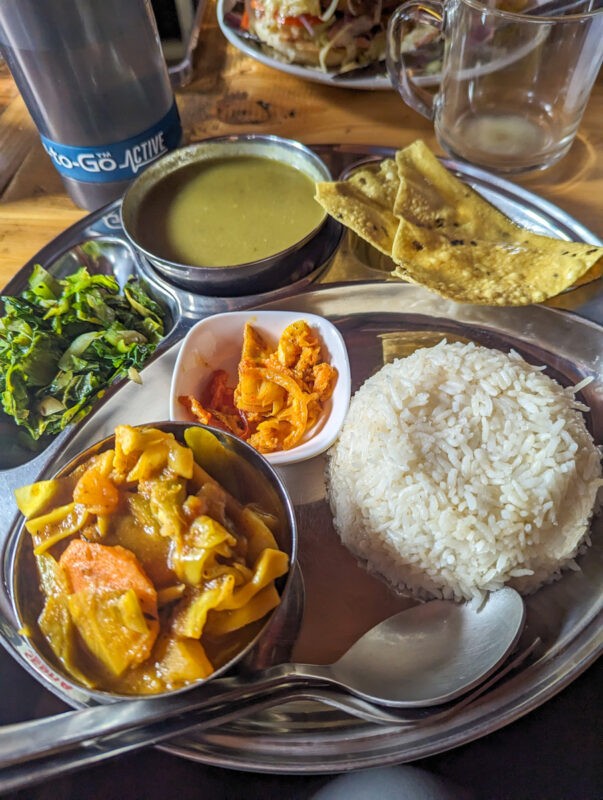
So, what are the Everest Base Camp trek food prices?
Again, these start cheaper and become more expensive as you go up the mountain.
At lower altitudes, meals cost around 700 NPR. Higher up, they were more like 1,000 – 1,200 NPR.
Here’s a potential day of eating around Lobuche, with prices taken from the menu:
- vegetable omelette – 1050
- vegetable fried potatoes – 1200
- dal baht vegetable – 1200
So a total day of eating here would be 3450 NPR, or £20.50 .
Lower down, it might be more like 2,000 NPR, or £12 .
So, considering an average of £16 per day, the total costs for food would be around £176 per person.
Even if you don’t hire a guide, you’re probably going to want to hire a porter .
Porters are incredibly strong and can carry up to 30kg – so generally you’ll hire one for two people.
They generally cost around $25 (£20) per day – of course, if you’re travelling as a couple, you’ll pay half of that per person.
Cost of permits
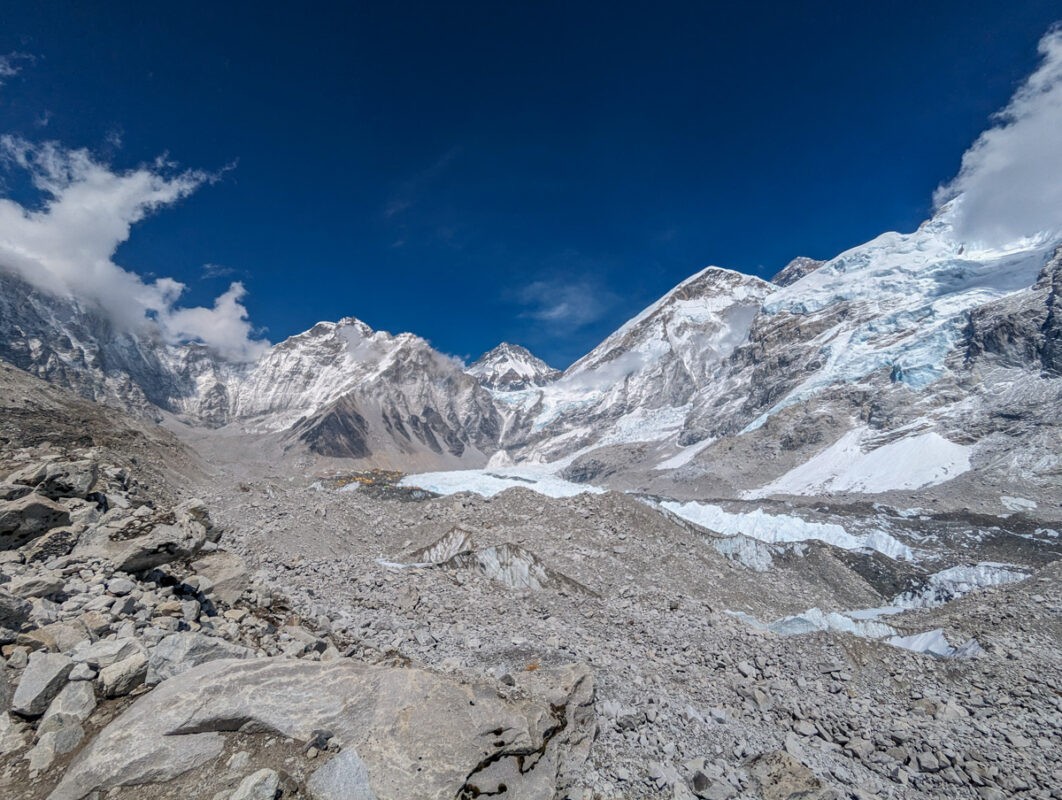
Another aspect that you’ll want to factor in is the cost of permits . These clock in at 5,000 NPR (£30).
You’ll need a local permit (2,000 NPR) , which you purchase in Lukla, and a National Park Permit (3,000 NPR) , which you’ll grab in Monjo.
Costs in Kathmandu
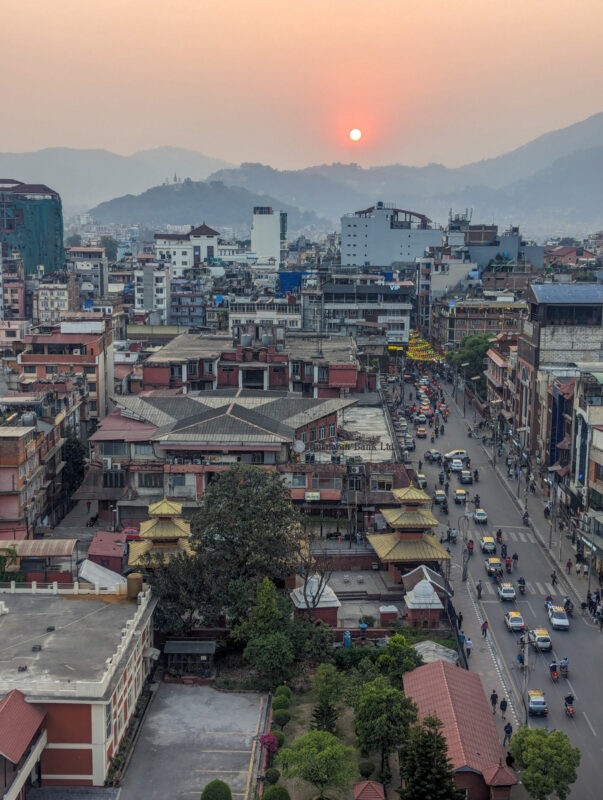
A few costs in Kathmandu that you’ll need to pay if you’re hiking independently include:
Two night’s accommodation
Our tour included two night’s accommodation
We stayed in the Kailash Kutee Hotel , which cost £35 per night.
If there are two of you, this is a total cost of £35 per person for two nights.
Airport transfer
You may be able to barter with a taxi driver to get this lower, but the cheapest we could find an airport transfer was $15 (£11.80).
You’ll need to pay for it both ways, but presuming there are two of you on the trek, the total cost per person is £11.80.
So, what are the costs of hiking Everest Base Camp?

Here’s a table summarising the costs of hiking to EBC.
As you can see, the costs aren’t actually a huge amount different – that’s the benefit of having locals arrange the logistics!
And do remember, if you hike Everest Base Camp without a guide, you’ll be missing out on:
- logistical support with booking flights
- potentially the best earlier flights
- the time saved going straight to your pre-booked tea house – you’ll have to ring them up or walk around independently instead
- answers to any questions before the trek
- assistance if you fall ill on the hike
- guidance while you’re actually doing the hike
- a full itinerary already pre-planned for you!
Plus, going with a tour, especially a local company like Nepal Hiking Adventures, supports the Nepalese economy!
So, is hiking to Everest Base Camp expensive?
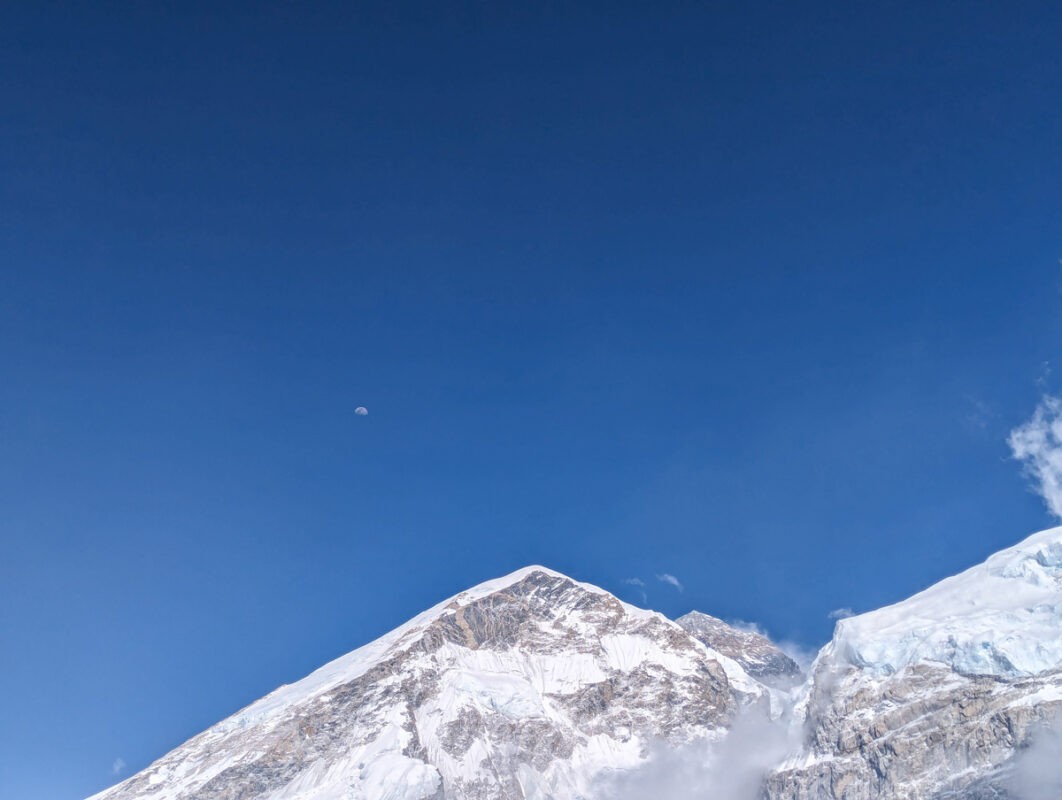
All things considered, hiking to Everest Base Camp costs $1,000 to $1,500 – which isn’t too bad for a bucket list tick !
What do you think? Is hiking to Everest Base Camp cheap or expensive? Let me know over on TikTok , Instagram or YouTube !
- New Zealand
- The Philippines
- The Netherlands
- United Kingdom
- Inspiration
- Overland Itineraries
- Packing Lists
- Travel Tips
- Working Abroad
- Accomodation Guides
- Overland Travel
- Preserving Cultures
- Protecting Animals
- Living Abroad
Atlas & Boots
The UK's most popular outdoor travel blog
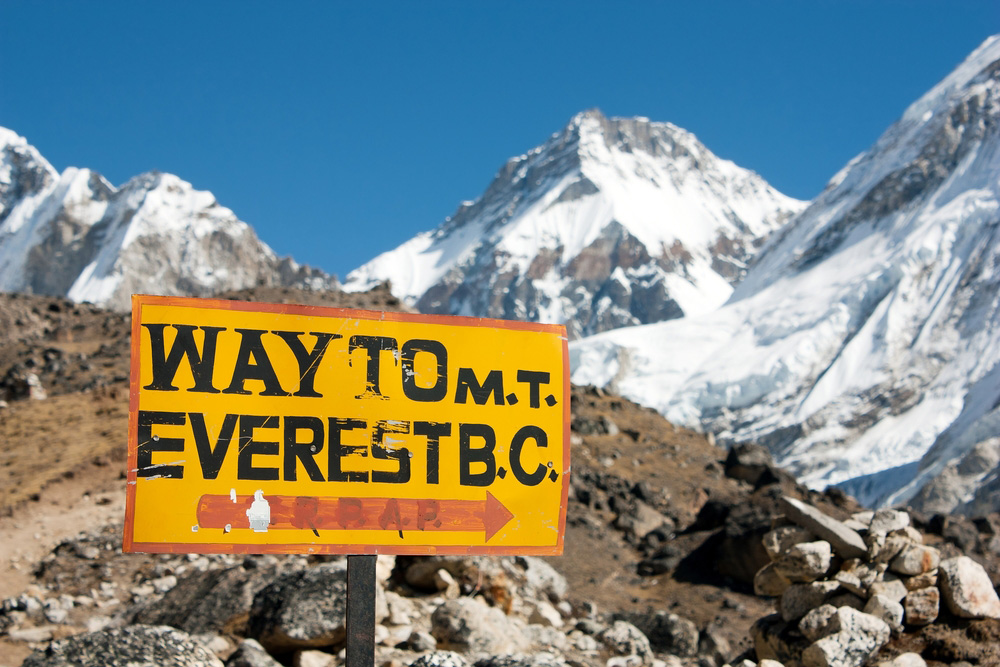
Everest base camp trek tips: 28 things to know before you go
Our Everest base camp trek tips cover everything from permits and teahouses to where to get the best views
I trekked to Everest base camp back in 2019. It was the start of a feverish 24 months of trekking and climbing that took me to the base camps of Earth’s highest and second-highest mountains, across the remote tundra of western Greenland and ultimately to the summit of Aconcagua – the roof of the Americas which, at 6,961m (22,837ft), is the highest peak I’ve ever climbed.
Nepal’s – and perhaps the world’s – best-loved trek is a scenic tour de force. At 8,848m (29,029ft), Mount Everest is the highest mountain in the world. It is one of just 14 eight-thousanders as well as a seven summit . It has captivated intrepid men and women since the first legends of mountaineering made headlines of Everest around the world.
Beyond the epic summits are Sherpa villages, picturesque forests and glacial moraines, all at their best beneath Nepal’s brilliant morning light or blissful evening alpenglow. The route makes use of unparalleled trekking infrastructure with porters and guides taking the heavy loads and cosy teahouses providing soft beds and steaming plates of dal bhat (lentils and rice) along the entire route.
Nepal instantly became one of my favourite countries and I have vowed to return as soon as possible to complete the Annapurna Circuit and Langtang treks. Perhaps one day I’ll go a step further and climb the mountain for real.
Everest base camp trek tips
Given that a few years have passed since my own trek, we asked leading Nepali trekking guides Magical Nepal for their advice on how to get the most from your Everest base camp trek .
Based in Kathmandu, they have a wealth of experience when it comes to trekking throughout the Everest region and the wider Nepali Himalayas as well as Bhutan and Tibet. Together, we have assembled the following list of Everest base camp trek tips you should know before you go.
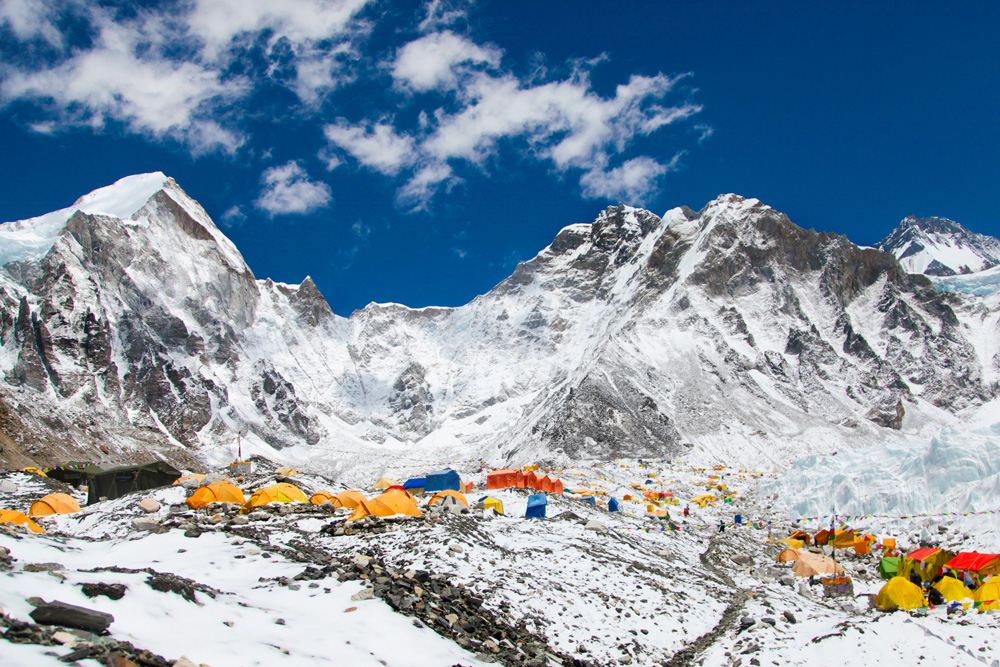
1. At a glance
Duration: 14 days Distance: ~110km Max Altitude: 5,545m (18,192ft) Starts/ends: Lukla Longest day: 19.6 km/7-8 Hours Region: Everest, Sagarmāthā National Park Accommodation: 11 nights in mountain teahouses; two nights in a Kathmandu hotel
2. How long does it take?
An Everest base camp trek typically takes around 14 days which includes 11 days of trekking – although two of these will be acclimatisation/rest days. The trek takes nine days to ascend to base camp and two to descend back to Lukla.
3. How hard is the Everest base camp trek?
On a scale of one to 10, I would say it’s about a six or seven. It is a high-altitude trek, it is for 11 days, you walk for between three and eight hours a day and it can get very cold. It is a challenging trek that shouldn’t be taken lightly.
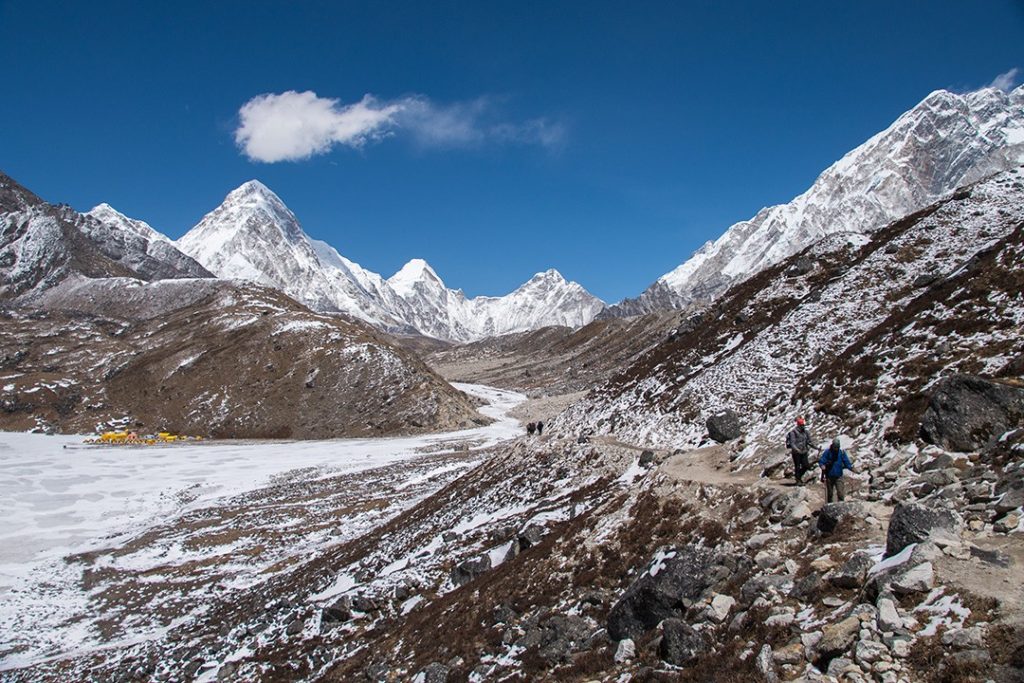
If you have little experience with multi-day trekking or walking at altitude or aren’t particularly fit, then you will find this trek more challenging. A member of our group, a healthy thirty-something man, described it as the hardest thing he’s ever done.
That said, porters carry your heavy gear so your backpack is light, the trail is well-trodden and easy to follow and as long as you take your time and listen to advice, it is a very achievable trek. Every year, over 30,000 people from all walks of life make the trek.
4. How much does it cost and what does it include?
The Everest base camp trek can be booked through Magical Nepal , a Kathmandu-based trekking specialist with a wealth of experience in the region. Prices start from around USD $1,459 for a round trip from Kathmandu and include the following:
- Local transfers for international flights (arrival/departure)
- Local transfers for domestic flights
- Return flight from Kathmandu to Lukla
- Sagarmāthā National Park entry permit and local permits
- Guide for 12 days
- Porters for 11 days
- 2 nights accommodation in a Kathmandu (Bodhi Boutique or similar)
- 11 nights accommodation in mountain teahouses
- 12 breakfasts, 11 lunches and 11 dinners during the trek
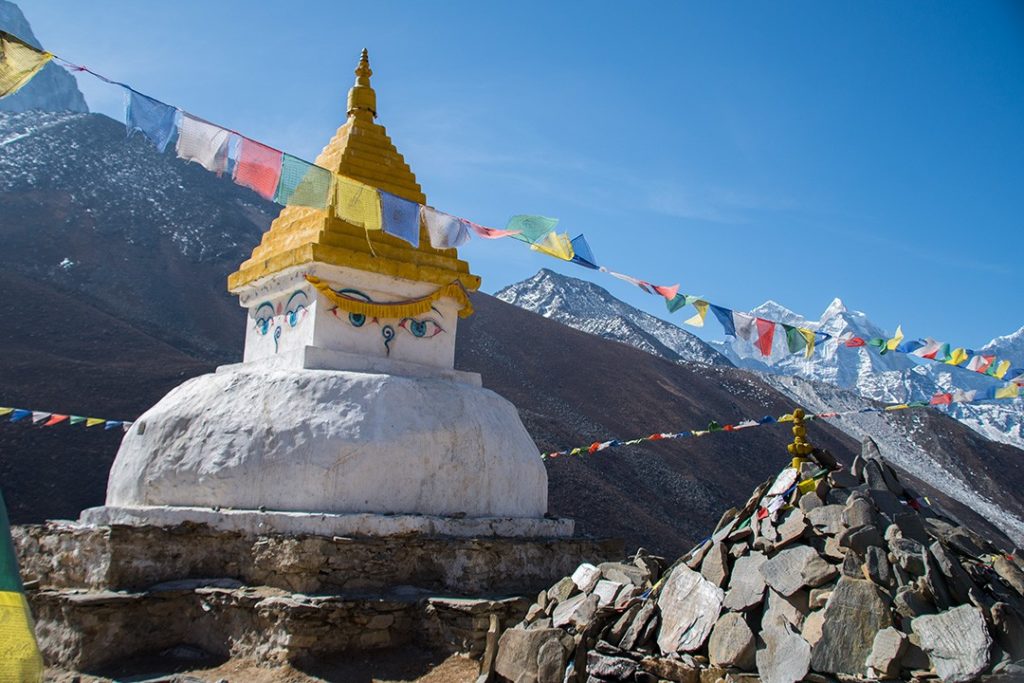
5. How cold does it get?
It depends on the time of year and your location on the trail. The higher you are, the colder it gets. During our trek in early April, it got as cold as -20°C on one night – although most nights were not as cold. The days varied massively. Sometimes we were hiking in shirtsleeves and sweating in the sun while on others we were in cold-weather gear while it snowed.
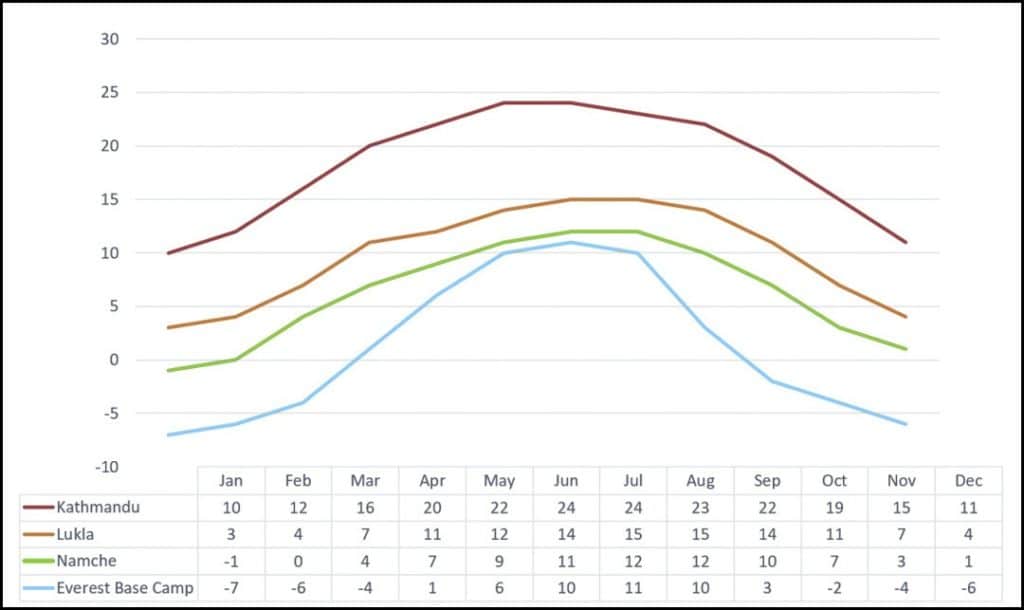
6. When is the best time to trek?
The best time to complete an Everest base camp trek is in autumn (late Sep-Nov). Days are generally dry and clear although there can be the odd shower or storm. This is also peak season so trails are at their busiest.
Another excellent time to trek is during the warmer and quieter spring (Mar-May), which is when I went (early April). This is also the time when the colourful rhododendrons bloom, generally between 2,000m and 3,000m. The drawback is that the dry weather brings dust which leads to hazier days.
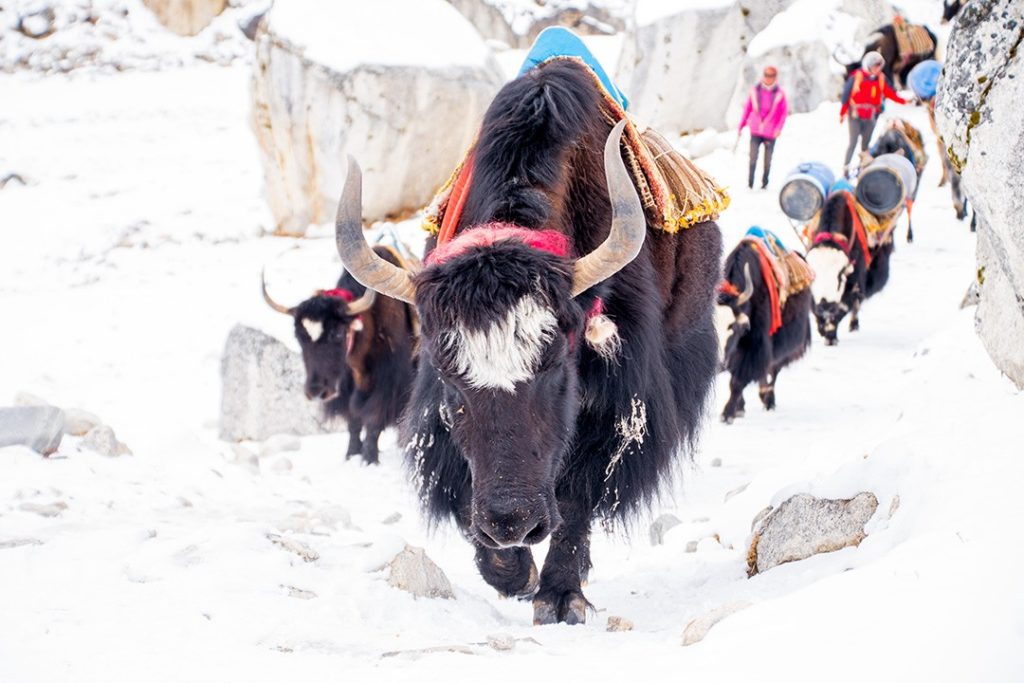
Dec-Feb are good months for trekking, but they are also the coldest and reaching base camp can be a real endurance test. The monsoons arrive in earnest from Jun-Sep, swelling rivers to breaking point, bringing hordes of leeches and making the trail very muddy. Many teahouses will close during these months.
7. Is there snow at Everest base camp?
Absolutely. It’s the base of the highest mountain in the world! It will of course depend on the weather and the time of year, but you should expect to find snow at base camp throughout the year.
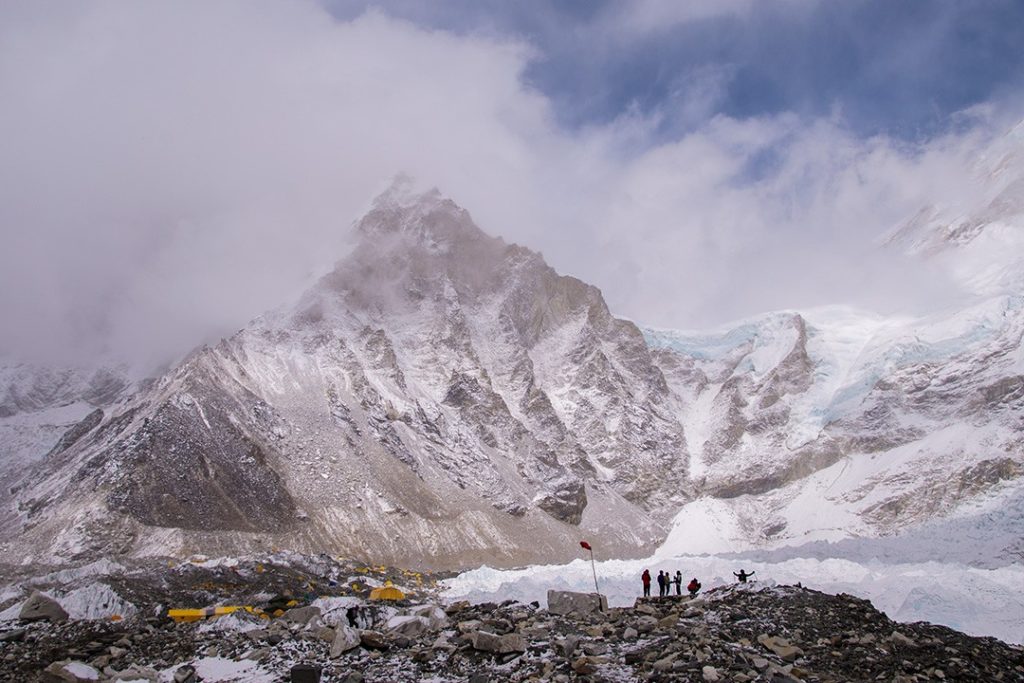
8. What should I pack?
I’ve put together a complete Everest base camp kit list . It contains everything I took with me including clothing, trekking gear, toiletries, medication, electronics and documentation.
9. Can I buy trekking gear and clothes locally?
It is possible to buy (or hire) most items on my Everest base camp kit list on arrival in Nepal. However, I wouldn’t advise leaving it that late and quality can’t always be guaranteed.
Kathmandu does have a host of outdoor shops selling much of what you’re likely to need. There is a collection of imported gear shops – with comparable prices to those in the west – spread along Tridevi Marg near Thamel.
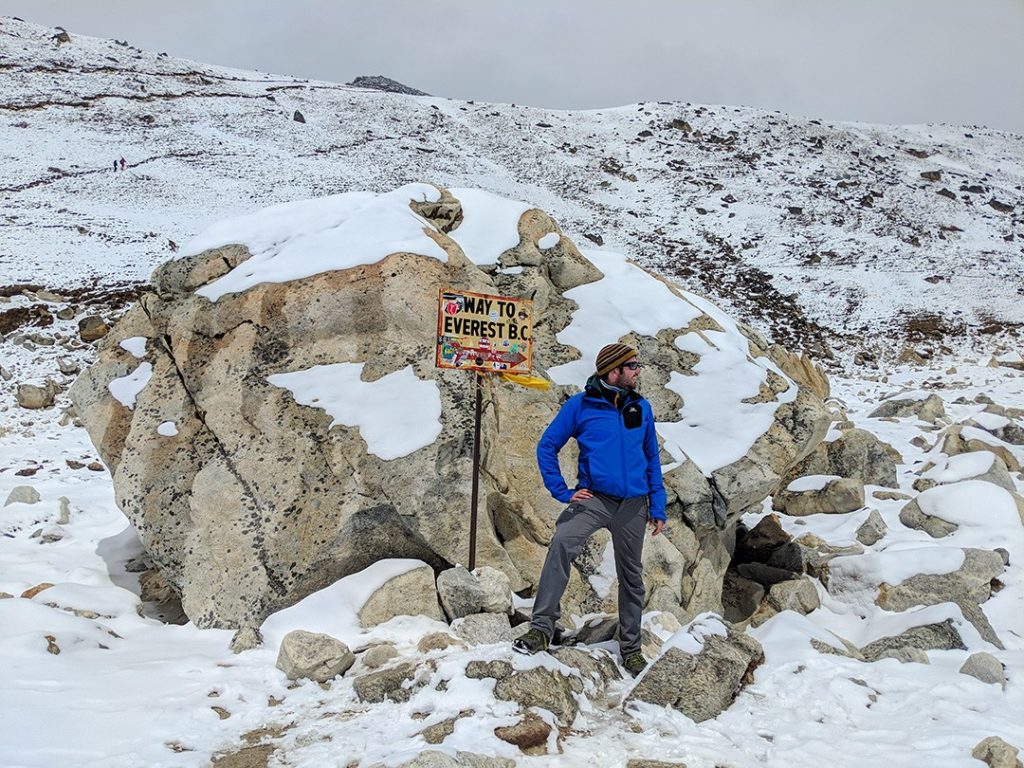
On the trail, Namche Bazaar has some excellent equipment shops including both international ( Sherpa , The North Face ) and local outdoor gear shops as well as countless souvenir shops. There is also a limited assortment of shops and pharmacies in Lukla and other trailside villages en route.
Again, in Kathmandu, it’s possible to hire many items such as sleeping bags and down jackets. Trekkers should always bring their own walking boots and shoes, which should be thoroughly worn in beforehand.
10. What are the weight limits on the flight?
There are strict weight limits on the domestic flight from Kathmandu to Lukla. The flight only allows for 10kg of checked luggage and 5kg of hand luggage. This coincides with the maximum weight porters are allowed to carry: 10kg per trekker with a maximum of two trekkers per porter.
Luggage can be stored securely at your hotel in Kathmandu, but you will need to take all your trekking gear with you. In our Kathmandu hotel, Fuji , there were some luggage scales available for guests to use.
11. What is the flight to Lukla like?
Thrilling! The morning flight to Lukla is spectacular in its own right, with the landing an exciting way to begin the trek. One end of the runway at Tenzing-Hillary Airport in Lukla is 60m (197ft) higher than the other.
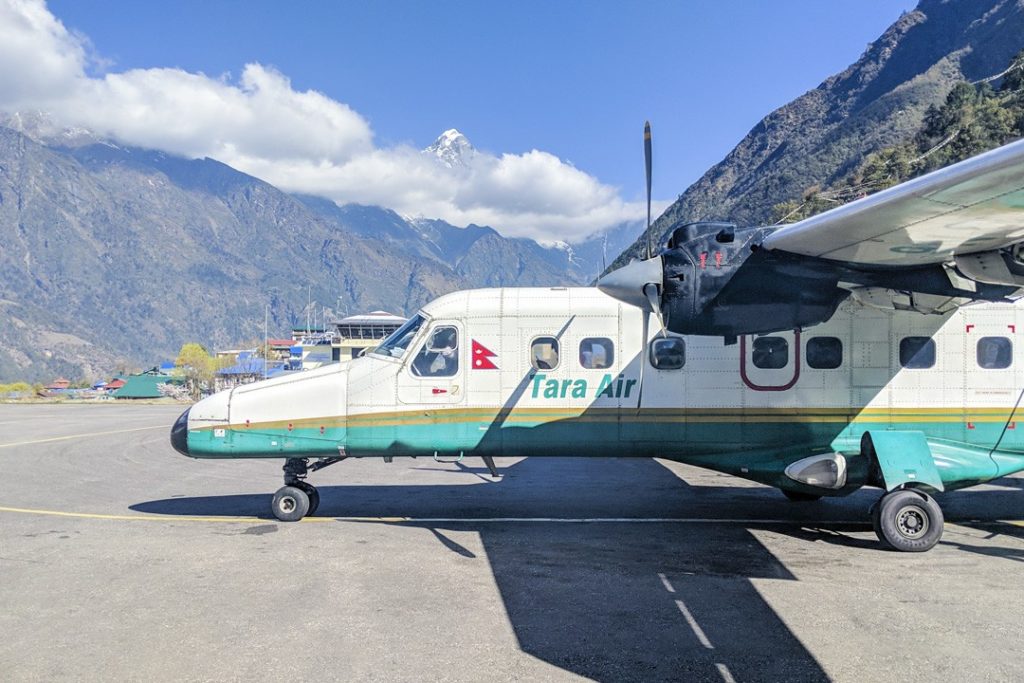
The journey to Lukla takes around 25 minutes by small propeller planes – either Dornier Do 228s or Twin Otters – that seat only 15 to 19 passengers. Spectacular views of the foothills of the Himalayas are on offer, but the weather tends to deteriorate in the afternoon.
If you suffer from travel sickness, I would advise taking some medication. At least one member of our group wished they had! Airsickness bags are provided on the flight.
12. How much should I tip guides and porters?
Tipping when travelling can be a bit of a quagmire, but the guides and porters on the trek deserve every penny they earn and then some. We suggest the following when it comes to tipping local support staff.
- For the head guide between $20-30 USD per client, per week.
- For porters during the trek $4-7bUSD per group, per day.
- For drivers and local guides $1-$2 USD per client, per day.
We had a head guide, assistant guide and five porters supporting our group of 11 clients. Our guide and assistant guide were with us for 15 days and the porters for 12 days.
We each contributed around $150 USD to the tip fund which was divvied up as follows:
- Head guide: $60 x 11 = $660
- Assistant guide: $30 x 11 = $330
- Porters: $60 x 11 = $660 / 5 porters = $132 each
We also collected a few dollars each for our head porter as he was particularly helpful and even invited us to his wife’s teahouse during the descent for snacks and tea.
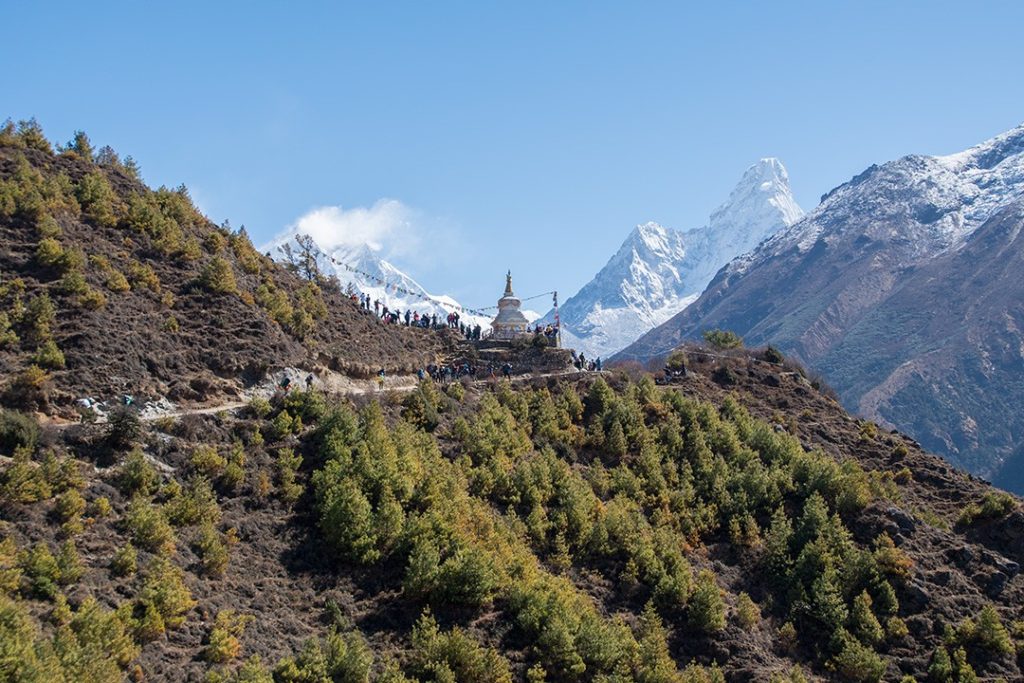
13. Can I charge my phone and camera on the trail?
It is possible to charge appliances at teahouses, but this usually incurs a charge starting from 100 NPR ($1 USD) at lower altitudes and rising to 500 NPR ($5 USD) higher up the trail. Some teahouses charge more for charging a powerbank or camera. I think the most I heard someone paying was 700 NPR ($7 USD) for a large powerbank.
Some cafes on the trail will allow you to charge a device for free if you’re buying a meal or drink.
14. Is there wifi available?
Wifi is available at many villages along the trail. However, these are some of the most remote villages in the world so connection is often interrupted or very slow – particularly when groups of trekkers arrive at the same time and all connect simultaneously!
Again, wifi costs increase as you ascend. Generally, at lower levels, it starts from around 100 NPR ($1 USD) to connect at a teahouse overnight and increases as you get higher.
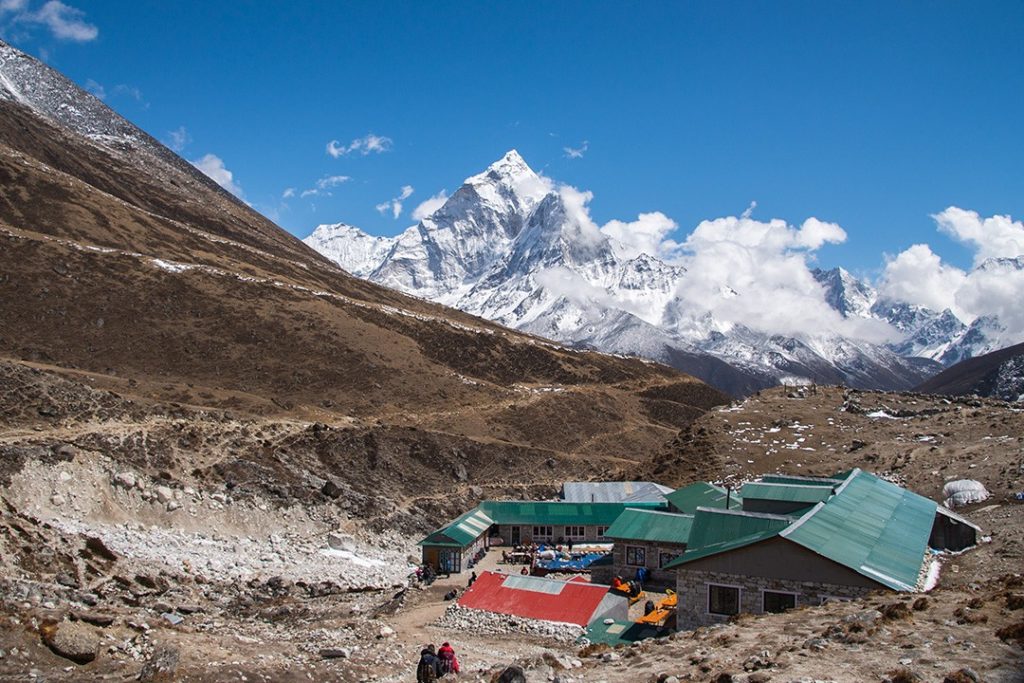
The most reliable connections are the Everest Link hotspots available at most of the villages. These prepaid cards are available in 10GB and 20GB for 1,999 NPR ($20 USD) and 2,999 NPR ($30 USD) packages and last for 30 days. Cards can be bought in Kathmandu, Lukla, Namche Bazaar and in some of the smaller villages.
15. Is there phone reception?
Phone reception is of course intermittent, but there is reception at the lower villages. I made the mistake of buying a Nepal Telecom ‘Namaste’ SIM card at the airport on arrival. However, this didn’t have reception from Namche Bazaar onwards. The Ncell networ k , which my guide and some other trekkers had, appeared to have better reception further up the trail and my guide recommended them.
Both providers have outlets at the airport and throughout the country and offer a range of data packages. You’ll need a copy of your passport and a photo to obtain a SIM card.
Another option is to get a Holafly eSIM for Nepal so you can stay connected to the internet on your trip. We can offer our readers 5% off Holafly purchases. Simply use the code ATLASANDBOOTS at checkout.
16. Is it safe to drink the water?
Yes, it is safe to drink water as long as you use purification tablets. Nearly all teahouses and restaurants can provide drinking water free of charge. Only at Gorakshep (the last stop before base camp) was it necessary to buy bottled water, as there is not a natural spring nearby.
Otherwise, do not buy bottled water or bottled soft drinks on the trail. Plastic bottles are difficult to dispose of and have become a serious environmental problem.
17. What is the food like?
The food is actually pretty good along the trail. For lunch and dinner, every teahouse serves the traditional Nepali Dal Bhat (rice and lentils) as well as a variety of meals such as rice, vegetables, noodles, potatoes and soup along with Nepali versions of western food such as pizza, pasta, sandwiches and veggie burgers.
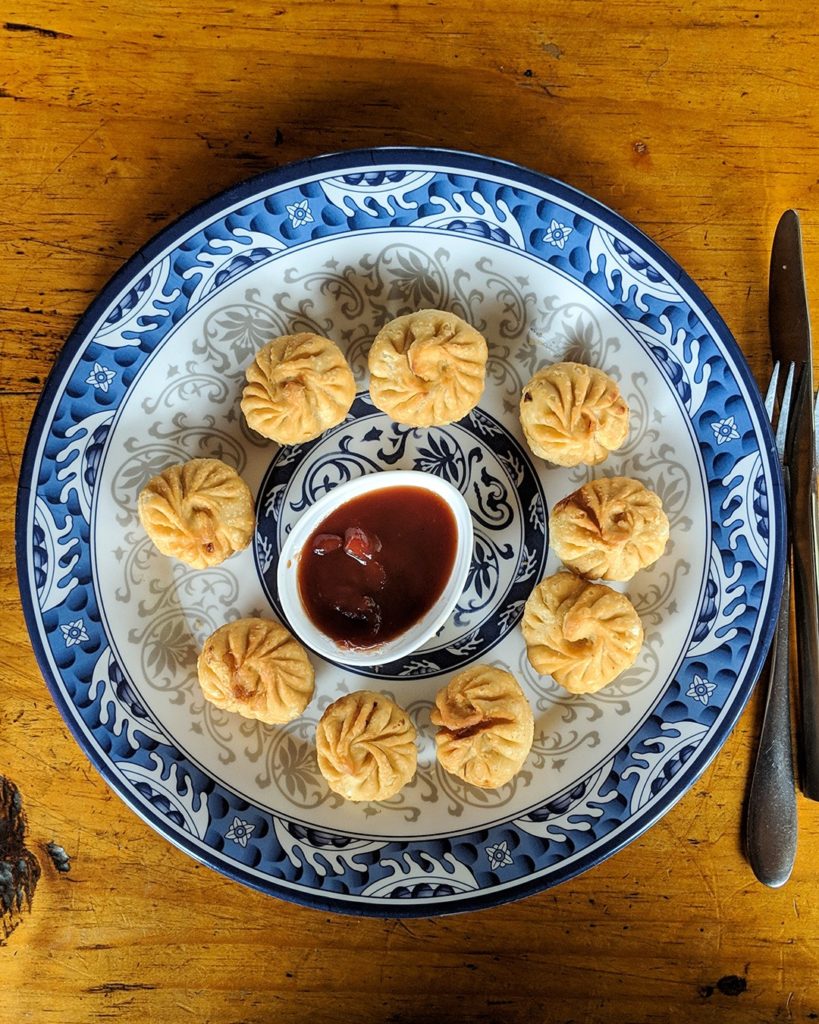
The food on the trail was tasty and varied
Breakfast is usually a choice of porridge, various styles of eggs, toast, pancakes or the delicious (but sweet) Tibetan bread.
Do not eat meat along the trail, particularly higher up, as it has to be flown into Lukla and then transferred up the trail. Additionally, refrigeration cannot be relied upon.
Regardless, it’s much better to stick to a carb-heavy vegetarian diet as it’s just what you need on a long high-altitude trek such as this.
18. How much do meals cost?
I found I was spending around $20-30 USD per day on food, hot drinks and snacks – and that often included a fee for charging a device, a hot shower or wifi.
However, if joining an organised trek, all meals along the trail are usually included in the price so you only have to pay for your meals in Kathmandu.
If you’re travelling independently, allow for between $400-600 USD in total for meals along the trail. The cost of food and drinks gets more expensive the higher you trek.
19. Can I take a shower during the Everest base camp trek?
There are some hot showers at teahouses on the trail at an additional cost ($3-5 USD). I took two hot showers during the trek. The rest of the time I just had cold-water washes.
Only have showers at teahouses with solar heaters. Don’t use water heated by wood, as a lack of firewood in villages is a big environmental concern in Nepal. Your guide will be able to advise you.
20. Is the Everest base camp trek dangerous?
All high-altitude treks involve a certain degree of risk. However, if you follow these Everest base camp trek tips, along with the advice of your guide and adhere to the set acclimatisation itinerary, then most healthy people will complete the trek without any serious issues.
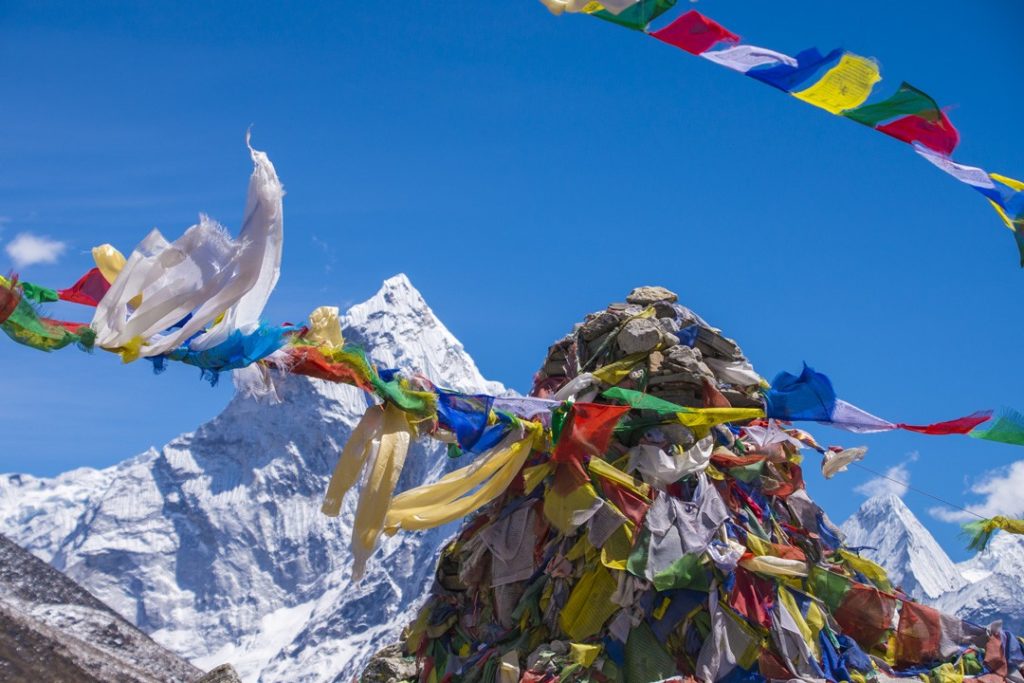
The important thing with high-altitude trekking is to not rush, go at your pace and listen to your body. Read our detailed guide on how to identify, treat and prevent altitude sickness symptoms .
21. Should I take Diamox?
This is very much down to the individual. I didn’t take Diamox, but I have been up to this altitude several times before so knew what to expect. However, I did have some with me in case I felt bad at the higher altitudes.
The best advice I can give is what trekking guides have told me in the past. Have some Diamox with you and take it as soon as you start to feel the pulsing headaches that are synonymous with altitude sickness . He said it’s good to have some available at the higher altitudes – particularly at Gorakshep where you sleep at 5,300m – so you can use it to help you get a good night’s sleep.
22. Do I need sunscreen?
Yes! Despite the cold, the sun is intense. Make sure you wear sunscreen with an SPF of at least 40, lip balm with SPF protection, sunglasses and a sunhat.
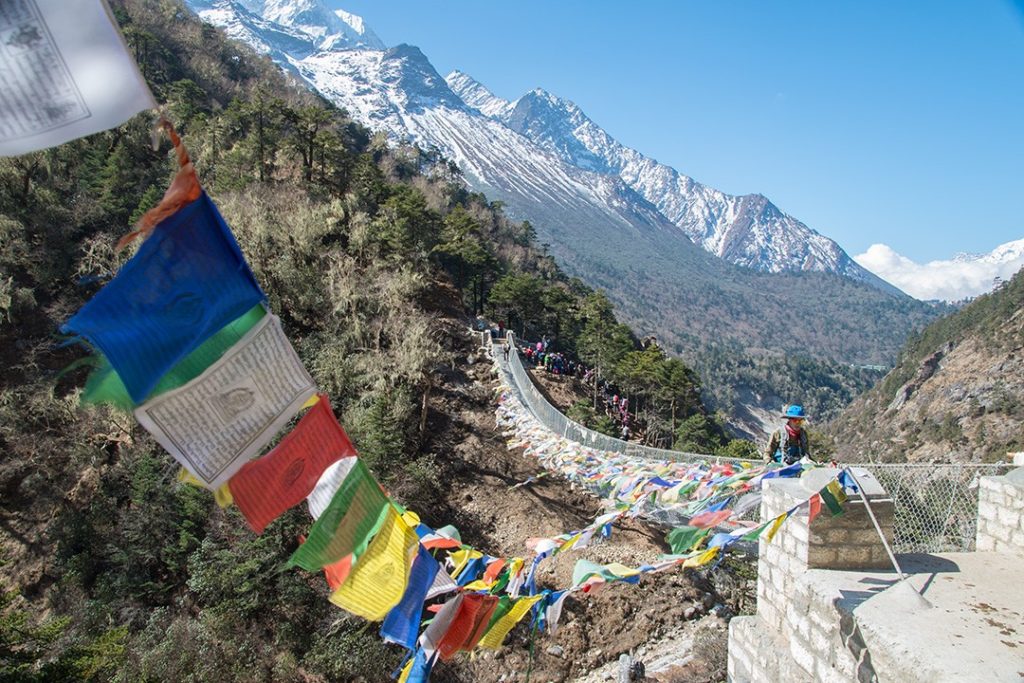
23. What sort of travel insurance do I need?
One of the most important Everest base camp trek tips is to make sure you select a travel insurance policy that has sufficient medical coverage. It must have a minimum coverage of $200,000 USD for repatriation and emergency rescue. Make sure you check how your policy covers ‘dangerous activities’ such as trekking at altitude and mountaineering.
It must cover the possibility of a helicopter evacuation for trekkers and general medical evacuation to Bangkok or Delhi, which alone can cost $40,000 USD.
24. Do I need a trekking permit?
To trek to Everest base camp you must enter Sagarmāthā National Park where you will need to pay a national-park fee. For foreigners, not from a South Asian Association for Regional Cooperation (SAARC) country, the fee is 3,000 NPR ($30 USD) per person. A full list of park entry fees in Nepal can be found here .
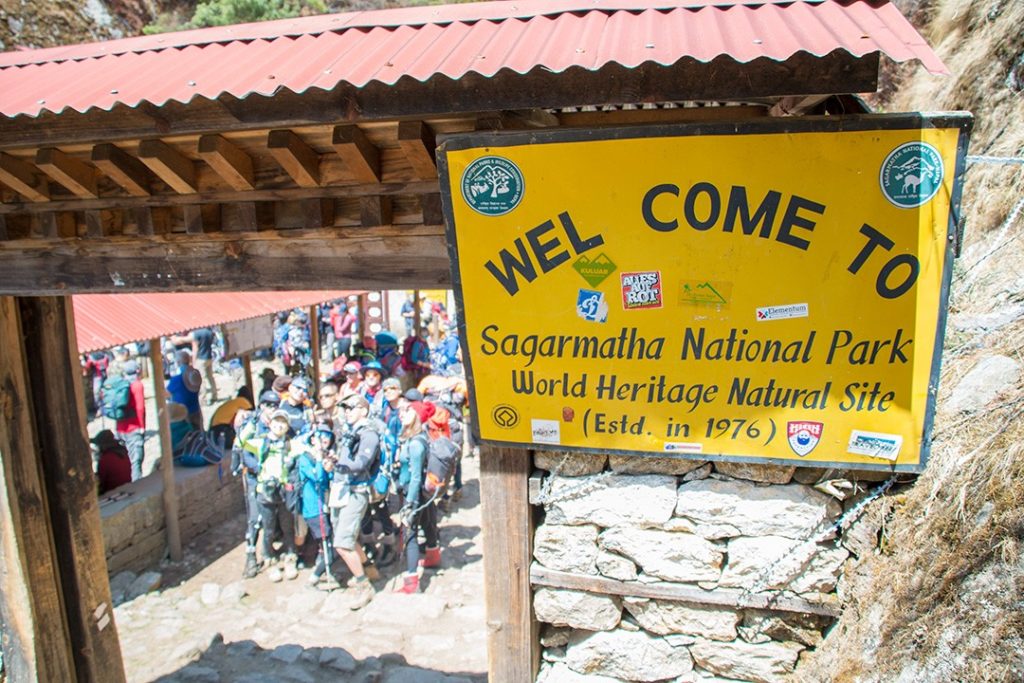
If you’re joining an organised trek, the fee should be included in the trip cost.
25. Are the teahouses warm?
There is usually a large dining room-cum-lounge with a stove in the centre where trekkers hang out in the evenings. The stove is usually lit in the early evening so the room gets pretty cosy.
However, the bedrooms remain chilly, to say the least. A blanket is often supplied which, combined with your sleeping bag, means you should be warm enough once safely cocooned in your bedding. The cold certainly never stopped me from getting a good night’s rest.
26. Can I drink alcohol along the trail?
There are teahouses, restaurants and even bars in the villages along the trail that serve alcohol. However, I wouldn’t recommend drinking any alcohol until you’re on your way down.
Some members of our group drank alcohol on the way up and they all suffered for it. On the way down you’ll be accustomed to the altitude and in a far better state to enjoy a snifter or two.
Furthermore, drinking higher up the trail just encourages demand. All those cans of beer you don’t need have to be carried on the backs of porters and yaks.
27. Can I see Everest from base camp?
Yes, although because of the angle it is somewhat obscured by Lhotse, Nuptse, the West Shoulder and the South Col. The best views of the Everest massif and the Khumbu Icefall are from the nearby summit of Kala Patthar.
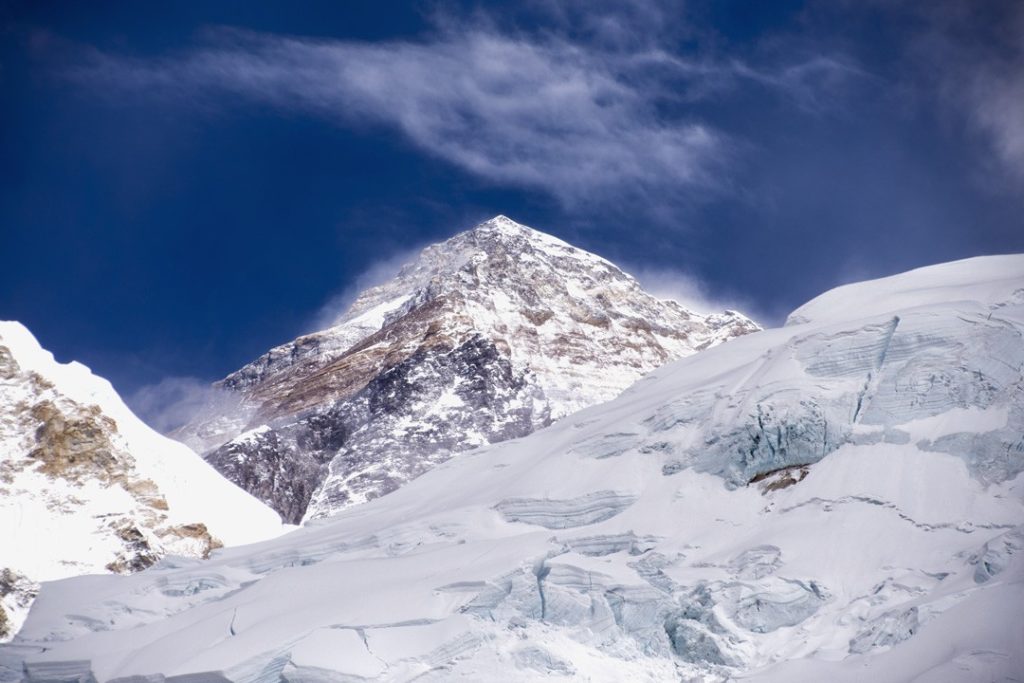
On my trek, no one fancied the optional early morning hike up Kala Patthar, so I dragged myself out of bed and headed off alone. I didn’t have enough time to make it to the summit, but I got as high as the plateau which still offered some excellent views. The wind was lashing and it was ferociously cold, but I do regret not getting up a bit earlier and making the full ascent.
28. Is the Everest base camp trek worth it?
Without a doubt, yes.
After over 100km of high-altitude trekking amid soaring peaks, Sherpa villages, picturesque forests and glacial moraine concluding at the foot of the world’s highest mountain, I can safely say the experience was everything I hoped it to be.
Enjoyed this post? pin it for later…
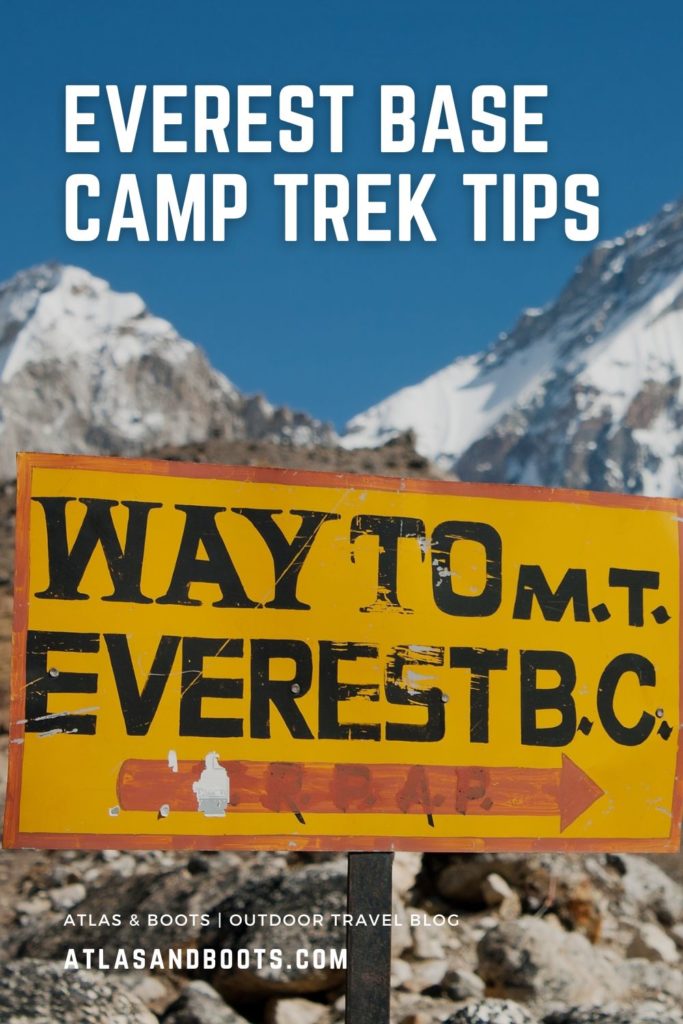
Lead image: Daniel Prudek/Shutterstock
You might also like:.
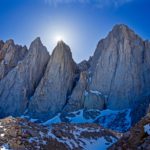

- How To Book
- Everest Region Trek
- Budget Everest Base Camp Trek
Budget Everest Base Camp Trek - 14 Days (Product Id : 121)
- Local based company.
- 100% Financial Security.
- Personal Care & Attention.
- We are always available - 24/7.
- Fastest response time.
- 24/7 On-Ground Support in Nepal
- Best Price Guarantee
- No Hidden Cost

Quick Enquiry

Before Booking
- Travel Insurance
- How To Get Into Nepal
- Terms & Condition
Our Guarantee
- Guaranteed Departure
- The best and the fair price
- Experienced Guides/Sherpas/Team Leaders
- 24 x 7 Support
Detail Itinerary
- Cost Details
- Our Guarantee/Special
Budget Everest Base Camp Trek Overview
Activities : Trekking
Best Month : March-May/ September -December
Transportation : Private Car & flight
Accommodation : Deluxe Boutique Hotel in Kathmandu & Lodge on a trek with 5 nights attached toilet (Hot shower)
Max Elevation : 5550m/18,204ft at Kalapatthar
Meal : Breakfast and 2 dinner in Kathmandu & all meals on a trek
Trip Route : Kathmandu-Lukla-Namche-Dingboche-Lobuche-Gorekshep-Everest Base Camp/Kalapatthar-Namche-Lukla-Kathmandu
The Everest Base Camp trek is an extremely popular and famous trail. People from all over the world come here to be absorbed in this exotic corner of the world, to be placed in awe of the magnificent Mt Everest and its sibling mountain ranges. Trekking to Everest Base Camp takes you to the Base Camp (5,320m/17,450ft) of the highest mountain in the world- Mt. Everest (8,848m/29,021ft).
The Everest Base Camp trek is an incredible experience of a lifetime and is one of the most sought-after trekking destinations in the world. Everest region trekking is well known for its spectacular Himalayan scenery and the interesting cultures and lifestyles of its inhabitants (Sherpas), including their richest culture and tradition. In the meantime, you can explore Sherpa museums and famous Buddhist monasteries along the route. The trail gives you perfect views of beautiful peaks, Rocky Mountains, valleys, and Sherpa villages, giving the trekker a glance into their daily life.
Mt. Everest Base Camp is a glacier moraine that does not offer views of Mount Everest itself but has great views of the Khumbu ice fall and the surrounding mountains. Another highlight of trekking to Mount Everest is the hike to Kalapathar (Black Rock), which has the most dramatic view of Mt. Everest, Pumari, Nuptse, and many more peaks. It has breathtaking sights for tourists of the Khumbu Himalaya region; the views of the valleys and glaciers are spectacular. The Everest base camp hike begins with a scenic flight from Kathmandu to Lukla and leads through to the Dudh Koshi valley through several Sherpa villages.
The powerfully spiritual prayer rocks and daunting suspension bridges are but a few of the numerous occasions you'll find yourself snapping pictures. Children in the local villages will often rush over to make you stop and say the classic Nepali greeting "Namaste". The beginning phase of the Everest walk is culturally beautiful and allows you to meet the local people; you will certainly experience their warm hospitality.
Special Notice: Due to unpredictable weather conditions in the Himalayas, there may be unforeseen schedule changes in domestic flights to Lukla and from Lukla. The flights may be delayed for several hours or pushed back by a day or more, depending on the circumstances. Although this is rare, it can happen even during the best trekking seasons. As you know, high-altitude weather conditions can be difficult to predict. Therefore, we strongly suggest that you plan for this by allowing for an extra day or two in Nepal after your trek, if possible. This will help ensure that you have some flexibility about your trek. On the other hand, if everything goes according to plan, you will have time to enjoy other activities such as rafting, wildlife viewing, shopping, or just relaxing after your adventure.
Outline Itinerary
Day 01: Arrival day in Kathmandu
Day 02: Drive to Ramechhap around 1 am and Fly to Lukla and Trek to Phakding
Day 03: Phakding to Namche Bazzar (3440m/11,283ft)/ 5-6 hours walk
Day 04: Acclimation day
Day 05: Namche to Tengboche (3,867m/12684ft)/ 5 hours walk
Day 06: Tengboche to Dingboche (4,358m/14,295 ft)/ 5-6 hours walk
Day 07: Acclimation Day
Day 08: Dingboche to Lobuche(4,928m/16164 ft)/ 5 hours walk
Day 09: Lobuche to Gorak Shep-Everest Base Camp-Gorak Shep (5,320m/17,450ft EBC )/ (5,160m/16,929ft Gorekshep )/ 7-8 hours walk
Day 10: Gorekshep to Kala Pattar - Pheriche (5550m/18,204ft Kalapatthar)/ (4,358m/14,295 ft. Pheriche)/ 7-8 hours
Day 11: Pheriche to Namche Bazaar (3440m/11,283ft)/ 7-8 hours
Day 12: Namche Bazzar to Lukla (2,652m/8,700ft)/ 7-8 hours
Day 13: Lukla to Kathmandu (1,300m/4,264 ft)/ 35 minutes scenic flight
Day 14: Final departure
AME Trek representative would pick you up as per your arrival instructions from the airport and transfer you to the hotel in Thamel. If your flight is during the day our official manager would greet you at the hotel and instruct you further program as per our itinerary. At the same evening we would take you for our official welcome dinner at typical Nepalese restaurant where you can enjoy cultural ethnic dance and music. If you arrive late our guide would explain you and let you know your flight timing to Lukla so that you can prepare accordingly. Overnight at the hotel.
As per flight timing our official trek guide would come to the hotel to pick you up(Around 1 am during peak season) and take you to the domestic airport. Our guide would do all check-in formalities, and at the same time, you can enjoy mountain photos at the airport. Once you get into the aircraft our guide will let you know which side seats offer the best views, accordingly you get upfront and enjoy the views from the aircraft. Once you get into the Lukla come to the airport to help you and take you to the restaurant where you have your first breakfast in the mountain. In the meantime, our Sherpa would manage bags to carry. It is short and a kind of easy walk to Khakding today which offers many great views of snowcapped mountains and Tibetan pray flags as well as Tibetan pray rocks. Overnight at the lodge at Phakding.
After a hot breakfast at your lodge, the trail leads towards a suspension bridge followed by an easy uphill to Monju, where Sagarmath National Park begins. After brief National Park entrance formalities, you will drop down to a river, cross another suspension bridge, and continue walking to the high Hilary Bridge at the bottom of the hill. After the bridge, the trail leads uphill to the Namche Bazzar. On the way you will have a great view of Mt. Everest, Mt. Lhotse, Mt. Kusum Khangru and more within the beautiful valley. You will stay overnight at the Lodge.
Today you can explore the museum or visit Khumjung village and Khongde village where you can enjoy more views of Mt. Everest and the surroundings peaks while experiencing Sherpa culture. You can also visit Thame, which is an old Sherpa village. The remainder of the day may be spent exploring Namche Bazzar, where you can use the internet, visit the National Park head office or browse Museums and monasteries as per your interest and time. You will stay overnight at Namche.
After breakfast at the lodge at Namche, the trail leads up towards a ridge and an easy walk to Kyamjuma, then descends slightly to Dudhkoshi at 3250m. After that, a steep ascent will bring you to the famous Tengboche monastery, with its picturesque background of Ama Dablam, Mt. Everest, and other peaks. You will stay overnight at the lodge.
Today we'll beign with a half an hour hike down to a riverside and though a lush forest, heading across the river before making a gradual climb up to the valley's highest year-round settlement, Pangboche (3,860m/12,664ft). We'll continue ascending in the afternoon through alpine meadows and yak herds, eventually reaching Dingboche. There we will have an overnight stay at the lodge.
Today we will again take time to acclimate ourselves at Dingboche, this being the second acclimatization day of our trip. You may hike up to Chhukung towards Island Peak, explore Dingboche Valley, hike up to Chhukung Ri, or relax. Overnight at Dingboche.
After breakfast at the lodge, the trail leads through a valley and goes to the bottom of a hill where an uphill trek begins to get to Dugla. After that, the trail continues to climb up to a ridge where you might see memorials dedicated to a Sherpa who died on the glacier of Mount Everest. The trail then gently climbs up to Lobuche for overnight
The trail continues to climb upwards towards Gorak Shep, where you will check in at the Mt. lodge, have lunch and start your hike to EBC. Today you will finally reach Everest Base Camp (5,357m/17,575ft) by walking through rocky and glacial trails, a walk that is arguably the most wonderful and renowned part of this trek. After visiting the Everest Base Camp, you will return to Gorak Shep (5,160m/16,929ft) for an overnight stay.
Early in the morning, your leader will wake you up and you will begin a dark climb up to Kala Pattar. It takes a couple of hours to walk up to the famous viewing point of Kala Pattar (Black Rock) at 5,545m/18,192ft; this small peak offers the best views of Mt. Everest, Nuptse, Lotse, Pumori and Ama Dablam. The views are golden along with the sunrise before they revert back to their original colors of blanketed white snow. Enjoy the sunrise over Everest as long as you want, then hike back to Gorekshep, have breakfast and double back to Pheriche for an overnight stay.
After a hot breakfast at the lodge, the trail takes an easy downhill drop through a dry valley before reaching Pangboche village. The trail then drops to a riverside and crosses a bridge, continuing up through the pine and juniper forest to Tengboche. The trail descends to the Dudhkoshi River and continues up to Kyungjuna. Finally an easy walk leads you to the Namche Bazaar for overnight stay where you will have access to nice hot showers, which will be quite nice after a few days of having no showers. You will stay overnight at the lodge.
After breakfast at the lodge, the trail heads downhill through a pine forest until reaching a bridge leading to Monju. There will be some formalities at the check post of the National Park at Monju, followed by continued walking to Phakding for the lunch. After that, your last day of the trek ends where you began in Lukla. You will stay overnight at the lodge.
Flights are usually in the morning due to the weather. Your guide will have completed all airport formalities by the time you have finished breakfast at the lodge. Your luggage will be taken to the airport with the help of our Sherpas and porters. Once your guide get news about your flights arrival at Lukla airport, we will call you over to see how the small aircraft lands on the small airstrip. After a quick photograph, you'll enter the airport and board your straightaway flight to Kathmandu. Once you reach the airport at Kathmandu, a guide will assist you to your hotel by way of a private vehicle ride.
Today is the last day of your trip with us. If you would like to extend your holiday with us, we will gladly help you arrange to do so. Otherwise, we will take you to the airport as per your flight departure time. If your flight is in the late evening, you can do some last- minute shopping or manage your photos from the trip before your departure.
- Airport pick-up and drop by private vehicle
- 2 Nights twin sharing accommodation (Tourist Standard Hotel) in Kathmandu with breakfast
- Farewell dinner after the trek
- Airport transfer for domestic flight
- Airport departure tax
- National Park Entrance fees
- Tims (Trekkers security card) Card
- Ramechhap-Lukla-Ramechhap flight tickets
- Twin-sharing accommodation (Lodge or Guest House)
- Gov. licensed and well-trained English-speaking guide and his entire expenses
- A porter (One porter for every 2 members) and his entire expenses
- Insurance of Guide
- Everest Trekking route map
- All required local tax and Gov tax
- Down jackets and sleeping bags if required
- Purified drinking water (Except Gorekshep and Lobuche) while on a trek
- Duffel bag (Porter bag)
- Medical Kit Box
- Nepal arrival visa (In cash USD30 for 15 days and USD50 for 30 days)
- personal nature expenses eg. all kinds of drinks, Beer, Coke, and entire beverage, etc
- Extra accommodation and meals in Kathmandu (in the case of an early return from the mountain than the scheduled itinerary)
- Extra luggage excess on Lukla flight (Only 15 kg per person included)
- Your Travel insurance that covers Helicopter evacuation
- Tips (as an appreciation) to field staff only and any other extending trips and accommodation.
Dates and Prices
Special Note: On our trip you are able to schedule your own departure dates. We are able to depart our trip every day (only Nepal). So kindly choose your own date as per your convenient. Contact us to schedule your own departure day.
- Departure Dates for 2020
- Departure Dates for 2021
- Guaranteed Departure: Adventure Mountain Explore Treks and Expedition guarantees 100% departure on both standard and customized packages, except in the case of unfavorable situations like bad weather or unforeseen natural disaster.
- The best and the fair price: Adventure Mountain Explore Treks and Expedition offers the most competitive price in town. No other company can beat the price and the services provided within the prices mentioned/offered in the website. No hidden charges! Moreover, all our includes and excludes are clearly mentioned in our website, therefore you will get what you have paid for.
- Experienced Guides/Sherpas/Team Leaders: Proper guidance is a must for any trekker to get to their destination safely and successfully. Therefore, we only employee guides with a minimum of 5 years of experience to guide and assist you during the trek. Our guides aren’t just experienced, but are licensed, knowledgeable and dedicated to providing professional service as well.
- 24 x 7 Support: Dedicated to providing the top-quality service and on time assistance (in emergencies), we are 24 x 7 available at your service. Remember! We are just a call or a text away from you.
Related Product

- Everest Base Camp Trek

Everest Base Camp Trek with Gokyo Lake and Chola pass

Everest Panorama Trek
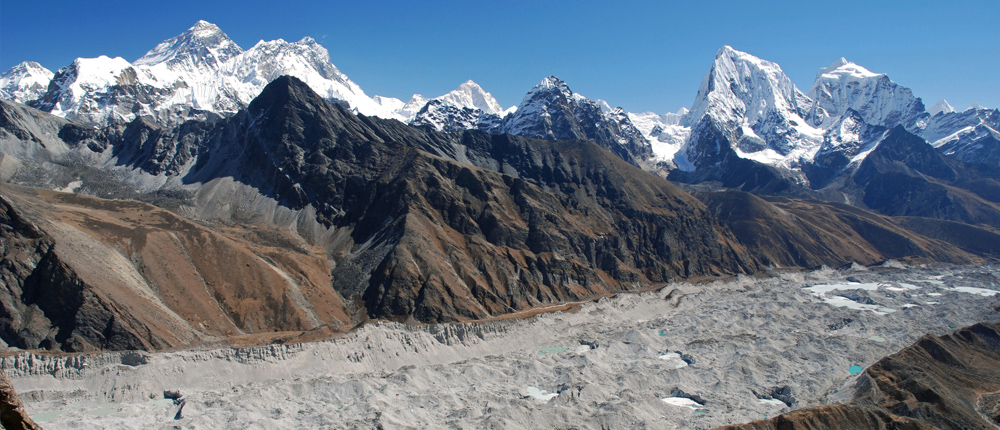
Everest Three High Passes Trek
View reviews.
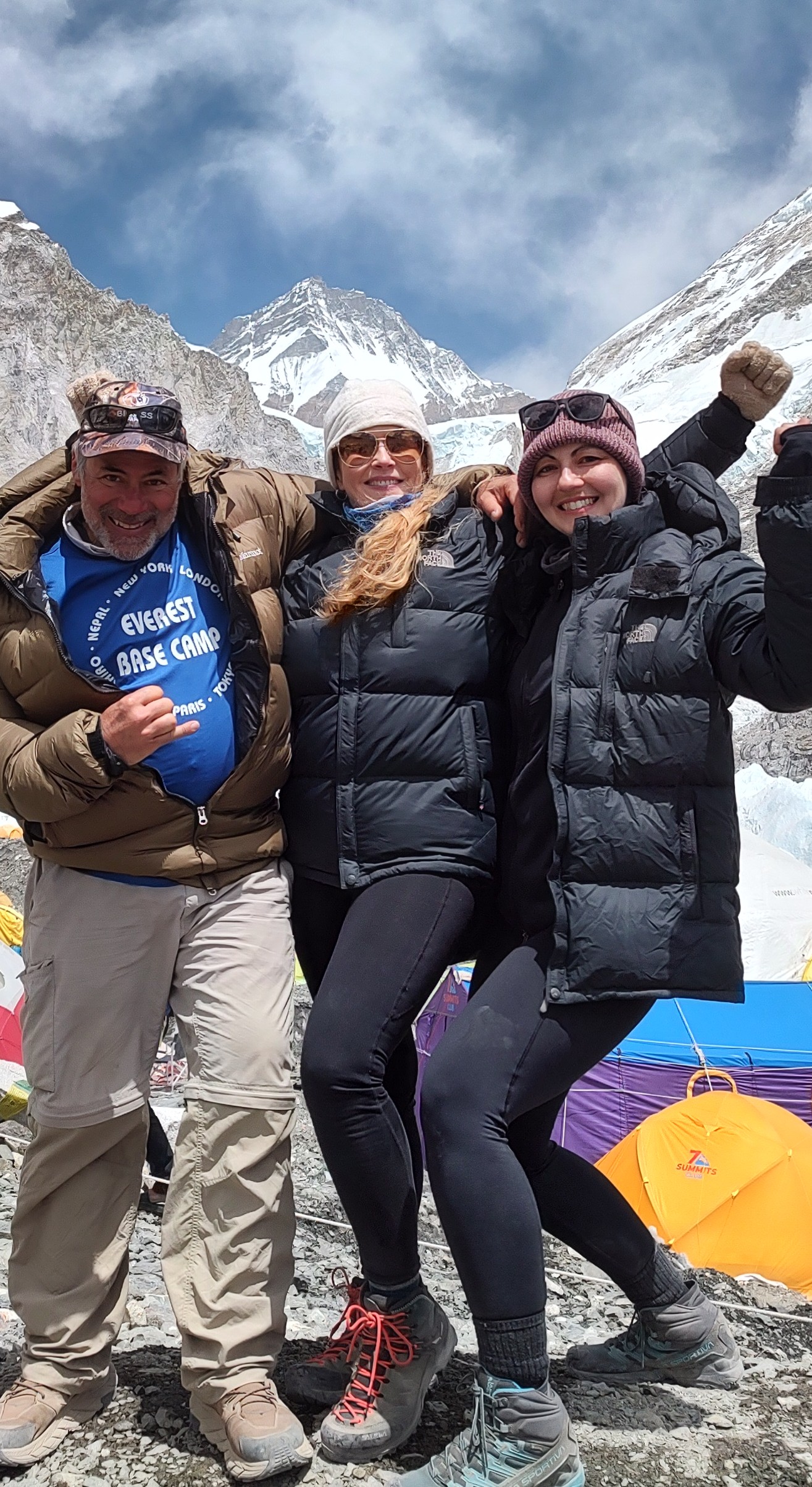
Excellent company - great adventure!
Name: melissa mazaeda rating:.
.jpeg)
Best service and amazing guide
Name: anthony foti rating:, deals & discounts.
Subscribe to our email newsletter
- Legal Documents
- Terms & Conditions
- Privacy Policy
- special Offer
- Nepal Travel Guide
- Tibet Travel Guide
- Bhutan Travel Guide
- Annapurna Circuit Trek
- Everest Helicopter Tour
- Nepal Tours
- Pilgrimage Tours
- Private Trip
- Booking FAQs
- Volunteer Opportunity

Copyright © 2024 Adventure Mountain Explore Treks & Expedition :: All right reserved

- PERPETUAL PLANET
Here's what it's like to live at Everest base camp
Every year a pop-up city is built at the foot of the world's tallest mountain.
Located at the foot of the Khumbu Glacier, Everest Base Camp is encircled by some of the most iconic peaks on Earth. Thousands of trekkers a year hike to Everest Base Camp and along other circuits in Nepal without ascending the peaks.
MOUNT EVEREST BASE CAMP, NEPAL — Hundreds of international mountaineers journey to Mount Everest each spring hoping to make a successful ascent of the world’s highest peak. The vast majority of their time, however, isn’t spent climbing up the flank of the mountain. It’s spent resting, acclimatizing, and preparing at the mountain’s two principle base camps, one on the Nepal side and one on the opposite side of the mountain in Tibet. Life at base camp is an odd mix of mundane domesticity, logistical challenges, and the occasional flash of life-or-death drama.
A tale of two camps
There are two principle routes to the summit of Everest—each with its own base camp and unique flavor of tent-dwelling experience. The North Ridge, on the Tibet side of the mountain, offers easier access: It’s possible to drive vehicles all the way to base camp. Many North side expeditions originate in Kathmandu, Nepal, and then drive across the border into China to reach the mountain.
The South Col route, meanwhile, is accessed through Nepal and typically requires a week of trekking to reach the foot of the mountain, though helicopters have taken a big bite out of the relative remoteness of this side of the mountain.
Both camps are pitched in two mighty glacial valleys. To the north, the Tibet base camp is located below the terminal moraine of the Rongok Glacier. And to the south, the Nepal base camp is located on top of the rock-covered Khumbu Glacier.
Camping at the limits of physiology
Both camps are pitched at about 17,500 feet for good reason. Somewhere between 18,000—19,000 feet, the human body enters a state of decay, above which life is not permanently sustainable. Scientifically and simply put: You don’t want to try living any higher than here.
A well-provisioned base camp provides mountaineers with a home base from which they can dash up the mountain for three to five days at a time, and then return to recover in the relative comfort of thicker air.

The guide service Climbing the Seven Summits pitches their dome tent in the center of the pop-up city of Everest Base Camp.

With transparent siding, the Climbing the Seven Summits tent has one of the most epic Himalayan mountain views on Earth. Guided clients will spend most of their time resting and acclimatizing at base camp, 17,500 feet, to prepare to ascend into the thin air, where the human body cannot survive for extended periods of time.
A catered experience
According to popular Everest blogger Alan Arnette , Nepal's Ministry of Tourism has issued 375 Everest climbing permits for the 2019 spring season; on the North side, there are reportedly 144 foreign climbers. It’s illegal to simply show up at base camp with a climbing permit, pitch a tent, and try to climb the mountain. All foreigners must climb the mountain through a locally licensed logistics company, which supply base camp accommodations, meals, and basic bathroom facilities.
For every one foreign climber, there are three to four local workers living in base camp as well—either climbing sherpas working on the mountain itself or base camp staff—the cooks, dishwashers, servers, and team managers who all look after the guided clients.
This small army of service industry workers are overwhelmingly Nepali, though not all ethnic Sherpas, and they are the engine that keeps base camp humming.
So, what’s for dinner?
It’s been said that an army fights on its stomach, and it's the same on Everest. Expeditions invest massive amounts of effort and resources to provide their clientele with the best food they can. Most commercial expeditions strive to provide three square meals a day, which include a protein, carbohydrate, and some form of fruit or vegetables. Staples like rice, pasta, eggs, canned fruit and vegetables, and flatbreads (locally known chapati ) form the bulk of the ingredients, but a creative chief will find ways to keep the diet interesting. Regular shipments of fresh produce delivered via yak, helicopter, or jeep help immensely.
In between mealtimes, there’s plenty of hot drinks, dried fruit, candy bars, and the omnipresent can of Pringles potato chips for snacking.
A separate mess tent serves Nepali food (almost exclusively tea and a traditional Nepali stew of boiled rice and lentils called dal bhat ) to the local workers.
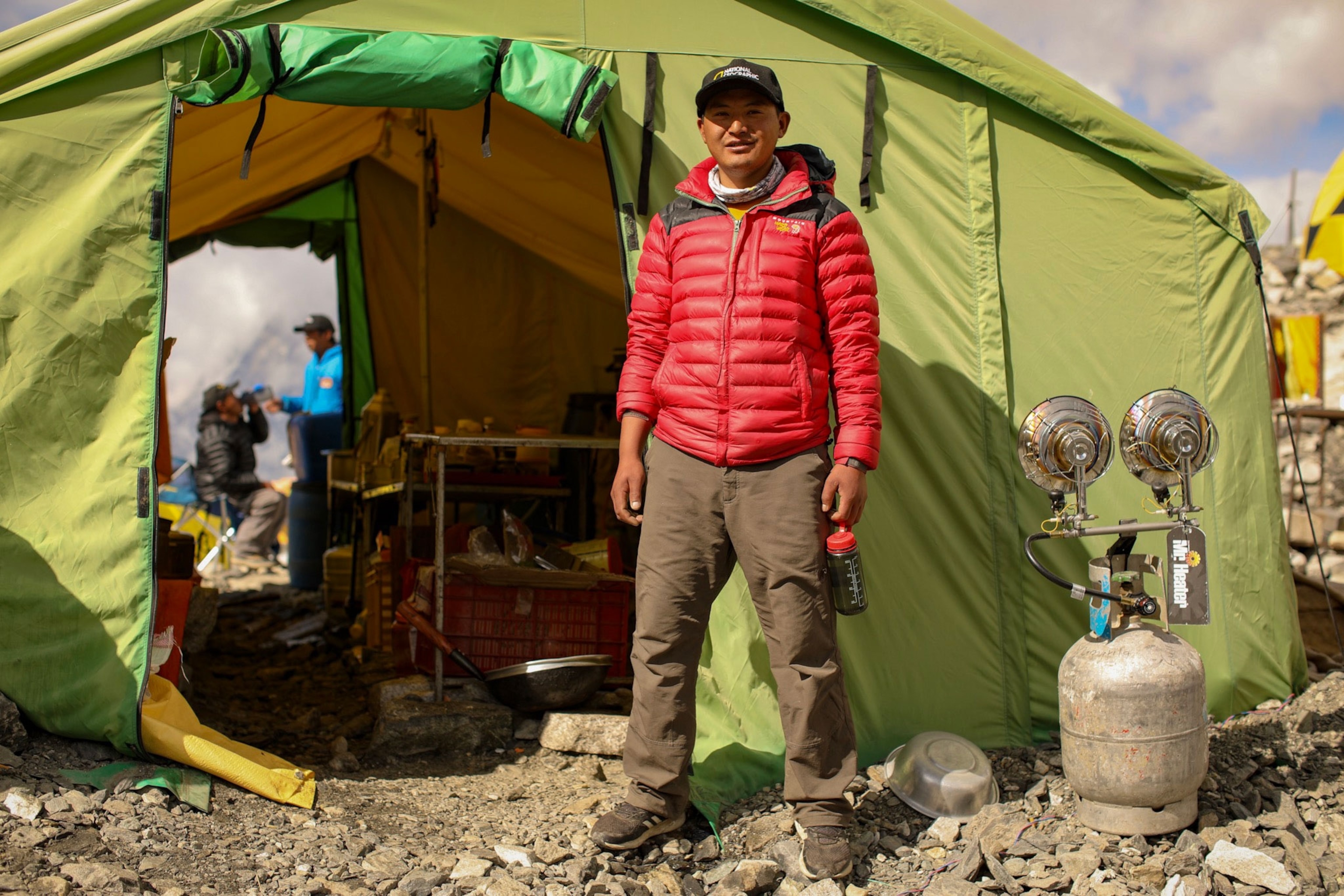
The kitchen is where the magic happens for head cook Subash Magyar. Rice, pasta, eggs, canned fruit and vegetables, and flatbreads (locally known chapati ) form the bulk of the ingredients for the three meals a day.
Big city problems
Expedition campsites are generally taken on a first come, first serve basis. Some savvy organizers even send local representatives to stake a claim to prime real estate months in advance. With hundreds of people camped out in a few square miles, base camp organizers face many of the same problems as urban planners in small cities.
At Nepal's Khumbu Glacier base camp, the Sagarmatha Pollution Control Committee insures that basic sanitation standards are upheld. Chinese officials perform the same function at the at the Rongbok Glacier base camp. Bathroom tents are constructed so that waste can be removed in trash bag-lined plastic barrels, to be hauled to lower elevations and disposed. Trash is likewise collected and removed. Although these practices ensure modern camps are kept relatively clean, venture off the trail a bit and you will discover large piles of trash—the remnants of expeditions from earlier, less enlightened times. On the Nepal side efforts are ongoing to gradually remove all this trash. This year, in an effort to limit the amount of trash and waste, Chinese officials restricted access to the Tibet base camp to climbing expeditions, forbidding tourists from visiting.

Just getting to Everest Base Camp in Nepal requires a weeklong trek, but once there, visitors can keep in touch with the world at large with pre-paid Internet cards via Everest Link, a Nepali-owned company. The degree to which clients "rough it" depends on which guide service they choose. At the top end of the scale, clients can enjoy many of the creature comforts of home, including hot showers, a yoga tent, and after-dinner movies.
High-altitude glamping
Like all cities, there are some “neighborhoods” that are better than others, which is to say not all Everest teams enjoy the same accommodations. What separates a high-end camp from budget accommodations? The fanciest commercial outfitters now provide walk-in wall tents with beds, unlimited electricity through gasoline generators, hot showers, strong reliable Wi-Fi, projectors for after-dinner movies, and even dedicated tents for yoga and stretching. But such creature comforts don’t come cheap. The most luxurious operators charge upwards of $100,000; while budget outfits cost between $25,000 - $40,000.
Don't show up at Everest base camp looking for disco balls and epic parties, however. Most teams remain relatively insular and turn in early—until they've summited, at least.
At the end of the season, most guided climbers beeline it for home as quickly as possible, but there's still weeks of work left for the base camp staff to dismantle everything and see that it transported down valley for safe storage. Many operators rent storage space in nearby villages to avoid the long journey back to Kathmandu.
Base camp 911
Many large expeditions have their own doctors embedded with the teams. Otherwise, organized medical services are limited on both sides of the mountain. If you have a serious medical issue, it’s imperative to leave base camp as quickly as possible and descend to lower altitude.
At the Khumbu Glacier base camp, the Himalayan Rescue Association’s “Everest ER” provides walk-in services; patients with serious issues are evacuated via helicopter to Kathmandu as quickly as possible. At the Rongbok Glacier base camp, there’s primary medical care in Tingrit, a four-hour drive in a four-wheel drive vehicle.
You either love it or hate it
For some, base camp is a form of purgatory—a temporary asylum where one must spend four or five weeks in exchange for the chance to climb Everest. For others, it’s the ultimate summer camp, a place and community unlike any other on Earth. Either way, for those who want to ascend to the highest point on the planet, these are the two starting points.

Related Topics
- MOUNTAIN CLIMBING
- ADVENTURE TRAVEL
- BACKPACKING
You May Also Like

Visiting Alaska? Here’s what the locals love.

Visiting Maine: Here’s what the locals love

You can still climb Mount Everest. Here’s how to do it responsibly.

How to plan the ultimate adventure in the Himalayas, from beginners' hikes to Everest base camp

What it's like to visit the Swiss mountains in winter

What it's like to hike to the end of the world in Chile's Tierra del Fuego

Visiting Ireland? Here’s what the locals love
- Paid Content
- Environment
- Photography
- Perpetual Planet
History & Culture
- History & Culture
- History Magazine
- Mind, Body, Wonder
- World Heritage
- Terms of Use
- Privacy Policy
- Your US State Privacy Rights
- Children's Online Privacy Policy
- Interest-Based Ads
- About Nielsen Measurement
- Do Not Sell or Share My Personal Information
- Nat Geo Home
- Attend a Live Event
- Book a Trip
- Inspire Your Kids
- Shop Nat Geo
- Visit the D.C. Museum
- Learn About Our Impact
- Support Our Mission
- Advertise With Us
- Customer Service
- Renew Subscription
- Manage Your Subscription
- Work at Nat Geo
- Sign Up for Our Newsletters
- Contribute to Protect the Planet
Copyright © 1996-2015 National Geographic Society Copyright © 2015-2024 National Geographic Partners, LLC. All rights reserved

Everest Base Camp: Trekking zum höchsten Berg der Welt in Nepal | Reisetipps & Infos
Home / Reiseziele / Nepal / Everest Base Camp

Schließe dich unserer Mission für nachhaltiges Reisen an!
Wir senden dir unser exklusives Handbuch mit 20 exklusiven Tipps kostenfrei an deine Email Adresse. Mach‘ einen Unterschied, während Du die Welt bereist!
Sie sind jetzt Teil unserer exklusiven Community. Sie erhalten Ihren E-Book-Download-Link direkt per E-Mail.
Nepal ist das Dach der Welt. Hoch oben, inmitten des Himalayas, kommen der Reichtum und die wahre Schönheit des Landes erst richtig zum Vorschein. Die Gegend um den Mount Everest (Region Khumbu bzw. Khumbu Himal genannt) liegt im Sagarmatha Nationalpark.
Sie ist weltweit bekannt für ihr grandioses Hochgebirgspanorama, gekrönt von Aussichten auf den höchsten Berg der Welt, der manchmal zum Greifen nahe scheint – dem Mount Everest!
Aber nicht nur die schneebedeckten Eisriesen oder die atemberaubende Landschaft der Achttausender machen den Aufstieg zum Everest Base Camp so außergewöhnlich, sondern auch die spannenden Einblicke in die Kultur der dort lebenden Volksgruppe der Sherpa mit ihrer warmherzigen Gastfreundschaft.
In diesem Artikel findest Du eine ausführliche Routenbeschreibung zu jeder Etappe des Everest Base Camp inklusive Höhenprofil. Außerdem gibt Dir unser Gastautor Klaus Hessenauer (langjähriger Nepalexperte & Autor des Buches Unter Gebetsfahnen* ) zahlreiche hilfreiche Reise-Tipps und tolle Hintergrundinformationen zu Kultur, Land und Leute.
Viel Spaß beim Lesen! 🙂
Unser Tipp für Nepal Reisen

Bist Du auf der Suche nach einem erstklassigen Reiseveranstalter für Nepal?
Unsere Empfehlung: die Experten von Hauser Exkursionen* . Neben beliebten Klassikern wie Annapurna, Everest und Langtang bieten die Guides auch spannende Geheimtipps wie den Makalu Lodge-Trek, den Mardi Himal oder Wanderungen in die Dolpo Region an.
Klingt spannend? Schau vorbei:
Nepal Reisen
Inhaltsverzeichnis
Everest Base Camp: Der vollständige Trekking-Guide
Everest base camp: anreise nach lukla, everest base camp: die route im detail, everest base camp: die besten varianten, die beste reisezeit für den ebc trek.
Natürlich träumen viele bergbegeisterte davon, einmal den Mount Everest in Nepal aus nächster Nähe zu bestaunen. Kein Wunder also, dass der Everest Base Camp Trek mit zu den am häufigsten frequentierten Routen des Landes gehört.
Die Trekkingtour führt von Lukla über den Aussichtsberg Kala Patthar zum Mount Everest Base Camp und ist bekannt für ihre spektakuläre Aussicht auf fünf der höchsten Berge der Welt: Den namensgebenden Mount Everest (8.848m), sowie die Berge Lhotse (8.501m), Makalu (8.463m), Ama Dablam (6.812m) und den Cho Oyu (8.188m).
Tipp für Aktivitäten und Übernachtungen: Die besten Aktivitäten in Nepal findest Du mit unseren Partner GetYourGuide* und für Übernachtungen in Nepal empfehlen wir unseren Partner Booking.com* .

Wichtige Infos zur Wanderung auf einen Blick
Erforderliche genehmigungen.
Du benötigst für die Wanderung zum Everest Base Camp zwei Genehmigungen:
- Trekkers’ Information Management System (TIMS-Karte) * – Kosten: 2.000 NPR ~ 17€
- Genehmigung für den Sagarmatha-Nationalpark – Kosten: 3.500 NPR ~ 28€
Beide Genehmigungen sind im Nepal Tourism Board (NTB) in der Hauptstadt Kathmandu erhältlich. Neben ausreichend Bargeld (in der Landeswährung, nepalesische Rupien – NPR) sind außerdem noch zwei Passbilder notwendig. Die Beantragung inklusive Wartezeit dauert je nach Besucheransturm 1 bis 3 Stunden.
* Update 2019: Nach aktueller Info wird die TIMS-Karte für die Khumbu Region und den Everest Base Camp Trek nicht mehr anerkannt bzw. nicht mehr benötigt. Stattdessen wird – neben der Eintrittsgebühr in den Nationalpark – noch eine Gebühr von 2.000 NPR (ca. 17€) in Lukla erhoben.
Somit brauchst Du nicht mehr zum Tourism Board in Kathmandu, denn auch den Eintritt zum Park kannst Du nun am Checkpoint in Jorsale zahlen!
Unser Tipp für Deine Reise zum Everest Base Camp
Du möchtest den Everest Base Camp mal ganz anders erleben? Dabei sind Dir Fairness, Individualität und authentische Erlebnisse wichtig? Dann lass Dir von einem erstklassigen Reiseveranstalter die geheimen Ecken eines der schönsten Länder Asiens zeigen.
Unsere Empfehlung: Die Reiseexperten von FairAway* sind der richtige Ansprechpartner! Jetzt völlig kostenlos und unverbindlich beraten lassen:

Kartenmaterial & Wanderkarten für den Trek

Bei Amazon ansehen * ×
Es gibt einige sehr gute Wanderkarten zur Everest Region, dem Khumbu bzw. Khumbu Himal. Die meisten Karten sind allerdings auf Englisch!
Dazu zählen neben der großen Übersichtskarte Jiri to Everest* (Maßstab 1:100.000 , Auflage 2014, Preis:
) auch die Adventure Travel Map* von National Geographic mit mehr Details (Maßstab 1:50.000 , Auflage 2004, Preis:

Besonders die Karte Jiri to Everest kann eine interessante Wahl für Dich sein wenn Du von der Hauptstadt Kathmandu nicht nach Lukla fliegst (oder der Hin- oder Rückflug wegen schlechtem Wetter kurzfristig storniert wird) sondern den Bus bis zur Stadt Jiri nimmst und dort den Everest Base Camp Trek beginnst.
Die meisten Trekker starten die Everest Base Camp Wanderung nach einem knapp halbstündigen Flug zum Tenzing-Hillary Airport, in Lukla (2.860m). Der Flugplatz wird oft als einer der gefährlichsten der Welt genannt.
Tatsächlich ist der Anflug auf die, auf einer Bergterrasse gelegene Landebahn nicht ganz einfach, zumal es sich um Sichtflüge handelt. Zum Einsatz kommen nur sogenannte STOL Flugzeuge ( S hort T ake O ff and L anding). Aber auch diese sind auf ausreichende Sichtbedingungen angewiesen, sodass Flugausfälle, auch über mehrere Tage, immer wieder mal vorkommen.
Wohl dem, der dann einige Puffertage in der Hauptstadt Kathmandu hat, insbesondere wenn man den Heim- oder Weiterflug erreichen muss.
Mein Tipp: Versuche einen der ersten Flüge frühmorgens zu bekommen. Im späteren Tagesverlauf verschlechtern sich oft die Sichtbedingungen, so dass die Wahrscheinlichkeit eines Flugausfalles steigt!
Update 2019: Ab dem 1. April 2019 starten alle Flüge von Kathmandu nach Lukla nicht mehr ab Kathmandu, sondern ab Ramechhap! Details dazu findest Du weiter unten in den Kommentaren. Solltest Du in der Zwischenzeit Neuigkeiten dazu haben dann freuen wir uns sehr über eine Nachricht.

Einen Vergleich der schönsten Wanderungen des Landes findest Du hier – Nepal Trekking .
Bevor wir auf die Routenbeschreibung im Detail eingehen, findest Du hier kurz und knapp das Höhenprofil des Everest Base Camp (kurz EBC) Treks sowie eine Übersichtskarte:

Die Trekking-Strecke führt Dich am Dudh Koshi Fluss entlang über die Siedlungen Phakding, Namche Bazar, Tengboche, Pheriche/Dingboche, Lobuche und Gorak Shep bis zum Everest Base Camp und wieder zurück. Alternativen zum Rückweg und zum Abstieg findest Du weiter unten.

Lesetipps: Weitere schöne Trekkingtouren in Nepal sind außer dem Everest Base Camp im Khumbu auch der Annapurna Circuit , der Tamang Heritage Trail , der neue Geheimtipp Mardi Himal oder der Aufstieg zu den heiligen Seen von Gosainkund .
Flug nach Lukla (2.860m) und Trekking nach Phakding (2.650m) | Tag 1
Da die Flüge von Kathmandu schon frühmorgens gehen, kannst Du nach der Ankunft in Lukla noch bequem bis Phakding wandern. Das hat den Vorteil, dass Du noch mal ins Dudh Koshi Tal absteigst und die notwendige Höhenanpassung damit etwas tiefer beginnt. Unterwegs im Tal triffst Du auf die Einmündung des „klassischen“ Everest-Treks von Jiri kommend.
Alternativ zum Flug nach Lukla kannst Du den Trek, nach einer tagesfüllenden Busfahrt von Kathmandu nach Jiri oder Shivalya , auch zu Fuß beginnen. Dafür solltest Du ca. 7 Tage zusätzlich einplanen. Da Täler und Höhenzüge quer zur Marschrichtung verlaufen, ist ein stetiges Auf und Ab angesagt.
Eine weitere Möglichkeit ist der Start in Phaplu . Dorthin gibt es unregelmäßige Inlandsflüge und seit kurzer Zeit auch eine Jeep Verbindung ab Kathmandu. Bis Phakding sind dafür 3 zusätzliche Tage zu veranschlagen.
Mein Tipp: Wenn Du zeitig dran bist, kannst Du von Phakding aus noch etwas weiter gehen, ca. 3/4 Stunde bis Benkar. Damit entkoppelst Du Dich von der Menge der Neuankömmlinge in Lukla, die fast alle bis Phakding gehen. 🙂

Phakding (2.650m) nach Namche Bazar (3.440m) | Tag 2
Der heutige Tag erfordert einen schweißtreibenden Anstieg nach Namche Bazar, den Hauptort des Sherpalandes. Zuvor erreichst Du, entlang des Dudh Koshi Flusses (nepalesisch für “Milchfluß”, manchmal auch Dud Kosi geschrieben) noch die größeren Dörfer Monjo und gleich danach Jorsale mit dem Checkpoint und dem Eintritt in den Sagarmatha Nationalpark.
Diverse Hängebrücken sorgen bei der Etappe für Abwechslung.
Der eigentliche Anstieg beginnt mit der Überquerung der Hängebrücke Hillary-Bridge , die über die tief eingeschnittene Schlucht führt. Mit 3.440m erreichst Du in Namche Bazar schon die Höhe stattlicher Alpengipfel.

In oder um Namche Bazar (3.440m) – Akklimatisationstag | Tag 3
Spätestens jetzt ist verstärkt auf ausreichende Akklimatisierung zu achten. Der Körper muss sich an die geringere Sauerstoffzufuhr in großen Höhen erst gewöhnen. AMS (Acute Mountain Sickness) bzw. Höhenkrankheit ist ein ernst zu nehmendes Thema!
Faustregeln zur Höhenanpassung lauten: Die Schlafhöhe pro Tag um nicht mehr als ca. 300 bis 600 m zu steigern. Wo dies topografisch nicht möglich ist, solltest Du entsprechende Ruhetage einlegen.
Günstig wirkt sich ebenfalls die Regel „go high sleep low“ aus, d.h. wenn möglich steige tagsüber höher auf als die Schlafhöhe am Abend. Außerdem solltest Du auf ausreichende Flüssigkeitszufuhr achten. Nicht nur schweißtreibende Aufstiege kosten Flüssigkeit, auch über die Atemluft verliert man durch die erhöhte Frequenz und trockene Gebirgsluft erheblich Flüssigkeit.
Die Empfehlung, in Namche Bazar einen Akklimatisationstag einzulegen, sollte man ernst nehmen! Der Tag lässt sich hervorragend zu einem Abstecher nach Khumjung (3.780m), mit einem Besuch des Sherpamuseums, oder der Besichtigung des „Yeti-Skalpes“ in der Gompa verbringen. Mit einem Besuch im Everest View Hotel nahe der 4.000m Grenze tut man auch gutes für die Akklimatisierung.
Mein Tipp: Im Nachbarort Khunde ist das Hillary Hospital, eine unschätzbar wertvolle Einrichtung in der Region. Dort erhält man im Notfall auch medizinische Hilfe bei akuten Symptomen der Höhenkrankheit.

Namche Bazar (3.440m) zum Kloster Tengboche (3.860m) | Tag 4
Der weitere Wegverlauf führt im Anblick der Ama Dablam , dem heiligen Berg der Sherpas, nach Tengboche (oft auch Thyangboche oder Tengpoche geschrieben). Noch einmal müssen wir, auf stellenweise staubigen Wegen, ins Tal des Milchflusses absteigen und dann einen Gegenanstieg von etwa 600 Höhenmetern bewältigen, bevor wir das Kloster und den spirituellen Mittelpunkt der Region erreichen.
In Tengboche besteht die Möglichkeit am frühen Morgen an einer Puja, einer religiösen Zeremonie, teilzunehmen.
Mein Tipp: Das Mani Rimdu Fest im Oktober/November, (jährlich wechselnde Termine nach Lunar-Kalender) ist ein einzigartiges Erlebnis. Mit Maskentänzen und Ritualen wird der Sieg des Buddhismus über die Bön Religion gefeiert.

Kloster Tengboche (3.860m) nach Pheriche (4.370 m) | Tag 5
Weiter geht der Weg über Pangboche vorbei an Dingboche nach Pheriche , dem höchsten ganzjährig bewohnten Ort in der Region. Zunächst noch durch lichten Wald später dann durch eine immer karger werdende Landschaft.
Alternative : Bei unserer letzten Tour habe ich eine Variante zur Akklimatisation ausprobiert und bin gut damit gefahren. Statt eines Anpassungstages in Namche Bazar sind wir nach Tengboche gegangen, haben jedoch nicht in der unmittelbaren Nachbarschaft des Klosters übernachtet, sondern etwa eine halbe Stunde weiter und 200 Meter tiefer!
Am Tag danach sind wir von Pangboche aus, in einem Tagesausflug, zum Ama Dablam Basecamp (4.500m) aufgestiegen. Go high, sleep low! Ich habe 3 Tage später in Gorak Shep ausgezeichnet geschlafen, ein Zeichen für gute Höhenanpassung. 🙂

Über Lobuche (4.940m) nach Gorak Shep (5.150m) zum Everest Base Camp | Tag 6 und 7
Nun sind es noch zwei Wandertage, zuerst nach Lobuche und am nächsten Tag nach Gorak Shep . Diese Hochalm ist inzwischen eine kleine Lodge-Siedlung geworden und letzter Übernachtungsort vor dem Kala Patthar oder dem Everest-Base-Camp. Wir wandern noch ein Stück im Hochtal von Pheriche bevor wir nach einem ersten Anstieg Dughla (4.600m) erreichen. Eine Lodge bietet Gelegenheit zur Pause.
Weiter geht es bergan zum sogenannten „ Sherpa-Friedhof “. Es ist in Wirklichkeit eine Gedenkstätte für am Mount Everest gebliebene Bergsteiger. Chörten aus Natursteinen erinnern mit Steintafeln an die Toten, die der Berg nicht mehr hergibt.
Lobuche ist eine kleine Ansammlung von recht einfachen Lodges. Beeindruckend der Blick zum Nuptse (7.861m).
In einer immer arider werdenden Hochgebirgslandschaft wandern wir auf steinigen Wegen und mit Blick auf den gewaltigen Kegel des Pumo Ri (7.161m), am 7. Tag nach Gorak Shep, dem höchsten Übernachtungspunkt dieser Tour. Auch dieses Bergdorf ist eine reine Lodgesiedlung für den Trekkingtourismus.
Mein Tipp: Besonders in der Hauptsaison sollten auch Individualtrekker sowohl in Lobuche als auch in Gorak Shep vorher reservieren. Das kann man z.B. über den Lodge-Wirt in Pheriche machen oder selbst anrufen. In Kathmandu gibt es für wenige Euros nepalesische Prepaid SIM-Karten zu kaufen (z.B. vom Anbieter Ncell ), die auch im Notfall eine wertvolle Hilfe sein können.
Wer genug Kondition hat kann den Kala Patthar noch am Ankunftstag, zum Abendrot besteigen. Stirnlampe für den Rückweg nicht vergessen! Der Aussichtsberg erscheint dem Wanderer zunächst als spitzer dunkler Hügel. Nur die unmittelbare Gipfelregion ist etwas felsig und vermittelt „Gipfelglück“.
Der Blick zum Mount Everest – Sagarmatha nennen ihn die Nepali, Chomolungma, Göttin Mutter Erde, die Tibeter – ist alle Anstrengungen wert.
Um zu dem berühmten Everest Base Camp aufzusteigen bietet sich ein Abstecher von Gorak Shep aus an. Das Everest Base Camp wird man in der normalen Trekkingsaison weitgehend verwaist vorfinden, da das Zeitfenster für den Gipfelsturm im Mai außerhalb der Wandersaison liegt. Es gibt keine Möglichkeit zur Übernachtung für Individualtrekker, sodass man am selben Tag wieder nach Gorak Shep absteigen muss. Für den Auf- und Abstieg solltest Du mindestens 6,5 Stunden einplanen.
Bei Gorak Shep liegt der Khumbu-Gletscher, der sein Eiswasser von den Bergen Lhotse, Nuptse und natürlich dem Mount Everest erhält.

Abstieg nach Pheriche oder Dingboche über Lobuche (je nach Verweildauer in Gorak Shep) | Tag 8 oder 9
Auf dem Rückweg überspringt man Lobuche und geht bis Pheriche (4.370m) oder Dingboche hinab. Wer vorher noch auf dem Kala Patthar war oder am Everest Basecamp, der hat heute einen langen Tag vor sich!
Natürlich könntest Du auch in Lobuche oder weiter unten in Dughla noch mal übernachten falls Du Zeit hast.
Nach Phortse (3.840m) | Tag 9
Viele nehmen den Aufstiegsweg auch für den Rückmarsch bzw. Abstieg. Man kann dann über die bekannten Stationen Dingboche, Tengboche, Namche Bazar und etwa Monjo in 2 bis 4 Tagen Lukla erreichen. Da die Akklimatisation beim Abstieg keine Rolle mehr spielt ist die Etappenlänge eine Frage der individuellen Kondition und verfügbaren Zeit.
Ich empfehle jedoch ab Pangboche (mit Blick auf den Ama Dablam) einen kleinen Umweg über das Sherpadorf Phortse , zu dem ein wunderschöner, aussichtsreicher Höhenweg führt.

Nach Khumjung / Namche Bazar | Tag 10
Von Phortse führt ein steiler Abstieg in das Tal des Dudh Koshi Flusses und ebenso steil wieder hinauf nach Mon-La , ein kleiner Ort mit mehreren Lodges und grandioser Aussicht zur Ama Dablam, Kangtega und Tramserku.
Nach einer Stärkung kann man noch bis Khumjung oder weiter bis Namche Bazar gehen. Dort trifft man wieder auf den Aufstiegsweg der dann in einem oder zwei Tagen nach Lukla und zum Flughafen führt.
Die meisten Trekker entscheiden sich bei dieser Etappe für Namche Bazar.
Rückweg | Tag 11 und 12
Viele bewältigen den Rückmarsch von Namche nach Lukla in einem langen Tag. Wer die Wanderung der letzten Etappe entspannter angehen will kann noch einmal in Monjo übernachten, kurz nach Verlassen des Sagarmatha Nationalparks.
Rückflug nach Kathmandu | Tag 12 oder 13
Auch beim Rückflug nach Kathmandu gilt es wieder eine möglichst frühe Maschine zu bekommen um die Ausfallwahrscheinlichkeit zu reduzieren. Auf jeden Fall sollte man sich schon am Vortag im Büro der Fluggesellschaft vergewissern, dass die Buchung in Ordnung ist.

Der Boarding Pass von Yeti Airlines zurück zur Hauptstadt Kathmandu – mittlerweile wird der Flug durch deren Tochtergesellschaft Tara Air angeboten.
Natürlich kann man eine weitere Nacht in Gorak Shep einplanen um ganz entspannt das Everest Base Camp zu besuchen. Generell würde ich noch einen Reservetag zur freien Verfügung in die Planung aufnehmen.
Hier stelle ich Dir noch ein paar Trekking Varianten für den EBC vor:
Aufstieg zum Gokyo Ri (5.360m)
Der Gokyo Ri ist ebenfalls ein empfehlenswerter Aussichtsberg und eine tolle Wanderung. Am einfachsten erreicht man die Hochalm von Namche Bazar aus über Khumjung, Mon La, Dole, und Macchermo.

Besteigung des Chukhung Ri (5.650m)
Als Ergänzung zur Everest Etappe bietet sich eine Trekking Tour mit Gipfel-Besteigung des Chukhung Ri an. Der Abzweig ins Tal des Imja Khola (Khola = Fluss) ist auf der Strecke von Pangboche (3.960m) nach Pheriche (4.370m). Beeindruckend sind ab Pangboche die Blicke zum Nuptse und zur senkrecht abstürzenden Südwand des Lhotse. Der Lhotse ist der vierthöchste Berg der Welt!
Die Ama Dablam präsentiert sich aus vollkommen anderer Perspektive.
Etwas weiter lädt der Imja-Tse (Island-Peak) versierte Alpinisten ein. Sicheres Gehen am Seil und mit Steigeisen ist allerdings Voraussetzung für den 6.189m hohen Gipfel (Permit-Pflicht).
Einfacher Rundweg in geringeren Höhen
Wer sich größere Höhen in den Bergen nicht zutraut, oder tatsächlich Probleme hat weiter aufzusteigen, kann den Kala Patthar und den Everest Base Camp weglassen und ab Pangboche über Phortse und Khumjung eine Rundwanderung nach Namche Bazar machen (siehe Empfehlung für den Rückweg).
So kannst Du trotzdem die atemberaubende Landschaft des Khumbu genießen inklusive Ausblick auf den Ama Dablam.
Überschreitung des Cho La (5.330m)
Eine beliebte Ergänzung des Kala Pattar ist die anschließende Überschreitung des Cho La (La = Pass).
Nach einer Übernachtung in Dzongla erreicht man über Dragnag (Übernachtungsmöglichkeit), Gokyo und damit einen weiteren Trekkinggipfel, den man aufrechten Ganges und ohne Hilfsmittel erwandern kann. 🙂

Lesetipps: Entdecke hier die schönsten Nepal Sehenswürdigkeiten , alle wichtigen Infos zur Hauptstadt Kathmandu sowie die traumhafte Gegend um Pokhara .
Drei Pässe Rundweg
Das absolute Highlight der gesamten Khumbu-Region für konditionsstarke Trekker ist die „Drei Pässe Runde“ .
Von Namche Bazar geht man nach dem Akklimatisierungstag nach Thame und dann in Richtung Nangpa-La den Grenzpass zu Tibet. Ein Abzweig führt nach Lungden zur Übernachtung und am nächsten Tag über den Renjo-La 5.417m nach Gokyo.
Trekking-Optionen dort sind eine Besteigung des Gokyo Ri und/oder eine tagesfüllende Wanderung in Richtung Cho Oyu, zum fünften See. Im weiteren Verlauf wird der Cho-La mit 5.330 m überquert, und nach einer Nacht in Dragnag und/oder Dzongla erreicht man Gorak Shep am Fuße des Kala Patthar. Der dritte Pass, der Kongma-La mit 5.535m bringt uns schließlich in einem langen Tag nach Chukhung.
Diese anspruchsvolle, in Teilstrecken hochalpine Tour kann noch mit einer Besteigung des Island-Peaks gekrönt werden, aber wie bereits erwähnt wird damit die Grenze vom Wandern zum Bergsteigen überschritten.
Für den Rückweg bietet sich die Strecke über die Etappe Tengboche und ein Besuch des Klosters an.
Alle Trekking-Wege und Pfade der Everest Base Camp Wanderung sind für trittsichere Wanderer begehbar. Höhere Anforderungen stellen die drei Pässe. Sie erfordern nicht nur gute Kondition, der Cho-La macht eine kurze Gletscherpassage notwendig. Stellenweise findet man sog. Blockgelände vor. Trittsicherheit und Schwindelfreiheit sind Voraussetzung. Mit einem Wintereinbruch, Wettersturz und Schnee auch im Oktober und im Frühjahr muss jederzeit gerechnet werden. Dem sollte die Trekking-Ausrüstung Rechnung tragen!
Lesetipp: ideal für Trekking in Nepal – die Packliste Wandern .
Übernachten kann man durchgehend in Lodges, landestypischen Gasthäusern. Gemessen an westeuropäischen Ansprüchen ist die Bereitschaft zu Komfortverzicht notwendig. Die Verpflegung ist abwechslungsreich, Bergsteiger aller Herren Länder haben Rezepte hinterlassen. So gibt es neben dem klassischen Dhal Bhat (Reis und Linsen) auch mehr oder weniger gelungene Pizzen, Rösti, jede Menge Nudelgerichte – auch Yak-Steaks sind nicht mehr tabu.
Viele weitere Infos zur nepalesischen Küche findest Du hier: Nepalesisches Essen – Top 6 Gerichte .
Die beste Reisezeit für das Trekking zum Everest Base Camp und der Khumbu-Region ist im Frühjahr mit den Monaten März und April sowie im Herbst mit den Monaten Oktober/November . Tendenziell ist die Luft und damit die Sicht im Herbst je später je klarer, aber auch immer kälter! Im Frühejahr umgekehrt.
Detaillierte Informationen dazu findest du hier: Nepal Reisezeit – Klima, Wetter & Temperaturen .
Hinweis: Auf Zeitangaben für die einzelnen Etappen der Wanderung habe ich bewusst verzichtet, da diese häufig individuell sehr unterschiedlich ausfallen.
Über den Autor

Seit 20 Jahren zieht es ihn immer wieder nach Nepal und in die Berge des Himalaya. Zu Fuß von Nepal nach Tibet, zum Götterthron Kailash, über Ostnepal zur Teestadt Darjeeling und zum Kanchendzönga oder in die einzigartige Kultur Bhutans, immer ist Nepal gleichsam ein Scharnier und Basislager auch für Unternehmungen in den umliegenden Himalayaländern.

Es ist kein klassischer Nepal Reiseführer, eher ein Reiseverführer betont er und auf jeden Fall ein Buch, dass das Herz der Vorfreude höher schlagen lässt, fügen wir hinzu! 🙂
Preis: Unter Gebetsfahnen: Trekking und Reiseerlebnisse in Nepal * 14,99 € (Stand von: 23. Mai 2024 5:46 – Details ) (* = Affiliate-Link / Bildquelle: Amazon-Partnerprogramm) Bei Amazon ansehen * × Produktpreise und -verfügbarkeit sind zum angegebenen Datum / Uhrzeit korrekt und können sich ändern. Alle Preis- und Verfügbarkeitsinformationen auf https://www.amazon.de/ zum Zeitpunkt des Kaufs gelten für den Kauf dieses Produkts. | Taschenbuch, 240 Seiten | ISBN: 978-3-7431-9529-5
Hier findest Du noch viele weitere Infos & Artikel für Deine Reise nach Nepal: — NEPAL
* Hinweis: Die gekennzeichneten Links sind Affiliate Links. Wir bekommen eine kleine Provision vom Anbieter wenn Du darüber ein Produkt bestellst. Der Preis verändert sich für Dich nicht, Du hast also keinerlei Nachteile davon.
Im Gegenteil: Dadurch hilfst Du uns auch weiterhin tolle Artikel auf reisefroh veröffentlichen zu können. Danke! 🙂
Dir hat der Artikel gefallen? Dann teile ihn mit deinen Freunden!
Registrieren Sie sich für Nachrichten und verborgene Schätze.
You have successfully joined our subscriber list.
Das Könnte Dich Auch Interessieren:

42 Antworten zu “Everest Base Camp: Trekking zum höchsten Berg der Welt in Nepal | Reisetipps & Infos”
Hallo Anne & Sebastian,
ich plane einen Trip mit meiner Frau zum EBC über genau die Route die ihr hier beschreibt. Gerne hätte ich einen Erfahrungswert von euch, da ich eine gewisse Höhenangst habe.. Wie hoch und lang sind denn die Hängebrücken? Auf Bildern schaut es eigentlich nicht so hoch und schlimm aus!?
VIELEN DANK für eure Einschätzung!!!!
Übrigens ein toller Bericht, der ein absolutes Kribbeln in mir auslöst!
Mit freundlichen Grüßen, Raiko
Hallo Raiko! 🙂 Vielen Dank für Deinen Kommentar zum Everest Base Camp Trek! Hier die Antwort dazu von unserem Gastautor Klaus:
–> Ich habe 3 nennenswerte Brücken in Erinnerung: Eine hinter Phakding, die Hillary Bridge vor dem Aufstieg nach Namche und dann bei Sanasa bevor es nach Tengpoche hoch geht. Länge so 100 bis 150m grob geschätzt. Hoch ist nur die Hillary Bridge (siehe Foto im Beitrag). Die Brücken sind seitlich abgespannt, so dass sie auch nicht allzusehr schwanken.
Insgesamt machen sie einen soliden, vertrauenswürdigen Eindruck. Das Geländer (Seil mit Drahtgeflecht) ist etwa Brusthoch – je nach eigener Körpergröße. Zur Info: Yak- und Muli Karawanen haben Vorfahrt! Da sollte man Gegenverkehr abwarten. 😉
Ich hoffe das beantwortet Deine Frage. Viele Grüße und eine tolle Reise nach Nepal!!
Hallo, vielen Dank für den tollen Bericht. Mein Mann und ich haben im Oktober auch den EBCT geplant. Wir werden eigen organisiert die Reise antreten und wir fragen uns, wie das denn mit den Übernachtungen ist? Findet man problemlos freie Lodges oder sind diese meist schon durch organisierte Reisegruppen belagert? 🙂 Danke für eine Rückmeldung. Liebe Grüße Leonie
Hallo Leonie! Vielen Dank für Deinen Kommentar. 🙂 Hier die Antwort zu Deiner Frage:
Oktober ist natürlich Hauptsaison, da kann es schon mal eng werden, überhaupt mit einer “Wunschlodge” die man vielleicht von einer Empfehlung hat… Es werden schon mal Zelte neben der Lodge aufgestellt wenn es ganz eng wird. Ich würde auf jeden Fall versuchen in Lobuche und Gorak Shep vorher zu reservieren. Das sind nämlich reine Lodge Siedlungen. Dazu einfach den Lodge-Wirt in Periche fragen ob er anruft, oder in Kathmandu eine SIM-Karte für ein paar Euros kaufen (Tipp: Anbieter Ncell ) und selbst anrufen (den Wirt oder einen Guide nach der Telefonnr. fragen). Die Guides haben natürlich heute alle ein Handy und reservieren für ihre Gruppen vorab.
Viel Spaß in Nepal! 🙂
Hallo Anne und Sebastian, im April möchten mein Freund und ich ebenfalls zum EBC wandern. Um die finanzielle Seite etwas besser abschätzen zu können: Was habt ihr in den zwei Wochen ca ausgegeben ? Und übrigens: Toller und sehr informativer Bericht 🙂 Liebe Grüße Annika
Liebe Annika, vielen Dank für die spannende Frage. Diesen Beitrag hat unser Gastautor Klaus geschrieben, wir werden die Frage an ihn weitergeben und Dir danach hier in den Kommentaren Rückmeldung geben bzw. die Antwort auch in dem Beitrag ergänzen. 🙂 Viele Grüße Anne
Hallo Annika, also im April sind wir aller Wahrscheinlichkeit nach auch wieder vor Ort, dann wüsste ich es ganz aktuell! 😉
Aber nach meiner Erfahrung müsstet ihr mit 20-25 € Tag/Person für Essen, Trinken, Übernachtung rum kommen. Allerdings ohne alkoholische Getränke und ohne viele Softdrinks (Bier, Rum Cola etc). Generell gilt je höher je teurer! Und das Khumbu ist im Quervergleich in Nepal eine der teuersten Regionen. Meines Wissens gibt es seit einiger Zeit in Namche jetzt auch einen Geldautomaten, sodass man sich notfalls noch mit einer Kreditkarte helfen kann. Tauschen kann man dort sicher, der Kurs ist halt ungünstiger als in Kathmandu. Ob der Automat immer funktioniert ist eine andere Frage 🙂
Ich würde schon ein kleines “Polster” mitnehmen, zumal man anschließend in Kathmandu auch noch Gelegenheit zum Geld ausgeben hat! Generell noch ein Hinweis zum Geldumtausch: Viele machen immer noch den Fehler US-Dollars mitzunehmen und produzieren doppelte Umtauschverluste. Euros werden in Kathmandu und allen größeren Städten gerne genommen. Ich würde allenfalls den Betrag für das Visum am Flughafen abgezählt in US-Dollars mitnehmen…
Happy Trails!
Guten Abend, ein echt toller Bericht! Da kriegt man direkt Lust loszulegen 🙂 Mein Freund und ich überlegen die Tour im April dieses Jahr zu machen. Ich hätte ein paar Fragen zu der Tour…
Was für eine Rucksackgröße empfehlt ihr für die Tour (wird in den Guesthouses Schlafsack/Isomatte benötigt?)? Ist es im April noch sehr kalt nachts? Wisst ihr ob es irgendeine Art “Test” gibt um zu checken, ob man die Luft in so eine Höhe gut aushält? (Ich hab ein bisschen Angst erst vor Ort festzustellen, dass es schwierig mit der Atmung wird). Über Antworten würde ich mich sehr freuen!!
Vielen Dank und liebe Grüße 🙂
erst einmal: ein toller Internet Auftritt! Vielleicht könnt Ihr mir noch einen Tipp für unser Trekking im April 2019 von Jiri zum EBC geben: Sollte man die Flugtickets von Lukla zurück nach KTM vorher in KTM buchen? Gibt es offene Tickets oder muss das Datum feststehen? Vielen Dank schon mal, beste Grüße aus W`haven von der Nordsee
@ Leonie: Also Rucksackgröße hängt natürlich davon ab, ws ihr “glaubt” zu brauchen! Ich würde mich auf das notwendigste beschränken. Einfach mal probepacken ! Isomatte braucht ihr nicht, in den Lodges gibt es Schaumstoffmatratzen. Schlafsack würde ich schon aus Hygienegründen mitnehmen. Über die Wärmeleistung kann man immer trefflich diskutieren, auf jeden Fall gibt es heutzutage auf dem EBC in jeder Lodge zusätzliche Decken. Temperaturen: Weiter oben, ab Periche, Lobuche, Gorak Shep müsst Ihr nachts schon noch mit etlichen Minusgraden rechnen. Es kann auch jederzeit nochmal einen Wintereinbruch geben mit Schnee und Eis. Haben wir selbst schon im April erlebt. Zwei Tage später wieder Sonne pur! Zur Höhenverträglichkeit: Höhenakklimatisation ist ein physiologischer Anpassungsprozess des Körpers. Das kann an simulieren(Unterdruckkammer)… aber auch das ist keine Garantie dass man dann in real die Höhe wieder verträgt. Die Höhenanpassung geht auch wieder “verloren” wenn man einige Zeit wieder in tieferen Lagen ist. Das A und O ist dem Körper die notwendige Zeit zugeben. Also erfahrungsgemäß mindestens ein Tag Akklimatisation in Namche Bazar und auf den Körper hören . . . Und alles was so an medizinischen Tipps durchs Net geistert… Finger weg! Medikamente sind immer nur für den Notfall um Abstieg/Abtransport zu gewährleisten, nie für “Doping” Happy Trails 😉
@ Winfried: Also ich würde in KTM buchen . . . Es gibt meines Wissens auch offene Tickets, damit bist du aber in der Warteschlange genausoweit hinten wie ohne…. Umbuchen ist immer möglich lass dir in KTM die Tel. Nr des Agenten in Lukla geben. (nep. SIM Karten gibt es für ein paar EURO in KTM). Dann kannst Du 1 oder 2 Tage vorher, wenn abssehbar, ggf umbuchen. Grundsätzlich sollte es kein Problem sein ein Ticket in Lukla zu bekommen, steht und fällt mit dem Flugwetter! Sind ja alles Sichtflüge und damit wetterabhängig. Also besser ein paar Tage Puffer in KTM planen. Wenn du buchst, versuche einen möglichst frühen Abflugtermin zu bekommen, Tendenziell ist das Flugwetter früh morgens besser. Gegen Mittag kommen oft Wolken auf!
Besonderheit: Wenn Flugausfall, sind die Tickets obsolet und du gehst am nächsten Tag in die Warteschlange. Gebuchte Termine haben immer Vorrang, auch wenn am Tag vorher die Flüge ausgefallen sind. Deswegen macht buchen Sinn, wenn man den Termin einigermaßen absehen kann, dann hat man zumindest an dem Tag Priorität
Hallo ihr Lieben. Toller Bericht! Ich möchte den Trip im November 2019 machen, bin allerdings ziemlich sicher ohne Reisepartner. Aus meinem Kreis findet sich niemand und mit fremden möchte ich auch nicht gehen. Würdet ihr empfehlen den EBC alleine zu gehen, oder stößt man dabei auf zu viele Hindernisse (vor allem in Lodges). Ich bin zeitlich absolut ungebunden, kann also auch erst in der zweiten Novemberhälfte fliegen, wenn es dann einfacher wird.
Danke und Gruß
Hallo Michi,
also ich persönlich rate grundsätzlich von Alleingängen ab.Nicht wegen Kriminalität, Orientierung oder Unterkünften etc. sondern wegen der objektiven Gefahren. Du bist im Hochgebirge unterwegs. Erdrutsche, Wettersturz, etc. Ein verstauchter Knöchel ein gebrochenes Bein nach einem Sturz kann zum großen Problem werden . . . Aber das ist letztlich auch ein Frage der eigenen Reisephilosophie, ich will da nicht “belehren”
Grundsätzlich ist der EBC einer der am “dichtesten” begangene Treks, man kann sich ja auch unterwegs zusammentun wenn die “Chemie” stimmt! Je später du in den November gehst um so weniger Betrieb aber natürlich tendenziell um so kälter. Unterkunft sollte zumindest bis Pheriche kein Problem sein… Für Lobuche und Gorak Shep würde ich raten einen oder zwei Tage vorher anzurufen…
Wie ich weiter oben schon mal geschrieben habe: Dazu einfach den Lodge-Wirt in Pheriche fragen ob er anruft, oder in Kathmandu eine SIM-Karte für ein paar Euros kaufen (Tipp: Anbieter Ncell) und selbst anrufen (den Wirt oder einen Guide nach der Telefonnr. fragen). Die Guides haben natürlich heute alle ein Handy und reservieren für ihre Gruppen vorab.
Falls Du nach Lukla fliegst, denke daran für den Rückflug in Kathmandu etwas Puffer zu lassen. Es sind ja Sichtflüge von Lukla und die können auch mal ausfallen. Wahrscheinlichkeit im Nov. eher gering aber nicht auszuschließen.
Happy Trails 😉
Habe heute erfahren, dass ab 1. April alle Flüge von KTM nach Lukla nicht ab KTM stattfinden sondern ab Ramechhap. Das ist ca 150 KM und 4-5 Std. Autofahrt (in der Nacht) von KTM entfernt! Die Ursache ist die Instandhaltung der Runway am Flughafen. Dazu wird der Flughafen von 22 Uhr bis 8 Uhr morgens gesperrt. Lukla Flüge gehen ja wetterbedingt immer sehr früh (ab 6 Uhr). Die Bauarbeiten dauern bis Mai, also die gesamte Frühjahrs-Saison.
Jeder, der aktuell in die Everest-Region will sollte sich dessen bewusst sein!
Zur Ticket-Buchung: Ich habe heute versucht, testweise bei der Airline TARA zu buchen, was eindeutig möglich ist ab Kathmandu.
Vielen Dank Klaus für diese wertvolle Information!! 🙂
vielen dank für diesen super ausführlichen Bericht. Ich wollte die Tour heuer in der letzten August/ersten Septemberwoche machen. Ich weiß, dass das nicht die beste Reisezeit ist, aber die Tour sollte trotzdem möglich sein, oder? Hat jemand Erfahrung zu dieser Jahreszeit?
Grüße Hannes
Hallo Hannes, vielen Dank für Deine Frage. Wir haben einige Berichte gelesen von Leuten die den EBC im August unternommen haben. Klar ist das Wetter dann nicht immer ideal, dafür sind aber kaum Wanderer unterwegs und die Preise sind günstiger. Zudem regnet es meistens Nachmittags/Abends und Nachts – wenn Du Deine Etappen also früh beginnst, hast Du vielleicht mehr Glück. Viel Spaß beim Trekking!! VG, Sebastian
Eine Frage. Aus organisatorischen Gruenden koennen wir erst Ende Mai, Anfang Juni diese Wanderung unternehmen, was schon in der Pre-Monsunzeit liegt. Aus diesem Grund wollte ich einmal nachfragen, ob ueberhaupt noch etwas dafuer spricht, zu diesem Zeitpunkt zu reisen, oder ob man es besser gleich bleiben lassen sollte? Hat da jemand Erfahrung damit?Als kleine Anmerkung. Mein Sohn und ich sind keine Schoenwettertouristen, dennoch wollen wir natürlich nicht 10 Tage im Nebel wandern. Das waere dann schon irgendwie albern. Wenn da jemand Erfahrung mit off Season Touren haette? Vielen Dank vorab
Hi Thomas, wir waren Ende Mai in Nepal und sind den Annapurna Circuit bei strahlend blauem Himmel gewandert. Allerdings ist das Wetter um dieses Jahreszeit eine Glücksfrage. Je nachdem wann der Monsun einsetzt und wie stark er ist, kann es zu dieser Jahreszeit genau so gut passieren, dass schon dicke Wolken über dem Himalaya hängen… Ich persönlich würde das Risiko eingehen und Ende Mai/Anfang Juni noch loswandern, aber das muss jeder für sich selbst abwägen. Falls ihr euch für die Trekkingtour entscheidet, wünsche ich euch viel Spaß! 🙂 Liebe Grüße Anne
Ganz herzlichen Dank fuer die Antwort, Anne. Ich werde dann mal die Planung in Angriff nehmen. Da mein Sohn bei der Bergrettung ist, wird die Trekkingtour notfalls als Training abgeschrieben. :-)))
Nochmals vielen Dank Thomas
Ja dann ist ja ein Profi mit an Bord und sogar in der Not gesorgt. 😉
Habt eine tolle Vater-Sohn-Zeit und ganz viel Spaß!
Hallo, der Kommentar von Michi hat mich auf den Gedanken gebracht, dass es ja noch mehr potentiell Alleinreisende gibt.Vielleicht bietet der Blog ja die Möglichkeit dabei zu vermitteln? Schöne Grüße, Andi
Hey Andi, die Idee gefällt uns. Vielleicht wäre es tatsächlich eine gute Idee irgendwann mal ein Forum oder so dafür auf unserem Blog zu integrieren… mal schauen. Wir lassen dem Vorschlag mal auf uns wirken 🙂 Liebe Grüße, Anne
Hallo Anne & Sebastian
Toller Bericht! wir haben letztes Jahr im Mai den Everest Basecamp Trek zu zweit mit einem Guide und Porter gemacht und waren sehr begeistert. Obwohl auch sehr anstrengende Passagen zu bewältigen waren, hat es sich aber auf alle Fälle ausgezahlt!
Sehr gerne hätten wir den Kala Patthar für den Folgetag nach dem Basecamp in der Früh bestiegen, ließen dies jedoch wegen der Anstrengungen und der Höhe aus. Muss laut eurem Bericht toll gewesen sein! 🙂
Liebe Grüße aus Wien
Hi Rainer, vielen Dank dafür, dass Du Deine Erfahrungen mit uns geteilt hast. 🙂 LG, Anne
steht deine Überlegung noch im November in das EBC zu wandern? Ich habe vor Mitte/ Ende Oktober oder Anfang November dort hin zu reisen, werde es aber nur manchen, wenn ich einen Trekkingpartner finde. Ich würde mich freuen, wenn du dich meldest, auch wenn du ursprünglich nicht mit jemand Fremden reisen wolltest. Liebe Grüße Katharina
Hallo Klaus, Wir möchten den EBC-Trek im April 2020 machen, und auch nur zu zweit. Darf ich fragen, mit welcher Reisegesellschaft ihr unterwegs wart. Die meisten Anbieter machen die Tour mit “Kleingruppen” ab 2 Personen aufwärts. Herzlichen Dank, und liebe Grüße, Nadine
Hallo Nadine, wir sind seit Jahren individuell unterwegs. Meist ist ein Freund dabei, der dann auch einen Träger orgnisiert. Ein Freund von mir hat eine kleine Agentur “Himalaya Fair Trekking” Schau mal hier.
Wenn Du möchtst könnte ich versuchen den Kontakt zu Hom herzustellen.
sorry muss natürlich Himalaya Fair Reisen lauten!
Hallo Zusammen, vielen Dank für die tolle Seite und die vielen Infos.
Mich würde interessieren woher die Info kommt,das man für den EBC Trek keine TIMS Karte mehr braucht. Wir starten unseren Trek in in ein paar Wochen und sind ein wenig verunsichert bezüglich der TIMS Karte. Hat dazu schon jemand Erfahrungen vor Ort gesammelt? Wo genau muss man dann den Zutritt bezahlen? In Lukla oder Jorsale? Muss dann in Kathmandu nichts mehr besorgt werden?
Ich hoffe ihr könnt mir hier weiterhelfen. Danke und viele Grüße, Selina
Hey Katharina,
ich habe meine Pläne mittlerweile auf Februar verschoben. Kalt, aber viel weniger Leute 😉 Und ich bin auf jeden Fall dafür offen mit jemand zusammen zu reisen!
Hallo Klaus,
tolle Seite mit vielen wichtigen Infos! Klasse. Der Link zu der Seite deines Freundes funktioniert nicht, gibt es hier eine andere Webadresse, oder bietet er keine Touren mehr an?
Lieben Grüße Nina
…und dich habe direkt noch eine wichtige Frage. Gibt es Tipps , welche Versicherung man wählen sollte? Wer bietet Versicherungen, die die Rettung per Helikopter einschließt und wie teuer sind diese? Wir möchten die Tour sehr wahrscheinlich ohne Guide machen, hat das Einfluss?
Vielen lieben Dank Nina
Hallo Nina, vielen Dank für die Frage. Du wirst sehen, die ist nicht so ganz leicht zu beantworten. 😉 Bei unserem ersten Nepal-Besuch waren wir noch beim ADAC versichert, bei den späteren Reisen dann bei der STA Travel* Versicherung mit einer Übernahme der Rettungs- und Bergungskosten bis 5.000€ (ADAC war nur bis 2.600€). Das kann allerdings unter Umständen nicht reichen (man findet Angaben zu Kosten von teilweise über 10.000€ im Internet für eine Rettung mit Hubschrauber). Eine Alternative wäre daher eine Zusatzversicherung zu buchen wie z.B. hier bei der TravelSecure (spezielle Wander- und Bergsportversicherung 33€ für 21Tage, Bergungkosten bis 7.500€)… Bisher haben wir keine Versicherung gefunden die höhere Bergungskosten abdeckt (auch die HanseMerkur* geht nur bis 5.000€).
Es macht sicherlich keinen Unterschied ob Du mit oder ohne Guide unterwegs bist, aber frage zur Sicherheit bei der Versicherung nochmal nach. Und solltest Du die perfekte Versicherung für Nepal noch finden dann würden wir uns sehr über einen kurzen Kommentar hier freuen um auch anderen Nepal-Reisenden damit helfen zu können. 🙂 Vielen Dank und eine tolle Reise, Sebastian.
Hallo Sebastian, ganz lieben Dank für deine Antwort! Das hilft mir ja schon einmal weiter. Ich hatte heute einmal auf der Seite vom DAV, dem deutschen Alpenverein nachgeschaut, wird man dort Mitglied, ist man wohl weltweit bis 25.000 Euro versichert (Such-, Bergungs- und Rettungskosten). Allerdings zahlt man auch einen Jahresbeitrag von 45 bis 90 Euro.
Hallo Nina, das ist wirklich interessant und eine hilfreiche Info auch für alle anderen Leser hier. Vielen Dank dafür! 🙂
25.000 Euro Deckungssumme für Bergung und Rettung sind in den allermeisten Fällen sicher ausreichend und eine ganz andere Größenordnung als die 5.000€ der meisten anderen Versicherungen… Das Angebot für Mitglieder läuft über die Würzburger Versicherung – hier der Link zu den Infos beim DAV.
LG Sebastian
ich habe auch vor im Februar alleine ins Everest-Gebiet zu reisen. Eben weil schön wenig los ist, auch wenn es arschkalt wird. 🙂 Vielleicht können wir uns ja kurzschließen und es passt. Bei Interesse, meld dich einfach.
Beste Grüße, Jasper
Hallo Super Bericht und Beitrag Hat mich sehr Inspiriert und werde ende März zum EBC wandern. Danke Ist jemand zufällig auch da?
Servus Miteinander! Ist denn in 2020 eigentlich überhaupt jemand auf dem ebc Trek gewesen? 😉 Wir hoffen sehr im März 2022 starten zu können mit Überschreitung cho la pass … Weiß jemand wie viele Tage das dann wäre?entspannter Modus…Lieben Dank und viele Grüsse aus Oberbayern
Hallo Jörg, wir drücken Dir die Daumen, dass es für März 2022 mit dem EBC klappt! Für alle Fragen zum EBC wendest Du Dich am besten an unseren Autor Klaus (Kontaktdaten unter https://unter-gebetsfahnen.de/ ). Er ist absoluter Experte und war schon mehr als 20x in Nepal. Viel Spaß und liebe Grüße Anne
Hallo Ist es sinnvoll den EBC bzw. den Three Passes Trek Ende august zu machen? Mfg
Hallo Bernhard, ende August ist immer noch die Monsoonzeit in Nepal, was bedeuten kann, dass du mit gelegentlichen Regenschauern und schlechteren Sichtverhältnissen in den Bergen rechnen musst. Dies kann die Trekkingbedingungen anspruchsvoller machen und einige Pässe möglicherweise schwieriger begehbar machen. Dafür sind aber weniger Wanderer unterwegs und die Preise sind günstiger. Zudem regnet es meistens Nachmittags/Abends und Nachts – wenn Du Deine Etappen also früh beginnst, hast Du vielleicht mehr Glück.
Die beste Reisezeit für das Trekking zum Everest Base Camp und der Khumbu-Region ist im Frühjahr mit den Monaten März und April sowie im Herbst mit den Monaten Oktober/November. Tendenziell ist die Luft und damit die Sicht im Herbst je später je klarer, aber auch immer kälter! Im Frühejahr umgekehrt.
Wir wünschen dir eine unvergessliche und sichere Trekking-Erfahrung im Everest-Gebiet!
Viele Grüße , Dein reisefroh.de Team
Schreibe einen Kommentar
Deine E-Mail-Adresse wird nicht veröffentlicht. Erforderliche Felder sind mit * markiert
Vorgestellt bei


Everest Basecamp via Gokyo

De 17-daagse trekking naar Everest Basecamp in Nepal is de klassieker onder de trektochten. De hike voert van Lukla, dwars door Sherpaland, naar de voet van de hoogste berg ter wereld: de Mount Everest. De uitzichten die je tijdens deze trekking voorgeschoteld krijgt, behoren tot de mooiste op deze aarde. Onderweg naar het basiskamp van de Mount Everest ervaar je de boeddhistische levensstijl van de lokale bevolking, terwijl de achtergrond gedomineerd wordt door bergen die de hoogte van 8000 meter met gemak ontstijgen. Een absoluut unieke trail met als toetje de mooie Gokyo-meren.

Maximale hoogte: 5500 meter
Zwaarte: gemiddeld
Nederlands- en/of Engelstalige begeleiding
Duur: 17 dagen groepsreis €1.399 p.p. Kies je eigen datum €1.599 p.p.
Dag tot dag .
D ag 1 (Aankomst in Nepal)
Aankomst in Kathmandu, de hoofdstad van Nepal. Op het vliegveld staat er een taxi van ons te wachten om je naar het hotel te brengen.
Dag 2 (Kathmandu)
Kennismaking met Kathmandu. We maken een excursie naar een aantal tempels en wandelen door de drukke straten van Thamel, de toeristenwijk van Nepal.
Dag 3 (Kathmandu-Phakding)
Vandaag maak je voor het eerst kennis met de Himalayareuzen. Je vliegt vanuit Kathmandu of Ramechap naar Lukla, een bergdorp op 2800 meter. De vlucht is een ware belevenis, want hier ervaar je voor het eerst de grootsheid van de witte toppen die zich tot achter de horizon uitstrekken. De landing op Lukla is spannend. Van daaruit lopen we rustig richting Phakding om daar de nacht door te brengen in een gezellige guesthouse.
Dag 4 (Phakding-Namche Bazaar)
We trekken naar Namche Bazaar, het hoofdstadje van de Sherpa's in Nepal. We volgen een schitterende rivier, die we meerdere malen oversteken. Dit doen we door gebruik te maken van stalen hangbruggen die soms duizelingwekkend hoog boven het water hangen. We beginnen inmiddels al aardig wat hoogte te winnen: Namche ligt bijna op 3500 meter.
Dag 5 (Namche Bazaar)
Vandaag is een dag om aan de hoogte te wennen. We klimmen naar een uitzichtpunt van waaruit Mount Everest de eerste keer te zien is. We slapen daarna nog een nacht in Namche.
Dag 6 (Namche-Tengboche)
Het einddoel voor deze dag is Tengboche. De aanloop is makkelijk, met mooie uitzichten op Ama Dablam en Mount Everest. De laatste klim naar Tengboche (3900 meter) is intensief, maar geeft veel voldoening. In Tengboche kun je het grootste boeddhistische klooster van de Khumbuvallei bewonderen.
Dag 7 (Tengboche-Dingboche)
We komen voor het eerst boven de 4000 meter uit, wanneer we richting Dingboche lopen. We komen boven de boomgrens uit en werpen de eerste blik op de vallei die ons richting Mount Everest leidt.
Dag 8 (Dingboche)
Deze dag staat opnieuw in het teken van acclimatiseren en rusten. In de ochtend maken we een tocht naar een uitzichtpunt en de rest van de dag gebruiken we om ons lijf aan de ijle lucht te laten wennen (4400 meter).
Dag 9 (Dingboche-Lobuche)
We trekken vandaag naar Lobuche op 5000 meter. Dat dorpje bereiken we na een steile klim richting de gedenkplaats voor gevallen Everestbeklimmers.
Dag 10 (Lobuche-Everest Basecamp)
Het einddoel is in zicht. Vandaag maken we de tocht naar het basiskamp van Mount Everest (5500 meter). Hier werp je een blik op de indrukwekkende Khumbu-ijsval en zie je 's wereld hoogste berg van dichtbij. De top is hiervandaan niet te zien. We slapen in Gorak Shep, een verzameling guesthouses.
Dag 11 (Gorak Shep-Kala Pattar-Dzongla)
Vandaag zie je de top wel. We lopen naar Kala Pattar, dat op 5600 meter hoogte het mooiste uitzicht op Mount Everest biedt. Na dit letterlijke en figuurlijke hoogtepunt dalen we af naar Dzongla.
Dag 12 (Dzongla- Cho la- Gokyo)
We steken de Cho La-pas over naar de Gokyo Vallei, waar we de heilige meren kunnen aanschouwen.
Dag 13 (Gokyo Ri-Dole )
We klimmen naar Gokyo Ri, een fantastisch uitzichtpunt. Daarna afdalen richting Dole.
Dag 14-16 (afdalen naar Namche en Lukla om terug te vliegen naar Kathmandu)
Dag 17 (Kathmandu)
Terug naar huis!
De Everest Basecamp Trek in beeld
De trektocht naar Everest Basecamp is goed te doen voor de geoefende wandelaar. Je moet het leuk vinden om dagelijks tussen de 4 en 8 uur in de weer te zijn. In totaal loop je 130 kilometer tijdens de tocht. Dit doe je met een lichte rugzak (de rest wordt vervoerd door lokale dragers). Wat de tocht iets zwaarder maakt dan bijvoorbeeld een tocht in de Alpen, is de ijle lucht. Elke deelnemer reageert daar anders op. Daarom overhaasten we niets en is er voor de individuele deelnemer de ruime mogelijkheid om zijn eigen aanpassing te voltooien. Een Nederlandse en/of een Nepalese gids zorgen daarvoor.
Liesse-Lotte was in oktober 2022 onderdeel van de groepsreis naar Everest Basecamp en zij maakte deze prachtige compilatie.
Faciliteiten
Je wordt opgehaald van het vliegveld in Kathmandu
Voor en na de trektocht verblijf je drie dagen in een hotel (inclusief ontbijt) in Kathmandu
Wij regelen alle permits en andere documenten
Dit is een groepsreis. De grootte van de groep is minimaal 2 en maximaal 15 personen. Deze reis is ook te boeken op maat met zijn tweetjes, alleen of met je eigen groepje.
Tijdens de trekking word je begeleid door een Nepalese gids
Je verblijft tijdens de trekking in lokale guesthouses met basisfaciliteiten
Je bagage wordt gedragen door lokale dragers. Je loopt zelf met een dagrugzak van hooguit 5 kilo
De overnachtingen tijdens de trekking zijn inbegrepen. Maaltijden, drankjes, douche en internet zijn voor eigen rekening. Ga uit van zo'n 35 euro p.p. per dag.
Lokale vluchten zijn inbegrepen in de prijs
De genoemde prijs is exclusief internationale vlucht & fooi voor lokale gidsen en dragers. Wij adviseren €100 per gast.

Wat mee te nemen?
Wat mee te nemen?
T-shirt
Ondershirt met lange mouwen
Thermisch ondergoed
Lange broek geschikt voor trekking
Fleecejas
Donsjas
Regenjas
Wandelsokken
Warme muts
Pet of andere bescherming tegen de zon
Zonnebril
Handschoenen
Opladers voor je elektronica
Camera
Mobiel
Toiletspullen
Zonnebrandolie
Lipbalsem
Warme slaapzak
Hoge wandelschoenen (B of C)
Wandelstokken
Hoofdlamp
Paspoort
Thermosfles
Slippers of andere comfortabele schoenen
Waterzuivertabletten
Toiletpapier
Energie- of chocoladenrepen van huis
18-09-2024 t/m 04-10-2024
Everest Basecamp Trek
€1399 p.p. BOEK NU
Deelnemers:
Marieke, 34
05-10-2024 t/m 21-10-2024
Deelnemers:
Melodie, 34
Dayenne, 31
Daantje, 25
08-11-2024 t/m 24-11-2024
D eelnemers:
24-11-2024 t/m 10-12-2024
Mariette, 50
27-02-2025 t/m 15-03-2025
01-04-2025 t/m 17-04-2025
05-05-2025 t/m 21-05-2025
05-10-2025 t/m 21-10-2025
18-09-2025 t/m 04-10-2025
08-11-2025 t/m 24-11-2025
24-11-2025 t/m 10-12-2025
Reis op maat
Deze reis is ook individueel, met zijn tweetjes of in kleine groep op maat te boeken. Voor meer informatie en offerte mail naar [email protected]

Deze reis valt onder de garantie van STO Garant. U kunt de voorwaarden van deze garantieregeling vinden op de website van STO Garant
Ook iets voor jou.


IMAGES
VIDEO
COMMENTS
Hike to Everest Base Camp via Gokyo Lakes - Add three or four days to your EBC trek by trekking to Goyo Lakes, six spectacular glacial lakes, located between 4,700m and 5,000m. Beautiful panoramic views of famous mountains such as K 43, Taboche, Cholatse, Nuptse, and Everest and the famous glacial lakes, cross the beautiful and challenging ...
Day 8: Dingboche to Thukla. Day 9: Thukla to Gorak Shep. Day 10: Everest Base Camp. Day 11: Kala Patthar to Gorak Shep to Pheriche. Day 12: Pheriche to Namche. Day 13: Namche to Lukla. If you ever need motivation to keep going on the Everest Base Camp hike, just look at how much the porters are carrying!
Cost and Altitude Limit. EBC insurance costs can vary, ranging from $100 to $300. However, it's crucial to ensure that your policy covers you up to an altitude of 5,500m. Most standard policies only offer coverage up to 3,000m, which won't cut it for the Everest Base Camp trek.
Grand Total Everest Base Camp Trek Cost. For a full 14-day Everest Base Camp Trek, the overall cost of the trek can be anything from $1300-1700, excluding International flights. Our trip with Explore Himalaya cost us around $1200 per person plus the cost of food which averaged to be around $200 each and our tips to the porters and guides.
Phone +1 682-558-3926. Web Visit website. Trekking to Everest Base Camp in Nepal's Sagarmatha National Park is the adventure of a lifetime. Although actually climbing Mount Everest is out of reach for many of us, anyone with enough grit and good enough fitness can reach EBC and the Khumbu Icefall, the starting point for climbing Mount Everest.
The Everest Base Camp Trek is one of the most popular and best treks in Nepal.. Home to four of the six highest mountains in the world - Mt. Everest (8,848 meters), Mt. Lhotse (8,516 meters), Mt. Makalu (8,470 meters) and Cho Oyu (8,201 meters) - the Everest (or Khumbu) region affords trekkers the opportunity to hike in one of the grandest and most awe-inspiring trekking areas in the world.
This two-day section of the Everest Base Camp trek offers fantastic mountain scenery and a beautiful trekking trail, passing through forest and open hillside. There is one notable big climb between Phunki Thanga and Tengboche but otherwise the trail is mostly straightforward, with just a few short steep sections, and plenty of flat, undulating ...
The thing that makes the EBC trek tough is the altitude. Base Camp is at 5600m (18,373ft) and you will need to spend one or two nights above 5000m (16,404ft). Above 4000m (13,123ft) you are going to feel increasingly lethargic and out of breath as the amount of oxygen in the air decreases. Combine this with the cold, the discomfort of being at ...
Days required: 12 -14 days. Total Incline: (Undulation) - 6015 m. Total Decline : (Undulation) - 5821 m. The highest point on the trek: 5640 m/18 500 ft, this is actually at Kala Patthar, which you will hike to in the morning after reaching Everest Base Camp. This is where you get the best views of Mount Everest.
The cost of the Everest Base Camp trek can vary based on various factors, such as the trekking package, the duration of the trek, and the level of comfort desired. On average, the trek can cost around USD 1000 to USD 2000 per person. This cost usually covers permits, guide and porter fees, accommodations, meals, and domestic flights.
Während des Treks zum Everest Base Camp (EBC) erwartet uns ein atemberaubender Blick auf den höchsten Gipfel des Himalaya, Mt. Everest sowie Lhotse, Makalu und Cho Oyu. Neben diesem einmaligen Panorama haben wir während der Wanderung auch Gelegenheit die Kultur und die Traditionen der lokalen Sherpa kennen zu lernen.
At 8,848 meters, 29,029 feet above sea level, Mt. Everest is the tallest mountain in the world, towering over the surrounding peaks in the Himalayas mountain range on the border between Nepal and Tibet. Unlock the Secrets of Everest Base Camp with This Essential Guide. Even if you're not a diehard mountaineer, you can still explore this beautiful region of Nepal with a trek to Everest base ...
Everest Base Camp costs: the tour. For our Everest Base Camp tour with Nepal Hiking Adventure, I paid £910, or $1,150. Nepal Hiking Adventures tours generally cost $1,350 but ours was cheaper as we were a large tour with 11 people. This is cheaper than a third-party provider, like GAdventures or PlotPackers; largely because when you book third ...
Der Everest Base Camp Trek steht schon sehr lange auf unser Bucket List. Einmal den höchsten Berg der Welt ganz nah sein. Im Oktober haben wir unseren Traum ...
Nepal's - and perhaps the world's - best-loved trek is a scenic tour de force. At 8,848m (29,029ft), Mount Everest is the highest mountain in the world. ... One of the most important Everest base camp trek tips is to make sure you select a travel insurance policy that has sufficient medical coverage. It must have a minimum coverage of ...
Trekking to Everest Base Camp takes you to the Base Camp (5,320m/17,450ft) of the highest mountain in the world- Mt. Everest (8,848m/29,021ft). The Everest Base Camp trek is an incredible experience of a lifetime and is one of the most sought-after trekking destinations in the world.
Since commercial climbing trips began on Mount Everest in the 1990s, tourism to the peak has soared, creating a bustling city at 17,500 feet at the base of the Khumbu Glacier in Nepal.
Everest Base Camp: Der vollständige Trekking-Guide Natürlich träumen viele bergbegeisterte davon, einmal den Mount Everest in Nepal aus nächster Nähe zu bestaunen. Kein Wunder also, dass der Everest Base Camp Trek mit zu den am häufigsten frequentierten Routen des Landes gehört.. Die Trekkingtour führt von Lukla über den Aussichtsberg Kala Patthar zum Mount Everest Base Camp und ist ...
Everest Basecamp via Gokyo. De 17-daagse trekking naar Everest Basecamp in Nepal is de klassieker onder de trektochten. De hike voert van Lukla, dwars door Sherpaland, naar de voet van de hoogste berg ter wereld: de Mount Everest. De uitzichten die je tijdens deze trekking voorgeschoteld krijgt, behoren tot de mooiste op deze aarde.
South Base Camp in Nepal. The Everest Base Camp trek on the south side, at an elevation of 5,364 m (17,598 ft), is one of the most popular trekking routes in the Himalayas and about 40,000 people per year make the trek there from Lukla Airport (2,846 m or 9,337 ft). Trekkers usually fly from Kathmandu to Lukla to save time and energy before beginning the trek to the base camp.